 Leading Blog | Posts by Category |
 Leading Blog | Posts by Category |
02.14.25

SOFTEN-ing Improves Your Zen but Does NOT Diminish Your Authority
THINK back to the last difficult conversation you had. What happened? Maybe you lashed out, got defensive, dodged or overexplained; possibly you lied, got passive-aggressive, or completely shut down, unable to talk. Whatever the reaction, I want you to know that it’s normal. In high-stress interactions, our walls go up, and our armor comes on and we’re ready to protect ourselves in any way we can. Most of the time in difficult interactions, we turn cold. Our bodies tense up, and we’re on the defensive. We start saying things that are hurtful and unhelpful and likely have to repair the situation with multiple conversations to get the issue resolved. This toughness that we exude during hard interactions has a tendency to keep us rigid and unable to move the conversation forward in a productive way. Think about what might happen if you did the opposite. If you were able to relax in these high-stakes and stressful moments — what would change? Those in leadership are often scared of losing their edge. They don’t want to be too soft or too Zen because they’re nervous to be more human in a work setting. It’s more professional to be at odds, cold, serious, standoffish, untouchable, inaccessible. Since being human isn’t necessarily what got them to where they are in their careers, to begin with, they aren’t sure if the act of softening is for them. I would raise an eyebrow if some people didn’t think this was a bit outside the box; however, at the end of the day, what’s most important is for the work to get done, the bottom line to be met, and everyone to go home feeling fulfilled and of service, and if that’s the experience people want, then learning how to soften in the moments we want to be hard is the way to go. Below, I’ll share four reasons why softening within a difficult interaction is crucial as an authority figure. Adaptability Think about difficult conversations like you would martial arts. If someone is attacking you and your whole body is stiff, hard, the attacker can simply push you, and you’ll fall down, break easily. But if instead you drop your weight and soften the body, you become fluid, able to move, adapt, pivot, and navigate the situation with grace and confidence. Employees want to see those in leadership positions show calm under pressure, where moments of crisis or stress are met with more openness and creativity; where they can show different ways of handling and solving a problem - showing that there’s another way forward, even when others can’t see it. To be able to access this trait within a hard conversation means we must soften within it—let our guard down—so we can think clearly and talk wisely. Loyalty and Trust Think of the scenarios that come up daily where you react too quickly to fix the problem, forgetting about the people or group who brought the issue to you. Or maybe there have been instances where you have felt tension on your team and said you were open to hearing what was needed, but the moment it was shared, you went straight to defending and justifying your actions. When we find a way to relax within the interaction, we’re able to be more compassionate during heated interactions. We get to meet those expressing themselves where they’re at first, and then help to solve the issue second. Opening ourselves up to listen and acknowledge the other person or group during a stressful moment, helps those coming to you feel that they can trust you. Once trust is established and a bond is formed, loyalty is close behind. Creativity and Productivity In our lives, we go off instinct, and one of the most popular ways to manage others off instinct is to micro-manage. Where we’re constantly checking in on our teams, having meetings, 1:1s to make sure everyone is doing their job and on track. This constant monitoring is a result of mistrust of those around us. Our fear is what is driving the behavior and the interactions. When we start to calm our nervous system and move ourselves out of fear and into more rest within interactions, we start choosing different behaviors and words. We come from a more abundant mindset instead of scarcity and are then able to trust those around us more and give them permission to thrive in their positions on their own—for them to show us what they can do. Letting go of the reins and finding the calm within our interactions helps give those we work with space to create and thrive. Humanness Right now, the world is swept up by advances in technology. We’re connected all day long, emailing at all hours, even on weekends. In the working world, being is not what’s important. Doing is. All this doing is leading more and more employees to burnout and creating a toxic company culture. What softening does is bring back the idea of humanness. It reminds us to think of others in hard moments, to see if we can be helpful and supportive, even when it’s challenging to do. To see what a person or group of people needs, acknowledge it, and respond accordingly. So much of business is focused on outcomes and numbers that we forget it’s actual people who are doing the work. Softening helps us connect with each other, even when it’s hard to do. When I first start working with clients, their eyebrows raise when I share with them this idea of softening. There’s a lot of discomfort around the word itself. Won’t others walk all over me, take advantage, or think I’m not fit for the position I’m in? And what I say is this: Softening helps you connect with those you work with; it’s what allows you to be heard, understood, and human in the moments when your people need you to be. Softening is what gives you the opportunity to think clearly and live into the quote often attributed to Albert Einstein, “You cannot solve a problem with the same mind that created it.” In heated moments, it’s turning the body and mind from ice (hard and impenetrable) to water (soft and fluid). Where can you start to soften in your interactions today?  
Posted by Michael McKinney at 11:59 AM
07.26.24

How to Use the Science of Personality to Make Better Decisions About People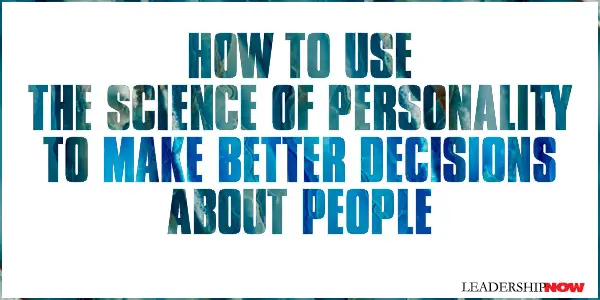
SOME of the biggest decisions we will make involve judgments about people—who to hire, who to marry, which friends to have, what job to take, or which business partner to take on. Good people judgment becomes a critical skill in all aspects of life. There are hundreds of ways to describe someone’s observable behavior. On the whole, these can be cumbersome and confusing. Instead, organizational psychologist Richard Davis writes in Good Judgment: Making Better Business Decisions with the Science of Human Personality we can use a manageable personality framework that allows us to identify patterns of behavior and quantifiable characteristics according to an individual’s personality traits. Research into human behavior has determined that we can distill personality down to just a handful of five traits called the Big Five: Openness, Conscientiousness, Extroversion, Agreeableness, and Neuroticism. As the science shows, we can describe our personality as a function of all five dimensions. We tend to be higher or lower in certain dimensions than in others, and we also tend to manifest specific traits differently in our behavior. Even so, the Big Five are not enough, and no personality test can capture the complexity of human behavior. As Davis states, “It’s one thing to understand whether a person has a given trait, quite another to know how that person will express that trait in their actual behavior, which is what we ultimately care about.” Using the Big Five as a guide, Davis has constructed a personality blueprint for judging character. The five categories briefly explained are: 1. Intellect — How People Think
2. Emotionality — How People Express Emotions
3. Sociability — How People Engage with Others
4. Drive — Why People Do What They Do
5. Diligence — How People Get Stuff Done
These five categories are not independent but come together to make up who a person is. Context matters. “The specific ways that individuals express their personality traits also help to determine if those traits are helpful or disruptive. So much rides not just on the specific traits people appear to express but on their ability to master whether and how they express them in everyday situations. Personality isn’t permanent as described here. We can decide to push back against our latent tendencies if we wish, disciplining ourselves to behave differently and developing workarounds. So, how do we use this information? Casual conversations work well for understanding others’ personalities if you know how to conduct them. Like a journalist conducting an interview, we can employ five strategies to enhance our perception: build rapport, get people to talk about their past, ask power questions, interpret what you are learning and how it fits into one of the five categories, and calibrate the interpretation to the context and the way they present themselves. Consider too your own biases when judging others. And above all, be curious. Davis details each of these strategies, the questions we should be asking, and how we might best interpret the information we gather. 
Posted by Michael McKinney at 04:51 PM
06.26.24

No Matter What Work You Do, You Have a Customer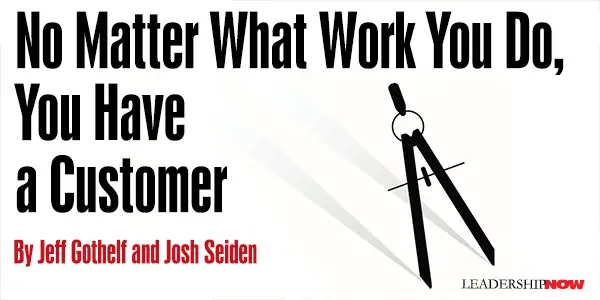
IF SOMEONE was to ask you who is your customer, you would probably easily answer the question. Regardless of what you do at work you probably know who buys the product or service your company makes. Now, if that same someone were to ask you who consumes the work that you personally do, the answer may not come as easily. In a lot of cases, the person who uses what you make isn’t the end customer of your company. It’s likely to be someone who works for your company. What would change if you began to think of that person as your customer? It’s a question most people never consider. How does the work I do make my colleagues more or less successful? It becomes particularly challenging for people working outside of any product development roles. If you work in finance, who uses that spreadsheet you create? What about the legal team? They create policies. How well do those policies enable the work of those who have to follow them? In other words, how well does your work “work?” Making your customers successful defines the value of your work. The simplest way to know if you’ve done that is to see (and measure) how their behavior changes once you’ve delivered your work. Did your spreadsheet reduce or increase the number of questions asked about the budget? Did the procurement policy you implemented decrease or increase vendor onboarding time? These are the true measures of success and value. The act of “making a thing” is just the beginning of the conversation. This is a radical concept. For decades, we’ve been measured by whether or not we “made a thing” or even just completed a task. No one ever asked us if the “thing” we made or the task we completed actually made someone else more successful. The behavior change someone exhibits after using a thing we’ve made is called an outcome. An outcome is a measurable change in human behavior that delivers business results. Outcomes are the fundamental building blocks of objectives and key results (OKRs) — a resurgent, team-focused, goal-setting framework used to redefine success away from the creation of a thing (output) and towards a meaningful change in human behavior (outcome). Imagine you’re a shoe designer. Your work isn’t consumed by the buyers of your company’s shoes. Rather, it’s consumed by materials buyers, merchandisers, marketing and advertising teams, as well as the finance department — not to mention the fabricators of the shoes. Maybe you deliver your designs in the form of a 3D rendering. Maybe you deliver it as a video, or maybe just as a simple PowerPoint presentation. Which delivery channel is best? How do you know? The truth is, you don’t. And that’s the frustratingly ineffective aspect of only considering output alone. You’re guessing. You don’t know exactly what the best way to deliver this information is and which details to include. The most effective way to tell if you’re creating value is to see how people behave. For our shoe designer, the key results that indicate they’ve delivered value include behaviors like “the number of clarifying questions asked after a shoe design is delivered” or “the time it takes to go from design to manufacturing.” These are measures of human behavior. They tell you when you’ve delivered something of value and in a valuable way. They tell you that you’ve made your internal customers successful. When you wrap these key results in a human-centric objective — the benefit these people will get from your work — you set goals that give you a much better sense of the quality of your work and how you might improve it. The shoe designer may put together an objective and key results statement that looks something like this: Objective: Make it dead simple for my colleagues, regardless of department, to do their job from my shoe designs. Key Result: Reduce the number of clarifying questions asked about each design by 90 percent. Key Result: Reduce the time it takes to go from delivered design to manufacturing by 50 percent. Stating goals this way provides the shoe designer with the opportunity to try different ways of delivering their design and assessing which way is best. It makes them a better shoe designer exactly because they’re focusing on their internal colleagues as customers. Use these tips for using OKRs to benefit your internal customers: 1. Think beyond the work that you do. How does what you do enable the next person in line to do their job? Are you making that easier or harder for them with what you’re creating? 2. Talk to your colleagues. Understand how they do their work and what makes it easier and more difficult. Get to know their obstacles. Perhaps there are ways you can help them overcome them. 3. Work with them to determine successful behaviors. How do they define it? Everyone has a customer. It just might not be who you thought. Ask yourself who uses what you make. How do their behaviors indicate that you’ve delivered value to them? Then, write an OKR to redefine your team’s goals and see how that changes the work you produce.  
Posted by Michael McKinney at 01:04 PM
11.17.23

How Leaders Can Build an Autonomous Work Environment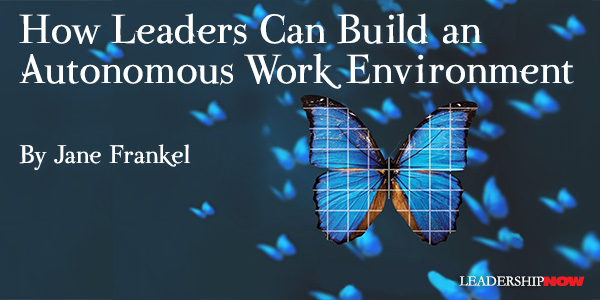
IN HIS BOOK Thank You for Being Late, author and award-winning journalist Tom Friedman argues that to understand the twenty-first century, you must realize that “the planet’s three largest forces”—technology, globalization, and climate change—are accelerating all at once. As a business leader, you already get that. But, at the same time, you need to navigate other realities, too—like, for starters, figuring out your own goals and understanding and performing well in your job. Not to mention that the pandemic caused unprecedented distress among workers. Being displaced from their physical work environments, missing their colleagues socially and collaboratively, and losing much of their managers’ usual support, they became increasingly disengaged. They also grew unsure of how to take control of their purpose at work—and in life. Today, however, workers have no choice other than to rise to the occasion: to do their jobs well, to make good and relevant decisions, and to clearly contribute to their organization’s mission and success. And to do all that and more autonomously. But, as reiterated by recent research by Boston Consulting Group, workers first need agency and control—the tenets of autonomy. And, importantly, agency and control require what I call the three selfs: self-confidence, self-accountability, and self-sufficiency. And those selfs must be built and nurtured to take hold. Leaders Must Rise to the Occasion, Too As a leader, your role in creating an autonomous work environment cannot be overstated. You alone have the power to build and nurture workers’ three selfs, and to foster their agency and control. Moreover, to be autonomous in their work, people need to really feel your trust as their leader. And that, in turn, can help them become more and more invested in their own growth and contributions. To get started, here are seven ways to create an autonomous work environment. 1. Reinforce an autonomous narrative. Share your organization’s mindset and narrative around autonomy. Be sure to include current goals for workers’ performance and the ways in which they’re trusted and free to go about doing their jobs. 2. Keep people fully informed. Communicate all relevant information to employees, partners, and other stakeholders on a regular, if not real-time, basis. 3. Have a digital nervous system. Supply workers with a framework of fundamental data and information for analysis in areas such as organizational strategy, industry trends and events, and potential revenue opportunities. 4. Create a project structure. Foster a learning orientation, including an ongoing analysis of prior projects, workflows, and results and outcomes. 5. Recognize and reward value creation. Spotlight key creators and contributors, sharing exactly how they’re adding value to the enterprise. 6. Hold regular reflection sessions. Help people reflect on new business ideas and ways of working, always reinforcing opportunities for intrapreneuring. 7. Balance independence with dependence. Tap into a variety of management theories to emphasize the importance of both working independently and collaborating with others to benefit from their unique expertise and contributions. In closing, as a business leader today, it’s an imperative to create an autonomous work environment. Amid accelerating change, your people need agency and control—imbued by the three selfs—in order to work autonomously, to uncover new opportunities to add value, and to grow and thrive in the 21st-century workplace.  
Posted by Michael McKinney at 12:54 PM
09.15.23

Overcoming Feedback Apprehension: Dos and Don’ts of Giving and Receiving Feedback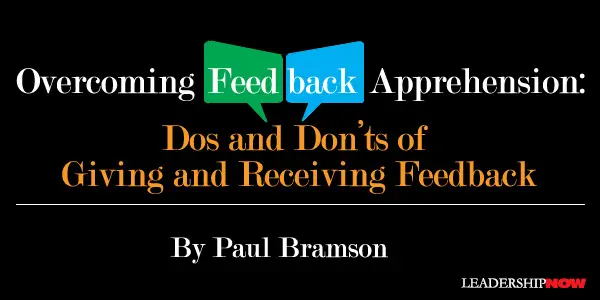
FEEDBACK — often described as a cornerstone of growth — possesses the potential to really inform and shape our professional and personal growth. When we’re open to receiving it and thoughtful in providing it to others, feedback can be very powerful while deepening and enriching relationships overall. So why do so many shy away from asking for or giving feedback? Because being vulnerable and open to what others have to say can be scary. And, if we’re unsure how to provide constructive feedback thoughtfully to others, fear of their reactions will hold us back for sure. Regardless of how you feel, getting input from others and providing it is important, so here are some ways to make it a little easier. The Power of Constructive Feedback A key misconception about constructive feedback is that it’s a critique. It should not be at all; advice like this should bring about thoughtful and productive dialogue. When in a trusted or safe environment, conversations of this nature can serve as a mirror, reflecting our actions, choices, and behaviors, and helping us to see ourselves more clearly. This mirrored reflection, although sometimes uncomfortable, opens avenues for discussion and a supportive environment for improvement. These conversations can guide us toward more effective approaches to things and innovative solutions. Additionally, the impact of constructive feedback extends beyond individual development. In the realm of teamwork and collaboration, this form of feedback becomes a bridge that connects individuals, fostering open communication and shared understanding. When offered in the spirit of improvement and shared success, constructive feedback cultivates an environment where team members feel valued, respected, and motivated to contribute their best. Providing Effective Feedback Giving team members feedback requires sensitivity, finesse, and purpose. When providing someone with information that could be taken as criticism or potentially put them on the defensive, one must proceed with intention, care, and authenticity. When advice and insights are given in a meaningful and thoughtful way, not only does it support the individual, but it builds and fosters trust between people. Here are some things to do or avoid when providing feedback in a way that empowers and fosters learning and growth. Dos Be human: Seems obvious, I know, but too often, one goes in just with an agenda of what behaviors or actions need to be addressed without thinking about how the other person will respond or react. Before you go into these conversations, ask yourself what you want the other person to walk away with and then think about them and what approach for them individually will bring about the most productive, healthy conversation. Embrace a coaching approach: Too often, these conversations are one-sided; start the conversation with an open conversation. Ask the other person what they think is going well and where they see opportunities for growth. Letting someone self-identify is the best way to empower them towards change. Once they have shared, you can have a more productive conversation around their thoughts and layer in anything else from your side, positive or constructive. Be specific and objective: Effective feedback is rooted in clarity. When offering feedback, focus on specific actions, situations, or behaviors rather than vague generalizations. Objectivity is key. Present observations in an unbiased manner — supported by information or examples — to ensure that the feedback remains constructive rather than subjective criticism. Focus on behavior, not personality: Constructive feedback centers around actions and outcomes, not personal attributes. Address behaviors that can be altered, steering clear of judgments about an individual’s character. This approach maintains a supportive tone and encourages change without causing defensiveness. Always conclude with an action plan: When both individuals leave a conversation of this nature, it’s key to ensure that everyone is on the same page with what was talked about, that there is no confusion, and that clear next steps are in place. Additionally, set a time to regroup a few weeks in the future to check in and provide any support. Don’ts Generalize: Feedback loses its impact when it relies on vague statements or generalizations. Avoid phrases like “You always” or “You never,” as they oversimplify complex situations and hinder productive communication. Blame: Effective feedback promotes accountability and solution-finding rather than assigning blame. Avoid pointing fingers or accusing, as this can create defensiveness and undermine the purpose of the feedback. The individual will shut down and walk away with no tangible or actionable paths to improvement. Make assumptions: Feedback should be based on facts, not assumptions or hearsay from a third party if at all possible. Avoid making guesses about someone’s motivations or intentions. Instead, ask questions, learn from their perspective, and focus on observable behaviors or actions. Receiving Feedback with Confidence Receiving feedback can be hard because we are human, and vulnerability is hard. Having areas of opportunity reflected back to us can feel imperfect, which can be uncomfortable for many. Even when one is praised, some might feel awkward or vulnerable. These are normal emotions and feelings. The good news is that with an open mind and some confidence, feedback can be the foundation for personal and professional growth. The principles of receiving feedback with grace and confidence pave the way for transformative change while nurturing our relationship with self-improvement. You’ve heard the cliché that “feedback is a gift,” so embrace it. Dos Cultivate an open mindset: Approach feedback with an open and receptive mindset. Recognize that receiving feedback is an opportunity for growth, regardless of whether it confirms strengths or highlights areas for improvement. Seek clarity: When feedback is given, ask clarifying questions to ensure you fully understand the observations and perspectives shared. If certain points are unclear, ask for examples or further explanation. This demonstrates your openness and commitment to learning and understanding. Show appreciation: Express gratitude for the feedback received, regardless of its nature. By acknowledging the effort someone has taken to provide insights, you create an environment of mutual respect and encourage ongoing constructive dialogue. Don’ts Become defensive: This is a business maturity check. When confronted with feedback, avoid the instinct to become defensive. Defensive reactions can hinder understanding and close the door to growth. Instead, take a moment to absorb the feedback before responding. Disregard or dismiss: Even if the feedback seems unfamiliar or contradictory to your self-perception, resist the urge to disregard it outright. Ask clarifying questions to ensure you understand what is being said. It’s good to remind yourself that every perspective has value, and the insights offered might help uncover blind spots or overlooked opportunities for improvement. Over-personalizing: Receiving feedback is not an evaluation of your worth as a person. Avoid over-personalizing feedback and instead focus on the specific actions and behaviors being discussed. This perspective shift enables you to embrace feedback without it becoming a source of anxiety. The Path to Growth and Success Fostering a culture of growth and continuous improvement lies at the core of effective feedback dynamics. Encouraging an environment where feedback is not only accepted but actively sought, creates a fertile ground for learning and enhancement. In this arena, feedback isn’t seen as criticism but rather as a valuable tool that empowers individuals to excel. In the sphere of personal and professional development, the navigation of feedback — both providing and hearing — is an indispensable element guiding individuals toward growth and success. When provided with good intention, authenticity, and caring, as well as absorbed with receptivity, feedback becomes a powerful catalyst for improvement, refining skills, and strengthening relationships and sets the stage for a growth-minded workplace for all. 
Posted by Michael McKinney at 02:02 PM
08.18.23

Are Relationships Your Top Work Priority? Here’s Why They Should Be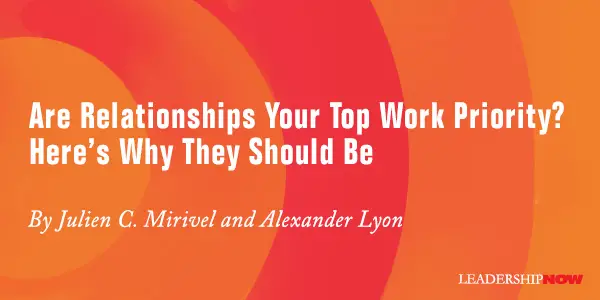
IT’S AN AMAZING FEELING: When you walk into Rob Ulmer’s office, he instantly lets go of whatever he’s doing. He turns to you with a warm greeting and gives you his undivided attention. As colleagues who worked under Rob’s leadership for years, we can’t recall a single instance when we felt pushed out, nudged to leave, or disengaged. Rob simply gives you his full self. He’s a master at creating high-quality moments for his people. Today, Robert Ulmer is dean of the Greenspun College of Urban Affairs at the University of Nevada, Las Vegas (UNLV). Originally from Canada, Rob is a leader who brings enthusiasm, positivity, and a total commitment to people—all day, every day. We interviewed him recently for our book, Positive Communication for Leaders, to understand how he does it. “As a leader, I have to be sensitive to the human equation,” Rob explained on a Zoom call. “People really do matter to me,” he added. “You’re hiring people, and you have to give them time and attention. You have to be interested in who they are and what they’re about. You have to care.” “People signal to you whether you matter or not, whether they’re more interested in you or more interested in themselves,” he explained. He briefly paused and added: “I know what that feeling is like when people don’t care about you, and I don’t want [anyone I work with] to have that feeling.” “The default for most people,” Rob continued, “is to be impersonal. Many people will treat others transactionally. It’s very easy to focus on the role and the position. Everybody will tell you that you can’t take the time to spend with people, that it’s about something else.” He paused for clarity. “That’s all nonsense,” he said as he shook his head. “Investing in relationships can be done at all leadership levels.” In the interview, we stepped in and played devil’s advocate. We argued that most people would say, “I can’t do that all the time. I’ve got emails to attend to, another meeting to go to.” What about all the things that could take a person away from the encounter? Rob responded, “Out of all the things you’ve mentioned, what could be more important than the person you have with you in that moment?” Relationships Should Be a Leader’s Top Priority Rob’s rhetorical question reveals the mindset that drives his approach to work. As he put it in the interview: “Relationships are the most important priority.” There’s nothing above that. From Rob’s vantage point, there’s no internal leadership conflict about his priorities. He’s living his principles. “I’m not using a focus on relationships as a way to get to some other outcome,” Rob concluded. “The end outcome is the relationship.” With this philosophy in mind, Rob makes lots of small and big decisions that bring this philosophy to life. At one point in the conversation, he reflected, “Sure, we have a whole bunch of problems today. We’ll have them tomorrow. I don’t go to work with the expectation that I’m going to have a perfect day. So, when I’m talking to people, I go in and have those meaningful conversations for as long as it takes. Those other extraneous issues don’t really matter. What gets us where we’re going is the relationships that we’re developing.” What can you do today to build on Rob’s approach and create quality moments with others? Here are some easy-to-do strategies you can implement today:
Positive leaders draw on the fundamental understanding that leadership is about relationships. It’s based on the process of initiating contact with people, getting to know them, enjoying those interactions, and being fully present with them. Saying hello, catching up with people, sharing jokes, and updating others about our lives collectively weave the fabric of our relationships, create mutual understanding, and increase our influence as positive leaders. And when you do that, you can create an amazing feeling.  
Posted by Michael McKinney at 05:53 AM
07.28.23

Calling Out Unconscious Bias in the Workplace – Transcending the Problem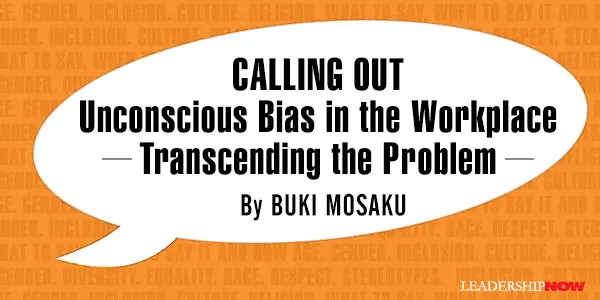
STATISTICS show that minorities and marginalized groups repeatedly experience career-stifling unconscious bias at many points throughout their working lives. Women and ethnic monitories, for example, often find it hard to climb the career ladder — a fact borne out in the significant underrepresentation of both groups in senior leadership roles. Minorities also report being passed over in favor of white or male counterparts when the “good” assignments are given out. They’re also less likely to be given access to the multitude of career development opportunities that make a difference in earning potential. Across sectors, minorities report that they:
Certainly, many employers have taken some important steps to deal with career-stifling bias. While top-down initiatives will bear fruit in the long term, the trickle-down effect is too slow for those already falling victim to unconscious workplace bias. So, what’s the answer? Here are three power actions that differentiate high-performing minorities in calling out and navigating career-stifling unconscious bias in the workplace: 1. Understand the Problem of Unconscious Bias in the Workplace On the basis that you can’t successfully address or tackle a problem that you don’t fully understand, it behooves everyone in the organization to be cognizant with this topic. There are two forms of career-stifling unconscious bias: Directional bias is unconsciously directed toward minorities in the workplace by leaders, potential clients, and clients based on conditioned negative stereotypes. This could show up as a lack of trust when potential clients hear an untraditional accent or are confronted with a female as opposed to a male practitioner. It can also reveal itself when minorities are overlooked for senior roles or for high-profile projects. Reverse bias, is when a minority misinterprets unfavorable decisions or behaviors as driven by unconscious bias when they aren’t, in which case they become the perpetrator of bias as opposed to the victim. For instance, an employee representing a marginalized group may presume a colleague has a problem with their accent when in reality, there’s no problem. Or, a minority senses unconscious discrimination when not being tapped for a promotion when it’s a case of simply not meeting the requirements of the role. With this understanding, minorities can allow for misinterpretations of sensed bias and, in doing so, more effectively navigate sensed directional bias without turning into a perpetrator of bias themselves and invoking defensive fragility from the presumed perpetrator — in other words, getting the other person’s “back up.” 2. Call Out Sensed Unconscious Bias Whenever you sense unconscious bias towards yourself or others, call it out in the moment. Don’t wait. If you don’t, you’re part of the problem. If you do, you’re part of the solution. Here’s a step-by-step way to effectively call it out:
3. Transcend the Problem The first two practical steps are focused on navigating everyday bias in the moment, however, transcending workplace bias rapidly dissipates the issue in real time and completely removes the problem. To do that, accept the unequivocal multidirectional nature of workplace bias. This means always allowing for the potential that you’ve misinterpreted the situation regardless of your certainty — that you might be engaging in reverse bias. When you do this, you strategically position yourself to advantageously call out bias any time you sense it without being accusatory in your approach and invoking defensive fragility in the sensed perpetrator. When you apply these three powerful actions, your vision, and wisdom are unimpaired by majority guilt or minority pain and retribution. You focus on collaborative, progressive bias navigation in the moments you sense career-stifling workplace bias. Practice navigating everyday bias until the approach becomes second nature. Don’t be shy — give it a try!  
Posted by Michael McKinney at 05:14 AM
03.20.23

Culture is the Way: 5 Steps to Building a World-Class Culture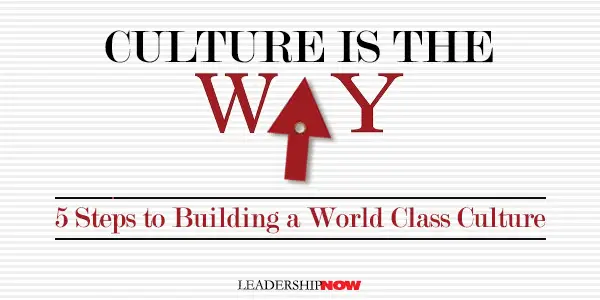
YOU CAN CHANGE the results your organization is getting by changing its culture. And every organization has a culture whether it is by design or by default. “Whether an organization has a world-class culture or a toxic one, its future depends on how much attention and focus it puts on growing its culture,” writes Matt Mayberry, the author of Culture is the Way: How Leaders at Every Level Build an Organization for Speed, Impact, and Excellence. Culture serves as the internal compass for an organization’s fundamental beliefs, how the organization behaves daily, and its level of market performance. To begin, let’s look at the five most common roadblocks that stop us in our pursuit of cultural excellence that Mayberry addresses: 1. Lukewarm leadership buy-in. “Most senior leadership teams consist of accomplished leaders with a wealth of experience, and the last thing the majority of them will want to do is shift their leadership style or change how they have done things for the past ten to twenty years.” 2. All slogans and no action. “Words don’t build culture or change culture by themselves. It takes action. Culture is not about turning values into behaviors. It’s about turning values into repeatable behaviors, into actions that become daily habits that are shared across the organization.” 3. Temptation of instant gratification. “When we have a strong desire for something, our patience is severely tested. Any goal worth achieving, whether it’s a personal goal, a professional aspiration, or building a great workplace culture, requires a delicate balance of tenacity and extraordinary patience.” 4. Distortion and distraction. Just throwing ideas around and seeing what sticks and what doesn’t isn’t going to get you any closer to a solution, and it could actually do more harm than good. You must use caution when rushing to adopt and implement an idea that you read about.” 5. Lack of cascading change. There is no end date. It is an ongoing commitment. “Being interested is not the same as action taken. Being interested in creating a great culture is exactly that. Interest. It will never progress unless consistent action is taken.”
Here is an overview of his five-step process: Step One: Define Your Culture You must be ruthlessly clear about who you are as an organization. The culture has to be clearly defined so that everyone knows what you mean when we say, “our culture is.” Everyone must see the culture in the same way. “Great cultures are defined cultures. This means that every leader, manager, and employee can describe the culture and what it stands for, and the descriptions will be very similar to a large extent.” Step Two: Discovery Through Collaboration and Inspiration “Changing culture begins with changing one person’s mindset and behavior at a time. And changing mindsets and behaviors, especially at scale, necessitates making people feel like they are a vital part of the process rather than relying on old engagement methods.” Take a bottom-up approach. “Culture needs to be top-down directed but then bottom-up created.” Step Three: Launch, Cascade, and Embed If you want to drive culture change, you need a playbook. That playbook should ensure management team alignment, have an official launch date, a communication strategy, a plan to cascade the message throughout the organization, create a behavioral manifesto, and a plan for feedback. “You must convey a moving and compelling message that sends shockwaves throughout the company.” Step Four: Drive Long-Term Impact Creating a sustainable culture “demands unwavering fanaticism to the ongoing process and journey.” Building a culture requires consistent focus for the long term. Mayberry’s Five-Step Fanatical Framework helps you do just that. It entails continuous fanatical attention, development, and nurturing, fanatical focus on the vital areas of improvement, fanatical about alignment, fanatical about follow-through, and fanatical about the why. Step Five: Leaders Must Blaze the Trail How well the organization’s leaders practice what they preach will determine the long-term success of the desired culture. Nothing makes up for poor leadership. Leaders should coach for excellence. “The best leaders who get the most out of their teams identify as coaches rather than managers or leaders.” 
Posted by Michael McKinney at 07:59 AM
03.17.23

Culture Rules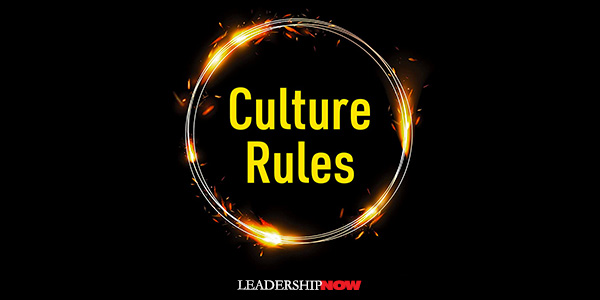
BUILDING a high-performance culture is like setting the rules of a game, says Mark Miller in Culture Rules: The Leader’s Guide to Creating the Ultimate Competitive Advantage. If you don’t “play” the organization will make up their own rules which can and will have unintended consequences. Culture is “a place, physical or virtual, where you set the parameters in which people work. A place where the organization established the rules of conduct and its values, how the game will be played, the options and variables to play, the desired activities and boundaries that govern the game, and more.” In the game of Culture, Miller offers three rules but says there are infinite moves you can make. There are an infinite number of ways to get it done when we think about how we want to shape and build the culture of our organization. You will find many examples others have used in building their culture. Rule #1: Aspire To aspire, you need to create more than a catchy statement. You need a clear purpose. Why does your organization exist? What do you aspire to? What do you value? You must know exactly what you are trying to create. When there is a gap between where you are and where you aspire to be, closing the gap moves you forward. Leaders must constantly share, reinforce, and celebrate their values, as well as challenge those who fail to uphold them. Leaders determine the value and impact of core values in an organization. Rule #2: Amplify Once you have clarity on your aspirations, you amplify them by continuously reinforcing them. “A message not heard consistently is a message without impact.” It’s important to recognize the power of mundane moments, the seemingly trivial actions, and the ordinary encounters. These mark our leadership. These moments happen all day, every day. Without thoughtful actions on our part, these opportunities will be wasted, missed, or worse. If we respond in a fashion contrary to our Aspiration, we can unwittingly undermine our efforts to create the culture we’ve been dreaming of. Rule #3: Adapt Success today is no guarantee of success tomorrow. The world changes, so there must be an ongoing effort to measure and improve the culture. “When leaders are willing to Adapt, not react, to a changing world, they can build or rebuild a High Performance Culture.” Adapting your culture requires continuous listening, learning, and changing. Miller reminds us that the “greatest obstacle to creating a High Performance Culture is a lack of focused attention.” Without the attention, a culture will degrade and succumb to indifference, paranoia, mistrust, counter cultures, and self-deception, to name a few. If people came to your organization because of what they could do and then stayed because of who they could become, I think you would be well on your way to creating your own High Performance Culture—a place known for its unity; life-giving, sold-enriching work; and elite levels of performance. 
Posted by Michael McKinney at 06:37 AM
01.09.23

Embrace the New Norm by Listening to Your Employees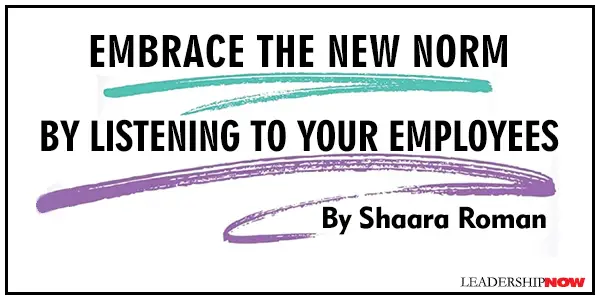
AFTER a tumultuous couple of years, the majority of the U.S. workforce is disengaged, burned out, and fed up. The work-life balance mindset has become increasingly prevalent, and people are taking major steps back from the workplace bustle. Many people are becoming less motivated in their jobs and leaders are stuck wondering what to do. The answer is simple - listen. Listening to your employees’ complaints, wants, and needs goes a long way. It’s very obvious what the workforce needs to stay motivated because they are being very vocal about these shifts in priorities. When Millennials entered the workforce, they prioritized “work to live” and did not want any part of the “hustle culture” that prioritizes face time, long hours, paying your dues. Gen Z feels the same way. In addition, research continually shows that Millennials and Gen Z’s in particular, plus an increasing number of other generations, are wanting to work in places that are committed to diversity, equity, and inclusion. They want their voice and opinions heard, they want to feel valued for their contributions, and they want flexibility to work how, where, and when they want. People have always wanted to do interesting work, they want flexibility, they want to grow their skills, they want to work in places where the culture allows them to thrive. The difference now is that people have seen that that’s a real possibility, so they are having a hard time going back to ‘the old norm.’ They are fighting for what they want, and organizations that don’t meet them in the middle will simply be left behind. COVID has made everyone examine their relationship with work and now millions of workers are opting out – whether it’s to take a sabbatical or join a new firm or start their own gig or do something totally different. The old-time view of grinding your way to the top is not only outdated it also puts you on the fast train to burn out, and no one wants that. Our world is also moving at a rapid pace and the constant barrage also adds to the burnout we are all experiencing. Right now, the power rests with the workforce – and will continue to do so even through a predicted recession. They are telling us in many ways that the status quo is not acceptable. Droves of women left the workforce in 2020. Millions have joined the great resignation, and over two-thirds of the workforce is disengaged or a part of the “quiet quit.” This is an opportunity for leaders to step up, lean in, and engage their staff to ask what would work for them and then work to make it a reality. Organizations that stand any chance of making it to the future of work will do the following:
We are on the heels of the future of work. Our nation’s workforce is undergoing a major transformation in attitude and priorities. What motivated someone 5 years ago - even two or three years ago - is not the same thing that motivates that same person today. Organizations that continue to ignore/resist this shift and try to force old processes are setting themselves up for failure. In order to motivate your employees, you just have to listen and embrace change.  
Posted by Michael McKinney at 06:27 AM
10.07.22

How to Get Along with Difficult People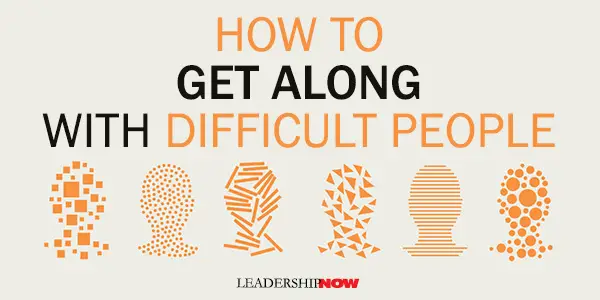
LEADERSHIP is all about relationships—even difficult ones. It would be great if we got along with everyone, but not everyone we encounter makes that easy. At one time or another, we all run into difficult people. Sometimes they are just difficult, and sometimes we make them that way. Amy Gallo shares insights and approaches for dealing with the difficult people in your life in Getting Along: How to Work with Anyone (Even Difficult People). In this excellent reseource, she offers research-based advice to help us not just to navigate the situations made difficult by people in our lives but to transform them into positive, constructive relationships. All relationships can change over time, even the good ones. And most can be transformed for the better if we are willing to put in the time and effort. The general lack of empathy we see today only complicates this situation. It is important to reframe the difficult situation to see it from the other person’s point of view. In this key insight, Gallo says when faced with a difficult person, “You must create the necessary space to choose a response that will result in growth instead of conflict.” Gallo covers in detail eight types of difficult people we might encounter. And some people display more than one. She provides helpful dos and don’ts for dealing with each type.
She offers nine principles for getting along with anyone, and for me, this is the essential section of the book. Principle 1: Focus on what you can control People change if they want to change, so focus on what you could do differently. Gallo writes, “I’ve been in many situations where I thought, If I can just explain this to the other person, surely, they’ll understand. We’ve all fantasized about saying or doing the perfect thing that forces a rival to see the light, to realize the error of their ways and vow to completely reform.” It is a fantasy. She adds a thought from Adam Grant, “All I can do is try to understand their thinking and ask if they’re open to some rethinking. The rest is up to them.” If your strategy for getting along with another person depends on them changing, good luck with that. Principle 2: Your perspective is just one perspective It is not realistic to expect that you will see eye-to-eye on everything with others. “Naïve realism is the tendency to believe that we’re seeing the world around us objectively, and if someone doesn’t see it the same way, they’re uninformed, irrational, or biased.” Then there is the fundamental attribution error that assumes a person’s behavior is a result of their personality rather than the situation they find themselves in. As a result, we tend to make assumptions about others that are not true, and reaching an agreement on the “facts” is highly unlikely. My view is just that—my view. Gallo recommends, “Instead of rehashing the past—a tactic that usually leads to nothing but hard feelings and deadlock—try to focus on what should happen going forward.” Principle 3: Be aware of your biases Our interactions are shaped by our biases. “Even our definition of ‘difficult’ behavior can be shaped by the prejudices that we carry into the workplace.” Know your biases, so you can monitor them more closely. Principle 4: Don’t make it “me against them” “If it is ‘me against you,’ the situation becomes polarizing. There’s someone who’s being difficult and someone who isn’t, someone who is right and someone who is wrong.” To move past this thinking, “Imagine that there are three entities in the situation: you, your colleague, and the dynamic between you.” In this way, you can separate the people from the problem. Principle 5: Rely on empathy to see things differently “We often perceive slights to be worse than they intended to be.” We make ourselves the victim. We all “make erroneous attributions about each other’s intent to do harm, how much harm was caused, how severe the issue is, how guilty the other person feels, etc.” This is not only unfair, “But it nudges you toward wallowing, revenge, or other unproductive responses rather than getting along.” Give the other person the benefit of the doubt. See the situation from the other person’s perspective. Principle 6: Know your goal When addressing a difficult situation, know what you want. “Identifying your goal will help you avoid getting pulled into any drama and stay focused on constructive tactics.” While you may say your goal is to get along, your hidden agenda—payback for example—will “color your interactions, causing you to use language or a tone that is excessively critical or condescending, compromising your ability to achieve your stated goal.” Principle 7: Avoid gossip, mostly Notwithstanding studies that indicate, on a positive note, that gossip may keep people from behaving selfishly or badly because they don’t want others talking badly about them, I believe gossip should be avoided at all costs. Gossip divides, diminishes others’ ability to change, infects others with your biases and interpretations, and can destroy your ability to heal a relationship. Gossip is not a good basis for building and maintaining relationships. Principle 8: Experiment to find what works There isn’t one right answer. Improving a relationship will “feel far more manageable if you start coming up with two or three ideas you want to test out. Often, small actions can have a big impact.” “Keep refreshing the approaches you try and be willing to abandon ones that aren’t producing results. Principle 9: Be—and stay—curious In any relationship problem, “it’s easy to tell yourself, ‘This is the way it’s always going to be’ or ‘Why should l expect them to change?’ or ‘We just don’t get along.’ I won’t tell you that it is going to be fun or even pleasant to do what you need to do to salvage a troubled relationship, but complacency and pessimism will get you nowhere. Instead, adopt a curious mindset.” Gallo advises, “Assume you have something to learn and believe that the negative dynamic can turn around.” Approach difficult relationships with a growth mindset. 
Posted by Michael McKinney at 06:00 AM
09.16.22

The 6 Types of Working Genius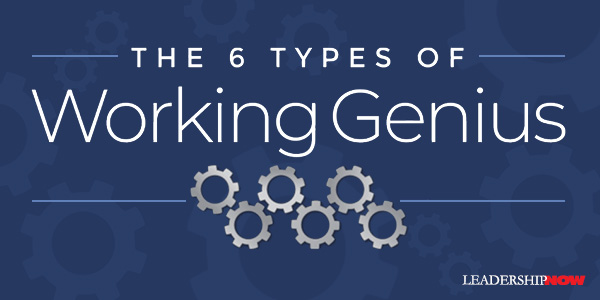
WORK is a process, and we all contribute in different ways. When the work we do is aligned with our gifts, we perform to our potential. The 6 Types of Working Genius by Patrick Lencioni is a business fable that goes behind the scenes of a team working out the frustrations they are having at work. We struggle when we are called upon to perform in ways that not consistent with what we do best. Naturally, we all have to take on tasks in ways that drain us, and that’s not a problem unless it is something we have to do all the time. If that’s the case, it leads to burnout. Judgement is similar, except that it’s what we do when we see a colleague struggle in some kind of work and incorrectly attribute their struggle to their lack of effort, intelligence, or virtue. “I don’t know why he can’t get that done. I think he just doesn’t care. Or maybe he’s just not as smart as we thought he was. Or is it possible that he just isn’t committed to the team?” We’ve all done this, and it’s dangerous and destructive. It causes people to feel hurt and rejected, and it adversely impacts teams, organizations, even families. This is a critically important issue. We should first begin by looking at the three phases of work as it forms the framework for the 6 Types. The first phase is Ideation and this is where we identify needs and propose solutions. This is the first step in any kind of work. The second phase is Activation and is about evaluating the merits of the ideas or solutions proposed during Ideation. The third phase is Implementation and this is all about getting things done—bringing it home. The 6 Types of Work Genius
Within the first phase, Ideation, we have the Genius of Wonder and the Genius of Invention. The Genius of Wonder identifies the need to improve of change. “Involves the ability to ponder and speculate and question the state of things, asking the questions that provoke answers and action. People with this genius are naturally inclined to do these things.” The Genius of Invention confirms the importance of that need and generate an idea or solution. “It is all about coming up with new ideas and solutions. People with this genius are drawn toward origination, creativity, and ingenuity in the truest sense of those words, even with little direction and context.” Moving to the second phase, Activation, we have the Genius of Discernment and the Genius of Galvanizing. The Genius of Discernment assesses the merit and workability of the idea or solution. It “is related to instinct, intuition, and uncanny judgment. People with this genius have a natural ability to assess an idea or situation, even without a lot of data or expertise. Using pattern recognition and gut feel, they are able to provide valuable advice and feedback around most subjects in a way that transcends their levels of specific knowledge or information.” The Genius of Galvanizing generates enthusiasm and action around the idea or solution. These people rally, motivate, and provoke people to take action around an idea or an initiative. “People with this genius are naturally inclined to inspire and enlist others to get involved in an endeavor.” In the last phase, Implementation, are the Genius of Enablement and the Genius of Tenacity. The Genius of Enablement initiates support and assists in the implementation of the idea or solution. This “Involves providing people with support and assistance in the way that it is needed. People with this genius are adept at responding to the needs of others without conditions or restrictions. They are naturally inclined to help others accomplish their goals and often can anticipate what people might need before they even ask.” The Genius of Tenacity commits to ensuring that the idea or solution gets completed and that results are achieved. “It is about the satisfaction of pushing things across the finish line to completion. People with this genius are not only capable of, but naturally inclined to, finish projects and ensure that they are completed according to specification.” It is helpful to see where each of the Geniuses enter the work process as it gives insight into their thinking. As depicted in the chart below, the Wonder Genius comes in at the 30,000-foot level. As we move through the work process, the focus becomes narrower down to 1000 feet for the Tenacity Genius.
After testing thousands of people for their genius, The Table Group has found that we have two geniuses, two areas of competency, and two areas of frustration. Areas of competency are activities that don’t do much for us one way or the other, and we may be quite good at them. But if we engage in them too long, we are drained if we are not also working in the areas of our genius. We need to be aware of our areas of frustration, so we don’t spend too much time engaged in them. To find out your genius take the assessment at WorkingGenius.com. There are 42 questions, and it takes about ten minutes to complete. 
Posted by Michael McKinney at 07:10 AM
06.08.22

The Role of Wellness in Leadership Development
IS IT POSSIBLE that we overlook the role of the body in our professional lives? Habits of health and wellness play a larger role in workplace culture than one might initially think. In a recent article for Northwestern University’s Leadership Magazine, I highlighted a client, “Brian,” who was working his tail off but fell into a state of exhaustion. At first, it was hard to name. He was doing everything he thought he was supposed to. Working late, trying hard, committing fully to his organization and the people around him. Slowly, his motivation waned. He became more irritable and less satisfied with his work; communication broke down, and stressors stacked up. From the article: “he had raised his voice at a coworker, sent an angry message to his wife, and was caught in the fumes of varied frustration. Things seemed to be crumbling around him. By noon he decided to call off for the day. He had not taken a sick day in years. He says he does not remember the drive home, but he does remember making himself some tea and sitting down on the couch. The tea was too hot, so he set it down for a moment. The next thing he remembers is waking up in the dark, laying down now, after an unintentional five-hour nap. He brushed his teeth, went to bed, and slept through the night. The next day he was fine. Simply, Brian was exhausted. Sometimes we use the term ‘exhausted’ to describe a long day, to add emphasis to our fatigue. Brian was actually exhausted – drained of physical and mental capacity. In this state, physical and emotional health fail, as do our relationships and our potential to lead.” Brian’s experience was relatively benign. But when a steady state of exhaustion persists for a career, the outcomes can be far worse. And if the fear of long-term health outcomes is not enough to sway the leader toward prioritizing his or her own wellness, they might want to consider the impact it has on their business. The Impact of Wellness on Workplace Success Brian was part of a leadership team that was focused on strong company culture. We conducted a survey of the leadership team, which catalogs – among other important components of healthy culture – habits of physical health and wellness. As we processed the data, we noticed that one health variable was having a powerful impact on people’s cognitive and emotional state: sleep. We looked closer. We split the group into two categories: Well-Rested (WR) for those with 8+ hours of sleep, and Sleep-Deprived (SD) for those who slept 6.5 hours or fewer. What we found was incredible. Sleep played a major role in KEY areas of the company’s culture: ▪ Negative Stress. Although members of the team were experiencing similar stressors during their workday, the Sleep-Deprived group interpreted those stressors to be 54% more negative than their Well-Rested peers. Same challenge, different perception, and sleep seemed to be a key piece of that difference. ▪ Motivation. The SD group reported 30% lower workplace motivation than the WR group. ▪ Communication. The SD group found it more difficult to maintain optimistic assumptions in communication with their peers, with scores 28% lower than the WR group. Additionally, the WR group found it easier to clarify difficult ideas with their peers than the SD group, reporting scores that were 21% higher than their sleepy peers. Our next step was clear. Before moving on to the complex dynamics of a healthy workplace environment, we had to create goals around sleep health and hygiene. Leaders and teams aim for a leg up on the competition with strategy-based professional development opportunities. Strategy always falls victim to implementation. If a group is not motivated, communicating poorly, and has a negative perception of shared work, then implementation of strategy will surely be challenged… if sleep deprivation is associated with all, then it seems like the first lever to pull. Teaching high-level strategy to a sleep-deprived team is like icing a cake that is not fully baked. Having identified the what (sleep) and why (impacting stress, motivation, and communication), we started in on the how. The results were amazing, if not predictable. When we began tackling individual challenges with sleep, motivation and communication went up almost immediately. Here’s a write-in from one of our team surveys: “Thank you. I didn’t even see [my sleep habits] as a problem. Now that I do and I can work on them I feel better in all areas of my life, especially my work. I’m more patient for sure.” Improving sleep is not a workplace cure-all. There was still plenty of work to do regarding workplace culture and communication. But recognizing the role of physical health and wellness was an important place to start. Next Steps The human condition is not linear. Pulling one lever does not automatically result in the outcome we might want. We are all, leaders and otherwise, in a constant state of skill-building, problem-solving, evaluation, and re-imagination. Health and wellness is one component of our leadership development work. We have multiple methods of maximizing leadership potential for individuals and teams. Our methods have been influenced by the best in the business (Marshall Goldsmith methods, Harvard Business School’s Organizational Development strategies) as well as decades of success implementing these methods. The journey toward improved leadership will not always be easy, but it will always be worth it. 
Posted by Michael McKinney at 06:36 AM
05.27.22

We Are Designed to Connect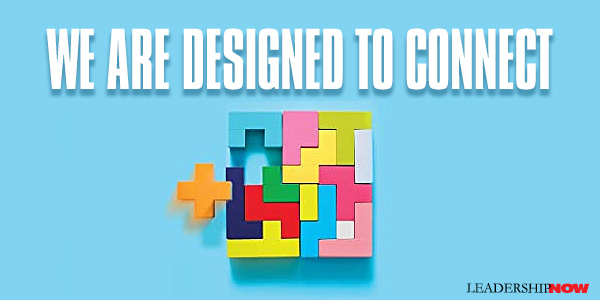
DO YOU feel like you belong at work? Seventy-two percent of workers feel lonely at least monthly. It is estimated that loneliness shaves 15 years off of a person’s life. Ouch. We are designed to connect with each other. And when we don’t, we react in much the same way as physical pain. The brain processes physical pain and loneliness in similar ways. Our lives become significant when we connect. In Connectable: How Leaders Can Move Teams from Isolated to All In, authors Ryan Jenkins and Steven Van Cohen write that “Connection is the default state of humans. We not only feel good together, but we feel normal.” Loneliness should not be shameful to admit. “It’s a signal. A signal that we need each other.” The bandit of belonging isn’t difference but distance. When someone else’s point of view, perspective, or behavior is unknown, unfamiliar, or unexplored, distance is created. Understanding and empathy grow with proximity. Abraham Lincoln once wisely said, ‘I don’t like that man. I must get to know him better.’ Distance is the bandit of belonging. They provide the LINK Framework to create belonging at work. Each letter in the LINK Framework represents a sequential step.
1. Look at Loneliness and identify loneliness in self and others. The well-being of your team members are your business. While you can’t control what they do outside of work, you can control “how seen, safe, and engaged they are at work. How you made them feel while they were at work has the potential to impact their off-work behaviors and ripple across the entire community.” A Less Lonely self-assessment is available online that includes specific recommendations to improve your loneliness level. 2. Invest in Connection and improve the strength of work relationships. This takes time, but they have offered actionable strategies to get you started. “Leaders should serve as ‘normalizers-in-chief’ when it comes to mental health challenges like loneliness. Workers want a more open and accepting culture, and leaders must be the ‘first responders’ to sound the alarm and address the issue. 3. Narrow the Focus and illuminate what’s most important at work. “Loneliness is lessened when a team narrows their focus on purpose, a clear direction, and growth.” As in the example given in the book, astronauts utilize these three elements to thrive in isolation. 4. Kindle the Momentum and inflame what’s working to sustain progress. The first three steps will help create a small fire that will begin to draw people together. “Inflame what’s working to sustain progress.” Go back over the first three steps. The framework works because prosocial actions like sharing, helping, and cooperating are contagious. Small, intentional, and routine behaviors will lessen loneliness. It has been said that all relationships have one law: Never make anyone feel alone, especially when you’re with them. And that’s easy to do in our distracted, social-tech world. We must take steps to avoid it. Pay attention to others. We all need distraction-free times, and we should communicate those times to our team. But we should also encourage those times when we are open to interruptions (and even use them to our advantage). “Interruptions are a free ticket to a renewed perspective, an uncovered blind spot, and possibly a better future.” Our commitment to lessen loneliness can take as little as 0.6, 1, and 5. “0.6 minutes (or 40 seconds) is how long it takes for loneliness to lesson during a two-person interaction. 1 person is the number of work friends it takes to feel less lonely. 5 minutes is the amount of time it takes in a team meeting to share something personal.” 
Posted by Michael McKinney at 07:52 AM
05.16.22

7 Concrete Actions That Can Help You Be a Champion of Workplace Inclusion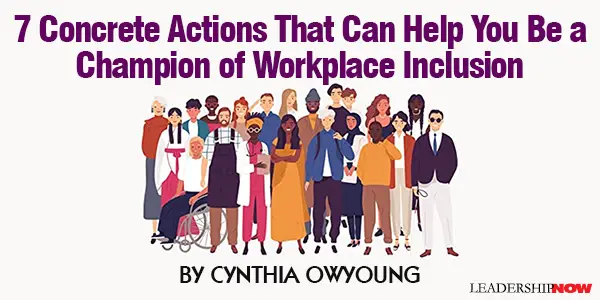
ENGAGING leaders within your organization may require leveraging several different kinds of elements, depending on what your company’s culture most heavily emphasizes. Data and research in the business case may be enough to convince some leaders that they need to engage in diversity, equity, inclusion, and belonging (DEIB). For others, it may be how you build a relationship and emotional connection to DEIB through storytelling and trust. For still others, it can depend on how strongly you can integrate DEIB actions into leaders’ business priorities and make this work as low lift as realistically possible. It’s up to you to find out what’s most important to your leaders and connect DEIB into that. Most of the time, I find that leaders have already bought into the concepts of DEIB. What they lack is a clear understanding of how to make progress. Taking no action at all is considered safer than taking the wrong actions that might cause controversy or inadvertently offend someone. What this means is they need a clear road map of actions to take. This can take the form of a customized DEIB action plan that includes a data dashboard supporting your recommended areas of focus. Or it can be a more generic set of suggestions that any leader across the organization can take, such as stating publicly on social media that they are committed to DEIB and looking for ways to get closer to different communities. What’s most important is to define a set of actions that are concrete enough to move the firm toward its defined DEIB goals. Simple advice such as “hire more people of color” is not that helpful because the organization would be doing that if they already knew how to do it well. It’s the fact that they don’t know what to do that we need to pay attention to. So I try to give leaders easy, concrete actions that they can do to be a champion of DEIB, such as these: • Audit your networks. If it is not diverse, start following and connecting with people from diverse backgrounds. For every new connection you make that is in the majority, invite another connection that is not. • Educate yourself. Either read articles or books, listen to podcasts, or attend webinars on DEIB. Actively participate in trainings offered by your employer. • Communicate your support. When you post a job, explicitly state that you encourage people from diverse backgrounds to apply. Talk to your teams about your commitment to and expectations of DEIB. • Amplify minority voices. Give credit to ideas shared by underrepresented groups in meetings. Share social media posts from underrepresented talent. • Make space. Invite people who haven’t spoken during a meeting to share their thoughts. Make sure event speakers are representative of diverse backgrounds. • Show up. Attend ERG events whether you have an affinity for that ERG or not. Listen and learn. • Seek input. If you’re leading an initiative that will impact an underrepresented group, make sure you involve their perspective in it as early as possible. This is not an exhaustive list by any means, but it contains a few basic ideas that I have found to be helpful guideposts for leaders who are seeking to demonstrate their DEIB commitment. Of course, it’s not enough for leaders to show their top-down commitment and role-model inclusive behaviors. It must also be coupled with employee support for DEIB initiatives to truly take hold.  
Posted by Michael McKinney at 08:03 AM
04.12.22

You Can Be Yourself Here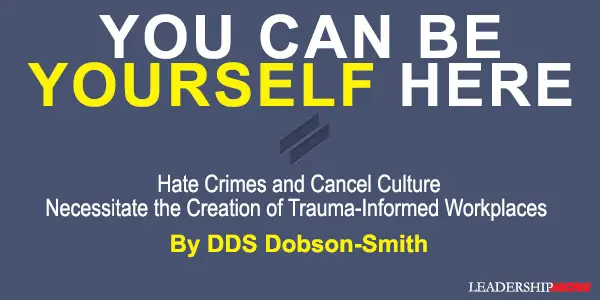
SHORTLY after the first wave of the COVID pandemic hit, I received an alarming text from a colleague of mine. It warned me of a new trend in the Bay Area called the “Slap an Asian Challenge,” in which people filmed themselves slapping Asian people and then posted it to their social channels. My husband, David, is Asian American, and my colleague was alerting us of potential danger. That same day, while they were walking to work, David was approached and harassed in broad daylight by a man wearing a mask. While not new, hate crimes (and their not-so-distant cousin, cancel culture) have been on the rise through the pandemic. Also not new and also on the rise are murders and beatings of Black, Brown, Mixed Race, and First Nations people, along with increased attacks on the queer and trans communities. The tragedies associated with the names George Floyd, Ahmaud Arbery, and Breonna Taylor placed this societal abhorrence in an appropriate spotlight. How does this violence affect the business world? Organizations now have an opportunity to be a part of the solution. They can commit to education and open dialogue to create what’s called a “trauma-informed workplace.” When implemented effectively, the result is an environment of happy, comfortable, and psychologically safe employees. If the key to any great company is its people (and it is), just imagine how beneficial this can be. Sadly, hate crime is an ugliness that we must deal with. Another ugliness, however, is cancel culture, which is a term that’s come to light in recent years. Cancel culture is engaging in mass canceling as a way of expressing disapproval and exerting social pressure. It tends to happen most when someone from the dominant social group (i.e., male, straight, white, cisgender, middle-aged, or non-disabled) is ostracized for saying or doing something hurtful to a member of a community that’s historically excluded (i.e., female, Black, Brown, Mixed race, First Nations, queer, transgender, elderly, or disabled). If we want to level-up human consciousness and create a more equitable, inclusive world (which I, of course, think we do), then we have to let people feel safe in making mistakes and saying the wrong thing — without the threat of becoming canceled. Only under these conditions can learning and open dialogue about privilege and difference take place. If we don’t allow people with identity-privilege to feel safe enough to muck things up and get things wrong, they won’t be willing to learn about diversity, inclusion or equity and we’ll have no hope of creating a deeper sense of belonging in the workplace. With the threat imposed by cancel culture, why would they? They feel safer staying away from those discussions because when they get involved, they risk exposure and, ultimately, getting voted off the island. People need to feel a psychological safety net when taking part in the discussions of a trauma-informed workplace. They need to act with intentional bravery to step into that space. Then, it’s up to organizational leadership to make sure they’re not canceled for saying or doing something unacceptable. We don’t need to just cancel hate crimes. We also need to cancel cancel culture. Leaders of organizations must create trauma-informed workplaces to help those who have suffered a hate crime, been subject to cancel culture, or who have dealt with the challenge of being excluded in some way. Concepts like employee resource groups and safe rooms have recently been proven effective to help people process tragic events. Companies that create “safe rooms” and “intentionally brave spaces” where the delicate (and oftentimes messy) conversations can take place give their staff the psychological safety net necessary for processing complex trauma and the harm inflicted by systemic oppression and day-to-day microaggressions. But simply declaring a space as “intentionally brave” and explaining to folks in the room a requirement for them to consciously, willfully, and intentionally bring courage, vulnerability, patience, and empathy isn’t enough. An additional step of co-creating rules for the room can encourage commitment. Here is a simple method for setting the stage to process trauma and oppression at your workplace:
I’ve seen safe rooms and intentionally brave spaces effectively emerge in response to the murders of George Floyd, Breonna Taylor, and Ahmaud Arbery as a way for Black employees to process and share their thoughts and fears. Similarly, they provided space to process the 2016 massacre at Pulse Nightclub, a gay nightclub in Orlando, Florida. Safe rooms allowed folks to share their sorrows and anxieties, to be seen and heard, and to be held in their grief. While some leaders may think of safe rooms and intentionally brave workspaces as a distraction from work, I see it as a necessary component for processing these tragedies in the workplace that actually leads to employees being more available for their job, not less. It gives staff a sense that their organization supports them, nurtures them, and provides them with the kinds of opportunities that they need and want. What’s more, this step can go a long way in helping all of us to understand each other better and create not just a better place to go to work but a better world in which to live.  
Posted by Michael McKinney at 05:26 PM
04.04.22

Leadership Agility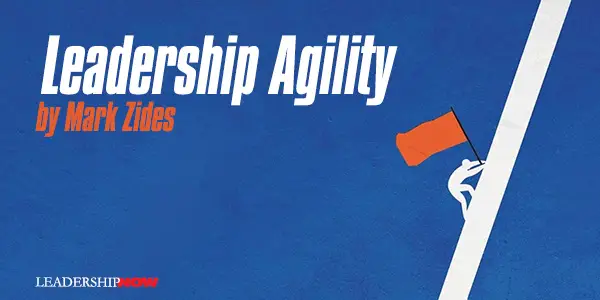
WHY do you think agility is a term used when talking about successful leadership? Is it because you will need to make decisions and act quickly as a leader? Is it to keep up with the ever-changing work environment we see these days? Is it because you need to be able to understand all sides fast and decide with only what you have? The reality is the answer is all of the above. Leadership agility is your ability to move, think, understand, act, and decide fast as a leader. You have to know your workspace, identify motivations and values that drive not only you and the organization, but your team, maximize creativity, and transition your leadership style and team to a self-organized system. Assess Your Workspace As leaders and managers, we need leadership agility to help us understand the needs of the organization and the needs of all our employees. In order to do so, you have to know the ins and outs of your workspace. Who is the go-to employee people rely on for information? Who acts fast and has a “let’s get it done now” attitude? Who steps back and asks all the right questions? Who can you count on for a creative touch? Getting to know your workspace is more than knowing the layout of your office and the chain of command to the top – it’s also about identifying talent and using individual skills to yield best results. If you need a catchy flyer created, and an employee in Education Services happens to be great a photoshop and creating copy, you may want to ask that person to help, even if it’s not part of their job description. You have a prospect who wants a deep dive of your sales pitch and the products and services you sell, and the Business Analyst on the product development team can explain the intricacies of the product without being too technical, ask that person to present to the potential client. You may have people who do not want to work outside of their job description, and that’s part of getting to know your workspace. People often can give you more than what they signed up. Identify the Motivations and Values While assessing your workspace, it is important to figure out what motivates your team. Is your team motivated by their commission checks? Are your employees motivated by collaboration with other departments? Is your team motivated by paid time off / vacation days? Whatever it is, figure it out and use it to get everyone’s blood flowing. If you are able to offer additional vacation days to the person that presents the best outcomes for a project, do it. If you can do quarterly commission check additions that help your sales team compete for the highest revenue for the quarter, do it. If you can get other departments to work together to increase the productivity and attention given to a project, do it. When your employees see that you are trying to help them grow and push them to be better versions of themselves, you will see results. Maximize Creativity Leaders tend to have creative minds, and creativity is not a one-size-fits-all term. Some people are artistically creative, some are organizationally creative, and some are creative with their problem-solving. Maximize yours. Put your creativity on display. Lead by example. If your employees see you using your creativity, showing that “no question is a stupid question” and that you’re thinking outside the box, they will more than likely be less afraid to put their ideas idea out there. It’s all about leading by example. Transition to a Self-Organized System A strong, agile leader is organized. That leader will then share their organizational knowledge with others to create a system. A self-organized system is one that does not depend on or wait for a manager to assign work or give instruction. This is something extremely important because it enables the team to find their own work and manage their timelines and responsibilities with minimal handholding. Transition your leadership style and team to a self-organizing system will streamline processes, let people know who and where to go with they need something, and will inspire creative and collaborative solutions – no matter what type of job you have. As a leader, you want to remove roadblocks. You want your employees to succeed, to be more productive and effective in their roles. It relies on trust, transparency, and a team that is open to constructive criticism. An agile leader shares his vision with his team, and they execute on all levels together.  
Posted by Michael McKinney at 09:01 PM
03.14.22

Who the Hell Wants to Work for You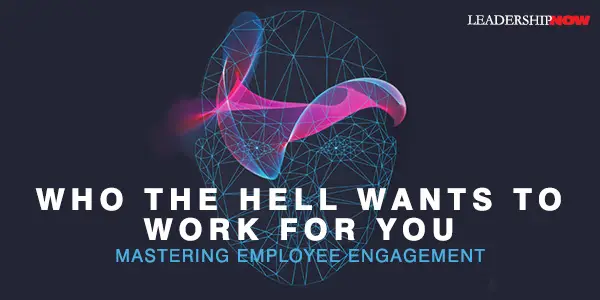
EMPLOYEE engagement is primarily a matter of how you think about your employees. It is natural think that they are generally the problem and as a result you need to “force, trick, or bribe them into mending their ways.” Tim Eisenhauer asks in Who the Hell Wants to Work for You, “What if you assumed that people naturally love to work? That they long to contribute? And they are only truly happy when working together towards something they see as bigger than themselves? If you look at it this way, there is nothing to fix. People are already wired to work with passion if … their work environment calls for it. Who is responsible for your employees’ work environment? That’s right, you are. Eisenhauer shares workplace principles that express the common needs of most people at work. These are the result of not only the lessons he has learned but those he has learned vicariously and shares through countless examples. To give you a flavor of the book, here are five: On doing something offbeat with a job candidate because you can learn so much more about people from their response to the unfamiliar than from their doctored life story: You don’t need to take every job candidate on an African safari, but do give them the chance to learn, react, process information, think on their feet, empathize, make decisions, make requests … In other words, engage in all those activities that, on a very basic level, determine success. Look for spontaneous responses. Any time you exchange canned questions and answers, you are wasting an opportunity to get to know your candidate. 
Posted by Michael McKinney at 09:08 AM
03.07.22

Redefining Ambition and Career Development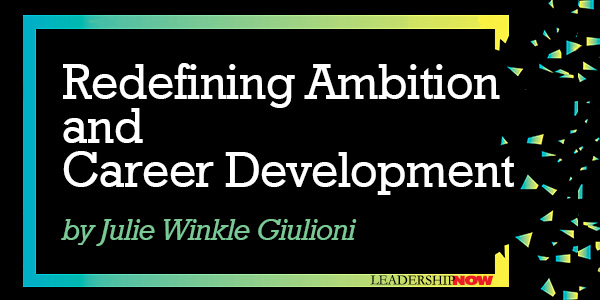
MANY definitions of “leadership” exist; but the ones that always resonate for me involve an element of bringing people along, helping them grow and progress, facilitating the development of them as people and their careers. And I have the feeling that similar definitions are deeply held by many leaders – especially given the frequency of one question I’m asked over and over: “What should I do with my ‘I’m good where I am’ employee who lacks ambition, doesn’t seem to want to grow, and is completely disinterested in moving up, over, or anywhere?” My answer to these leaders – who can’t help but feel that they’re shirking their responsibility if they aren’t motivating people to aspire to more – often is, “celebrate them… then get right to work challenging your own career development mindset.” It’s easy to impose our values, priorities, and aspirations on others. But the truth is that we each have a unique definition of what success looks like and how to achieve it. Appreciating and acting upon these differences is key to unlocking potential, motivation, and growth – even with those who appear outwardly disinterested in career development. And doing this involves going deep and wide – deep into understanding the individual and wide in terms of expanding your definition of career development. Understand the Individual Let’s face it, employees may be satisfied where they are for any number of reasons. Perhaps they’re deeply self-aware. They know what they’re good at, what they’re interested in, and what they love. Maybe they’ve found a comfortable niche within which they experience a sense of purpose and meaning. They might have figured out how to make work fit within their broader lives and other priorities. Or maybe they’ve gotten a glimpse into the headaches that you and other leaders experience on a regular basis and have consciously decided to take a pass. Disinterest in moving up doesn’t mean someone is unambitious; it simply means the leader needs to become more interested in understanding what’s important to the person and where their ambitions lie. Expand the Definition of Career Development When leaders engage with employees in candid conversations aimed at deepening their understanding of the individual, they frequently discover that the problem isn’t that these people lack ambition. Instead, it’s that we all have lacked the language – concrete ways to talk about career development – that aren’t inextricably connected with promotions, positions, and moves which don’t interest all employees. Careers and development are far bigger than the traditional trajectory up the org chart. Many employees recognize that careers operate between and beyond the artificial markers of new positions. One’s current role can become a rich sandbox for continuous growth… if we reframe the conversation and introduce seven other dimensions that are deeply meaningful to people who may not want to go anywhere but would welcome the opportunity for growth in place. Research I conducted for my new book, Promotions Are So Yesterday, suggests that there are seven other development dimensions that offer more interesting ways for employees to grow the than the classic climb up the corporate ladder. They include:
These seven dimensions offer leaders who are committed to ensuring that everyone grows the tools they need to facilitate meaningful development – even with those who have little interest in promotions. For instance, a new role is not required to introduce interesting and meaningful challenges into someone’s work life. People don’t need a different title to expand their network and learn from and through different people. A position change isn’t a pre-requisite for changing up one’s work to offer greater value or contribution. Employees don’t have to go anywhere to experience the powerful learning that comes along with making greater or more complex decisions. And the good news is that these seven dimensions – unlike promotions – are completely within your control. You and the employee can agree upon countless ways to tap their interests, motivations, and ambitions with development opportunities that are available right within their current role. So, if you’re a leader who measures your success by the growth of others, these seven dimensions will help you promote career development without promotions. Unlocking new possibilities may turn some ‘I’m good where I am’ responses into ‘I’m ready to get even better where I am!’  
Posted by Michael McKinney at 07:38 AM
10.20.21

8 Meticulous Hiring Tactics to Land the Best People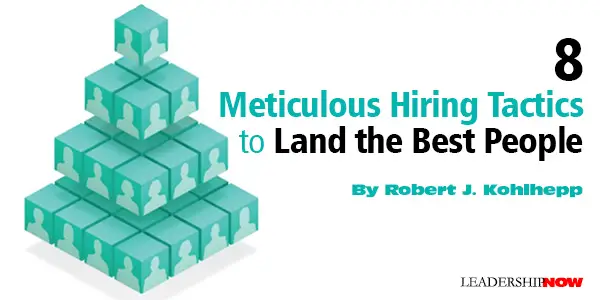
YOUR organization’s success comes down to who you hire. Just as great coaches don’t win many games without great players, great managers aren’t successful without the right people on their team. Finding, hiring, and developing great performers is the most important part of every manager’s job. One of the primary reasons for turnover in any organization is that the person who leaves or gets fired shouldn’t have been hired in the first place. A very structured process is essential for hiring the right people who are not only qualified to do the job but are also compatible with your organization. A meticulous process may require extra time on the front end but will save enormous time, energy, and money on the back end. Use these tactics to ensure success in your hiring process: 1. Conduct multiple interviews – When filling a position, conduct multiple interviews with each candidate, and recruit staff members to take part in the separate interviews. Following the interviews, bring together all the interviewers to discuss the candidate. You would be surprised how often a candidate answers the same question with a different answer. Look for unanimous consensus from all the people who participated in the interviews. 2. Account for “must-haves” and “preferreds” – For each job, establish “must-haves” and “preferreds.” A must-have is an absolute requirement on which you are unwilling to compromise. A preferred is a bonus attribute of a candidate. For example, an attorney who is licensed to practice in your state is a must-have, but a preferred qualification might be that he or she is licensed in adjoining states. 3. Examine past behavior – In interviews, the focus is on learning about past behavior because it often predicts future behavior. To better assess whether a job applicant might be a good fit, examine how the applicant behaved in the past. That’s not to say that people can’t change, but, in general, most people will continue to approach situations as they have in the past. To get reliable answers, ask situational questions. Examples could be: “What’s the most difficult decision you’ve ever made?” followed by “Tell me about that decision.” Or, “Have you ever fired anyone?” followed by “Tell me about the circumstances.” The goal is to understand how each candidate approaches or has approached situations and may act the next time a similar situation arises. 4. Check references – Rather than delegating the responsibility, the hiring manager should conduct the reference checks. Further, the hiring manager should make it a point to contact the former bosses from the candidate’s two most recent jobs. A boss can provide specific information about the candidate. Always ask a previous boss: “What areas did you ask the candidate to improve on in the most recent performance review?” You’d be surprised how often answers from the boss differ from those of the candidate in the interview. Reference checking is very important because the former bosses may provide insights that your interviews with the candidate won’t reveal. 5. Ask stress questions – Stress questions are those that test an applicant’s ability to perform under pressure. They require the candidate to react spontaneously to a stressful situation. Some examples of stress questions include: “How would you handle a customer who has verbally insulted you?” or “Why should I hire you?” or “How would you rate your performance in your previous role?” 6. Define the answers you’re looking for – As a good trial lawyer would tell you, “Don’t ever ask a question for which you don’t know the answer.” Similarly, you should always have a good idea of what constitutes a good answer to the questions you ask in an interview. Probe into any answers that you find either cursory or confusing. 7. Determine cultural compatibility – Every organization has its own culture. You know what it’s like to work at your organization and the kind of people who will fit in well. It’s important to ask questions that can reveal the potential compatibility of the candidate with the corporate culture. Specific questions could include: “How did you feel about your customers in previous jobs?” or “How did you feel about the people you worked with?” or “Tell me about your intensity in performing your job.” 8. Eliminate lukewarm candidates – From time to time, you may think you’re hiring the perfect candidate but later discover that you were wrong. But if your impression of a candidate is only lukewarm, you should refrain from hiring that person. Organizations hire lukewarm candidates because the hiring process is time-consuming and difficult, and they don’t wish to prolong it if no exceptional applicant surfaces. But making do with a mediocre candidate never works. You will be wrong every time. Hiring the right people is critical for your organization’s success. Use this structured, meticulous process to ensure that you hire well.  
Posted by Michael McKinney at 03:53 PM
06.25.21

Need More Fun at Work? 5 Do’s and 5 Don’ts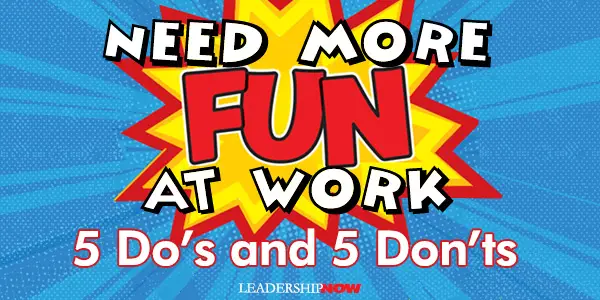
THERE’S much more to workplace fun than having a Ping-Pong table in the employee break room, free soda in the refrigerator, and an occasional office party. Prioritizing fun at work is really about embedding fun into the work culture. According to the employees who work for firms listed in Fortune’s “100 Best Companies to Work for in America,” the most defining characteristic of these organizations is they’re all “fun” places to work. Yet, there’s effort involved in making work fun, and it’s important to be intentional when crafting and tailoring fun to your employees’ desires! Here are some “do’s” and “don’ts” to help guide you in navigating workplace fun: Do’s Happy employees make for more productive employees. The University of Warwick conducted a study of more than 700 participants and concluded that increased happiness led to a 12% spike in productivity. And, according to research by Ben Waber, companies can increase productivity by up to 25% by making small changes that increase employees’ sense of fun and satisfaction. Take note of these “do’s” as you strive to implement a fun workplace culture:
Dont’s What’s fun to some may not be fun to others, so you need to get to know the people you work with and allow them the freedom and flexibility to have fun in ways they appreciate. Take note of these “don’ts” as you strive to implement a fun workplace culture:
Takeaways
 
Posted by Michael McKinney at 07:26 AM
01.15.21

Culture Renovation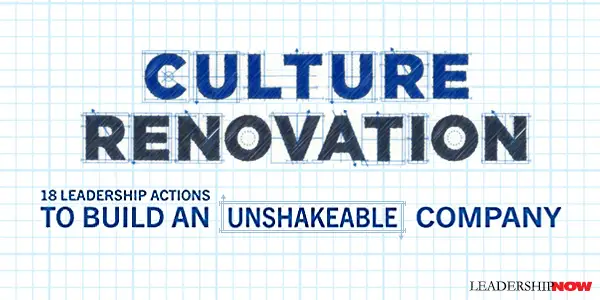
WE hear a lot about changing the culture. And the successful are more like renovations than they are like rebuilding the culture. Kevin Oakes advocates that mindset in Culture Renovation: 18 Leadership Actions to Build an Unshakeable Company Companies that effectively changed their cultures were successful because they were renovating what they had, not starting from scratch and completely rebuilding or transforming. Furthermore, he notes that the best time to renovate your culture is when all is well. Rarely do companies set out to change their culture when everything is calm and running smoothly, even though that is probably the best time to do it. Making the point that culture renovation begins at the top he replays the appointment of Satya Nadella as CEO of Microsoft after Steve Balmer in 2014. Cultural change at Microsoft began on day one. The key change was instilling a growth mindset. Microsoft’s culture had been rigid. Each employee had to prove to everyone that he or she was the smartest person in the room. Accountability—delivering on time and hitting numbers—trumped everything. Meetings were formal. If a senior leader wanted to tap the energy and creativity of someone lower down in the organization, she or he needed to invite that person’s boss, and so on. Hierarchy and pecking order had taken control, and spontaneity and creativity had suffered as a result. The culture change I wanted was actually rooted in the Microsoft I originally joined. The culture change I wanted was centered on exercising a growth mindset every day. The turnaround at Microsoft has been remarkable, and it started at the top. Oakes offers an 18-step culture change blueprint organized equally into three categories: Plan, Build, and Maintain. PLAN Step #1: Develop and Deploy a Comprehensive Listening Strategy. “Before an organization embarks on a culture renovation, it needs to first understand how the current culture is perceived. Too often, the senior team assumes they know what the culture represents. Too often, they are dead wrong.” Step #2: Figure Out What to Keep. Know what stays and what goes. Listen to employees (Step 1) is so important because “it not only illuminates what the culture is today, but it also helps determine the most positive and valued aspects of the company’s historical culture to carry forward.” Step #3: Set Your Cultural Path. “In the spirit of renovation, the new direction should acknowledge and embrace past successes, but set up the organization to forge new ground into an unknown future.” A carefully crafted purpose statement. Step #4: Define the Desired Behaviors. Once you have a short, pithy, and memorable purpose statement, the question is what behaviors will best support that statement. Step #5: Identify Influencers, Energizers, and Blockers. Know the informal organization using an organizational network analysis. Step #6: Determine How Progress Will Be Measured, Monitored, and Reported. “Ultimately, the reason for a culture renovation is to enable the organization to execute on its go-forward strategy. Because this change can sometimes take years, it’s important to define upfront what the indicators of a successful renovation should be, and to put in place mechanisms to monitor progress.” Oakes offers a number of common measures and methods. BUILD Step #7: Clearly Communicate That Change Is Coming. “To kick off a culture renovation, the CEO must articulate the purpose of the organization (whether new, old, or renovated), and that purpose must resonate with employees.” Step #8: Ferret Out Skeptics and Nonbelievers Early. This is the hardest step. “It’s the consistently de-energizing people that ultimately slow down or take down cultures. Ferret them out as early in the renovation as possible.” Step #9: Paint a Vision for the Future. The story matters. “73 percent of successful change efforts relied on stories.” A go-forward vision of the future. Most CEOs of corporate change failure attack previous leadership and focus their messages on the past. Step #10: Consciously Collaborate. Strong internal collaboration is important to drive change. The group must understand why they are coming together and what they are doing. Collaboration can go too far as in the case where “connectivity is through the roof because everyone believes they need to be consulted on decisions.” Step #11: Establish a Co-creation Mindset. “Though almost all successful culture change efforts begin top-down, it is critical to also get the buy-in of the workforce by creating a bottom-up (and middle-out) contribution mechanism.” Consider a Culture Hackathon. Ford “held a two-day event where employees worked in randomly selected teams to generate ideas to either fortify elements of the culture they loved or fix elements that weren’t serving the company well - #hackFORDculture. Step #12: Provide Training on the Desired Behaviors. Train leaders at all levels on the desired behaviors so that they can model them. “While leaders as teachers is one of the most effective ways to reinforce behaviors, it’s clear that successful culture change relies on overall leadership training across the organization.” MAINTAIN Step #13: Make Onboarding About Relationships Versus Red Tape. “If you want to maintain that culture renovation you worked so hard to put in place, you can start by improving your onboarding process.” The most overlooked aspect of onboarding: “Helping the new hire establish a network of trusted subject matter experts who will contribute to that person’s career success.” Step #14: Promote Those Who Best Represent the New. Behaviors that support the renovated culture should be rewarded. Showcase the “career advancement of individuals who best represent the new.” Step #15: Change Performance Management Practices. Most important is the “frequency and usefulness of feedback, clearly defining the business purpose of the performance process, and aligning it with the culture and values of the organization.” Step #16: Leverage Employee Affinity Groups. Interestingly, their research found that two-thirds of companies felt Employee Resource Groups were “more effective than other leadership development forums at developing leadership skills and competencies.” An ERGs primary benefit is to “raise awareness of the different groups of people that make up the workforce of most organizations.” Step #17: Increase the Focus on Talent Mobility. “During a culture renovation, one of the most successful talent initiatives an organization can focus on is rotating talent to strengthen ‘the pack’ and ensure the desired behaviors are exhibited throughout the organization.” Step #18: Don’t Underestimate the Value of External Sentiment. Use external feedback from places like Glassdoor, LinkedIn, and social media to monitor the progress of efforts to renovate your culture. Culture Renovation is less theory and more how to. You will find case studies and interviews with the participants of successful culture change. 
Posted by Michael McKinney at 07:35 AM
11.06.20

2020: The Opportunity of a Lifetime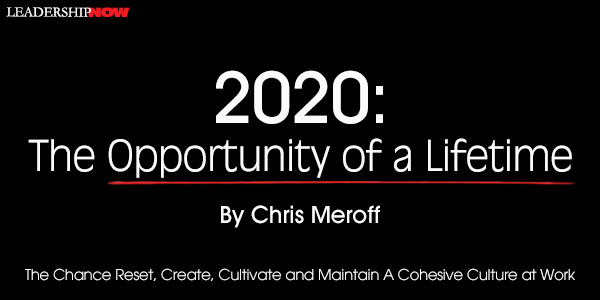
I AM A BIG BELIEVER that growth and transformation happens outside of our comfort zones. And this year has been anything but comfortable. Transformation is coming. This pandemic has wreaked havoc on our country in more ways than one. We are being forced to grow and adapt or fall by the wayside. While I am not advocating that a crisis is something to pursue, I do believe it forces us to grow in ways we would not have otherwise. This will be the greatest opportunity in our lifetimes to start over. A complete reset, to create, cultivate and maintain a cohesive culture at work. It can be a fresh start forced upon us by something out of our control. What has been a tragedy on many levels can be used for good. This can be life changing for so many. In order for transformation to come, we need to face reality for a second. If your company culture was toxic before, I can’t imagine what it will look like when you get back into the office. Dysfunction isn’t static. It’s either being addressed and fixed or it’s growing. Communication, which was likely already at a minimum in the workplace, became even quieter and more distant. If people were cynical and unhappy before, then what will getting back together look like? If they didn’t like their coworkers before, they won’t like them now. If they didn’t like their leadership before, they won’t now. Six months at home with their family, away from the drama around the office, and limited distractions has only reinforced their desire to stay as far away from the office as possible. A cohesive culture is impossible to achieve when your people aren’t at the office. So how do you make your company culture a place people are drawn to and not away from? Great cultures don’t just happen overnight. You can’t just hire your way to a fulfilled workplace of engaged employees and team members. There’s so much more to be done. It has to be strived for, all day every day. Conversations need to happen to establish what the purpose is, both for the company and the employee. We need to talk about where we want to go together and how we want to treat each other on the journey. Once we can agree to those things then we need to realign to them every single day. Everything we do should be done through the lens of purpose. If we can’t connect the task to purpose, then why are we doing it in the first place? A culture with a good purpose will protect itself.We need to affirm the intrinsic value in our people, choose to see the diversity they bring to the table and how we can achieve our goals by unifying together. These conversations won’t be casual breakroom talk or quick hallway catch-ups. They will be authentic and real unity driven conversations that foster community among employees and leaders. It is the role of a leader to get to know their people’s passions and soft skills—what makes them unique. Then learn how to apply those passions and soft skills to help us accomplish our purpose together. If we as leaders do this, we might look back some day and say that the silver lining, in a very difficult year, was the real and lasting change that made the workplace a destination, not just a means to an end.  
Posted by Michael McKinney at 09:38 AM
10.23.20

Want an Ideal Team Player? Find an Introvert
WHILE the introverts at the office may not be top-of-mind when it comes to assembling a project team, you could be overlooking valuable contributors. Too often, the ideas of introverts are drowned out, yet when sought out, can have true merit. Management guru and prolific author, Patrick Lencioni, wrote about the three characteristics of an ideal team player – hungry, smart, and humble. That third trait, which includes sharing credit and defining success collectively rather than individually, is one most often associated with introverts. A measure of an effective team is that it utilizes all team members’ strengths. Introverts are keen observers, listeners, and deep thinkers. Without unlocking the introverted voice, teams won’t achieve their true potential. Teams involving both introverts and extroverts get exponentially more accomplished. It’s like having one group that can see close up and one that can see into the distance. Here are five approaches to more inclusive team meetings that insure introverts’ input: 1. Implement a 1-minute rule. Ask that each team member speak for 1 minute on a work-related topic. In structuring team meetings so that everyone has a chance to contribute for the same (short) amount of time, introverts are ensured the same opportunity to be heard as their extroverted counterparts. 2. Pair up. Pat Wadors, chief talent officer at ServiceNow, structures team meetings to be more inclusive by pairing up team members. They can privately check in with each other via chat or a program like Slack to see if either needs more explanation or context. Extroverted team members can advocate for introverts if they want to make a comment and are having trouble interjecting their thoughts. Additionally, the buddy system helps to increase compassion and understanding among team members and build one-on-one relationships. 3. Create team member user manuals. Consider the creative technique of asking team members to write their own user manuals that help others understand how they like to work. It can include their collaboration style, ideal times of the day for group and solo work, their motivations and stressors, and their interests in and outside of work. User manuals are a great tool for introverts – who often prefer written communication – to let the rest of the team know their preferences. 4. Consider teams of two or three. Introverts often prefer one-on-one or small-group meetings to larger ones. Instead of all-person team meetings all of the time, consider breaking up your team into smaller groups. These groups of two or three can focus on specific tasks. Encouraging these smaller groups to take walking meetings may also make it easier for introverted team members to speak up. Walking while talking helps to get introverts out of their head and facilitates the flow of ideas as they think on their feet (literally). 5. Foster transparency. Consider using a design or system map to get both introverts and extroverts involved. According to Service Design Tools, this is a representation showing in a single frame all the different actors involved and their mutual links – such as flows of materials, energy, information, money, documents, and more. You can display it and add or remove Post-it notes to provide supplementary information. Too often, introverts are expected to yield the floor to extroverts who are very comfortable with speaking up. Teams who include everyone’s voice will engage the introverts on the team. The team will find a well of resources in their quiet, calm contributors as well as their expressive, energetic ones.  
Posted by Michael McKinney at 03:10 PM
10.12.20

Stay Indispensable by Cultivating These Key Ingredients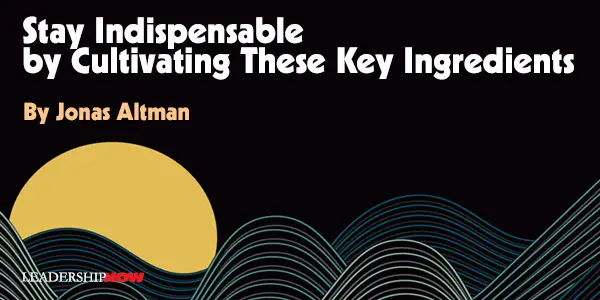
IN 1984 a typical business competency would last 30 years. Today, it’s more akin to five. We’re changing jobs more than ever and pursuing multiple careers and projects simultaneously. Take a moment to consider how many jobs you’ve had and how many careers you’re yet to embark upon? The ability to adapt and thrive at work, also known as your adaptability quotient, demands continuous learning and cultivation. The paradigm shift in work is, first and foremost, a mental one. As humans, what we crave are open, fluid, and personalized systems. And the world of work is gradually opening to provide just that. Enter the shaper. A shaper is someone who gets energized by work. How they work provides for the highest creative expression of self. What shapers do every day serve themselves and the greater good. They are on a path that embraces their uniqueness so as to lead deep and fulfilling lives. Taking a Cue from a Comedian “No one is any one thing,” sums up Martin Short’s outlook on life. He’s one of the few people in comedy who’s capable of laughing on both the outside and the inside. The youngest of five children, when he was 12 years old, his eldest brother died in a car accident. Six years later, his mother died of cancer, and two years after that his father passed away from a stroke. His wife of 30 years died of cancer at age 58. Despite all this, Short still demonstrates an unparalleled joie de vivre—he just keeps moving forward. Whether performing a duet with Steve Martin, embarrassing Drake, or playing a host of oddball characters, he’s always experimenting and learning. He welcomes change and regularly takes risks. The comedic chameleon may well be the funniest man alive. It’s this same strain of continuous reinvention that helps the shaper thrive. Stoicism and Modern Modalities Work is now a process and practice to improve. We must demonstrate the fortitude that comes with owning a growth mindset. We need to play, invent, and create—because in order to build more resiliency. A marked departure from the rigid ways of the past, the new mode of work is much more fluid. It begs us to deal with more ambiguity and complexity. Modern ways of working require us to consistently tap into our cognitive powers, creative energy, and collective genius. The hallmark modality of the new world of work it this fluidity—the ability to move quickly and with dexterity amid constant change. A learned practice that ebbs and flows being fluid is a sign of strength in times of uncertainty. Those that shine in the workplace move with a similar ease to water—flowing in harmony with everything they encounter. Cultivating this practice means seeking change, always improving, and expertly navigating towards a future that’s only coming at us faster. Vital Ingredients Many workers now function like Apps on a smartphone, sitting pretty on top of a company’s operating system (OS). They are selected, downloaded, updated, shared, and deleted on demand. The robustness of this OS and the fluidity of the Apps have become an intricate dance to crack. The onus falls on us to safeguard our positioning. We want to ensure we’re featured on the homescreen, all the while protecting our freedoms. While companies continue to shimmy and shuffle to attract talent, we continue to search for meaning and challenge. These are the vital ingredients to help insulate against existential dread and stay featured on the home screen:
These qualities are embodied by shapers and are always in flux, regularly being flexed, and always improved upon. The intention is to become unflappable and adapt to change with grace. Like Martin Short, taking a diverse and nimble approach to work is one way to deal with volatility. And while having a solid skill set is a great start, it’s really the ability to move fluidly between different disciplines while learning new skills on the go that differentiate shapers from the crowd.  
Posted by Michael McKinney at 08:15 AM
10.05.20

Leading an Emotionally Traumatized Workforce in the Midst of a Pandemic
YOUR COMPANY has begun its phased reopening. You are excited to be back in the office and a more normal routine. However, things are not as normal as you thought they would be. Not everyone shares in your enthusiasm, and the culture of your team seems to have changed. Your team is easily distracted and anxious. Even your top performers are not themselves. You are struggling to understand what the issues are and how to address them. Should you allow performance to seek its own level? Should you remind everyone of the previous performance standards and enforce them rigidly? How long do you let the faltering performance continue? The issue you, as the leader, are experiencing is the complexity of grief caused by a global pandemic. Grief is triggered any time a person faces the loss of what they considered to be their normal reality. The pandemic has caused many realities to shift. Some genuine, and some perceived. Many of these changes are losses. Here are some your people may be experiencing:
Grief takes on many shapes and forms. When the global pandemic struck the United States, it was sudden and unnatural. This generation has never experienced anything like this in our lifetime. When losses of loved ones, employment, a home, or anything people have a deep relationship with are sudden and unnatural, the grief experienced is more profound, more prolonged, and more complex. Our psyche does not know how to process these types of losses. All of the instances cited above are the result of the sudden shift in people’s reality. This scenario is playing out in every business and at every level across the country. The result: people are in denial, people are angry, people are bargaining, and people are depressed—all stages of the grief cycle. Professional sports are not even immune to this as players are electing to sit out the abbreviated seasons as a result of the fear that their team will not be able to keep them safe. So how should a leader deal with this situation? As a leader, it is up to you to adapt your leadership style to help guide employees through their new life and work reality. Adaptive leaders are versatile and adept at balancing the five evaluation attributes of their people: stewardship, trust, empowerment, collaboration, and communication frequency. By adjusting your leadership style across these five elements, the adaptive leader helps grieving or emotionally traumatized employees excel at work through times such as these. Adaptive leaders understand that employees who experience an emotionally traumatic event are not the same people when they return to work as they were before the event. Emotionally traumatic events impact both the person's ability to perform and their potential while they work through the event and the subsequent grief emotions. Here are four tips for leading through these times:
We are not suggesting leaders relax performance standards or take a soft approach to leading—quite to the contrary. What we are recommending is the most challenging form of leadership. We are suggesting the leader should confront the issues head-on, but only after genuinely seeking to understand what the issues are from the employee’s point of view. It takes a strong and confident leader to engage people on a personal and emotional level. If you implement these four tips, your team will see you as a compassionate leader who is willing to adapt your style to meet them where they are as they navigate their new realities. Now more than ever, people are looking to their employer to demonstrate that they care about them. How a leader deals with these difficult situations sends a highly visible message. The result will be higher levels of trust in you and the organization, higher morale, higher productivity, and higher levels of loyalty and engagement. We would enjoy hearing about your leadership experiences as they relate to this topic. Visit our website, www.griefleaders.com, and share your story on our contact page.  
Posted by Michael McKinney at 07:02 AM
09.21.20

Game Changer: How to Be A 10x Talent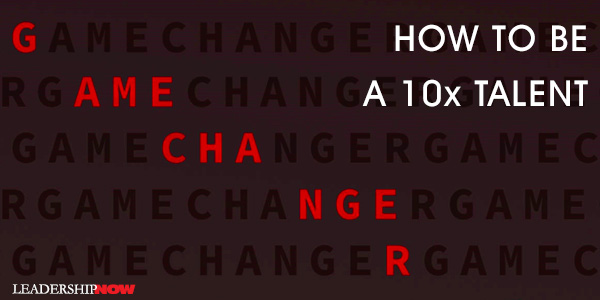
WHAT is a 10x talent? 10x talent, as the label implies, is able to deliver ten times more than is expected, but what makes them so valuable is that they are multidimensional. They are smart, good communicators, and have interests beyond their core specialty. Their curiosity and love of learning drives them to do more and do it better. They love what they do, and they love solving problems. In Game Changer, authors Michael Solomon and Rishon Blumberg report that “Tech and digitization have disrupted the very foundation of all ventures, business, government, or otherwise and in doing so have handed over controls to those who have the exceptional skills to provide efficiency and meaningful growth.” The game has changed, and that puts 10x talent in the driver’s seat. In addition, it demands a new kind of 10x management. There are really two sides to this idea. There is the talent, and then there are the people managing and developing that talent. Importantly, those managing the talent should be working to become 10x talent themselves. The first part of the book discusses how to become a 10x company and attract 10x talent. Part two is about how you can become 10x talent. As an organization, you have to give them the opportunity to optimize their whole life—working with the whole person from the inside out. “It’s a level of respect that turns the very concept of boss on its head.” The authors say the most important thing you can understand about 10x talent is that they love what they do. But 10xers are not only high IQ but high EQ. They work well on teams. “Making it on the team is the new success.” And of course, this means openness to feedback. Ralph Perrine, the director of the Innovation Garage, highlighted the gap between the excitement of the innovator and well, everyone else. For him, 10x development “means not only finding a way to communicate your passion, but also finding a way to absorb the other party’s skepticism.” He says, “Driving change is hard. Over time, I’ve learned that our products improve when we’re willing to hear others tell us the many ways things might go wrong.” An important key to all of this is curiosity, humility and therefore, teachability. “Great talent becomes 10x when it develops the quality of manageability—the ability to seek out and internalize powerful outside guidance, built on an invisible desire for growth and improvement.” Tech problems tend to be interdisciplinary in nature, and if you can only do one thing, your value ends when you hit the border of your skills. True 10xers don’t hit that border—they plow right on through and keep learning. The authors introduce what they call the Manageability Continuum, and everyone you meet is somewhere on this spectrum. At one end is the Success Impulse. It is the “internal tendency to make positive choices that steer talents toward both their goals and the company’s goals.” At the other end of the spectrum is the Sabotage Impulse. It is victim mentality. It’s denial. When you see it, run from it. Unmanageability looks like this: “If I can’t tell you the truth, no matter how much nonviolent language I use, if I can’t have an honest discussion about something that’s not working without you personalizing it, without you feeling victimized, then we are nowhere.” Talent will never be enough to overcome the Sabotage Impulse. The manageability test comes down to three questions:
Wherever you are on the Manageability Continuum, you can improve. A 10x manager is someone who wants the best for you, is objective, and can see what you can’t see both personally and situationally. They shine a light on your blind spots. “Following tough advice is takes real grit, especially when you’re already experiencing some success.” No matter how good you are, you will need an outside point of view to learn and grow and make your most important decisions. A 10x manager “dares to study the future in ways you aren’t ready to explore.” They add, “sometimes it’s all about getting a client [a 10xer] to do what he or she does best, but in a new uncomfortable sphere.” The best 10xers wear two hats: the 10x manager and the 10x talent. Anyone with 10x talent should be able to act as a managerial force for others. “Even those 10xers who are individual contributors by choice still need to interact in ways that require management skills. The great news is, by being the manger for someone whose career you genuinely care about, you are receiving a hands-on education in what constitutes receiving strong management. The better you can manage, the better you can be managed.” By helping others, you help yourself. “As the future threatens even greater sweeping changes in the workplace, with technology developing an ever more acute ability to replicate human processes, we believe that the accent on empathy, talent, and mutual guidance can be the guiding light for many and a lifesaver for some.” 
Posted by Michael McKinney at 06:16 AM
08.18.20

Five Frequencies That Are Driving Your Culture (for better or worse)
IS YOUR CULTURE holding you back? Are the signals you are broadcasting as a leader, creating the culture you want—you need? Culture experts Jeff Grimshaw, Tanya Mann, Lynne Viscio, and Jennifer Landis say in Five Frequencies that to make a good culture great, leaders must deliberately transmit strong and steady signals. Leaders create culture for better or worse, through the signals they are consciously or unconsciously broadcasting over five frequencies. To change a culture, you need to broadcast a strong, steady signal on each of these frequencies: Their Decisions and Actions Example is everything—especially when it is inconvenient and costs you something. If it is truly a “value,” what are you willing to pay for it? Think in the long-term. “Go long-term greedy.” “This can mean avoiding ethical shortcuts, hiring people smarter than you, delegating more, and helping prepare high performers for success beyond your team.” What They Reward and Recognize Reward the behaviors you want to see more of. “You are responsible for the dysfunctional behaviors that so bother you.” Everyone brings their emotions to work. “Understand and leverage the emotional algorithms that motivate your people.” Understand that it is all relative, scarcity and timing matter, and everyone appreciates being appreciated. What They Tolerate (Or Don’t) “Leaders are ultimately defined by what they tolerate.” Be sure the boundaries are clearly defined as well as the consequences. And don’t make excuses because you don’t want to feel bad or you can’t hold a particular star performer accountable, or because it’s really no big deal. It’s all-important, and consistency is vital. What you tolerate or don’t tolerate is a balance. “When you decide to become more tolerant of some things (like where people work), you must become, if anything, less tolerant of other things (like the work not getting done). As Harvard professor Gary P. Pisano puts it:” A tolerance for failure requires an intolerance for incompetence. A willingness to experiment requires rigorous discipline. Psychological safety requires comfort with brutal candor. Collaboration must be balanced with individual accountability. How They Show Up Informally When you show up, you “bring the weather.” People notice a leader’s tone, mood, and focus. They are weather in any organization. What do kind of weather do you bring? When considering how you show up, the authors advise you to relinquish your raft. They introduce the concept with a story: A traveler on an important journey comes to a raging river. It seems there’s no way to cross. And that’s terrible news because this is an important journey. Fortunately, she spots a rickety old raft on the bank, off in the brush. With trepidation, she pushes the raft into the water, hops on, and amazingly, uses it to reach the other side. She’s able to continue her important journey. She thinks: I may encounter other raging rivers down the path, so I must keep this raft. So she carries the raft on her back as she continues her journey. It’s a heavy raft, and it slows her down. When fellow travelers point this out, she’s incredulous: “You don’t understand,” she says. “If it wasn’t for this raft, I wouldn’t be where I am today!” And she’s right. That’s literally true. The problem is: If she doesn’t put down the raft, she may not get to where she needs to go on her important journey. It’s your baggage. It’s your reactive tendencies that may have worked for you in the past that are no longer getting you where you need to be. Reactive tendencies like going with the flow, control, the need to be the hero, or being overly protective of your ego, eventually bring you diminishing returns. Their Formal Communications Formal communications don’t work on their own, but they serve to reinforce the other four frequencies. Approach your communications as a story to make it memorable. And say it over and over. “Go past the puke point because that’s often the turning point where employees are just starting to truly get it.” Have a backstory. Know where you came from. “Look for stories of people demonstrating the behavior you want to see more of, especially when it’s not easy for them to do so.” Fill the communication vacuums. “Don’t push your people to the black market.” Know, Feel, Do To establish a reliable culture, you need to measure where you are and where you need to go. The authors call it Know, Feel, Do: what employees know, what they feel, and what they do. The authors advise us to work backward and forwards. Looking forward, they ask, “What is the culture that makes this outcome possible and probable? What will employees consistently KNOW? FEEL? DO?” Looking at each of the five signals, what will you need to broadcast to your employees in each of the five signal areas? It is also necessary to look backward and see where your current culture came from. What did each of the signals contribute to your current culture? It will help you to know what to change in order to close the gap from where to are to where you want to be. 
Posted by Michael McKinney at 04:15 PM
08.11.20

Full-Spectrum Thinking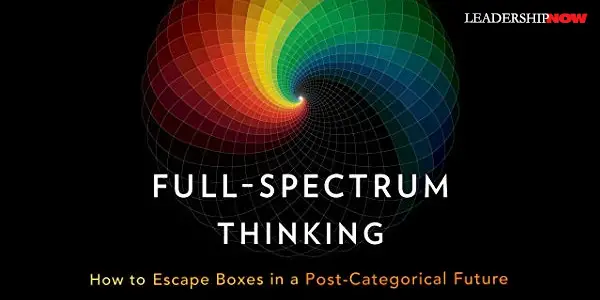
FULL-SPECTRUM THINKING is not common, and never has it been. And as the world becomes more complex, confused, and scrambled, it has never been more critical. Bob Johansen describes full-spectrum thinking as “the ability to seek patterns and clarity across gradients of possibility—outside, across, beyond, or maybe even without any boxes or categories—while resisting false certainty.” In Full-Spectrum Thinking, Johansen writes that “the future will punish categorical thinking but reward full-spectrum thinking.” The future will be a global scramble that will be very difficult to categorize. You will need a full-spectrum mindset to have any hint of what is going on. The scramble will be fraught with toxic misinformation (not necessarily intentional), disinformation (intentional), and distrust. In this future, it will be very dangerous to fit new threats or new opportunities into old categories of thought. Fortunately, new spectrums of thought will become possible in new ways over the next decade. Full-spectrum thinking will be required in order to thrive. Full-spectrum thinking (FST) combines the “nuances of the analog world with the power and scale of digital.” I like that. FST is critical thinking that moves beyond binary, simplistic, categorical thinking. It’s questioning assumptions, stereotypes, and categories. Mindless categorizing is harmful and requires very little thinking. It’s dismissive. They create certainties that block us from seeing possibilities. They are, in a word, constraining. Johansen is not against categories “if they are fair and do no harm. All of us need to create structures and categories of some kind that work for us and for others.” He adds, “Rigid categorial thinking is a bad habit we need to break.” Rigid categorial thinking leads us to certainty, which Johansen and others have declared is the opposite of clarity. And in a narrow sense, I think that is true. Certainty without humility almost certainly, will lead to a lack of clarity. Certainty can blind us to reality—clarity—since we only see things from our own certain perspective. FST demands that we question and take a wider, more inclusive view of the issues before us. But there is a certainty that guides us to clarity and causation and keeps us from adding categories, confusion, and complexity where there are none. And we see that happening all around us. Johansen spends a good deal of the book applying FST to the future of business, technology, our lifestyle, and our sense of meaning. He noes that a forecast is to be evaluated on “whether or not it provokes a better decision in the present.” Adding, “Strategy lives between insight and action” and “every good strategy is based on a compelling insight.” Most companies think in terms of Now, Next, Future. Johansen advises us to shift our strategic orientation to Now, FUTURE, Next. Most of our attention should go to Now. But in a highly uncertain future, we need to look to the future (10 years ahead) for clarity then come back to Next to act in the now. Johansen looks at business development. “Think beyond products. Think especially beyond commodity products where competition is based only on price.” Organizations of the future will move beyond command-and-control to the U.S. Army’s practice of commanders intent or “direction is very clear; execution is very flexible.” Leaders will still be a source of clarity, but the leader will not always be on top. The source of clarity should be grounding, and it should flow up and out across the network. In an interesting chapter on Human-Machine symbiosis, he reimagines the human resources function. Perhaps we need to refer to it as Human-Computing Resources because humans are increasingly augmented by digital resources. Human resource professionals will need the ability to better understand the capabilities of nonhuman and computer-augmented talent. Intelligent coworkers with powerful digital augmentation will be everywhere. And this. As video gaming as a learning medium becomes more widespread, human resource practitioners will need to be “experts in the medium of immersive learning through digital and in-person experiences.” Categories themselves will also become “more fluid and cross-spectrum” as opposed to being binary—in or out. “Diversity will become more important even as it becomes more difficult to categorize.” Creating or finding meaning will become a growth industry. From faith springs hope. Faith has the power to shape our future. Faith grows out of a learning mindset. Faith allows you to navigate your way through things you don’t have all figured out. Faith helps you make your way through fear. Faith is grounded in a sense of humility and openness to learning in an uncertain future. Faith implies a full-spectrum mindset. Rituals and habits help to create meaning. “Rituals are a condensed code of meaning, and repeating the code [like saying “I love you” every day] reinforces the meaning.” Johansen believes that true digital natives (24 or under in 2020) are very good at full-spectrum thinking. “The true digital natives will challenge the social order.” Of course, every generation of young people challenges the social order whether they were brought up on video games and digital content or not. He points out that, “Kids are born with full-spectrum thinking, but adults, schools, and society often force it out of them with education, testing, technology, and culture.” How true. The difficulty for digital natives (like the rest of us) is not relying on soundbites and headlines to form our opinions. Most young people question the status quo and defy categories placed in front of them (or on them) by others. However, they also need to learn to express their thoughts and challenges in an emotionally intelligent way. Full-Spectrum Thinking does make you stop and think about the categories, boxes, labels we place on people and things. We need to learn to think deeper and broader about the issues before us. It is a valuable and cautionary book. Full-spectrum thinking will provide powerful ways to make sense out of new opportunities without assuming that new experiences mirror old categories, boxes, labels, or buckets. Full-spectrum thinking will help people avoid thoughtless labeling of others. Full-spectrum thinking will be a technology-enabled antidote to polarization and simplistic thinking. 
Posted by Michael McKinney at 05:56 PM
07.20.20

How to Align Yourself (And Others) Up, Down, Sideways, And Diagonally on the Chain of Command to Improve Outcomes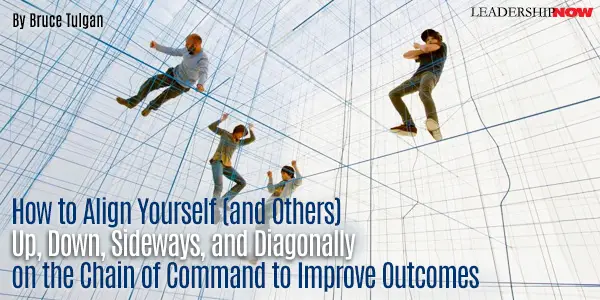
YOU are likely being asked to “work things out at your own level” in your job more and more. You’ve probably asked your direct reports to work things out at their own level, too. The problem is that, too often, accountability and results suffer because no one has the authority to make decisions and get things done. You, your colleagues, and your direct reports are grappling with what I call “the authority conundrum.” The goal is to empower collaboration throughout the organization as far down the chain of command as possible. But when there’s a problem and you’re left to work things out at your own level, by definition nobody has the power of rank to resolve things swiftly and efficiently. And the conundrum emerges even when you are a manager. One person might have a higher rank, but no one has direct authority, which complicates the relationship even more. What can you do? The solution is all about alignment. How you align yourself in terms of decision making and support—and with whom—is the first core mechanism of becoming indispensable at work. Remember, somebody is always in charge. Decisions are being made at a higher level. If you are going to have the power to operate without authority and work things out at your own level—what I call working sideways (and diagonal)—then, first, you’ve got to align yourself with the people making decisions: you’ve got to go vertical. Go Vertical Before Going Sideways (or Diagonal) At work you deal with so many people from all over the organization chart—up, down, sideways, and diagonal— that in order to keep your priorities straight and set yourself up for success, you must align yourself vertically along the way. You need to know clearly where you have discretion and where you don’t. The only place to get that clarity is from above. Get in the habit of over-communicating with your boss a little. Clarify expectations, priorities, and parameters. Ask for reviews of drafts or work in progress. Make sure you are maintaining some form of highly-structured, one-on-one communication on a regular basis. The same goes for your direct reports. You must align with them so they understand what is expected of them and have the authority to make choices and “work things out at their own level.” What does it take to attain such vertical alignment? Let’s look at managing up (managing your bosses) and down (just plain managing your direct reports), because what needs to happen for alignment in both directions is the same. If you are anybody’s boss, that is a huge responsibility. Do not take it lightly. And if your boss is not managing you, then you had better start managing your boss. Align with Your Boss to Manage Competing Priorities Let’s say you’re involved in a special project that requires you to regularly collaborate with others. But over time, this cross-functional work requires more and more of your daily effort. Often, this is because of “scope creep”—the bounds of the project expand. What happens to you, though, is what I call “role creep.” Your role in this special project takes on its own life and starts to take over your job. You likely try to deal with it. But you can’t pull out of this overcommitment alone: everyone and everything are behind schedule, and it looks as if this project will continue even longer. At this point, you have three options:
Regardless of the option you choose, the most important thing is, first, go vertical or manage up. You need to be in dialogue with your boss on the matter, checking in at every step. Aisha is a marketing executive who found herself overcommitted after being pulled into a seemingly endless project on a cross-functional team. She wisely sat down with her boss to discuss what to do. It turned out that neither saw much of a choice; the project had to be done and so did her regular job. Aisha was the only real candidate for both. But she felt a whole lot better making the choice to play the superhero with her boss’s support. Now they both shared responsibility for the fact that Aisha was carrying an overwhelming workload for an extended period of time. Aisha kept up the regular structured dialogue with her boss, and at some point, the boss saw that she was doing a spectacular job balancing the overload—and he recommended her for a promotion. But even if Aisha had begun to drown in overcommitment and not handled it well, because she and her boss stayed in dialogue, they were both more likely to have seen that coming. Her boss could have provided her with extra support staff or someone who could backfill part of Aisha’s work in her primary job or on the extra project, or both. The key is, no matter what option Aisha had chosen, being in alignment with her boss ensured she would have the support and resources she needed to get the work done and be appropriately rewarded and recognized for her efforts. Align with Your Direct Reports Just as you must stay aligned with your boss, your direct reports need to stay aligned with you, and you need to take responsibility for ensuring that alignment. Practicing regular, structured dialogue with every single person who reports to you is how you make sure they have the power they need to work things out at their level—to make decisions and take action. Are there problems that need solving now or that are hovering on the horizon? Are there any needed extra resources you should secure, or any instructions or goals that aren’t clear? Has anything happened since the last time you talked to the person that you should know about? So, first, closely track your direct reports’ workloads—monitor every individual’s available productive capacity (what many refer to as “bandwidth”—in other words, “Exactly how much more work can you handle?”). Second, make sure you are not the one who is overcommitting your own direct reports. Third, when your direct reports do start taking on so much that they risk overcommitment, use your regular structured dialogues with them to help them balance all of their competing priorities by providing the kind of ongoing support Aisha’s boss gave her. Aligning Yourself Sideways—and Diagonal If you are doing the work I’ve just described to align vertically, up and down, at every step, then you’ll be in a much stronger position to maintain alignment in your sideways and diagonal working relationships too. You likely are conducting the majority of your communication via email and virtually in structured project meetings. Take this as some good news! Good use of structured meetings mitigates a lot of miscommunications and misunderstandings. The bad news is, these meetings can start to take on a life of their own. Be rigorous about good virtual meeting protocol. Take detailed notes. Continue conversations one-on-one and in small groups outside of the team meeting, when you can. Make an outline of who needs to know what information, and structure your meetings around that outline with other team members. My firm’s decades of research show that the more rhyme and reason—substance and structure—that you put into your communication in any working relationship, the better things will go: fewer unnecessary problems occur, and those that do get identified are solved more quickly; resources are better planned and less often squandered; people are more likely to concur about what they’ve agreed on; and fewer conflicts occur within the ranks.  
Posted by Michael McKinney at 07:55 AM
05.13.20

How Do You Create A Sense of Belonging at Work?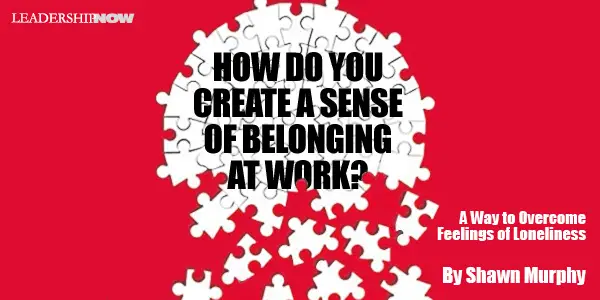
IN a Cigna Health report from 2019, 61 percent of people in the study reported feeling lonely. Why? According to the findings, Americans felt that they don’t have enough social support, not enough meaningful interactions, struggle with physical and mental health issues, and can’t find a way to balance the demands in their personal and professional worlds. Well, with a global pandemic and shelter-in-place orders, employees are working from home and are forced to limit their physical interactions with colleagues, family, and friends. Feelings of loneliness and isolation are quite common today. However, companies and their leaders can do something to counteract the deleterious effects of loneliness. In the context of the workplace, loneliness undermines performance and productivity, at a minimum. Leaders can turn to a solution that costs little and has major dividends: a sense of belonging. Does this surprise you? It shouldn’t. Throughout human history, a sense of belonging has been ingrained into our DNA. The comfort of friendships and the safety derived from being part of a community have always been one of the most powerful forces shaping our human experience. What is belonging at work? It’s the experience of feeling valued, wanted, and welcomed. Feeling valued at work: When employees believe their contributions, effort, and personal sacrifices are expressly appreciated. Feeling wanted at work: When employees believe their boss and the organization care about them as a whole person and not simply as a means to an end. Feeling welcomed at work: When employees believe they have a place in their team When leaders can shape the experience of belonging, employees are positioned to drive better business results. What’s more, in this era of working from home, belonging helps combat feelings of loneliness. My research on belonging in high-performing companies like the Container Store, LinkedIn, and Barry-Wehmiller show that relating to employees as people – and not just resources to get work done – can lead to tightly-knit teams that deliver breakthrough performances and astonishing results. So how do you create a sense of belonging at work? Here are things to think about:
Let me be clear about one thing: We don’t need to make belonging a strategic initiative. It is always available to use in those micro-moments or grand gestures in workplace experiences. And when it comes to feelings of loneliness, leaders simply need to increase their one-to-one interactions with employees who are working remotely. Simple gestures like calling and checking to see how people are doing make a difference. What’s more, when leaders set aside time to talk about non-work-related matters with employees, it signals that their wellbeing is important. Still, because of human tendencies to make messes, companies do need to be intentional about shaping belonging. The whole of the workforce is likely unaware of how their life is influenced by it. When you decide to co-create a sense of belonging, some might be skeptical. But remember, belonging is something that everyone craves. In a way, that makes it priceless – and a good reason to create experiences for it.  
Posted by Michael McKinney at 11:32 AM
03.06.20

Culture Makes the Difference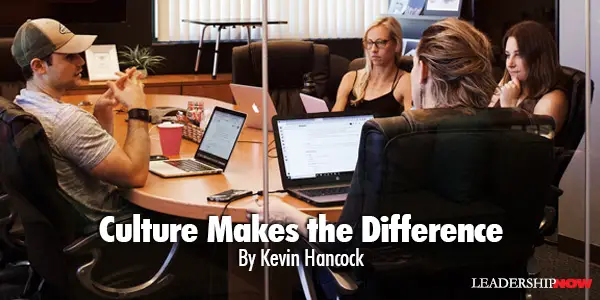
WHAT differentiates companies? It’s generally not products, services, facilities, or equipment. In our industry, for example, our lumberyard competitors sell essentially the same assortment of building materials that we do. Across New England, our white pine sawmill competitors make products that are very similar to our own. Additionally, we all tend to sell our products at comparable prices. So, what differentiates one company from another? Years ago, I would have said it was people who make the difference and separate companies. But I have come to realize that’s not the whole story. Certain companies may think they have the "best people," but the truth is, great people are everywhere—the planet is filled with them. For example, the United States has a more productive economy per capita than Europe, but no one would take this to mean that America has better people than Europe does. America is filled with great people, and so is Europe—and, so is every other country on earth. People are inherently great by virtue of their common humanity. So, if products don’t make the difference, and great people are everywhere, then what separates one organization from another? The answer is culture. Culture makes the difference. An organization’s culture either creates an environment where great people can flourish, or an environment where people are frustrated, held back, or stymied. What makes one corporate culture different from another? To me, it’s all about control and where it lives. Some organizations collect leadership power into the bureaucratic center, where a few people can make the majority of the decisions for the many. This is the traditional model of business—and government—leadership and, during a period of time in human history, this may have been optimal. But, that time has passed. In the 21st century, organizations that disperse power, share leadership, and give everyone a voice are going to win because they recognize and celebrate the capabilities of everyone on the team. These types of cultures don’t see employees as expendable commodities whose purpose is to serve the company. In fact, these types of cultures flip the traditional script by recognizing that the company exists to serve the people who work there. In a great company, profit is an outcome of a higher calling. That higher calling is the celebration of the human spirit and human capacity. In this way, culture makes all the difference. This is why culture is so important to us at Hancock Lumber. We want our company to be a place where every person on the team is trusted, valued, respected, and heard. Work should serve the people who do it in more than just economic ways. Work should be a place where humans flourish—where people learn, lead, and grow. If the employees of a company have an exceptional experience, they will ensure that customers thrive and will protect and grow their company with loyalty and pride. Culture, it turns out, makes the difference. Great people are everywhere, but great cultures aren’t – that’s what separates one company from another.  
Posted by Michael McKinney at 02:27 PM
02.21.20

All You Have to Do Is Ask
IF WE ARE HONEST with ourselves, we know there are times we need help. We just don’t want to ask for it. We’re confident we can figure it out. In time. But here’s the thing. There’s nothing we are going through or trying to figure out that others haven’t blazed a trail for us already. We just need to ask. Wayne Baker says, “you never know what people know—or who they know—until you ask. Asking for help can mean the difference between success and failure.” In All You Have to Do Is Ask he identifies eight reasons why we don’t or won’t ask. As a result, we leave a lot of answers, solutions and resources on the table for no good reason. And here are eight no good reasons:
That last reason—the fear of seeming selfish—relates to the proverb that it’s better to give than receive. That’s true. We want to be givers, but that doesn’t make receiving a bad thing. “There’s no giving without receiving, and there is no receiving without giving. And it’s the request that starts the wheel turning.” Baker offers a quick scientific assessment in the book (or online) to determine what style of asking/giving you tend to choose. And it is a choice. Are you an overgenerous giver, a selfish taker, a lone wolf, or a giver-requester? These types all represent “choices you can make about how you want to operate in the world.”
The place to begin is to understand and articulate your needs. Know what you are trying to accomplish and when. With that in mind, formulate a SMART request. That is a Specific (“a specific request yields more help than a vague one”), Meaningful (“Why is the request important to you?”), Action-oriented (What action do you want to be taken?), Realistic (it may be a serious long-shot, but within the realm of possibility), and Time-bound (“every request should have a due date”) request. After you have formulated your request, you need to figure out who to ask. Who knows what you need to know or who you need to talk to? Go outside your usual circle of contacts. Then ASK. And a good piece of advice: “Rejection is just an opinion. And opinions change. In other words, you can find ways to turn a no into a yes.” Baker offers much more specific advice and examples throughout but let me mention two tools that have proven effective that Wayne Baker and Adam Grant have developed. The first is Reciprocity Rings. Reciprocity Rings A Reciprocity Ring is a group activity consisting of 20 or so people that gather together and share a request with the group one by one. “Other members of the group pause to consider how they could help: Do I have the resource the person needs? Of not, do I know someone in my network who might be able to help? Because it’s much easier for people to make a request when they know that everyone must make one, every participant is required to make a request; asking is the ‘ticket of admission’ to the Reciprocity Ring.” Reciprocity Rings have been implemented successfully at Google, General Motors, IBM, Citigroup, UPS, and others. Givitas Givitas is a collaborative technology platform that provides a safe platform for requesting, giving, and receiving help across boundaries across a vast scale. It helps you share widely beyond the usual suspects. Platforms like Givitas allow people to get what they need without having to repeatedly tap all the same experts or all the usual go-to people because requests are decentralized and broadcast across the vast network. Thanks For Asking We’ve all asked for help only to be rebuffed or made to look stupid. Of course, we recognize and reward people for giving help, but we don’t typically reward people for asking for help. “How our request is received, how we are treated, and how the help is granted determines whether we get discouraged, or encouraged to make asking a personal practice.” With both organizational and individual success at stake, we need to rethink our responses to asking. “Recognizing, appreciating, and rewarding those who ask is as critical as doing the same for those who answer.” Baker shares informal and formal ways we can as individuals and organizations recognize, reward, and encourage asking. Asking improves individual performance and effectiveness. All You Have to Do Is Ask will change your appreciation of asking. It certainly changed my view. 
Posted by Michael McKinney at 05:34 PM
11.08.19

Is a Lack of Intentionality Holding You Back?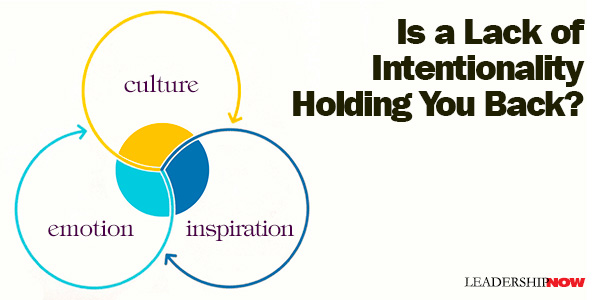
WHAT ARE the defining characteristics of successful leadership? Mark Sanborn identifies them as clarity and intentionality in The Intention Imperative. Clarity, he says, “tells you where you’re headed” and intentionality is “the consistent action you’ll take to get there.” To explain, Sanborn takes us back to when Domino’s found clarity and discovered how they were going to get there. With clarity of purpose that took them back to their roots, and intentionality, they became an e-commerce company that happens to sell pizza. As a result, Dominos stock has risen 5000 percent since 2008, outperforming all of the world’s largest tech companies. Leading with clarity and intentionality makes the difference. He offers the following chart to illuminate the effect of clarity and intentionality on our leadership effectiveness.
The quadrant of No Leadership is negligent leadership—no direction and no way to get there. Vague Leadership has a bias for action but lacks a clear idea of where they’re going. Wishful Leadership knows where they want to go but haven’t figured out the how or aren’t taking consistent action to get there. Intentional leadership is effective leadership. “Intentional leadership is knowing where you want to go and taking consistent action in the world as it is, not the world as it was, to get there.” There is a lot contained in that last statement and is the subject of this book. Intentional Leadership consists of three imperatives: Inspiration, Culture, and Emotion. The Culture Imperative Culture gets a lot of attention and is considered critical to success, but few organizations actually do much about it. At best, it becomes an HR function. Sanborn defines culture as “what we think and believe, which then determines what we do and what we accomplish.” He lists six reasons why it matters so much, but this reason caught my attention. I had never looked at it from this perspective. He says, “Culture is a corporate immune system that protects against variance, decline, or abandonment by identifying and combating threatening forces like toxic partners, disjointed processes, and bad decisions.” Culture often takes a back seat—though we know better—because we focus on the wrong things or think it is all about making employees happy. “Making people happy isn’t the job of an intentional leader. The job of an intentional leader is giving employees the tools—the philosophy, the training, the communication, and the incentives—to be successful.” Sanborn offers five levers to create, change, and/or maintain culture—intentionally. The Inspiration Imperative Inspiration comes from purpose and the mission. It’s more than motivation or engagement which are “task-focused and lack the sustaining power of inspiration.” Inspiring leadership begins with you. You find it in yourself first so that you can bring it out in others. Inspiration can be found in solitude, those you associate with, curiosity, a healthy sense of humor, gratefulness, service and exercise. “To find your purpose is to find your inspiration.” From this foundation you can guide others to their inspiration. Sanborn offers ten tools for inspiration. Connection with your team, your example, empathy, linking purpose to work, providing challenges and education, appreciation, and a good story are among the ten. The Emotion Imperative We have entered the emotion economy. The customer wants to feel successful after the fact, not just happy. “Are you happier you did business with us than with someone else?” You want customers happy they chose you—to feel successful. “The old notion that a company merely needs to provide a good or service withers away when we start to understand that it is not the product or service itself that matters—what matters is which emotion your company elicits from its customers.” The intentional leader knows that this goes beyond customer service. That’s part of it. “A customer’s emotions start well before they enter your sales funnel. The new economy has expanded the points at which your potential customers will first interact with your company. Across all levels of your organization, ask yourself how each impacts the customer’s happiness and feelings of success. This includes marketing, product design, sales, and, yes, customer service.” There are a lot of great insights in this book. Through a series of case studies that go beyond the usual suspects—a parking garage, High Point University, Acuity Insurance, Savannah Bananas baseball, Texas Roadhouse, and Envisioning Green landscaping—and interviews, he walks us through the thinking behind intentional leadership and its three imperatives to see how they connect. Here is a sampling of the comments from organizations featured in the book: Nido Qubein, president of High Point University: “I just get in front of our team. I walk around and pat people on the back, shake hands, share a laugh. It’s not complicated. I make time for moments of joy each day, and the time I spend in the café talking to students and staff members makes me feel good. Students talk selfies with me. If a student is on their phone talking to Mom and Dad, I grab it and talk to their parents. I’m present.” Ben Salzmann, CEO Acuity Insurance: “You can’t innovate in a vacuum. If you take the best genius and give them a year, feed ‘em the best food and lock ‘em in a room—a year later they don’t look so smart. Take the same person and let them talk and look around and interact, and they will come up with great innovations. Stimulus is critical.” Kent Taylor, founder and CEO of Texas Roadhouse: “If we think about a new idea, I run it through twenty people—managing partners, market partners, kitchen managers, service managers, meat cutters. I don’t create ideas in a distant office. When it comes to employees, I am always asking, Are they happy? Do they enjoy their job? That’s important because I believe that happy employees create happy guests, which creates happy accountants!” Erika Johns, co-owner of Envisioning Green: “Our culture is fun and positive. We aren’t afraid to laugh and joke around, but we know how to work hard. You spend more time with your co-workers than your family a lot of the time, so it’s important to have some fun at work.” All of the examples point to the fact that inspiration, culture, and emotion, are created and maintained with intentional leadership. Sanborn completes the book with thirty things that you can do now to lead intentionally based in reality—the world as it is. 
Posted by Michael McKinney at 06:59 AM
08.22.19

Building Company Culture: Alignment Leadership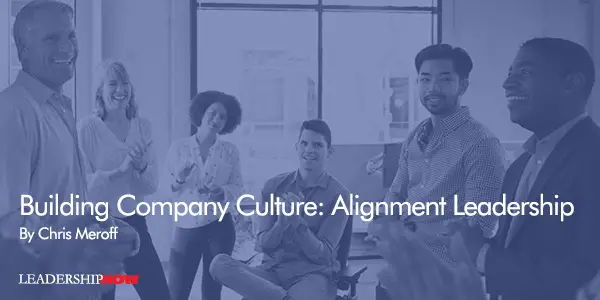
YOU PROBABLY HEAR the word culture a lot, but what does it mean? We’ll discuss it here but I can definitively tell you this: Without a strong company culture, you can’t create a fulfilling environment for your employees. In fact, the whole idea of culture is a moving target. Yes, it’s widely discussed, but somewhere between the discussion and the implementation something happens. Oftentimes that something is the watering down of the whole idea in the first place and casting it off as a soft science that doesn’t really impact the bottom line. Nothing could be further from the truth. What Is Culture? So, let’s begin at the beginning. What is culture? My definition of culture is the sum of a group of people’s beliefs, traditions, preferences, experiences, and hopes. Any time you put people together, a culture is created. Whether or not you agree with the traits of each person’s worldview—their beliefs, traditions, preferences, experiences, or hopes—that worldview exists. Every person has their own unique worldview, and the way they see the world combines with others to create the culture of that group. The individual traits of a person affect how they view the world and interact with others. For example, the word “trust” means one thing to one person and something different to another person, based on their experiences. The various meanings of trust within a group define their culture around that word. Imagine if a group of ten people working together had vastly different impressions of trust. What kind of culture would that create? Somebody has to clearly define it so that everyone knows what the end game is and how to achieve it. And take note that this is just one word and one idea that can be misconstrued. How many others are there that we assume there is agreement on? Don’t assume. Define. Create a common language and an agreed upon taxonomy that there is no doubt about. Get this right and your organization wins. Misconceptions about Culture Culture cannot be developed by simply creating environments where people congregate together. You’ve been at those events, right? Sometimes it’s a movie night or a day out on a boat or a team building exercise. These are usually great fun and they give us a chance to get to know each other away from the office. But, truthfully, this is just one step in creating a defined company culture. In my journey of leadership, this is a concept I fell prey to early on. In an effort to improve employee engagement, I created happy hours, pizza Fridays, and a party planning committee. What I didn’t realize was that without the initial investment in people before creating these events that fostered community, the experience would be a shallow attempt at culture. Alignment Leadership requires an intimate pursuit of employees, and this pursuit will never happen at a happy hour or a five-minute interaction while sharing a slice of pepperoni. As I began to develop this theory of Alignment Leadership, I realized the real win was much deeper—employee fulfillment. A happy hour can actually be an icebreaker to introduce someone into a community and build a deeper relationship. We go into these opportunities with the intention to further discover our employees, which leads to alignment. You want to develop a culture where you’re able to authentically allow your employees to be known, heard, and valued. Where to Start Creating a culture starts with conversations between you and your people to clearly define the culture you have—and the one you want to build together. You need to have conversations that clarify the culture of your team, the culture of your department, and the culture of the company. This needs to be perfectly understood both from the leader’s perspective and the employees’ perspective. Creating a culture won’t happen overnight. People’s worldviews are deeply rooted in who they are, and combining them into a culture that works for everyone will require people to make changes. It may take several years, but if you put in the effort to lead your team and work together, you can develop an authentic, meaningful company culture. 
Posted by Michael McKinney at 09:44 PM
07.29.19

Feedback (and Other Dirty Words)
FEEDBACK HAS A LOT OF BAGGAGE associated with it. Feedback is not always well-intentioned and is used to punish, demean, or manipulate. When well-intentioned we don’t always do it right. We dump on people, we’re biased, we miss the overall issues, and present it in a way that doesn’t sound helpful. And we, of course, wanting to be right and accepted don’t see it as the gift that it is. As a result, you will find people avoiding it altogether—whether on the giving or receiving end of it. Or you will find people trying to take it to a higher lever and state that what we need and really want is attention. Positive attention is the way to go. Build on strengths. But sometimes we need to tame our strengths for our own good, and sometimes we need to manage our weaknesses. And frequently we have no idea unless we are told. We need feedback. In contrast to the desire of some to dumb down or avoid feedback, authors Tamra Chandler and Laura Grealish have decided to deal with feedback head-on in Feedback (and other dirty words): Why We Fear It, How to Fix It. Done right, feedback is not only a good thing, it is essential to growth and performance. They say we need to do more than tweak our feedback practices, we need to completely rethink the what, how, and why. They begin by defining feedback as “Clear and specific information that’s sought or extended for the sole intention of helping individuals or groups improve, grow, or advance.” This forms the basis for their Feedback-Fixing Movement. “Every great feedback experience,” they write, “is anchored in fairness, focus, and frequency.” Fairness is about trust. “When trust and fairness are absent, because either the feedback itself or the Extender [of feedback] seems unfair or biased, the Receiver retreats into protection mode.” We generally associate feedback with criticism because that’s sadly the only time most people speak up. Focus is about making the feedback specific, targeted, and brief.” When we dump on people, they shut down and the feedback moment is gone. “Dishing out bite-sized portions of off-the-cuff gratitude, recognition, direction, or coaching can move the performance needle much more effectively than hours of training sessions, development seminars, or dismal laundry lists of your rights and wrongs from the past year.” Frequency is the accelerator. “Connecting frequently speaks volumes. It says, ‘I’m paying attention, what you do is important and notable, and you are a priority.’” Informal and spontaneous is the secret to frequency. To revolutionize feedback, the best thing you can do right now—especially as a leader—is to become a Seeker of feedback. That is, become a person who proactively requests feedback from others with the intention of self-development or growth. It helps you in a couple of ways. First, you are the example you need to be, and second, to be a seeker lowers the fear associated with feedback because you choose the time and place, the issue and the extender of feedback. The authors offer the Seeker several tips to effective feedback seeking. First, ask in advance, giving the Extender(s) time to think. (Asking more than one person provides you with a better picture of what is actually happening.) Give them permission to be candid with you. They are most likely as uncomfortable with it as you are. Third, ask them to start noticing based on the nature of the feedback you are requesting. And finally, make the choice to do something with what you have learned. I found the chart below helpful in wrapping your mind around the proper way to deliver feedback. The considerations are many but going through the chart will help you not only form the conversation but get a handle on your intention for giving feedback in the first place.
Feedback (and other dirty words) is full of helpful insights and constructive interpretations of the scientific studies and data regarding the issue of feedback. It is a comprehensive look at feedback and well worth reviewing in terms of both delivering and receiving feedback. 
Posted by Michael McKinney at 02:16 PM
07.12.19

Employee Engagement 101: Ask the Holy Question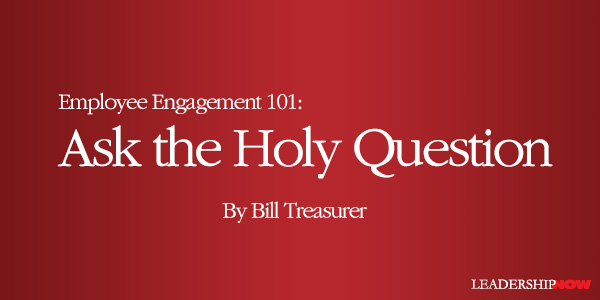
HAVE YOU EVER heard a front-line worker say, “I can’t wait to make more money for our shareholders today!” No? In all my years as a consultant, I haven’t either. It doesn’t matter what your company peddles. Increasing shareholder value, company market share, or worker productivity just doesn’t jazz the average worker. There is often a vast disconnect between what is important to a company’s executive body and what is important to front-line workers. What matters to the average worker includes career opportunity, meaningful work, a balanced life, a fair wage, and being treated with respect—not increasing output. As a leader or manager, you have to attend to the goals of your board or bosses and to the career aspirations of your workers. Too many people in charge focus solely on the former, leaving workers’ aspirations in the dust. A Solution in Four Words Cueing into your workers takes far less time and energy than you’d think. In fact, it only takes four words. They are among the most important words in the English language, and, together, they constitute what I call the Holy Question: “What do you want?” Answering those words, in my opinion, should be required of every job candidate, every worker, and every executive on up the line. The answer to those words should be reviewed during every performance appraisal, succession-planning session, and employee-ranking process. Why? Because when you know what people want, you are in a far better position to match their ambitions and goals to the company’s goals. When company and worker goals are aligned, people pursue organizational goals with the same dedication and passion as they do when driven by self-interest. Aligning Goals Increases Workers’ Courage It’s easier to get people to perform courageous (and uncomfortable) tasks when those tasks tie into their personal aspirations. By knowing what people want to get out of work, you can give them stretch assignments that connect project tasks to their own goals. So, if your boss’s goal is to “repurpose our existing product assets to create new revenue streams and optimize our market dominance on a go-forward basis,” you can tie your boss’s goal to your employee’s own career aspirations by saying, “Hey, John, you said that you want more opportunities to use your creativity. Create ten new business uses for this product by next week.” Or perhaps you know that your employee Michelle would like to move from a data analyst to an advisory role. Your board has come to you needing an informed opinion on the latest sales metrics—and fast. It’s the perfect opportunity to bring Michelle into the fold, allowing her to provide a fresh perspective while simultaneously gaining experience for her dream role. The point is this: Before getting workers to carry out tasks in pursuit of the company’s objectives, you have to understand what is important to them individually. How would you answer the question of “What do you want?” How would your boss answer it? Your customer? Each of your direct reports? Getting each person to answer the Holy Question, with specificity, will help you to know when and how they’ll be willing to be courageous. 
Posted by Michael McKinney at 02:09 PM
04.03.19

Will Artificial Intelligence Take Your Job?
A PEW RESEARCH CENTER study found that Americans are roughly twice as likely to express worry (72%) than enthusiasm about a future in which robots and computers are capable of doing many jobs that are currently done by humans. Of course, people have always worried that technology would take over their job. Gutenberg’s press probably created more social upheaval than any technological advancement has yet to do today. The sixteen-century Vicar of Croydon warned, “We must root out printing or printing will root us out.” A dire situation indeed. The term artificial intelligence first appeared in an article by Stanford professor John McCarthy in 1979. Ever since, artificial intelligence or cognitive technologies as it is often referred to, have been slowly developing in capability and application. Thomas Davenport states in The AI Advantage that, “AI is a largely analytical technology, and that for most organizations working with AI is a straightforward extension of what they do with data and analytics.” He notes: Artificial Intelligence isn’t going to transform the work of organizations—or the lives of individuals—as fast as many people seem to expect. It will be one of the many technologies that comply with Amara’s Law (named after the scientist and futurist Roy Amara): While the estimates vary between 5 and 47 percent of jobs to be lost to automation, Davenport believes it will be much closer to 5 percent. What he sees happening is something quite different. Rather than large-scale automation, he believes we will see large-scale augmentation or “smart humans working in collaboration with smart machines.” Why? A few of the reasons he gives are: First, AI tends to support or automate tasks, not entire jobs. Second, most managers neither want nor expect large-scale automation. We have seen chatbots and cognitive-engagement apps in customer service and sales, but they are not taking away jobs. Rather they are allowing these functions to handle more without adding staff. “Some organizations are planning to transition customer-support personnel to more complex activities that bots can’t yet do including handling customer issues that escalate, conducting extended unstructured dialogues, or reaching out to the customer before they can call in with problems.” Third, massive automation will not take place based on our experience from previous generations of technology. For example, there are about the same number of bank tellers despite the introduction of ATMs and internet home banking technologies. Fourth, what we see are new roles and skills emerging as people find new jobs and tasks to perform when previous tasks are taken over by automation. Finally, a lot of entirely new jobs will be created. “New jobs created by AI will fall into three categories: trainers, explainers, and sustainers.” What Can We Do? Broadly speaking there some skills that will be valuable in the workforce to collaborate and maximize your value. Being Conversant with How Machines Think “Knowing the logic and flow of a computer system is important for anyone who works alongside or oversees smart machines. Acquaintance with how systems think can be helpful in troubleshooting, understanding limitations, and explaining the operation of cognitive technologies.” Having an Understanding of Analytics and Data Structures “Understanding statistics, data structures, and how to make decisions from them will be of help to anyone seeking to work with AI.” Becoming Familiar with Different Types of AI Especially for those who seek managerial roles, this knowledge is essential. “It is impossible for someone to sponsor and implement a project involving image recognition, for example, if they don’t know that deep learning is the most likely method to doing a good job of it.” Having Domain Knowledge of the Business and Industry “Anyone who wants to work alongside smart machines in a business will need to understand not only the machines themselves, but also the aspects of the business to which they are applied.” Possessing A Strong Ability to Communicate This skill cannot be stressed enough. “As machines take on more decisions and actions, one of the key tasks left for human workers is effectively communicating the outcomes of machine activities to other humans.” Having High Levels of Emotional Intelligence Computer systems don’t possess much in the way of emotional intelligence. “That means humans have a competitive advantage in the workplace if they are perceptive, sensitive, and insightful about human emotions.” To maintain your advantage, you need to always be learning too. Curiosity wards off defensiveness and keeps you ahead of the curve. So always be learning. Davenport has written an interesting book and covers other aspects of the cognitive technologies such as cognitive strategy, and managing the organizational, social, and ethical implications of AI. AI is really nothing more than the manipulation of data. Understanding the questions to ask, how to put it together, and interpreting what it means, will be critical functions in the future. Instead of pushing data, the need will be for those who can pull intelligence from it. 
Posted by Michael McKinney at 07:49 AM
03.22.19

Win the Heart: The Four Cornerstones You Need to Build Engagement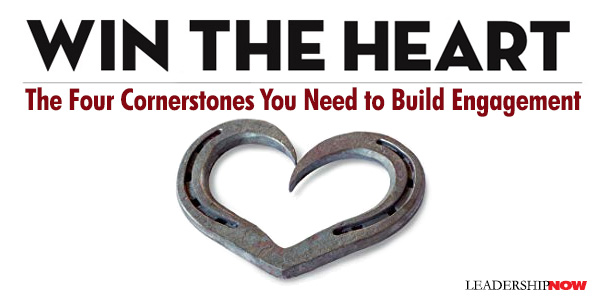
ENGAGEMENT HAS BECOME the Holy Grail of business—highly desired but hard to get. There are a number of moving parts, and it’s hard to get them all aligned. Mark Miller says that “for many organizations, engagement is the final battle to becoming a high-performance organization.” In Win the Heart, Mark Miller lays out the four cornerstones that engagement is built on. In this business fable, CEO Blake Brown senses his company has an engagement problem. He turns to an old mentor, Debbie Brewster for help. This leads him, and his wife on an international hunt for lessons concerning engagement Blake’s Dad had put together from people and places in history. Blake and his team define engagement as “a condition of the heart reflecting an individual’s level of genuine care for their work, coworkers, and the organization. And if the level of care is high enough, it will result in energy, effort, enthusiasm, and initiative” or more simply: Traveling to Selma, Alabama, Florence, Italy, Pella, Greece, Green Bay, Wisconsin, and finally, West Texas to complete the picture, they discover the four cornerstones of engagement. Connection Conversation is the primary driver. “You might even say we—me and my fellow employees—do life together. We talk about triumphs and tragedies, fears, failures, and struggles. We talk about how to help each other.” “Real conversations are the bridge to real connections.” And this includes conversations with all stakeholders. Affirmation “Their secret sauce was thank you. Loosely translated they are creating a culture of affirmation when they express genuine appreciation to their employees. They affirm people multiple times a day.” Responsibility “Leaders must be willing to actually give people responsibility! Create a culture in which sharing responsibility is the norm, not the exception. Give people real responsibility for goals, methods, and decisions, whenever it makes sense.” Environment “The how is simply to look at what people really need to win both physically and emotionally, and provide it. The coaches just equipped the team for success.” From an old friend of Blake’s Dad in West Texas, they learn that “If you just hire a man’s hands, you miss the opportunity to win his heart.” 
Posted by Michael McKinney at 10:22 AM
02.11.19

Creating the Conversations That Help Them Grow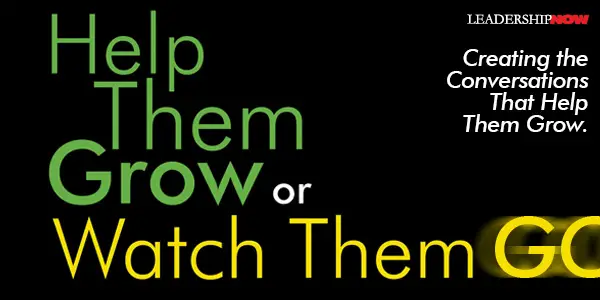
FINDING good employees is not enough. Developing them is critical to keeping them. Everyone has options. If you are not growing and leading your employees, they will look elsewhere. “Success today,” say Beverly Kaye and Julie Winkle Giulioni in Help Them Grow or Watch Them Go, “rests upon finding ways to continuously expand everyone’s capacity, engagement, and ability to contribute to the organization.” While many leaders may feel they don’t have time for career development, it’s not as complicated as we often make it out to be. “Career development is nothing more than helping others grow”—one conversation at a time. “Quality career development boils down to quality conversations”—frequent, short conversations that occur within the natural flow of work. It is based on good questions, not in having all of the answers. Go ahead and courageously ask the challenging questions and even end the conversation with a real tough or thought-provoking one that the employee can contemplate for a while. Closure is overrated. Unfinished business … that’s what will cause employees to continue to ponder and will ultimately spark action and feed progress. They suggest that we “reframe career development in such a way that responsibility rests squarely with the employee and that our role is more about prompting, guiding, reflecting, exploring ideas, activating enthusiasm, and driving action.” Their framework for career development is organized around three types of conversations: Hindsight Conversations “Hindsight conversations are the foundation of career development.” These conversations are meant to help develop self-awareness—where they have been, what they’ve done, and who they are. This has two parts: self-perception and other-perception—how others perceive them. Encourage employees to get feedback from those they work with. “Helping people look back and inward also provides a reservoir of information that allows employees to move forward and toward their career goals in intentional ways that will produce satisfying results.” Foresight Conversations What an employee learns about themselves in hindsight needs to be applied in the context of what is going on around them and the implications of all of the changes they see happening. “When you help your employees develop the ability to scan the environment, anticipate trends, and spot opportunities, you provide a constructive context for career development.” Harness the power of your crowd. Get them asking questions like, what are you seeing and what might these things mean to our industry, our organization, and your career? “Encouraging employees to interact directly with the environment is just an exercise until you debrief their experiences and encourage reflection.” It’ll turn employees into business partners. Insight Conversations These conversations leverage what your employee learns from the convergence of the insight and foresight conversations. Here you guide them into practical steps they can take to be where they want to be. “Onward and upward has been replaced by forward and toward.” Today, it’s not about moving up the ladder but moving to the place you want to be. Kaye and Giulioni suggest that we learn to help them grow in place. This requires a shift in thinking. “The challenge of growing in place involves stripping titles from our thinking and instead focusing on what the employee needs to experience, know, learn, and be able to do.” Reframe the conversation to be about experiences, not position. It creates unseen possibilities and allows them to grow where they are. Develop a Career Development Culture Ultimately what you want to create is a career development culture that supports and values the employee. Cultures that actively support career development and enjoy its constructive byproducts share some fundamental characteristics or cultural markers. They tend to be:
We have conversations about the work anyway, so why not make it a teachable moment. “A few minutes of conversation can help others slow down enough to reflect, bring deep insights to the surface, verbalize important messages, and consider how to leverage their expanding skills and knowledge base.” If you don’t think you have the time to incorporate this vital task in what you do, this book is for you. Kaye and Giulioni offer templates, guidelines, and sample conversations and questions that you can adapt to your own situation. With their approach, career development stays fresh because each employee’s career plan is unique and done in real-time.

Posted by Michael McKinney at 12:04 AM
11.21.18

How to Bring Gratitude into the Workplace
‘Tis the season of gratitude -- for friends, for family, and for delicious turkey dinners. But what about gratitude in the workplace? November and December are notorious times for organizations to express gratitude to their employees -- holiday parties, annual bonuses, and accolades they save up for this time of year. And while these gestures are appreciated, the truth is gratitude should be practiced all year round. By focusing on giving thanks just one time a year, these overtures become less authentic, and thus less meaningful. For leaders, practicing gratitude at work is an incredibly valuable tool, and one that shouldn’t be saved for a single season. Here are a few suggestions you can implement today and use all year long, from the most personal, to the most public:
We all benefit when we take a minute to step back and recognize the good people and things we have in our lives. Study after study shows that gratitude is a key factor in happiness. While we don’t often combine a gratitude practice with work, as you can see there are some easy ways to do just that. Giving thanks feeds the soul, which is as necessary in November as it is in February or June. 
Posted by Michael McKinney at 09:11 AM
10.29.18

Michael Lombardi’s Lessons in Leadership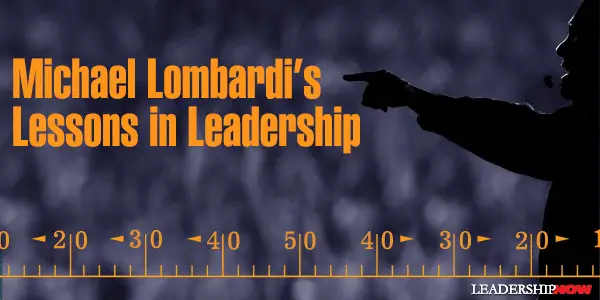
M In Gridiron Genius, you will certainly get the inside scoop on the game of football, but it’s much more than that. As a three-time Super Bowl champion, Michael Lombardi provides lessons in organizational culture, team building, strategy, and character. His philosophies on how to build championship teams were foundational for the teams built by both Walsh and Belichick. Organizations of all types will benefit from the insights found here. “Football is ultimately a business, and as in any successful business the most important ingredients are a sound culture, a realistic plan, strong leadership, and a talented workforce.” So let’s look at some of the leadership lessons to be found here. The main lesson that comes through his experience with great coaches and owners is that culture comes first. “If you haven’t created an underlying ecosystem of excellence, short-term success is all it will ever be.” On Bill Walsh building the San Francisco 49ers in 1979: “From the talent on and off the field, to the quality of the workplace, to the practice fields. No detail was too small for Walsh to consider because, to his assembly line way of thinking, only the sum of them all could produce the organization he wanted. As he was fond of saying, if he managed to perfect the culture, the wins would take care of themselves.” He writes: “Character assessment is by far the hardest challenge for team builders. More than any other factor, inaccurate character assessment is why draft boards are to this day littered with so many mistakes. For starters, let’s be honest, there’s a sliding scale of morality in the NFL (as in every industry), in which the more talented a player is, the more he can get away with.” “Each player retains information differently, and it’s the coach’s job to determine the best way to instruct him.” What Makes a Great Quarterback? A winning way. (Winning is a habit.) A thick skin. (The measure of who we are is how we react to something that does not go our way.) Work ethic. (Your best player has to set a tone for intolerance for anything that gets in the way of winning.) Football smarts. (A quick mind come with preparation. You prepare so well that you don’t have to think; you just react.) Innate ability. (Born with it quality: Walsh couldn’t define it, but he knew it when he saw it.) Carriage. (Quarterbacks have to inspire. They can always look as if they have it all under control and that somehow they will figure out how to lead the team to victory. No one wants to follow a sulker.) Leadership. (Quarterbacks who fail to gain the respect of teammates leave a team rudderless.) Building a team: “A big part of Walsh’s genius was his uncanny ability to spot a quarterback in a crowd. Even from a distance and after only a few throws, he could sense immediately if a quarterback could run his offense. Guys like Walsh and Belichick are unusual this way: They can visualize how skill sets fit in their schemes in a way that both maximizes those abilities and fuels the system.” From Bill Belichick: “Although practice doesn’t make perfect, it gets you closer to perfection each time you do it.” “We aren’t collecting talent; we are building a team.” Mental Toughness: Doing what is best for the team when it might not be the best for you. If players can fight past exhaustion, if they can focus when they’re completely drained, well, that’s mental toughness. On Bill Walsh: “His meticulousness was evident everywhere.” “Walsh opted for less experienced men who shared his curiosity and displayed a willingness to learn his system and methods.” What Makes a Great Coach? Command of the Room. Followers need something to commit to. A leader has to have a plan. On Nick Saban at Cleveland: He had a strong plan and an effective way of communicating that plan, and his ability to be self-critical earned the players’ trust in a way that rivaled their feelings for Belichick. Command of the Message. What good is the plan if you can’t talk about the plan? Players can’t accomplish anything unless they can visualize the path. Delivery isn’t as important as meaning. Command of Self. Personal accountability is the ultimate sign of strength. Sophocles sums it up best: “All men make mistakes, but a good man yields when he knows his course is wrong and repairs the evil. The only crime is pride.” Ego is the leading cause of unemployment in the coaching world. Command of Opportunity. Becoming an NFL head coach is a process. You learn on the fly. In the beginning, it is likely you’ll be bad at it. You just have to keep working at it until you get good and pray that you don’t end up a one-hit wonder. Command of the Process. A leader must be fair and consistent. When rule don’t apply to everyone, the ensuing chaos collapses whatever foundation a leader has tried so hard to build. In a particularly good section of the book, Combating Complacency he talks about how Belichick and Walsh fight complacency. This was interesting: “Whether the Patriots have just won the Super Bowl or not, the first thing Belichick does is wipe the slate clean. One of his favorite sayings is, ‘To live in the past is to die in the present.’ It’s why you see no Super Bowl trophies as you walk through the players’ entrance and why all the photos from the previous season are removed as soon as the season is over. That clean slate demands a trip back to basic principles and fundamentals after a detailed examination of the current process.” He adds, “What impressed me the most about Belichick and Walsh in their self-awareness. With the same kind of success in the NFL many lesser men have become close-minded, authoritarian, and lazy.” Of Related Interest:

Posted by Michael McKinney at 12:16 AM
09.20.18

Three Strategies to Encourage Good Mental Health in the Workplace
L Unfortunately, for many people, fluctuating feelings can run on overdrive in response to a society overflowing with negativity – think natural disasters, mass shootings, suicides, and even a heated political environment all occurring with disturbing regularity. There are also stressful personal events in our lives that add to the swinging emotional pendulum, like the death of a loved one, the end of a relationship or the loss of a job. According to a recent study, employees suffering from depression cost employers more than $44 billion per year in lost productivity, with over 81 percent of that decreased productivity coming in the form of presenteeism or the practice of going to work despite illness or anxiety and commonly resulting in reduced productivity. While it’s not uncommon to feel like you are carrying the weight of the world on your shoulders, I believe by recognizing and taking ownership of our sometimes-wavering emotions – especially in the workplace – we can change our course for the better. By working to shift the residual emotional effects of stressful situations and embracing more positivity, we can strive to achieve enhanced well-being and professional success. For this strategy to be effective, leaders must start by taking a top-down approach to dealing with mental health in the workplace. By creating and implementing effective mental health programs within their organization, companies can experience greater staff member well-being, boost productivity and contribute to transforming our country’s corporate culture regarding mental health. Mental Health Defined Before getting to my tips on how management can get started with this mission, it’s important to review the various definitions of mental health. At its core, mental health is “the emotional resilience which allows us to enjoy life, create friendships and be productive at our jobs.” This emotional flexibility helps us cope with life’s disappointments and setbacks, such as death, familial conflict or other stressful situations. Protecting our mental health is as essential as protecting our physical well-being. Stress, anxiety and depression are the most common forms of clinically diagnosed mental health disorders. Fortunately, many of these disorders can be treated with social supports (however, in some cases, some individuals require medical intervention). On a personal level, it’s no secret that mental ill-health can lead to general unhappiness. As a result, it can impact our lives in the professional world, costing businesses millions of dollars due to absenteeism, high staff turnover, and presenteeism. As such, today’s business leaders and employers must make it a priority to serve as instruments of change in our current negatively charged, turbulent environment. So, how can you get started to ensuring that your employees have good mental health in the workplace? The Domino Effect of Positivity As an international speaker, mental health expert, and author, I have been fortunate to travel around the globe throughout my career meeting with hundreds of business owners and entrepreneurs about mental wellness. The consensus among these individuals is that when you focus on taking care of your own emotional health, the resulting positivity has a contagious effect, especially when it comes to relationships between leaders and employees. Executives at the top of the chain of command must start by looking for any signs of higher than average employee stress, including regular complaining, and anger or reduced (or a boost in) productivity. While altering attitudes to mental health in the workplace should be a priority, it can be daunting for some leaders to fully understand how they can support a staff member’s well-being. Here are three strategies to improve how you approach mental health within your organization:
The Bottom Line When leaders make conscious efforts to embrace positivity – even in turbulent times – we can help our employees experience increased positivity and more success. The statistics about making such efforts are telling: one recent study by ValueOptions revealed that employees who utilized mental health tools (and met with a mental health provider) reported a decrease in absenteeism, and considerable improvement in both productivity and overall mental health. As we become increasingly savvier to our society’s mental health needs, it’s in every manager’s best interest to implement a focus on positivity in the workplace. The long-term investment in mental health awareness, education and training will inevitably create returns that outweigh the loss of productivity in the professional world.  Kellerer is the co-author of The Soul of Success with Jack Canfield and the author of the recently-released title, One Moment Can Change Your Life: Extraordinary Stories about Ordinary People. Today, he dedicates his time to fighting the depression epidemic and promoting mental wellness in the workplace. You can connect with him on LinkedIn, Twitter and Facebook.
Posted by Michael McKinney at 08:59 AM
08.24.18

Engagement Isn’t Built, It’s Uncovered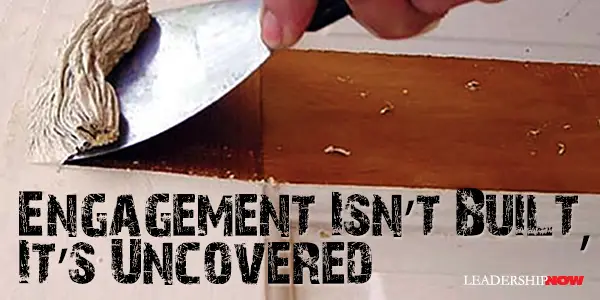
W But over the years, depending on our upbringing, our schooling, and our work, our desire to engage gets suppressed. It gets covered up. Our job as leaders is to uncover and rekindle that child-like desire to engage with others and our environment. We can’t create engagement, but we can uncover it. I was reading a remarkable little book written for teachers by retired professor Calvin Luther Martin entitled, Successful College Teaching Begins with Throwing Away Your Lecture Notes. We can learn a lot here because teaching, like leading, is about serving others while achieving a result. Indeed, teaching is a function of leading. We teach much more than our subject matter; we teach trust or distrust, courtesy or discourtesy, warmth or coldness—the lessons between the lines. The people we lead are not coming to us from our perspective. They have their own that has been years on the making. Bear in mind that you are teaching young men and women with an educational past that has shaped them. We bring our whole selves to work. Our hope, our scars, our dreams, our fears, our expectations, and our assumptions. Our childhood sense of wonder has been abused. It’s there, but it is cautious. We are conditioned to want to be right more than we want to be accurate. Behold the class before you. They are not blank slates, nor are they ignorant. There is plenty written on those slates and your task is to rewrite much of that text—if they will trust you and if your good enough to get that close to them. They sit before you, thoroughly trained (brainwashed might be a better word) in ways of pedagogy that will determine how they hear you, what they hear and cannot hear, and how they will absorb what you say. We are not leading another version of us. We are leading a human being similar in form but different in substance. These people come to you with layers of expectations that have been created starting in the first grade. Like an old kitchen countertop, they have been painted over and over. The oak, cherry, or maple cabinet beneath is smothered by an amour of paint. It’s a bland countertop now. The fine wood underneath is unknown; it’s merely a rigid structure useful for covering with paint and, after that, supporting pots and pans. A leader has to peel off the old paint and get to that desire to engage that has been unwittingly covered over. We have to uncover the desire to engage. The desire to learn. The desire to connect. The tendency is to be instructing. We do need to instruct but it needs to be part of a larger, coherent story that people can feel a part of. We are wired to engage. It’s already within us. Our task as leaders is to uncover what is already there. Martin explains that to teach or to lead “is to give a concert, to perform a beautiful, passionate concerto which everyone in the audience yearns to play, improvise on, and even improve.” We don’t build engagement, we uncover it. Uncover engagement in your organization. 
Posted by Michael McKinney at 07:01 AM
06.04.18

Talent Wins: The New Playbook for Putting People First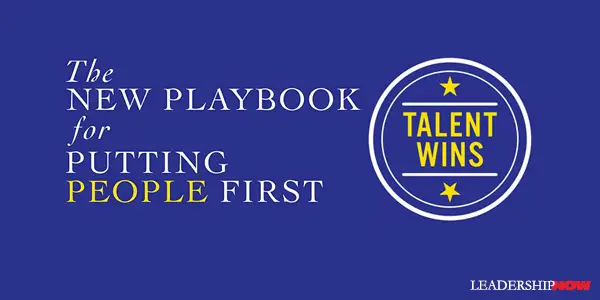
I Ram Charan, Dominic Barton, and Dennis Carey write in Talent Wins: Most executives today recognize the competitive advantage of talent, yet the talent practices their organizations use are vestiges of another era. They were designed for predictable environments, traditional ways of getting work done, and organizations where lines and boxes defined how people were managed. As work and organizations become more fluid — and business comes to mean sensing and seizing new opportunities in a constantly changing environment, rather than panning for several years into a predictable future — companies must deploy talent in new ways. In fact, talent must lead strategy. To make this happen, they recommend forging what they call the G3. This is a group that consists of the CEO, the CFO, and the CHRO (Chief Human Resources Officer). Together, they “lead the way on anything where the deployment of talent influences the company’s results.” It is the “multiplier of your capacity, time, and capability.” Bringing the CHRO into the mix, signals that “talent consideration must be a critical part of every important decision.” Of course, for most organizations, this means greatly expanding the role of human resources. Finding, recruiting, supporting and developing talent is mission-critical work in the organization. Beyond just administrative work, it must become a creator of value and competitive advantage. The relationship between the CFO and CHRO is vital. Together they can do more than they could alone by “ensuring that the company’s financials and the company’s people are continually, inextricably linked.” The success of the G3 is up to the CEO, but the CFO and the CHRO “must be star performers who can learn from each other’s language and dive into each other’s business.” Training has to be built into the daily fabric or tour organization. People appreciate in value. “Investments in training are strategic bets on your most valuable assets.” This is not a haphazard process but one that uses predictive analytic software to find the right roles for talent, spotlight weaknesses, and forecast the skills that will be needed in the future. Another part of this is rigorously reexamining the organizations legacy processes and instilling a mentality across the organization that everyone should be developing their skills. “These moves quicken the pulse of a company, and help the company have the nimble urgency needed to compete successfully.” Driving a talent-first reorganization is the job of the CEO. The CEO is the organization’s top recruiter and it requires their constant attention. “Where to find people with the imagination and skills to propel the company; how to position your critical 2 percent and multiply its impact; what kind of talent the company lacks and how you will get it—becomes Job One.” CEOs need to have on their agenda:
  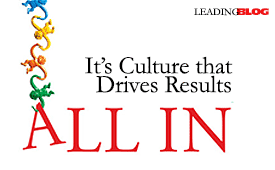
Posted by Michael McKinney at 11:12 PM
04.11.18

Don’t Leave Workplace Civility to Chance
W Our own observations make us keenly aware of these dynamics. Now there is research to - unfortunately - support our observations. A 2017 survey of Civility in America (an annual study undertaken by Weber Shandwick, Powell Tate, and KRC Research - found that 69% of respondents believe the United States has a major civility problem. 75% of respondents believe that incivility has risen to crisis levels. 73% feel that the US is losing stature as a civil nation. There were few optimists among those interviewed. Only 22% of respondents believe civility in America will improve in the years to come. Three additional studies underscore the lack of respect and civility in our workplaces. Gallup’s employee engagement data (Employee Engagement | Gallup Topic) reveals that only 35% of US workers are actively engaged at work. Globally, the number of actively engaged employees is 15%. TINYpulse’s 2017 culture and engagement report found only 26% of employees feel strongly valued at work. The Workplace Bullying Institute’s 2017 study (WBI 2017 U.S. Workplace Bullying Survey | Workplace Bullying Institute) found that 19% of American workers have experienced bullying in the workplace while another19% have witnessed workplace bullying. 61% of Americans are aware of workplace bullying in their organizations. This research and our own experiences make on thing clear: treating colleagues in the workplace with dignity and respect is not the norm. Disrespect and incivility erode trust, performance, service, and proactive problem solving in our organizations every day. All is not lost. I work with senior leaders of organizations of all sizes and industries to help them create purposeful, positive, productive work cultures. Three steps are required to evolve your work culture. They are:
Define your desired work culture. Senior leaders must make values as important as results - and to apply the same discipline to formalizing values expectations and measuring values expectations as they do to formalizing and measuring performance expectations. Values must be shifted from lofty ideals to observable, tangible, and measurable behaviors. By defining company values in behavior terms, those valued behaviors becomes measurable expectations. Let’s take “respect” as an example. One of my recent culture clients defined their respect value - one of six values they formalized - as “appreciating the worth of others and treating everyone with courtesy and kindness.” That’s a great definition, but it’s not in an observable form quite yet. They defined the exact behaviors required with these three valued behaviors:
These behaviors - along with the valued behaviors from their other five values - make it clear what the minimum standards of citizenship are in this organization. Their “values clarity” efforts are complete, but they’re not done with embedding these behaviors. Align all plans, decisions, and actions to your valued behaviors. Senior leaders must model and demonstrate these valued behaviors in every interaction. Simply defining these valued behaviors - and marketing them like crazy with, for example, posters throughout your workspace - does nothing more than increase awareness. The only way to build credibility and inspire everyone in the company to actually demonstrate these valued behaviors every day is for senior leaders - and all leaders in the organisation - to model them in every interaction. Every day. This isn’t easy - but it’s required. The scrutiny is severe. The standards of interaction quality between senior leaders and everyone they interact with vastly increase. Building credibility will take time - 4-5 months or more. During this timeframe, senior leaders must not only model those valued behaviors, they must now coach those valued behaviors, praise aligned behaviors, redirect misaligned behaviors, etc., for the rest of their lives (!). Aligning all plans, decisions, and actions to your valued behaviors becomes a never-ending project. This coaching, praising, redirecting, etc. is the foundation of holding others accountable for those valued behaviors. These same practices are an excellent foundation for holding others accountable for performance expectations, too. A vital part of the align phase is creating a custom values survey, taken by all employees every six months. This survey becomes your “values dashboard,” a way to regularly measure the degree to which leaders are seen by employees as modeling the team or company’s valued behaviors. With every run of your custom values survey, individual leaders - from senior leaders to front-line team leads - receive a profile that indicates their employees’ ratings of their demonstration of each valued behavior. Leaders are praised for aligned behaviors and coached on mis-aligned behaviors. Note that some of my clients are doing pulse values surveys with one question of every employee asked each week rather than three dozen questions asked every six months. This provides a valuable ongoing measurement of values alignment across your leaders. Only when leaders are held accountable for valued behaviors will those behaviors become a foundation of your healthy work culture. Refine valued behaviors every two years or so, as needed. The refine step is simply taking the time every two years or so to update your valued behaviors as needed. Some valued behaviors may be so ingrained you don’t need to keep them on your values list anymore. Some new valued behaviors might need to be added to address new temptations, new generations, new customer or market demands, etc. Your valued behaviors need to evolve as your culture evolves. These three steps work well in departments, small businesses, huge multi-nationals, and every size and type of organization in between. The impact is powerful. When my culture clients implement these three rules, three outcomes consistently emerge. Employee engagement goes up by 40%. Customer service rankings rise by 40%. And results and profits increase by 35% - all within 18 months of implementing this proven process. Don’t leave the quality of your work culture to chance. Make civility and respect a hallmark of every daily workplace interaction - by changing the rules, living the rules, and holding people accountable for the rules. Watch my three minute “Culture Leadership Charge” video on YouTube for further insights. 
Posted by Michael McKinney at 08:50 PM
03.05.18

6 Steps to Building a Community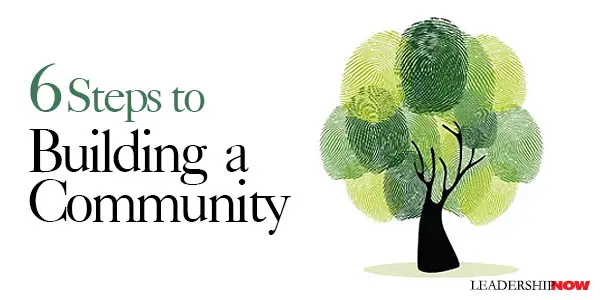
I Organizational health is facilitated by building community within your organization. It’s not easy, and it can’t be forced. Community is a long-term solution to engagement, commitment, and talent retention. In The Power of Community, Howard Partridge has broken down the process of building a community within your organization into three keys with six action steps. Support The first key to building community in your business is supporting your team members. “Many employees feel no one care about them. What if you started helping your team members reach their goals in life? This is a major key to the whole idea of community. In order to get support, we have to give support.” So this is where you begin: 1. Value True Community
2. Pursue Champion Connection
Encouragement
3. Inspire Emotional Trust
4. Practice Gift Exchange
Accountability The final key to building community in your business is accountability—the ability to accept responsibility for one’s own actions. “Accountability is key to becoming the person you were created to be. That’s because it is only by being accountable that you can discover and develop your gifts and help others discover and develop theirs.” This means that you first “have to take responsibility for your own actions, be respectful to your team members, be open to them, and allow yourself to be vulnerable. You also have to be willing to admit when you’re wrong, confess that you don’t have all the answers, and ask your team for feedback on how you’re doing as a leader.” Build accountability by: 5. Invite Openhearted Encounters
6. Build Growth PODS
You can begin the process by creating your first POD. A free POD template for each of the chapters of this book are available to download at HowardPartridge.com/PODS Go build your community. 
Posted by Michael McKinney at 07:45 AM
02.26.18

Talent Magnet: How to Get and Keep Top Talent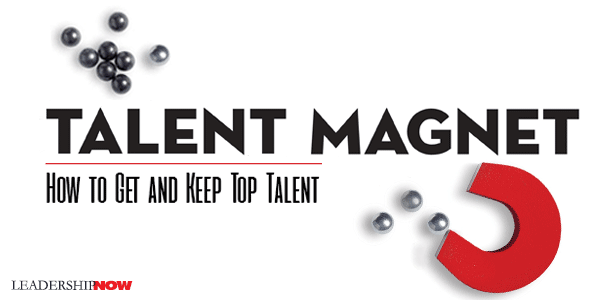
I Too many organizations find themselves in the positon of not being able to find enough qualified people to meet their growth goals. To answer the question, what attracts top talent, author and Vice President of High Performance Leadership at Chick-fil-A, Inc. Mark Miller commissioned a research study to interview over 7000 people from age fourteen to sixty-five and included both professional and hourly workers across all educational backgrounds. The result is Talent Magnet. Talent Magnet looks at the talent predicament from both sides—both those seeking work and those recruiting workers. It is the story of CEO Blake Brown who finds that they have a talent crisis and begins a journey to discover what it takes to find and keep top talent. It is also the story of his son Clint and his friends who are looking for a great place to work. What they discover is that what top talent wants and what organizations need to provide is a Better Boss, a Brighter Future, and a Bigger Vision. These concepts are all broken down in the story, but the diagram below provides an overview. 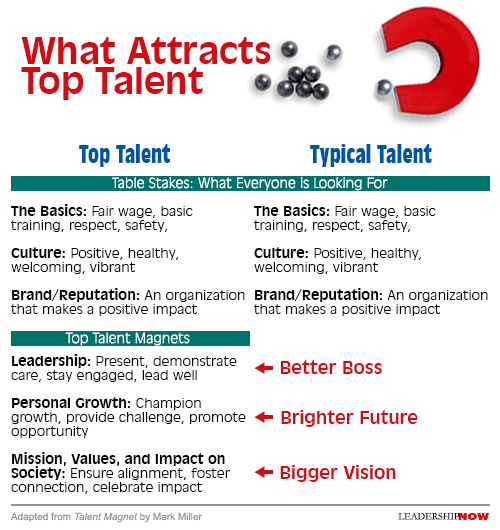 You don’t advertise that you're trying to attract top talent, you simply create the culture that top talent is looking for. “If you build it they will come.” You make people aware by practicing the qualities that make a top talent culture—Better Boss, a Brighter Future, and a Bigger Vision. An organization’s leadership must understand their individual roles in delivering on the promise. On their journey to discovery, they realized that “Many looking for work will be indifferent to our message, but Top Talent will resonate deeply with our story.” The promise should run through all of your corporate communications: engaged, caring leadership, champions of growth and opportunity, and a connection to a larger story that impacts society. The Top Talent Magnets are universal; they are not gender or age specific. People may leave and move on and take their skills with them. Each job is a learning opportunity. And you want people with that kind of mindset because that will serve you best. When your goal is to help your people learn the skills that will serve them the rest of their life, then you are more likely to attract and retain top talent that will drive your organizational goals. Blake concludes, “Working with people is the most challenging and rewarding part of being a leader. We can never shirk the responsibility. It comes with the job. If we abdicate our people responsibilities, we forfeit our leadership. People must always be our top priority. More than vision, strategy, creativity, marketing, finance, or even technology, it is ultimately people who determine our success.” 
Posted by Michael McKinney at 09:42 PM
02.21.18

Key Tips for Bridging the Generational Divide in the Workplace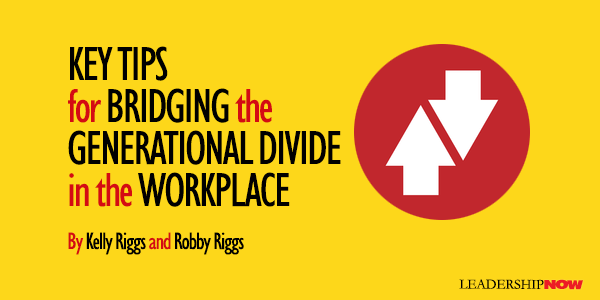
M The clash of perspectives, with the Boomer generation craving the comfort of a hierarchical organization and Millennials demanding inclusion and collaboration, impacts the bottom line. Millennials will abandon any job if the culture their manager has created is unworkable for them. If it means more than six jobs in ten years, so be it. But such turnover is costly. Research shows the average cost of employee turnover is about 20 percent of the employee’s annual salary. Other costs of not adapting leadership styles for your younger employees are harder to quantify, including lost knowledge, relationships, opportunities, and more. Transforming from an entrenched and unworkable generational disconnect into a dynamic organization able to face 21st century challenges collaboratively requires key actions, including: 1. Reassess attitudes toward junior employees. Boomers and Millennials have distinct differences in how they act and how they want to be regarded in the workplace. These differences are potentially lethal to your business, particularly when leaders aren’t prepared to make the most of the talent and innovation the young employees bring. Strategies that move managers, supervisors and executives away from being simply directors to become “people developers”—coaches, motivators and listeners—will serve in providing the collaborative culture Millennials crave. And management will realize that all generations in the organization respond better to relational leadership opposed to directives and demands. 2. Realign workplace expectations. Boomers remain in the mindset that junior employees have to pay their dues and show respect, just as they had to do. But Millennials expect their supervisors to understand the amazing life experiences and skills they bring. They value autonomy, flexibility and opportunity to express their opinion. Leaders are challenged to clearly communicate expectations and standards and allow the young employees to take ownership of their work. This means treating them as owners, not renters. Treating them like renters allows them to do the minimum amount of work and expect others to fix any problems. Owners, on the other hand, have skin in the game and own their part of the overall results. 3. Capitalize on new skills. Companies who can effectively bridge the generation gap through leadership strategies that harness the potential of Millennials will create a competitive advantage. After all, the young employees are yearning for personal value in their work and the opportunity to contribute to something that matters. The alternative is that the manager—and the organization—become irrelevant.  
Posted by Michael McKinney at 06:30 PM
01.17.18

8 Principles for Building a High-Performance Culture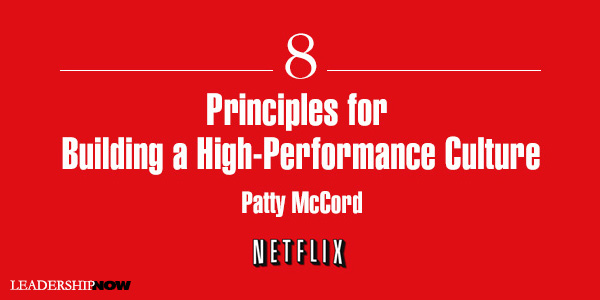
W When McCord began her career in Human Resources at Netflix, she began working with Reed Hastings to identify the behaviors that they wanted to see become consistent practices and worked to instill the discipline of actually doing them. When established they were communicated over and over again and eventually became known as the Netflix Culture Deck. They coached all of their people, at all levels and on all teams, to be disciplined about these fundamental set of behaviors. “A company’s job isn’t to empower people,” she writes, “it’s to remind people that they walk in the door with power and to create the conditions for them to exercise it.” As a leader, you need to model that behavior. If you want people to act like adults, they have to see adult behavior. There are a lot of great insights in Powerful but here are some takeaways for you to think about: 1. Treat People Like Adults “Great teams are made when every single member knows where they’re going and will do anything to get there. Great teams are not created with incentives, procedures, and perks. They are created by hiring talented people who are adults and want nothing more than to tackle a challenge, and then communicating to them, clearly and continuously, about what the challenge is. Saying to employees, “If you do X, you’ll be rewarded with Y,” assumes a static system. Yet no business is static. Being given a great problem to tackle and the right colleagues to tackle it with is the best incentive of all. 2. Communicate Constantly About the Challenge Coming up with simple yet robust ways to explain every aspect of the business isn’t easy, but it pays huge rewards. Don’t hire people that are stupid. Better yet, don’t assume that people are stupid. Assume instead that if they are doing stupid things, they are either uninformed or misinformed. If your people aren’t informed by you, there’s a good chance they’ll be misinformed by others. If you stop any employee, at any level of the company, in the break room or the elevator and ask what are the five most important things the company is working on for the next six months, that person should be able to tell you, rapid-fire, one, two, three, four, five. Ideally using the same words you’ve used in your communications to the staff and, if they’re really good, in the same order. If not, the heartbeat isn’t strong enough yet. 3. Practice Radical Honesty People can handle being told the truth, about both business and their performance. The truth is not only what they need but also what they intensely want. The most important thing about giving feedback is that it must be about behavior, rather than some essentializing characterization of a person, like “You’re unfocused.” It must also be actionable. When leaders not only are open to being wrong but also readily admit it, and when they do so publically, they send a powerful message to their teams: Please speak up! 4. Cultivate strong Opinions and Debate Vigorously Our Netflix executive team was fierce. We were combative in that beautiful, intellectual way where you argue to tease out someone’s viewpoint because although you don’t agree, you think the other person is really smart so you want to understand why they think what they think. “Can you help me understand what leads you to believe that’s true?” We had cultivated the practice of asking people about the nature of problems they were tackling rather than assuming an understanding of them. People become overly wedded to data and too often consider it much too narrowly, removed from the wider business context. They consider it the answer to rather than the basis of good questions. Good judgment: the ability to make good decisions in ambiguous conditions, to dig deeply into the causes of problems, and to think strategically and articulate that thinking. 5. Relentlessly Focus on the Future Leaders rarely look to the future in thinking about the team they’ll need. They tend to focus on what their current team is achieving and how much more that team can do. Another mistake I’ve seen in building teams is assuming that current employees will be able to grow into the responsibilities of the future. This is an especially acute problem for start-ups because founders often feel a strong sense of loyalty to their early team. Are we limited by the team we have not being the team we should have? We were going to make sure our teams were constantly evolving. Just as great sports teams are constantly scouting for new players and culling others from their lineups, our team leaders would need to continually look for talent and reconfigure team makeup. I believe the best advice for all working people today is to stay limber, to keep learning new skills and considering new opportunities, regularly taking on new challenges so that work stays fresh and stretches them. [whether that means rising within the company or seizing a great opportunity elsewhere.] 6. Have the Right Person in Every Single Position At Netflix we had three fundamental tenants to our talent-management philosophy. First, the responsibility for hiring great people, and for determining whether someone should move on, rested primarily with managers. Second, for every job, we tried to hire a person who would be a great fit, not just adequate. Finally, we would be willing to say goodbye to even very good people of their skills no longer matched the work we needed done. People’s happiness in their work is not about gourmet salads or sleeping pods or foosball tables. True and abiding happiness in work comes from being deeply engaged in solving a problem with talented people you know are also deeply engaged in solving it, and from knowing that the customer loves the product or service you all have worked so hard to make. 7. Pay People What They’re worth to You Separate performance review and compensation systems. The tight bind between the performance review process and salary increase and bonus calculations is one of the main factors holding companies back from doing away with the review process. I realized that his work with us had given him a whole new market value. We realized that for some jobs we were creating our own expertise and scarcity, and rigidly adhering to internal salary ranges could actually be harming our best contributors financially because they could make more elsewhere. 8. Proactively Say Goodbye One of the benefits of the leadership communicating clearly to everyone in the company about where you’re heading and the challenges and opportunities that future will bring is that it better equips people to evaluate how well their skills fit into that future. They can also consider whether or not that future is one they want to be a part of and, if it isn’t, can proactively seek out new opportunities. 
Posted by Michael McKinney at 08:30 PM
12.18.17

Five Happiness Traps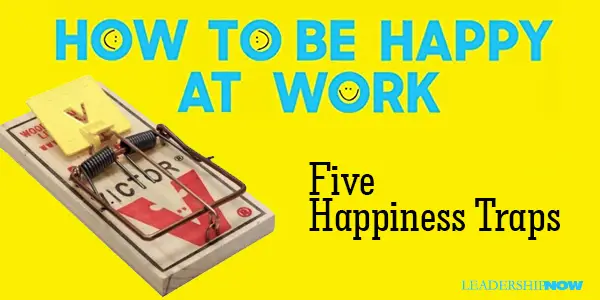
T However, considering the time we spend at work, it should not be a mindless task. Work can be hard, but we should find it invigorating as we rise to meet the challenges and grow our capabilities. Annie McKee shares in How to Be Happy at Work, five happiness traps. They are five traps we fall into that keep us from finding true happiness at work. The Overwork Trap Overwork is very common as we try to keep up with changes, do more with less, work across time zones, escape stress at home, and the sense of importance it gives us. “I’m busy,” is a badge we often wear. McKee quotes Sarah Green Carmichael on this: “We log too many hours because of a mix of inner drivers, like ambition, machismo, greed, anxiety, guilt, enjoyment, pride, the pull of short-term rewards, a desire to prove we’re important, or an overdeveloped sense of duty.” McKee says this overwork is not good for us as it negatively impacts our health and relationships. It keeps us “stuck and striving” and it “shuts down our ability to decipher what we should be doing.” In this state, it’s hard to be happy. First, we must discover why we are working so much. Do we really have to or is it a habit? The Money Trap “Money is great,” says McKee, “until our desire for it overshadows reason.” It’s not always about greed. It’s often deeper than that. “The decision to choose money over happiness is fueled by insecurity, social comparison, and the need to display one’s power for all to see.” We need to tune in to what really brings us happiness in life. “Wouldn’t it be better if money was an outcome that followed our good work rather than a goal in itself?” The Ambition Trap Ambition is not a bad thing until it drives us to be ultra-competitive and focused on winning. When we will do anything, compromise anything to come out on top without regard for the collateral damage, we are in trouble. “First, success isn’t really success when we define it as a win-lose, zero-sum game. Second, hypercompetitiveness in the workplace leaves us empty and unfulfilled, hurts our ability to lead effectively, and makes us no fun to be around. Finally, when ambition and the desire to win at all costs takes over, there’s usually something deeper going on—something we need to examine.” The “Should” Trap We all at one time or another do things because we feel we should even though we don’t want to. Of course, there are things that we should do even when we don’t want to because they are right. But there are “shoulds” that are really not more than expectations placed on us by others or society at large that no longer make any sense. There are “shoulds” that “we are forced to adhere to—whether they are society’s or our organizations’—are truly at odds with who we are and what we believe. That is soul destroying.” Social rules and “shoulds” are a fact of life. It’s not about getting rid of them; it’s about sorting through them and making conscious choices about which to follow—those that enable you to live your values, reach your potential, and be happy. The Helplessness Trap It may sound fatalistic, but as the world continues to change at an ever-increasing pace, there is a sense that we can’t keep up and therefore can’t control what happens to us. When we feel this way, helplessness sets in. “It kills hope, shatters dreams, and leaves us at the mercy of others and the vagaries of our organizations.” It’s easy to feel defeated by life and circumstances. Fear of the unknown makes us feel helpless, but with a bit of courage we can exercise more control over our lives and find happiness at work. Breaking Free from the Happiness Traps Dealing with these happiness traps begins with a little introspection and learning to manage our emotions/feelings. With reflection we can begin to understand why we do and think the things we do, then we can “actively choose to see things differently—to adapt and shift our mindset from negative to a more positive way of viewing ourselves and our situation.” Think about which happiness trap affects you the most. Mckee suggests asking yourself the following questions:

Posted by Michael McKinney at 09:03 AM
12.04.17

10 Questions to Ask Your Employees Every Quarter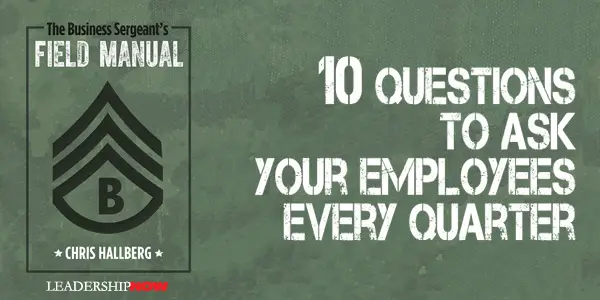
M Strong leaders, on the other hand, happily ask these questions with an eye on making things better for their team. When everyone is heard and acknowledged, only then can a leader make the right decisions and give each employee what he or she needs. If you don’t ask, who will? 1. What is your overall satisfaction with your team?
2. If the best place you’ve ever worked was a 10, please rate your current company.
3. How well does your leader do with supporting and developing you? (Consider time, tools and training.)
4. How well does your leader hold you accountable?
5. How well does your leader hold OTHERS accountable?
6. How well does your leader communicate with you?
7. How likely are you to recommend your company to a friend that is looking for work?
8. Rate your team “health.”
9. Do you feel adequately recognized for your contributions to the team?
10. How likely are you to seek advancement at your company?
The sum of all of these questions together will give you valuable information on where you are doing well and where needs immediate attention. If you ask these 10 questions every 90 days, you can compare your team’s last quarter responses and spot any problem areas before things get too caustic to your beloved culture. Again, if you don’t ask, you are guessing, and that might not work out well for you, or for your team!  
Posted by Michael McKinney at 08:05 AM
09.18.17

How to Bypass Ego-Driven Drama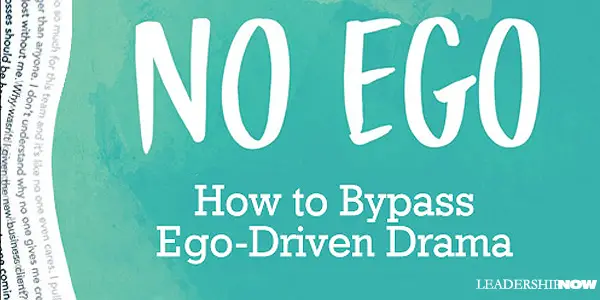
T Cy Wakeman writes in No Ego, that we spend way too much time in the workplace dealing with drama caused by our egos. Ego driven behaviors include:
Venting When we are frustrated, hurt, or angry, we vent. “Venting is the ego’s way of avoiding self-reflection.” As Wakeman points out, venting doesn't solve anything and only creates more negativity, which as we know, deteriorates our ability to think rationally. “Venting leaves people stuck in ego. It stunts growth and kills accountability.” If we encourage venting, we are preventing people from learning and growing into the person they need to become. To diffuse venting and bypass the ego, we need to move people into a different frame of mind: self-reflection. Self-reflection allows for accountability. And accountability allows people to amplify their strengths. Better all the way around. Ego-Bypass Questions Wakeman suggests bringing people back to reality by asking some ego-bypass questions: • What do you know for sure? • What would be most helpful in this situation? • What could you do next that would add value? • What could you do right now to help? • Would you rather be right or happy? • What is helpful in this situation—your expertise or your opinion? • How could we make this work? People who love their drama will not appreciate this approach. “Reality, self-reflection, and accountability make the ego very nervous. It doesn’t want to venture outside its comfort zone, so it will cling to the old and look for every possible way to torpedo change.” Ego resists things like “Mental flexibility, self-reflection, taking full accountability, forgiveness, letting go and moving on.” Check Your Own Ego This isn’t tough love, says Wakeman. “Reality is rough. Leadership is love.” If you are going to work to diminish the drama in your workplace, there are a few things Wakeman recommends we keep in mind. • Be gentle. You want to wake people up, but not by violently shaking them up. • Work with those willing to make the call. • Summon up all the compassion you can. We are all human. • Forgive others early and often. And most importantly: Check your own ego before you attempt to engage another’s. Here are some takeaways from No Ego:
 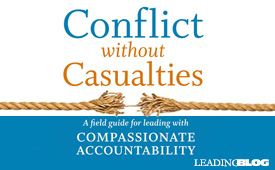 
Posted by Michael McKinney at 03:40 PM
08.07.17

Employees Do Care – and How that Helps your Bottom Line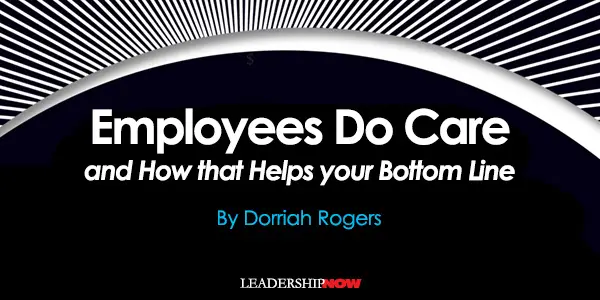
O 1. Create a behavioral culture of continuous improvement Managers and executives must promote a culture of continuous “improvement” as opposed to a culture of continuous “growth.” And there is a reason for that distinction. In my experience, many companies view “growth” as increased top-line revenue or sales, additional product lines, or entry into new markets, for example. Growth is typically more of a step event, as opposed to improvement, which is embedded and incremental. In my opinion, none of these are the true indicators of success. Success is only possible when you can do all of these things AND increase profit. In order to develop a culture of continuous improvement there are two primary areas of focus: behavioral changes and a clear system to enable ideas for change. What happens within organizations as they push for change and growth? For one, behaviors change. Where once a handful of individuals made key decisions, these decisions are now spread across numerous departments and individuals at all levels of the organization. Agility and flexibility are replaced by process and a mind-numbing disconnect from business goals. Innovation and creativity are supplanted by overhead creep, loss of productivity, and poor business decisions. Managers and executives need to own these impacts and make some changes. To make this happen I recommend the following:
2. Provide a process for employee-owned, sound and innovative business decisions that are tied to sustainable growth and profit. Decide to Profit: 9 Steps to a Better Bottom Line was written specifically in order to provide a step-by-step guide that aligns both employees and managers around connecting all ideas and decisions that affect change to the financial goals of your company. Employees have a clear system that links decisions to the financial performance of their organization. Managers have a ready tool to shape their organizational culture and business outcomes. With this system, both leaders and employees can adapt and change through external transformations in the marketplace and increasingly tough competition, and ultimately, maintain net profit. The 9 Steps enable both employees and managers to avoid common decision-making mistakes and taps directly into the fact that your employees DO care about your bottom line. The book also provides checklists and tools to foster a creative and idea-driven culture within your organization, and, ultimately, easy to understand and implement guidelines to ensure a financially sound future. The chapters outline each of the steps, its application, checklists, critical questions to ask, and easy-to-use forms for managers and employees. Embedded within each step are checks and balances and a process for accountability so that managers and employees can remain in sync in both their thinking and actions. In order for the 9 Steps to work effectively, the culture of the organization implementing them must reflect an ongoing and continuous curiosity, which ties directly back to the first recommendation. Culture and process are inextricably linked. Complacency and surrender can kill this curiosity, and creating this type of culture can be extremely difficult especially if historically your people and processes are embedded. Within the 9 Steps (Steps 1-8), a process is imbedded that allows alignment between employees and management that is focused on the right decisions for the right reasons: to ultimately make money. Step 9 is designed to ensure that your people and your ways of thinking are always asking questions, always challenging yourselves, never accepting the as-is, and ensuring that whether you fail or succeed at change or innovation does not quell the desire to constantly come up with new and better solutions. And Step 9 has a built-in feedback loop that continuously brings you back to Step 1 and so on. So between cultural behaviors and a straightforward internal process that ties directly to the financial success of your organization, leaders can provide both the tools and inspiration for success.  
Posted by Michael McKinney at 09:24 AM
06.20.17

Humility is the New Smart: Are You Ready?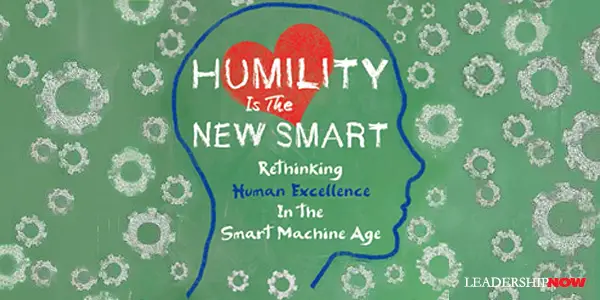
S Are you ready? The Smart Machine Age (SMA) will revolutionize how most of us live and work. In Humility is the New Smart, the authors state that “smart technologies will become ubiquitous, invading and changing many aspects of our professional and personal lives and in many ways challenging our fundamental beliefs about success, opportunity, and the American Dream.” This means that the “number and types of available jobs and required skills will turn our lives and our children’s lives upside down.” New skills will be needed. Uniquely human skills. Those skills, while uniquely human, are not what we are typically trained to do and require a deal of messy personal development. We will need to become better thinkers, listeners, relators, and collaborators while working to overcome our culture of obsessive individualism in order to thrive in the SMA. Humility is the mindset that will make all of this possible. Most of today’s adults have had no formal training in how to think, how to listen, how to learn and experiment through inquiry, how to emotionally engage, how to manage emotions, how to collaborate, or how to embrace mistakes as learning opportunities. In short, say the authors, we need to acquire and continually develop four fundamental NewSmart behaviors: Quieting Ego Quieting Ego has always been the challenge for us humans. As they observe, “Even if we don’t consider ourselves part of the ‘big me’ cultural phenomenon, for many of us to feel good about ourselves we have to constantly be ‘right,’ self-enhance, self-promote, and conceal our weaknesses, all of which drive ego defensiveness and failure intolerance that impedes higher-level thinking and relating.” This tendency negatively affects our behavior, thinking, and ability to relate to and engage with others. Managing Self—Thinking and Emotions We need to get above ourselves to see ourselves impartially. We all struggle “to self-regulate our basic humanity—our biases, fears, insecurities, and natural fight-flee-or-freeze response to stress and anxiety.” We need to be willing to treat all of our “beliefs (not values) as hypotheses subject to stress tests and modification by better data.” Negative emotions cause narrow-mindedness. Positive emotions, on the other hand, have been scientifically linked to “broader attention, open-mindedness, deeper focus, and more flexible thinking, all of which underlie creativity and innovative thinking.” Reflective Listening Because we are limited by our own thinking, we need to listen to others to “open our minds and, push past our biases and mental models, and mitigate self-absorption in order to collaborate and build better relationships.” The problem is “we’re just too wired to confirm what we already believe, and we feel too comfortable having a cohesive simple story of how our world works.” Listening to others helps to quiet our ego. Otherness To create these new behaviors and mindsets, it should become obvious that we need to enlist the help of others. “We can’t think, innovate, or relate at our best alone.” As Barbara Fredrickson observed, “nobody reaches his or her full potential in isolation.” Jane Dutton out it this way: “It seems to be another fact that no man can come to know himself except as the outcome of disclosing himself to another.” The NewSmart Organization Optimal human performance in the SMA will require an emphasis on the emotional aspects of critical thinking, creativity, innovation and engaging with others. “The work environment must be designed to reduce fears, insecurities, and other negative emotions.” To do this it means “providing people a feeling of being respected, held in positive regard, and listened to. It means creating opportunities for people to connect and build trust. “It means allocating time and designing work environments that bring people together to relate about nonwork matters.” Finally, it means getting to know employees and helping them to get the “right training or opportunities to develop and provide feedback.” The NewSmart organization needs to be a safe place to learn. “Feeling safe means that you feel that your boss your employer, and your colleagues will do you no harm as you try to learn.” 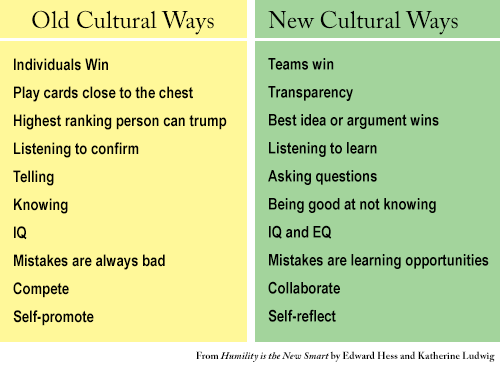 
Posted by Michael McKinney at 05:28 PM
04.19.17

Ego Free Leadership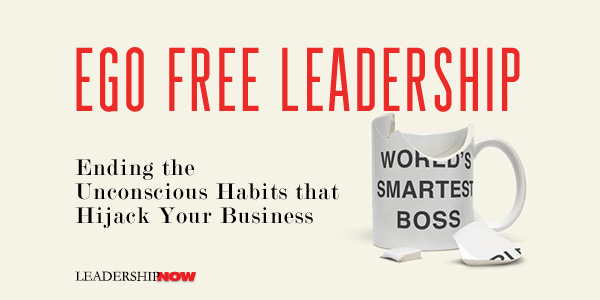
E Each of us has beliefs and fears about our value, and they cause defensive and/or self-promotional behaviors when under stress. Whether in a meeting, a presentation, or a relationship, part of our attention—sometimes all of it—is preoccupied by our view of our self. Are we competent? Respected? Intelligent? Liked? Attractive? Included? Each of us has a set of criteria we unconsciously judge ourselves against. When we measure up, we feel pride, even superiority. When we don’t, we feel uncomfortable, stressed, often afraid.Ego Free Leadership is co-written by executive coach Shayne Hughes, president of Learning as Leadership and Brandon Black the retired CEO of Encore Capital Group. The book tracks Black’s journey from acknowledging to changing the destructive elements of his ego. Once he committed to change, the transformation began in his team and throughout the culture of the Encore organization. Quite effectively, Hughes and Black go back and forth sharing their perspectives on the unfolding transformation. Naturally, it’s not a step-by-step prescription, but it is instructive to see the process because we all share similar issues and thinking. They begin by debunking the "ego is good" myth. Our egos limit us as we try to protect it in various ways. “Our ego can’t stand failure, incompetence, or weakness, so it avoids what is truly challenging us. When we feel at the mercy of what is happening around us we react often distorting reality. “We read criticism, abandonment, judgment, competitiveness, and aggression into a situation where it may not exist.” We seek to fix what we believe is causing our distress resorting to learned behaviors that really don’t serve us well. “Anytime we know intellectually what to do, but our actual behavior is inconsistent or in contradiction, it is a sign we are being short-circuited by our egosystem. These behavioral derailers come in many forms: conflict avoidance, procrastination, defensiveness, people pleasing, shutting down, being argumentative, just to name a few. Upon examination, these ingrained knee-jerk reactions invariably prove to be predictable and recurrent.” It’s not just the way we are, it’s the way we have learned to be. In order to defuse our reactive behaviors, we need to identify the underlying triggers that created our behaviors in the first place. Here are some insights from Ego Free Leadership: Intellectually it’s easy to decide that learning, growing, or creating authentic relationships is more important than not appearing incompetent, failing, or being hurt. Unfortunately, this is not how we feel at a visceral level, or we wouldn’t be continuously repeating these dysfunctional behaviors. Transformation comes when we consciously connect with goals not tied to our self-worth and use this emotional clarity to inspire action in the present moment. As the authors admit no organization (or individual) can be completely ego-free, but we can manage it better. In every situation we have a choice. We can either give in to our ego or break free of the limits it imposes on us. They recommend:
The lessons and insights shared in Ego Free Leadership could have a profound effect on any reader.   
Posted by Michael McKinney at 11:16 PM
04.05.17

Radical Candor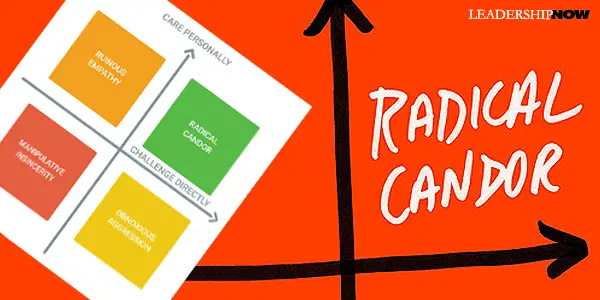
R The very heart of being a good boss is a good relationship, writes Kim Scott in Radical Candor. We need Radically Candid relationships with those we work with and because this is often scary and can be emotionally taxing, we resort to be ruinously empathetic or obnoxiously aggressive or manipulatively insincere. Of course, establishing trust with each person that reports to you is fundamental to radical candor. Radical Candor happens when you put Care Personally and Challenge Directly together. Care Personally refers to the fact that to have a good relationship “you have to your whole self and care about each of the people who work for you as a human being. Challenge Directly “involves telling people when their work isn’t good enough—and when it is. Challenging people might seem the opposite of Care Personally, but “challenging people is often the best way to show them that you care when you’re the boss.” Scott explains that she chose the word Radical “because so many of us are conditioned to avoid saying what we really think. This is partially adaptive social behavior; it helps us avoid conflict or embarrassment. But in a boss, that kind of avoidance is disastrous. She chose Candor because it is “necessary to communicate clearly enough so that there’s no room for interpretation, but also humbly.” Caring Personally is about acknowledging that we are all people with lives and aspirations that extend beyond those related to our shared work. It’s about finding time for real conversations; about getting to know each other at a human level; about learning what’s important to people; about sharing with one another what makes us want to get out of bed in the morning and go to work—and what has the opposite effect. Radical candor is not an invitation to be a jerk, or to nitpick, or to simply schmooze. (“A good rule of thumb for any relationship is to leave three unimportant things unsaid each day.”) What you say gets “measured at the listener’s ear, not at the speaker’s mouth.” Everything must be delivered in good faith. 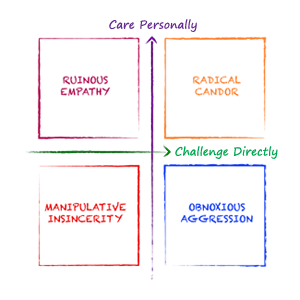 Scott has created a framework to help you be more conscious of the kind of guidance you are getting, giving, and encouraging. There are two dimensions to good guidance: Care Personally and Challenge Directly. It is a way to gauge praise and criticism. Scott has created a framework to help you be more conscious of the kind of guidance you are getting, giving, and encouraging. There are two dimensions to good guidance: Care Personally and Challenge Directly. It is a way to gauge praise and criticism.
When you criticize someone without taking the time to show care, your guidance feels like Obnoxious Aggression. It’s what happens when you challenge but don’t care. It’s praise that doesn’t feel sincere or criticism that isn’t delivered kindly. “When bosses belittle employees, embarrass them publically, or freeze them out, their behavior falls into this quadrant.” And keep this in mind: “Almost nothing will erode trust more quickly than using one’s insights into what makes another person tick to hurt them.” Manipulative Insincerity is what happens when you neither care nor challenge. It’s an attempt to push the other person’s emotional buttons in return for some personal gain. It’s praise that is non-specific and insincere or criticism that is neither clear nor kind. Ruinous Empathy is what happens when you care but don’t challenge. “When bosses are too invested in everyone getting along, they also fail to encourage the people on their team to criticize one another for fear of sowing discord. They create the kind of work environment where ‘being nice’ is prioritized at the expense of critiquing, and therefore, improving actual performance.” It is praise that isn’t specific enough to help the person understand what was good or criticism that is sugarcoated and unclear. You may think Radical Candor would never work on your organization’s or team’s culture. And it probably won’t unless you first invest in the people you work with and show them that you care personally. But here’s the big hurdle: Start by explaining the idea and then asking people to be Radically Candid with you. Why you first? First, it’s the best way to show that you are aware that you are often wrong and that you want to hear about it when you are; you want to be challenged. Second, you’ll learn a lot—few people scrutinize you as closely as do those who report to you. Third, the more firsthand experience you have with how it feels to receive criticism, the better idea you’ll have of how your own guidance lands for others. Fourth, asking for criticism is a great way to build trust and strengthen your relationships. (Important: “If a person is bold enough to criticize you, do not critique their criticism.”) Scott carefully details ways to create a climate in which Radically Candid relationships can flourish. She provides many (most first-hand) examples of what worked and what didn’t work. From her experiences at Apple and Google, she observed that “a boss’s ability to achieve results had a lot more to do with listening and seeking to understand than it did with telling people what to do; more to do with debating than directing; more to do with pushing people to decide than with being the decider; more to do with persuading than with giving orders; more to do with learning than with knowing.” And there’s an app: Candor Coach. This app will show you how quick, frequent, face-to-face conversations can help you build a culture of Radical Candor. It will start by teaching you to ask for and give feedback. It will help you track the conversations you’re having with each person on your team so that you can see where you need to improve.   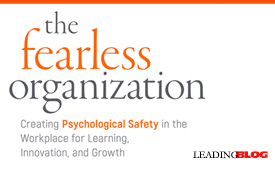
Posted by Michael McKinney at 09:32 PM
03.20.17

Leaders Made Here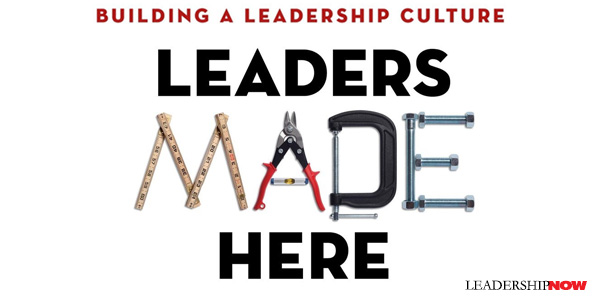
T This occurs for a number of reasons: They don’t see the immediate need, they don’t understand how or are too busy to do it, they don’t walk the talk, and their own insecurities. Leadership cultures are built from the top down. Miller describes a leadership culture is one where “leaders are routinely and systematically developed, and you have a surplus of leaders ready for the next opportunity or challenge.” Leaders Made Here is the story of a typical organization that found themselves short when they needed more leaders to fill some gaps and what they did to create a leadership culture. Frankly, a leadership culture does more than to have leaders in waiting. It provides for the growth and development of all people throughout the organization. It makes whatever you’re doing work better. To create a leadership culture, Miller boils it down to five ongoing commitments: 1. Define it.
There’s certainly real power in a common definition of leadership; there’s even more power in a common leadership skill set. 2. Teach it.
3. Practice it.
We discovered that for most people—leaders included—the natural tendency is to avoid risk. So, when a new project would come along, the leader responsible would assign a seasoned leader regardless of opportunity. It did not matter what was needed; our existing leaders rarely gave an emerging or inexperienced leader a shot. This did nothing to help young leaders grow and develop in a real-world setting. 4. Measure it.
A scorecard should answer at least four questions: What is most important now? Is our performance improving or declining? What impact are our interventions having? And are we winning? 5. Model it.
Leaders Made Here is not a bold initiative that comes and goes. It must become what the organization is. It has to become part of the organizational DNA. 
Posted by Michael McKinney at 08:44 PM
02.27.17

Mastering Civility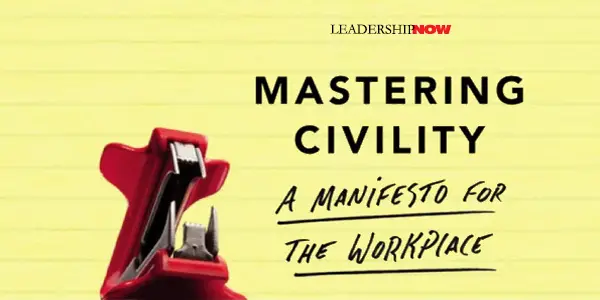
Civility costs nothing, and buys everything. CIVILITY has a way of winning people over and garnering influence. Civility isn’t just the absence of incivility. In Mastering Civility, Christine Porath explains that “Civility in the fullest sense requires something more: positive gestures of respect, dignity, courtesy, or kindness that lift people up.” Incivility impacts our health and performance. It depletes our “immune system, causing cardiovascular disease, cancer, diabetes, and ulcers.” It also robs us of our “cognitive resources, hijacks our performance and creativity, and sidelines us from our work. Even if we want to perform at our best, we can’t, because we’re bothered and preoccupied by the rudeness.” Incivility is contagious. “When you’re exposed to hostility or aggression, you behave differently. Incivility sneaks into your subconscious. It’s easy to see how plagues of incivility can take shape and spread.” But you don’t have to succumb to incivility. “When you follow a rude experience with a polite one, the polite one ‘overwrites’ the rude one, loosening the hold it has on your mind.” Civility starts with a few basic behaviors and it grows from there. Simple things like saying please and thank you make a difference in how we are perceived by others and the influence we have on them. “Most of us are in a hurry to prove our competence, but warmth contributes significantly more to others’ evaluations. Warmth is the pathway to influence.” Other basic behaviors include acknowledging people and listening. They signal caring, commitment and connection. Show respect for others by sharing resources, the limelight, and positive feedback. “The highest performers offer more positive feedback with their peers; in fact, high-performing teams share six times more positive feedback than average teams. Meanwhile, low-performing teams share twice as much negative feedback than average teams.” What if you are the victim of incivility? When someone is being uncivil to you it’s easy to let your emotions take over. It’s easy to get sucked in to their incivility. Porath advises you to avoid the temptation to get even. It’s not a win for you. The best advice has nothing to do with them and everything to do with you. How will you choose to interpret it? Here are a few of her thoughts: When you experience incivility, your sense of thriving comes into play in a particular way: by making it easier for you to reframe the negativity of the event so that it isn’t nearly as destructive. Everyone would agree that we should be civil and we recoil when we see others engaged in it, yet incivility has become more commonplace. Somehow we feel justified being uncivil when things don’t go our way. And it costs us all. Uncivil behavior does not generate greater influence no matter how loud you are. Most leadership failures can be attributed to abrasive or arrogant approaches to others. Uncivil leaders eventually undermine their own potential. Are you civil? Porath offers a quick civility assessment online. 
Posted by Michael McKinney at 08:44 AM
02.19.16

9 Ways We Sabotage Ourselves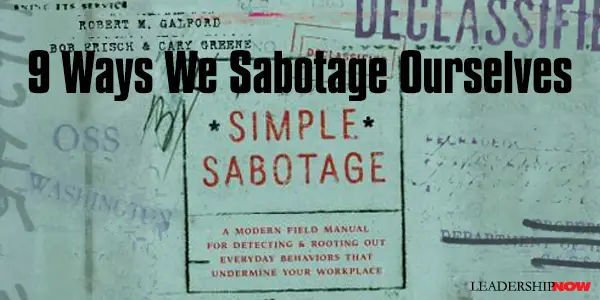
FROM PEOPLE whose job it is to sabotage the efforts of others, we can take a lesson or two. In Simple Sabotage, authors Robert Galford, Bob Frisch, and Cary Greene explain that in January 1944 the OSS (Office of Strategic Services—predecessor of the CIA) published the Simple Sabotage Field Manual (PDF) to train resistance members in the art of sabotage. “The Manual detailed easy ways to disrupt and demoralize the enemy’s institutions without being detected.” One section of the Manual provided eight tactics specifically designed to disrupt the enemy’s organizations. The authors have added a ninth in keeping with the times. One thing you will notice from each of these tactics or behaviors is that none of them are all that bad on the surface. One could easily find a rational explanation for engaging in them—to a point. And that’s the problem. That’s why these are insidious. Too often we insist on reproducing a behavior long after the sell-by date. We don’t let it go when we should and so we unwittingly sabotage our best efforts. Here are nine acts of sabotage we unintentionally get caught up in: Sabotage by Obedience Insist on doing everything through channels. Never permit shortcuts to be taken in order to expedite decisions. Sabotage by Speech Make “speeches.” Talk as frequently as possible and at great length. Illustrate your “point” by long anecdotes and accounts of personal experiences. Sabotage by Committee When possible, refer all matters to committees, for “further study and consideration.” Attempt to make the committees as large as possible—never less than five. Sabotage by Irrelevant Issues Bring up irrelevant issues as frequently as possible. Sabotage by Haggling Haggle over precise wordings of communications, minutes, resolutions. Sabotage by Reopening Decisions Refer back to matters decided upon at the last meeting and attempt to reopen the question of the advisability of that decision. Sabotage by Excessive Caution Advocate “caution.” Be “reasonable” and urge your fellow conferees to be “reasonable” and avoid haste, which might result in embarrassments or difficulties later on. Sabotage by Is-It-Really-Our-Call? Be worried about the propriety of any decision—raise the question of whether such action as is contemplated lies within the jurisdiction of the group or whether it might conflict with the policy of some higher echelon. Sabotage by CC: Everyone CC: Everyone. Send updates as frequently as possible, including in the distribution list anyone even peripherally involved. In each chapter, the authors use examples to help you identify the behavior and root it out—which is not as simple as you might think. Perpetrators can easily defend their behavior, but that’s what makes these behaviors so effective. For the same reason, it is also difficult to see in ourselves. Simple Sabotage is about the day-to-day routine interactions and processes we rely on as we work that are undermined by unintentional sabotage. By identifying and removing the hundreds or even thousands of small, barely perceptible irritants—the “sand” that clogs the machinery—you will transform your workplace or workgroup experience and the experience of those around you. 
Posted by Michael McKinney at 10:15 AM
01.27.16

Leadership Value is Defined by the ReceiverWE ALL RESONATE with the clarion call for leaders to build on their strengths, be authentic, and demonstrate emotional intelligence. We can envision these noble, resonant, and genuine leaders as icons of effective leadership. But these virtuous leadership attributes are not the essence of leadership effectiveness.Building on one’s strengths is incomplete unless one’s strengths strengthen someone else. Authenticity without a positive impact on someone else is more narcissism than leadership. Effective leaders turn their emotional intelligence into helping others find their purpose and meaning. An underlying principle of effective leadership is that value is defined by the receiver more than the giver. This value-added principle applies in almost every relationship. When I give my wife a gift, she defines the value of the gift. When I was newly wed, I got her tickets to sporting events and she often suggested I enjoy myself. I have learned that the real gift is figuring out what will be meaningful to her, not me. Likewise, effective leaders recognize and serve the stakeholders who are impacted by their strengths, authenticity, and emotional style. They then work to deliver value to these stakeholders in ways that matter to the stakeholders. When leaders focus on the value they create for others, they think less about who they are and how who they are, will make others better. They realize that the value of their values is in that others will achieve what matters to them. Ultimately, leaders are measured by what they leave behind and how their present actions shape future success. Leaders should be asking themselves, “Who are the stakeholders I care about? Who do I want to make better because of what I do? Who will benefit from my choices today? How will my actions be seen by and affect others?” When pondering and responding to these questions, leaders matter because they create sustained leadership in others. Value creating leaders talk more about “we” than “I”; they build on what is right more than what is wrong; they help others feel better about themselves when leaving an interaction with them; the work to institutionalize their ideas so that they are sustained; and they relish success in those they mentor. It is time to look beyond a leader’s personal strengths, authenticity, and emotional well being to define how leaders’ build value for others. 
Posted by Michael McKinney at 07:07 PM
11.11.15

A Framework of Organizational Tensions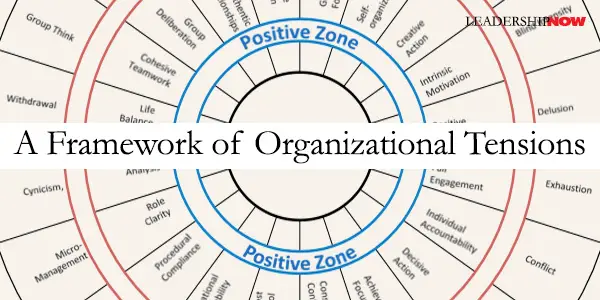
TENSIONS are objectives that seem to be in conflict. They are values that seem to be in opposition. We often treat them as either/or choices when they should be treated as both/and dynamics. Each value or characteristic supports and even makes possible the competing value. Robert Quinn has produced a valuable tool for understanding this concept in his book The Positive Organization. What makes it especially valuable is that it illustrates the options we have to the single values we hold so dear—there are possibilities and equally effective “right” solutions we can use to move us forward. We tend to focus on the value that resonates most with us or the ones we are most familiar with. This often causes us to get stuck or to jump from one ditch to the other never realizing the true potential of our organization. (This dynamic plays out in our personal lives as well.) 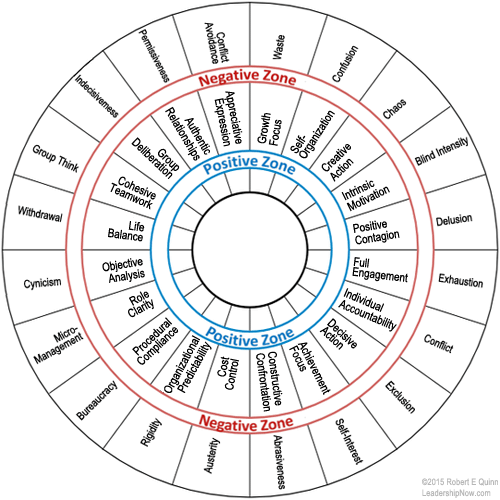 You will notice that each of the positive values in the inner circle is associated with a negative value on the outer circle. If we champion one value over another we put our organizations at risk for the negative outcomes associated with each of the 20 values on the diagram. Every positive value without its contrasting value can become a negative in much the same way the overuse of a strength becomes a weakness. For example, we need some predictability and control in any organization, but too much leads to rigidity. We also need some spontaneity and self-organization for people to flourish, but again too much can lead to organizational and personal chaos. We also miss the larger picture and usually misinterpret issues.  A person who seeks a predictable, smooth running organization often focuses on disruptions and disruptive influences; the natural inclination is to fix those disruptive problems. When we focus on a problem, we are not seeing the whole system. We are paying attention to something within the system. Likewise, when we focus on a single person, we are not focusing on the culture of which that person is a part.When we have an agenda we tend not to see the whole picture. As leaders we need to see the broader context of every situation. It’s not about finding balance. It’s about emphasis—where to place the emphasis and when. Of Related Interest: 
Posted by Michael McKinney at 04:45 PM
11.05.15

What Gear Are You In Right Now?
“Wherever you are, be all there!” Jim Elliot’s advice offers a difficult challenge. “You’re here but your mind is somewhere else” is a common refrain. Jeremie Kubicek and Steve Cockram, authors of 5 Gears: How to Be Present and Productive When There Is Never Enough Time, write “Every day, millions of people are negatively impacted by the inability of a person to connect appropriately and to be present.” So much drama is created when we don’t know how to shift gears and become present. 5 Gears offers an extremely valuable metaphor for identifying which gear you are in and finding the right gear at the right time in order to connect fully with others. The model is a relationship-driven approach. It is values-driven and helps to counteract self-absorption. The majority of people are not aware of their social awkwardness and give little time to thinking about what gear the other person is in while they are talking.What I like most about the 5 Gears model is first, it gives you language to communicate which gear you are in to yourself and others, and to understand where others are at so that you can be more fully present. Second, it helps you plan what gear you need to be in as you move through your day. And third, it helps to be more self-aware and other-aware. 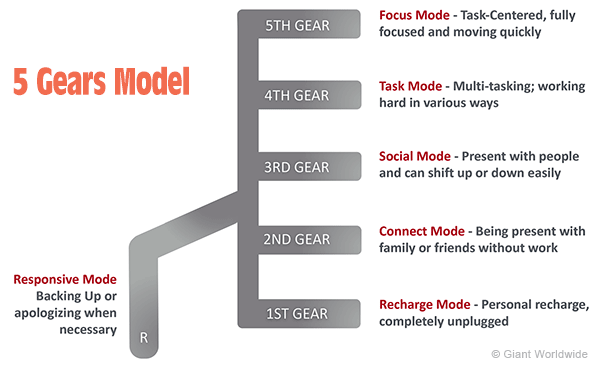 Like shifting gears in a car, there is a right order and a right time for each gear. Life goes more smoothly when you are shifting through the gears at the right time—and avoiding getting stuck in any one gear. Here are the 5 Gears:  5th Gear: Learn to Get "In the Zone" 5th Gear: Learn to Get "In the Zone"5th Gear is focus mode that allows us to “get in the zone” without interruption. It takes discipline to shut the door, turn off your email, and let people know that you are shifting into 5th gear, but it makes it possible to cruise at a sustained speed for a period of time. The caution is that when you get stuck in 5th gear you miss out on relationships, opportunities to add value, and events in life that matter in the long term.  4th Gear: Leading in a Task World 4th Gear: Leading in a Task World4th Gear is the task gear that allows us to work hard while also multitasking. Most of the time we operate in 4th Gear so we need to learn to use it well. Waking up in 4th Gear is not the best strategy for your life. Our tasks can begin to control our lives. (Do you normally check your e-mail when you first wake up?) We need to learn how to shift into it and how to shift out of it. They relate the observation of Elizabeth Paul as an example. How many of us are like this: The personal story for me was realizing that as a woman I have “work” 4th and 5th gear and “domestic” 4th and 5th gear. I thought that because I was being disciplined about putting my devices away during the golden family window of 5 to 8 P.M. I wasn’t in 4th or 5th gear, when in reality I was just putting on a different task hat. When my eyes were opened to that, I realized that I actually have little to no 3rd or 1st gear in my life at all. That was shocking.In other words, the other gears are not just another 4th Gear task. Each Gear requires a different mindset or approach to your time. If we learn to implement the other gears in our life we will find that our everyday, multitasking 4th gear will become more productive.  3rd Gear: Why Being Social Matters 3rd Gear: Why Being Social Matters3rd Gear is the social gear. 3rd gear is a mindset. It is the space between task-driven, hyper focused work and the no-work, relational connection of being with your family, spouse, or close friend. Type-As need to remember that business happens in 3rd gear—in relationships. If you are too important for small talk, you might want to study the chapter on 3rd Gear. Of course you can get stuck in 3rd gear and overdo it. At the same time if you try to control social space it actually becomes a 4th Gear activity for you.  2nd Gear: Connecting Deeply 2nd Gear: Connecting Deeply2nd Gear represents connecting with family, friends, or colleagues. Whether work colleagues, family, or friends, it is time geared toward relationship building without an agenda or pressure to be productive. Some of us have never really learned how to connect. It can’t be forced. It requires making time and learning to truly give of yourself to others. 2nd Gear is a difficult gear to be in because we live in a 4th Gear world. Kubicek writes that while writing this book consumed a lot of time, energy and mental thought, “it is still my responsibility to be the leader worth following in my home. Even with the pressure of a deadline, I still have to practice shifting.” He has found that being present in 2nd Gear leads to healthy relationships that bring peace to your mind and heart, fruitful growth between people, better conversations, likeability and trust, reestablished priorities, less drama and more security, social awareness and emotional intelligence.  1st Gear: Learn How To Recharge 1st Gear: Learn How To Recharge1st Gear represents being fully recharged. Do you know how to recharge? “If you figure out what 1st Gear feels like for you and discipline yourself to spend more time there, more power will flow through you. If you live and lead out of 20 percent battery life then you will never experience what you hope to experience.” The recharging gear if different for all of us. What works for one may not work for another. But we need to find what works for us. Think about this statement: “Working from your rest, not rest from your work, is the goal.” Note to self: “Crashing is not resting; it is actually just crashing.” It is simply stalling out. Truly healthy rest restores you.  Reverse: Learn How to Apologize Reverse: Learn How to ApologizeReverse is the responsive gear. It is used when we need to back up and start again or apologize. Unfortunately, too many people operate without a reverse gear. There are two types of people—responsive and resistant. You hire responsive ones and fire the resistant. Responsive people are self-aware and have a consciousness that is not steeped in victim mentality, but rather responsibility. They understand that they are responsible for their actions and will make amends when they have clearly overstepped their bounds. Responsive people are the best employees, and spouses, and children.Are there any relationships you need to restore? Making the 5 Gears Work For You After explaining the 5 gears, Kubicek and Cockram ask us to find our go-to gear. Where do we like to spend most of our time and what gear is the hardest for us to be in? Learning how to improve on your hardest gears hold the keys to improving your influence in the lives of others. Next you need to find the right time for each gear as you go through your day. There is a natural time for gears. Your mornings should not start in 4th Gear. Really! When we are in the wrong gear at the wrong time we create disconnects. Shifting well is both an art and a science. 5 Gears offers some practical examples of leading your life intentionally and in the right gear at the right time. I know this post is getting long, but let me leave you with an example of integrating the 5 Gears into your daily schedule: 6A.M.—Wake Time: 1st Gear 
Posted by Michael McKinney at 11:28 AM
09.23.15

Keeping People Front and Center
AT SOME POINT we all come to see that people are the most important part of any initiative. We get caught up in the tasks, but it’s the people that leaders need to focus on. Dominic Barton, global managing director of consulting firm McKinsey & Company, reminds us of this in an interview with The Wharton School. Talking to CEOs reflecting on their tenure he found that they all said that they would have “moved faster on people … taken people out faster, moved them up faster and spent more time on people…. I’ve not heard a single leader not say this [among] those that are toward the end of their career.” This is made easier of you are able to compartmentalize your work. If you can isolate and focus on issues separately for short periods of time, you are better able to keep that big picture in mind—keep an eye on what’s really important. He added: “You get so many issues coming at you, and some of them can paralyze you.” He related a story from a Liberty Mutual CEO who told him, “‘In my first three weeks of my job, I would have kicked you out of my office.'” The CEO explained that at that time, he had been told by his general counsel that the company was being sued for $6 billion, and that everywhere he looked, all he could see was $6 billion. “Now, he said, ‘I’m talking to you, and I have six of those [issues going on right now], but I’m focused on you.'”
Posted by Michael McKinney at 11:51 PM
08.28.15

Fairness is OverratedFairness is Overrated is a solid leadership primer on what it takes to create a healthy culture day-in and day-out. Tim Stevens comes from a Church leadership perspective. However, his 52 principles are applicable anywhere because people are people with the same issues—only the peer pressure changes (unfortunately).The 52 principles are organized around four key areas: Be a leader worth following, Find the right people, Build a healthy culture and Lead confidently through a crisis. Stevens begins with “live a life with margins” and ends with the “five stages of failure.” Living a life with margin structured in not only helps all of the other leadership principles discussed here but it helps you move through the five stages of failure faster. So it’s a foundational principle. A leader worth following has integrity. It’s about character. Knowing yourself and disconnecting is an important way to maintain integrity. You need to build space for what’s important. Finding the right people—finding and developing leaders—is the most important thing his did as an executive pastor. “Here is what I believe to my core: the success of leaders will rise or fall based on the decisions they make about the people around them.” When hiring people Stevens recommends not going solo. Get others involved. Chemistry is more important than skills, experience, or education. Use social media to “get to know” the people you are considering. Look for how they treat people they disagree with. Hiring too quickly leads to problems. Pay well. “You don’t want staff to join because of money. You don’t want staff to stay because of money. You don’t want staff to leave because of money.” If you have a healthy culture, people are waiting in line to join your organization. A healthy culture is led by a leader who is not insecure about others succeeding. Gossip is not tolerated. Employees do life together; it’s not just a job. In a healthy culture a leader turns over authority to others. Let your leaders lead. “No organization, church, government, or company can have a healthy culture and be run by a dictator, monarch, or single personality.” You need a strong team running the organization. What Stevens is talking about here is humility. A toxic culture cannot be changed without it. Leading confidently through a crisis means trusting the people you have in place to figure it out. A confident leader is not one that says, “I can figure it out” but one that says, “We can figure it out.” Having a great team in place is critical here. If you have found the right people and developed a healthy culture, then it becomes easier to lead confidently in a crisis. These 52 principles are easier to implement if you have people who will speak truth to you. Again, humility is key here. There is a lot to be considered in this book. It is well-written (a bit of a page turner) and you will want to go back again and again to see how you measure up. And by the way, fairness is overrated. “Don’t confuse fairness with justice. Justice is about doing what is right. Fairness means everyone gets exactly the same thing.” It's about priorities. 
Posted by Michael McKinney at 08:03 AM
05.18.15

A Lean Look at Value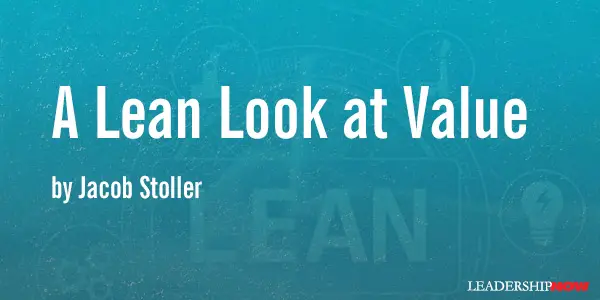
“Price is what you pay. Value is what you get,” said Warren Buffett, adeptly observing that value is more than just a notion of what something is worth. Customer value that is based on substance, as opposed to perceptions, is widely pursued by organizations that aspire to greatness and is also a fundamental building block of the Lean management system. One of Lean’s great triumphs is that it breaks value down into a set of metrics that can be actively pursued. Leaders who aspire to excellence can gain much from studying this approach. Separating value from waste Toyota, who pioneered Lean methods in the wake of World War II, learned how to maximize value under dire circumstances. Desperate to make the most of scarce resources, they began a relentless campaign to eradicate any expenses or activities that didn’t contribute directly to the value that customers would willingly pay for. In other words, maximizing value – Buffett’s proverbial “what you get” - was a process of elimination. For example, an assembler installing a mirror on a vehicle was at that moment adding value. Walking across the plant to retrieve a screwdriver while the vehicle sat idle, however, was considered non-value or waste. If there were more workers than necessary assembling the car, or more parts than needed in inventory, these were considered wastes that added unnecessary cost to the vehicle. The key here is that the workpiece is treated as a proxy for the customer. It’s almost as if extra walking was keeping the customer waiting, or extraneous activity was wasting the customer’s money. This applies in any industry, whether the workpiece is a manufactured product, a meal in preparation, or an insurance claim under review. In healthcare, the workpiece and the customer are the same, making non-value activity waiting particularly visible and objectionable. Where’s the customer? In Lean organizations, all efforts are focused on the customer experience. To support this, Lean organizations drive improvement using metrics that pertain directly to customer value, such as defect rates, on-time delivery, lead times, and cost indicators such as inventory turns. It also prioritizes roles according to customer value – the closer you are to the customer, the more important the work is. In a factory, the shop floor workers who produce the goods are the most important. In a hospital, it’s the hands-on care workers. In an insurance company, it’s the representatives that are on the phone handling customer claims. This approach has profound implications for employees who don’t make products or interact with customers. By the Lean definition, non-production activity, including IT, engineering, HR, accounting, and yes, senior management, can only provide value indirectly through their support of production. This calls for some major role shifts. HR, instead of sponsoring leadership courses, might spend more time in the workplace helping employees develop problem-solving skills. Accounting, instead of trying to explain variances for the past quarter, might spend their time developing real-time reports to help production supervisors make better buying decisions. And senior managers might step out of the executive suite and find out what more they can do to support their value-creating workers. When assessing whether an activity has value, everything stems from one question: “Why would our customers pay for this?” If the answer is “I don’t know,” maybe it’s time to eliminate it.  
Posted by Michael McKinney at 12:11 PM
03.03.15

The 5 Habits of Mind that Self-Made Billionaires Possess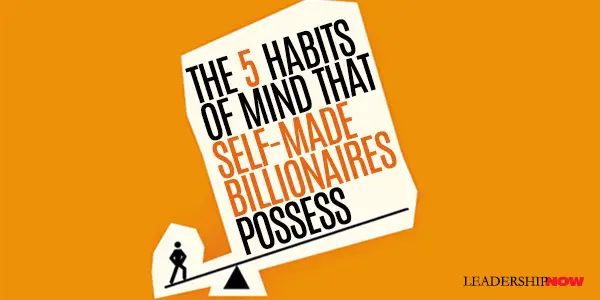
SELF-MADE billionaires think differently than most of us do. Most of us think like what authors John Sviokla and Mitch Cohen call Performers because their success is tracked through performance. They excel at optimizing within known systems. They strive to excel in well-defined areas, and are important to any organization – in fact, they are important to the self-made billionaire. Self-made billionaires have what the authors call the Producer mind-set. They thrive in uncertainty. Producers are critical to any company looking to create massive value because they redefine what’s possible, rather than simply meeting preexisting goals and standards. Combining sound judgment with imaginative vision, Producers think up entirely new products, services, strategies, and business models. For The Self-Made Billionaire Effect, they interviewed 120 billionaires and found that they had in common five habits of mind. What is interesting is that most organizations weed out the very people that they need to create massive value. Imagine what Atari might have achieved if Steve Jobs had stayed there to develop the first mass market personal computer.Self-made billionaires are able to integrate ideas and actions that most individuals and organizations keep separate or even hold in direct tension to one another. Self-made billionaires effectively operate in a world of dualities—they seamlessly hold on to multiple ideas, multiple perspectives, and multiple scales. Here are the five critical dualities that they observed with additional thoughts on each: Empathetic Imagination Producers billion-dollar ideas come through the marriage of extreme empathy for the customer’s needs and wants, and an imaginative mind-set that allows him or her to come up with and explore new, untested ideas. Focusing on the competencies of today is exactly what causes companies to get stuck in the markets they serve and the products they deliver now, with little eye for the shifts and innovation they will need for tomorrow. Sometimes it takes a slight twist in perspective to see opportunities through a different lens. Patient Urgency Producers urgently prepare to seize an opportunity but patiently wait for that opportunity to fully emerge. Producers are willing to operate simultaneously at multiple speeds and time frames. Inventive Execution Producers approach execution of their ideas with the same integrative, inventive mind-set they applied to come up with a billion-dollar idea in the first place. Inventive freedom allows them to design aspects of the customer experience that outsiders consider fixed, thus unlocking new value. Producers frequently operate in markets that require them to rethink the fundamentals of product or business design in order to deliver at scale. Taking a Relative View of Risk Self-made billionaires are not huge risk-takers. Their perceptions of risks are relative: they are far less concerned about losing what they have than of not being part of a bigger future. What Producers are not willing to risk is the chance to capture an opportunity. This dynamic creates a critical duality between the right kind of risk and the resilience needed to do it all over again when the original plan doesn’t work out. Leadership Partnership Producer overwhelmingly do not go it alone. Creating billions in value requires both a master Producer, who can bring together divergent ideas and resources into a blockbuster product design, and a virtuoso Performer, who can apply his or her creative acumen to optimizing the potential of that design. Creating billions in value requires both: the Producer’s ability to bring together divergent ideas and resources into a blockbuster concept and inventive design, and the Performer’s ability to follow through on details needed to make the business work. Why don’t organizations hold on to extraordinarily talented people? These Producers? Here’s the thing: while we can all get behind these attitudes of mind, organizationally we don’t generally reward these traits. We recognize and reward Performers. They get the raises and promotions largely because they're easy to recognize. They fit in; they can hit the ground running. Producers on the other hand don’t always fit because they think differently from those around them. “The ideas they propose move against the standard approach you are following, and that friction is what you need to achieve breakthrough value.” That makes us uncomfortable. As a result, we tend to drive Producers away or cause them to just give up. We need both types, but when looking for new employees we need to look for more people whose background hints at looking at things differently. People who have started something new. People with the raw imagination to see something new and the fortitude necessary to work through the difficulty of execution. “The key imperative for management is to differentiate between opportunities that need a Performer and those that need a Producer. Look at areas of achievement for the business and at who did the work. When it is a Producer, recognize that and give that Producer her next Producer-appropriate challenge.” As leaders we need to accept both Producers and Performers and reject neither. We need to find and support positive deviance while promoting for systematic improvement. 
Posted by Michael McKinney at 11:30 PM
02.03.15

4 Keys to Finding Hidden Leaders in Your OrganizationJim Kouzes writes in the foreword of The Hidden Leader that “Our images of who’s a leader and who’s not are all mixed up in our preconceived notions about what leadership is and isn’t.” Well put. That is the issue.He goes on to say that “hidden leaders are those people in your organization who share the belief that what they do matters.” And they are all around us. The authors Scott Edinger and Laurie Sain have developed some key indicators for finding the hidden leaders in your organization or team. These people can be “defined, identified, nurtured, and encouraged to help an organization develop a competitive edge.” Some will accept a position and others will prefer to stay off the organizational chart, but all can drive excellence throughout the organization. Hidden leaders display four key identifiers: they demonstrate integrity, lead through relationships, focus on results, and remain customer-focused no matter what role they have in the organization. Let’s look at them one by one: Demonstrate Integrity. Edinger and Sain believe that this is the “absolute bottom-line requirement of hidden leadership.” It means a consistent display in thoughts and actions of a strong ethical code of conduct that is “focused on the welfare of everyone.” Their consistent adherence to their beliefs makes them predictable and therefore dependable. They have the courage to do the right thing even when it is difficult. Lead Through Relationships. Leading through relationships is the basis of leadership. They get along with others and value others. They “lead and inspire because of who they are and how they interact with others.” They don’t depend on their position or lack of it to influence the actions of others. Focus on Results. The hidden leader “maintains a wide perspective and acts with independent initiative.” They use the end to define the means, which can mean working outside of strict processes to achieve the end result. “They aim for the end they are supposed to produce” so “they feel responsible and accountable, not just for the demands of their jobs but also for successful outcomes for stakeholders involved.” Remains Customer Purposed. This is different than customer service; it is an “awareness of how an action in a specific job affects the customer.” It is a big-picture focus and having a deep understanding of the value promise of an organization. For some hidden leaders one characteristic may dominate and others may need to be fully developed, but a hidden leader who lacks integrity, isn’t a hidden leader. Any leader needs support from other leaders in the organization and a good leader will make a priority out of developing others. Hidden leaders are easier to spot in flatter organizations and those that provide a greater number of areas to contribute. Listening to people at all levels is a big part of that. By recognizing hidden leaders we help to create a culture that develops more leaders. The hidden leaders are there. It is a leader’s responsibility to discover and develop them. The Hidden Leader contains worksheets and access to online resources to evaluate hidden leaders in your organization or team. Of Related Interest: 
Posted by Michael McKinney at 10:08 PM
01.05.15

Rookie Talent: Avoiding a Kodak Moment Kodak began to struggle financially in the late 1990s as a result of the decline in sales of photographic film and its slowness in transitioning to digital photography. In 2012, the company filed for Chapter 11 bankruptcy protection. The Kodak name became synonymous with a resistance to change, but it’s not just innovation the company lacked. In 2011, Kodak made the list of Top 10 Fortune 500 Employers With Older Workers, called out for employing a disproportionately high percentage of mature workers. I can’t help but wonder: If Kodak had paid attention to its aging workforce trend, would the company have maintained market share and avoided bankruptcy? I believe the answer is yes. I also believe companies didn’t learn much from Kodak’s example. Although the recession ended in 2009, here we are five years later and unemployment for Generation Y (1982-1995) remains near its cyclical peak across the world. The largest, best-educated generation in history has become an under-utilized resource, vastly unprepared to move into positions of responsibility and leadership. The lack of skill development and leadership development among Generation Y affects every generation. It’s the Trickle-Up Effect; what influences the youngest generation eventually influences the masses. That’s why employers should be more concerned about who’s moving in (the rookies), rather than who’s moving out (the retirees). So how do we lead this generation of rookie talent? This generation is the first to be raised in a post-industrial era driven by technology. As a result, they will value and seek out different work experiences and will certainly usher in widespread and significant change. To keep the rookies engaged and actively contributing to the team, here are a few changes managers need to anticipate and embrace:
Avoid making this your Kodak moment. Remember: Change is the only certainty, and the rookies are your only succession plan. Sarah Sladek started researching demographic shifts, talent turnover, and generation gaps in 2002. She has authored four books on the topic and numerous research papers. Sladek is the CEO of XYZ University, the only company in the nation focused on helping organizations engage younger generations. Her latest book is Knowing Y: Engage the Next Generation Now
Posted by Michael McKinney at 01:00 AM
11.26.14

Learn or Die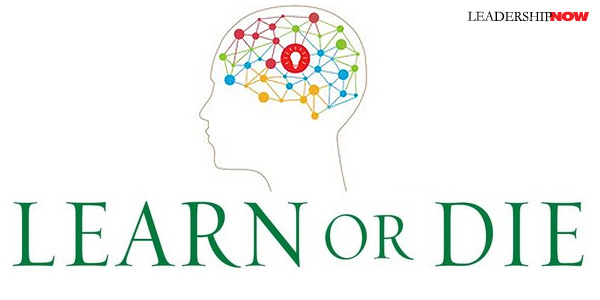
OUR ABILITY (and willingness) to learn impacts our personal and business growth, operational excellence, and our capacity to innovate. More than ever, it truly is learn or die. In Learn or Die, Ed Hess writes that learning is impacted by our “reflexive ways of thinking, the rigidity of our mental models, and the strength of our ego defense systems.” So to a large degree is means overcoming our humanness. We prefer to validate what we already know rather than looking at evidence to the contrary. By and large, that’s a function of our ego. “In many cases, learning comes from mistakes or failures or other people disagreeing with us, which that means in order to learn, we often have to admit that we are wrong.” The author admits that “To become a better learner, I had to quiet my ego.” As a result, he also became a better thinker and leader. Negative thinking is toxic to learning. “In order to maximize our learning we have to be sensitive to and manage our emotions.” As a leader, you need to be concerned about the environment of the people you lead. “The litmus test of a learning organization is being receptive to information that goes against the established way and a tolerance for failure and mistakes.” To accomplish this not only should the environment be positive, but people need to be treated with respect, dignity, and trust, mistakes should not be characterized as “personal failures but as the result of bad learning systems or too little effort,” people should also believe that they have some control over their actions, have a sense of self-efficacy and contribution. Hess writes that “The U.S. Army Special Forces believes that adaptability—learning—is predicated on self-efficacy, resiliency, open-mindedness, mastery achievement motivation, and tolerance for ambiguity and uncertainty.” Too often we sabotage our own learning by our need to be right. We need to be able to admit when we are wrong and quite frankly accept the “magnitude of our ignorance.” “Real learning, in most cases, requires us to change what we believe, and humble inquiry [open-mindedness with no predetermined or hidden agenda], helps us do that.” Because we have difficulty seeing ourselves and examining our own assumptions, “learning is a team sport.” If we want to learn, we “must engage in effective learning conversations.” Learning conversations are conversations where we feel safe in disclosing ourselves to others. They bring about a deliberate, nonjudgmental, non-defensive open-minded exchange. We learn from each other.
The culture at Bridgewater may seem extreme to some but there is no doubt that they are serious about growth and learning. As Ray sees it, achieving one’s goals is more likely to occur if one strives to be an independent thinker by learning. That, in turn, requires one to be honest about one’s strengths and weaknesses and to deal directly with one’s weaknesses by accepting them, seeking and being open to feedback and creating workarounds that mitigate one’s weaknesses. At Bridgewater, everyone knows everyone else’s strengths and weaknesses. It’s part of their company-wide feedback loop. It’s based on truth which Ray believes “is the essential foundation for producing good outcomes.” “Searching for the truth and confronting one’s personal weaknesses in a radically transparent environment builds personal relationships.” At Bridgewater they are just as concerned about how one arrives at an answer as they do the answer itself. They encourage people to be independent thinkers. A former Navy SEAL came to work at Bridgewater because he said the two cultures overlapped. “He said both organizations focus on learning, adaptation, recruiting high caliber people, and teaching them to be better thinkers and to relentlessly pursue constant improvement.” Bridgewater has created a series of tools for use in evaluating employees and for employees to manage their personal growth” the Dot Collector and Dot Connector, Issues Log and Issue Log Diagnosis Card, Pain Button and Baseball Card. With the Dot Collector allows anyone to give any other employee performance feedback. The Dot Connector is a database of feedback every employee has received from anyone. The data is grouped according to a list of seventy-seven attributes and then summarized to give each employee a picture of his or her feedback by strengths and weaknesses and by attributes. The Pain Button app is based on Ray’s formula: Pain + Reflection = Progress. “The purpose of the pain app is for one to write down and reflect on the ‘pains’ one is experiencing in order to understand what’s causing them and to deal with those causes effectively.” Ray himself is included in the process and is subject to evaluation by anyone in the company. Frankly, I have never read about an organization with such radical transparency. Hess says that in all of his research of over 100 high-performance companies over the past ten years, Bridgewater is the only business organization he has found that “has squarely faced our ‘humanness.’” Learn or Die is a book everyone who is serious about learning and growth—personally or organizationally—should read. If you thought you were serious about it, Learn or Die will take you to a whole new level with tools, case studies, and insights that will challenge your commitment to learning.

Posted by Michael McKinney at 11:28 AM
08.29.14

A Road Map for Young Adults
IT ALL BEGAN with an e-mail from his daughter, Avery, with the subject line: "Is this okay to send?" Avery had gotten her first post-college job as an assistant to the co-executive producer to a new network daytime TV talk show. She wanted to ask her new boss for a later start date so she would have more time to “tie up loose ends.” It was then her Dad, Ben Carpenter, realized that today’s young people don’t really know what is expected of them in the real world—the “big leagues.” They didn’t know how the working world actually worked. So Carpenter sat down to write The Bigs. It is advice for recent college graduates and young professionals, of course, but really for anyone working in the Bigs about the kinds of issues they will encounter. The book is not just a how-to book of bullet points, but it is filled with stories from Carpenter's own life that give the advice credibility and context. They are well worth reading to help you get your bearings. Not all of the advice is new, but it is the “uncommon sense” we all need to get along and influence the people around us in a positive way. Consider these thoughts: • It is ironic this issue tripped me up so badly because I believe my normally rigorous adherence to my Golden Rule was a major reason, from early on, I was viewed as a leader at Greenwich Capital. The lesson is … always follow the Golden Rule and never say anything negative about anybody in your company. To do otherwise is unprofessional, unnecessary, and, more often than not, will come back to haunt you. • Take responsibility for all mistakes you make, and if you are a competent and valued employee, when you do take responsibility, it will be viewed as a sign of strength, not weakness, by your co-workers. • Understand that how your boss views you will be largely a function of how your peers and subordinates see you. • Whatever qualities you look for in a spouse, please include “a happy person” at or near the top of your list. • While you are looking towards the future and the goals you hope to accomplish, you need to appreciate the blessings you have today. Just like choosing to be happy, you can choose to appreciate what you have. If I could give one gift to those I love the most, it would be for them to always appreciate what they have. • Leave your baggage at home. The insecurities and resentments from your childhood will just slow you down or, in some cases, sabotage your plans entirely. You are now a full-grown man or woman, and it is time to sand up, take responsibility, and start building the life you want to live. You may not yet have had a shock dramatic enough to make you drop your childhood baggage. However, you need to appreciate how stunningly different the real world is from your previous life as a student and seize this moment to make a fresh start. • Choosing a career you can do well, rather than doing what you want, might sound unappealing, but it isn’t. The reason is the satisfaction you get from being good at your job. From my personal experiences, as well as observing family, friends, and co-workers, I know most professionals are most happy doing what they are good at. • The most important advice I can give you about how to get a great job is to arrange for informational interviews with junior staff at a company before you have a job interview. • In any good-sized company or department, there should be no need to reinvent the wheel. Imitate the actions of the star employees and then use your creativity and talents to perform even better.

Posted by Michael McKinney at 05:39 PM
07.10.14

Relationships Matter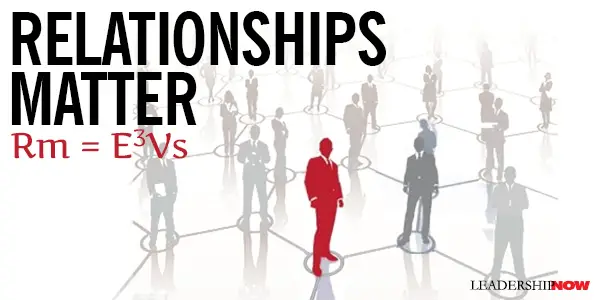
“At the center of every success,” writes Brian Church in Relationship Momentum, “you will find a pivotal relationship. Conversely, you can trace the cause of most failures to a relationship vacuum or breakdown.” Relationship Momentum is a book about how to create momentum for moving your ideas (or your career) forward. Church begins by stressing that at the foundation of any success is relationships. It explains why seemingly less skilled or talented people can blow right on by their more gifted peers. Or why an inferior idea might dominate over your “better” idea. The resulting resentment and frustration tends to turn our focus “more inward and non-relational” and any relationship momentum is diminished.“The tendency is to think that personal success and personal performance is a ‘self-thing,’ when, in fact, it is a ‘relationship thing.’” We need to be very intentional about our relationships. Whether you are stuck, stagnant or haven’t started, Church offers and explains a formula – Rm = E3Vs (Relationship Momentum equals the product of Brand, Value, and Ambassador Equities times Strategic Velocity) – for gaining traction and building momentum for your ideas throughout the book. He explains why frequent course corrections kill momentum; why we need to stop starting over; why your ideas need to be packaged in a way that is easily transferable; why your ideas need ambassadors; and why organizations that are wrapped up in creating their own reality, that is to say, convinced of their own superiority, are of little value. Some good advice on strategy and tactics: Your strategic objective is always a single direction. It is a vector that points to where you want to end up. A tack or tactic will often veer off temporarily into another direction in order to catch a prevailing wind. For instance, your goal is to provide advice for a fee to potential investors. Veering off to obtain a master’s degree in financial planning is your tack. Though it may be a longer distance to travel, that tack is nonetheless the most efficient course. 
Posted by Michael McKinney at 11:56 AM
11.18.13

What Does it Mean to Follow Your Passion?We’ve all heard that we should “follow your passion” or “find the right job and you’ll never work a day in your life.” We tend to take this advice to mean that when we get what we want, then we will find meaning and happiness. The problem with this “I-am-the-center-of-the-universe” mind-set is that we are approaching the problem in the wrong way says Todd Henry, author of Die Empty. We will ultimately spend our life chasing the next buzz when things get dull.Henry is not suggesting that we shouldn’t follow our passion, but that we should get it straight exactly what we are talking about. It doesn’t mean to follow our whims. There are two ways of looking at the world—give and get. Give is sustainable; get is not. The surest way to build a meaningful life is to approach everything you do from the standpoint of “What can I give?” The reason we struggle with following our passion is that we think of it as “What can I get?” Henry explains the issue eloquently: “Passion” has its roots in the Latin word pati, which means “to suffer or endure.” Therefore, at the root of passion is suffering. This is a far cry from the way we casually toss around the word in our day-to-day conversations. Instead of asking, “What would bring me enjoyment?” which is how many people think about following their passion, we should instead ask “What work am I willing to suffer for today?”Henry really gets to the heart of the matter. What he's talking about requires some concerted effort, vigilance, and courage to maintain this orientation as we go about our business. Otherwise it is easy to slip into the activities that only bring us comfort rather than meaning and purpose. Henry suggests sources to find what he terms “productive passion, the sort of passion that motivates you and is beneficial to others.” The focus is on “Where can I serve?” 
Posted by Michael McKinney at 11:10 PM
10.24.13

How to Discover Your WhatYour WHAT is the “single most crucial element of your life that needs to be identified, defined, and fulfilled,” says Steve Olsher in What is Your What? Here’s why:Your unfulfilled WHAT will absolutely affect you in a variety of unexpected ways. It could be the source of your high blood pressure, the reason you don’t feel “good enough,” the cause of your general sense of loathing when you wake up, or the impetus behind your efforts at self-sabotage. It should be noted here that finding your what is not a surefire way to fame and riches—or gainful employment for that matter. And while each person is unique, many others possess similar abilities and may fill a need in the marketplace better than you do. It takes work. At the same time, some people chose to work at jobs that do not fulfill or satisfy their what because it fills a purpose or a value that they consider to be greater than their own personal needs. Perhaps that is their what. That said, What is Your What? will help you get to gain control over your life rather than letting it happen haphazardly. What is Your What? is a self-awareness book to help you connect with who you really are. What you do from there is your choice. Olsher has developed a three-step process to help you uncover and reconnect with your natural strengths, identify the vehicle you’ll leverage to share your gifts with the world and the specific audiences who’ll benefit most from your gifts. “As we endure life’s hardships, we tend to lose touch with our inner greatness. We start to make distasteful compromises, settle for less, and become people different from our deepest selves.” Becoming aware of how you were knocked down is the first step in ascending to your most natural state of being. Olsher bases his program on seven principles: 1. Recognize YaNo Moments. These are those moments when you are faced with a choice. Some are big; some are small. “Any time you undertake an activity without evaluating the impact your choice will have on your life, you run the risk of compromising your state of mind. The key to regaining control of your life is to make deliberate choices with an understanding of the consequences.” 2. Reclaim the Canyon. Establish space between life as it happens and your reaction to those events. 3. The Sufficiency Theory. Attain satisfaction, peace, and contentment by minimizing material desires and the effect of outside influences. Olsher suggests that we stop drawing lines in the sand. “Happiness is not a destination that can be reached by attaining select milestones. Shift your approach from waiting for certain things to happen in order to feel a certain way to feeling and acting that way now. Surprisingly often, this will spur the results you desire to happen.” 4. Retrain Your Brain. “Anything from your past that you choose to relive becomes a part of your identity. Be careful about which memories you commit to.” 5. Incorporate Jack Welch’s successful business practices into your behavior. Specifically, become highly focused on who you are, what you stand for, and what your purpose is; identify the Top 20 Percent, Vital 70 Percent, and Bottom 10 Percent for each area of your life; achieve Six Sigma in all key aspects of your life and strive to accept nothing less than your best. 6. The Not-So-Golden Rule. Eliminate fear or expectation as a motive for your actions. Your motive does matter. Act out of love, without the expectation of anything in return. 7. The Slow Death of Not Being the Star. Shift your focus away from time-consuming distractions and toward the pursuit of your personal goals. Keep track of your activities for a week. “Chances are you’ll find that what you’ve been thinking of as relaxing ‘downtime’ is actually the dominant force in your life, devouring months and years you can never get back.” 
Posted by Michael McKinney at 09:56 PM
09.16.13

Why We Need Strangers
PART of the reason we get stuck and part of the reason we lack the feedback we need is that we are surrounded by the familiar. The familiar that continuously reminds us that we are doing the best we can and that we are doing it right. We are mired in the familiar when what we need is the strange. We need strangers. “These strangers,” writes Alan Gregerman in The Necessity of Strangers, “whom we quickly choose to ignore or form an opinion about, are the people who force us out of our comfort zones and challenge us to question the knowledge, belief, and habits we hold dear.” Gregerman asks, “What if strangers are actually, in many ways, more important than friends?” Interesting question. There are two issues here. “First, most of us just don’t have enough friends or a diverse enough set of them to give us the breadth of insight and perspectives we need to continually stretch our thinking and to grow. And second, the exact reasons why we count on friends are the same reasons that their input may not be ideal for our efforts to stretch and grow.” Maybe it’s not who you know but who you could know that will determine your success and growth. While we tend to be adverse to outsider's thinking, our real aversions, says Gregerman, “should be to see our own thinking as the only way to move forward. The real trick is to “pick the right strangers with ties to what we hope to accomplish and then ask them the right questions.” Gregerman suggests that 99% of all new ideas are based on an idea or practice that someone or something else has already had. New employees are a great source of fresh ideas, but we tend to quickly shape them into the way we do things. “They arrive filled with different ideas and fresh perspectives based on a new and different set of work and life experiences—ideas, perspectives, and experiences that might actually make us more efficient, effective, innovative, customer-focused, and successful if we were willing to listen.” If we don’t focus on the strange but instead focus on the different that we could tap into, we might grow in ways we never imagined. “Everyone matters. And that’s an idea that leaders must convey.”

Posted by Michael McKinney at 10:42 PM
07.03.13

The 5 Reality-Based Rules of the Workplace and What You Can Do About It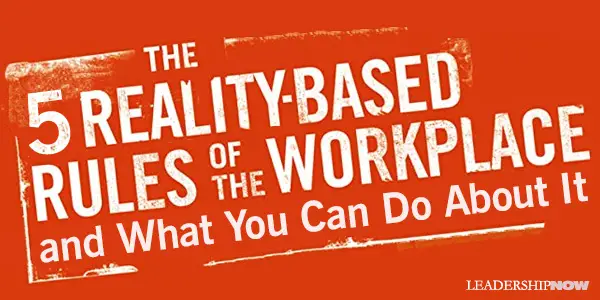
CY WAKEMAN does an excellent job of helping us to peel away the layers of rationalizations and excuses we create to avoid facing reality. First she did it with Reality-Based Leadership and now with Reality-Based Rules of the Workplace. Too often work seems harder than it should be. We can feel helpless in dealing with the realities of "today's" workplace. That said, every time period seems unparalleled in all of history to those going through it. However, people have always struggled with these issues: doing more with less; reduced hours, benefits, or pay; increased work hours; underappreciated. The problem is, as Wakeman puts it, "no one is born accountable self-reliant, self-mastered, and resilient, yet these are the qualities that count, the ones that will fill you with confidence and afford you the chance to chose your destiny, no matter what your field of endeavor." The trick is learning to see your circumstances differently.Wakeman has put this book together to help you do just that. If you have been playing the victim for a substantial period of time, her ideas will seem impossible, but they are the only thing that will work. I am here to tell you: You are not a cog in a machine — far from it. You have more control than you think. That’s the good news. The bad news is, you and you alone are causing your own suffering. What most of you have lost touch with is that it isn’t your reality that is causing your pain and frustration. It’s the worn-out methods, techniques, and mindsets with which you are approaching your reality. I’m here to tell you that your suffering is optional. I can help you get back on track so you can find bliss in your work again while becoming more valuable to your organization than ever before. She has created some pretty straightforward, brief assessments to determine your current performance and your future potential. Your value, plain and simple is based on "the value you bring to your organization, the market value of your work, and the return on investment that you deliver, both economically and emotionally, now and into the future." You must be clear about the value you bring to your organization. The three factors that make up your value: YOUR VALUE = Current Performance + Future Potential - (3 x Emotional Expensiveness) The chapter on Your Emotional Expensiveness is worth reading twice. It's your drama factor. "It is the single most important factor in the New Value Equation, the one that determines whether our Performance and Potential and anything meaningful to the bottom line, and whether others feel that working with us is worth the effort." Wakeman lists 15 clues to your emotional expensiveness factor. Among them are: You may be Emotionally Expensive if …
Wakeman presents the Five Reality-Based Rules of the Workplace: 1. Your level of accountability determines your level of happiness. Personally accountable people bring their own motivation and engagement to everything they do. Be one of those people, and you will ensure your job security—or that your résumé goes to the top of the stack. 2. Suffering is optional … so ditch the drama. (Wakeman estimates that the average person spends two hours each day in drama—complaining, creating stories, and arguing with reality.) Your circumstances are what they are, but your reaction to them is up to you. Even if you don't share your drama with others, there is no such thing as a throwaway thought. Most thoughts lead in some way to an action—or lack of action….Your thinking manifests itself in a way that affects everyone around you and the way they see you. 3. Buy-in is not optional. To succeed, your buy-in is not optional, and action, not opinion, adds value. The most valuable people say "yes" the most often. If a decision has been made, opinions are no longer welcome. 4. Say “yes” to what’s next. Your success will not be dependent on everything staying the same, but on your readiness for what's next. 5. You will always have extenuating circumstances. Succeed anyway. That which is missing from this situation is something I am not giving. When you find something missing (especially—but not limited to—intangibles, like honesty, generosity, humor, sensitivity, or gratitude) don't dwell on what other people "should" be doing or giving.

Posted by Michael McKinney at 11:22 PM
06.26.13

Seven Disciplines that Make Leadership Development Stick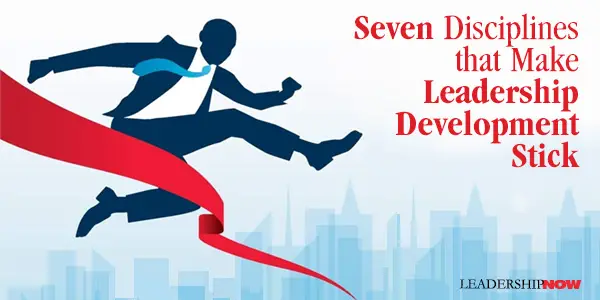
LEADERS don't always finish well or finish what they start. Leadership sustainability isn't easy. Given the fact that we all know leaders that haven't finished well, it's surprising how many of us have no plan in place to consciously and specifically improve our leadership abilities. Most of the time we wing it. Leadership sustainability is about the commitment to change and growth that is consistent with shifting requirements, not just individually but for the organization as a whole. In Leadership Sustainability, authors Dave Ulrich and Norm Smallwood have defined seven leadership practices that instill sustainability. It begins with "recognition that what matters most is the impact of the leader's actions on others—not just the actions themselves or the rationale behind them." Yet that's not something that we often feel we have time to consider. Our leadership is experienced in our actions and not our intentions. In brief, the seven disciplines to incorporate into your leadership plan to help make your best intentions stick are: Simplicity. Focus on what matters most. Tells stories with impact. Leadership sustainability requires that we find simplicity in the face of complexity and replace concept clutter with simple resolve. It entails prioritizing on the behaviors that matter most. Time. Manage your calendar to reflect your priorities. Put desired behaviors into your calendar. Employees see what leaders do more than listen to what they say. Leadership sustainability shows up in who we spend time with, what issues we spend time on, where we spend our time, and how we spend our time. Recognize routines and modify as necessary. Accountability. Take personal responsibility for doing what you say you will do and hold others accountable as well. "We see too many leadership points of view that are more rhetorical than resolve, more aspiration than action, and more hopeful than real. Leadership wish lists need to be replaced with leadership vows." Be consistent with personal values and brand. Resources. Leaders dedicate resources in order to support their desired changes with coaching and infrastructure. Use a coach. Get coaching and institutional support to become a better leader. "Leaders acting alone, even with great desire and good intentions, are unlikely to sustain their desired changes." Tracking. Move from general to specific measures. Measure what's important and not what's easy. Tie to consequences. Unless desired leadership behaviors and changes are operationalized, quantified, and tracked, they are nice to do, but not likely to be done. Melioration. Leadership sustainability requires that leaders master the principles of learning: to experiment frequently, to reflect always, to become resilient, to face failure, to not be calloused to success, and to improvise continually. Emotion. Know why you lead. Connect change with personal and organizational values. Recognize your impact on others. Celebrate success. "Some leaders work to hide their feelings and avoid becoming too personal with others. These leaders end up distancing and isolating themselves. Leaders who are emotionally vulnerable and transparent will be more likely to sustain change." The authors have provided videos, tools and assessments on their web site to help you to achieve leadership sustainability.

Posted by Michael McKinney at 11:05 PM
04.18.13

Reinventing You – Becoming the Person You Were Meant to Be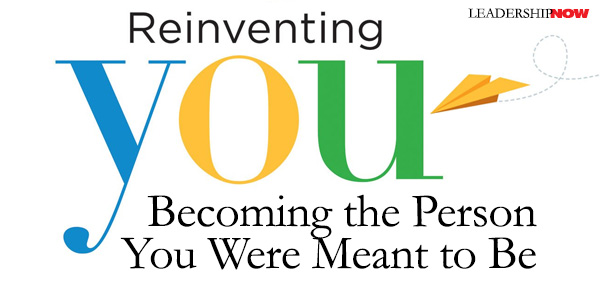
IT’S not uncommon to think of personal reinvention as being somewhat contrived or manipulative. But reinventing you isn’t about becoming what you are not, but more of who you are. In Reinventing You, Dorie Clark says “it’s about taking control of your life and living strategically. Who do you want to be? And what do you need to get there?” It’s about making sure that our personal brands reflect the reality of our lives (Facebook notwithstanding). KNOW YOURSELF Clark takes you through the whole process, beginning with, of course, starting where you are. This is a vital step and not to be glossed over because many of us don’t know where we are starting. We need you to understand our reputation and why it is what it is. She offers ways to do this, questions to ask, and how to conduct your own 360 interview—determining what those around you think about you. Very valuable material. Next you need to research your next move or future destination and test drive it. (Did you know that there is a company that allows you to test-drive over 125 new careers to see if they are a fit?) Once you have determined where you need to be, it is important to develop the skills you need. Clark explains how to do this and when to go back to school and when not to, and finding a mentor (someone who embodies what you’d like to develop and the person you’d like to become). LEVERAGE YOUR POINTS OF DIFFERENCE Rebranding yourself publicly means understanding first, what is unique about you. It may not be what you think. Often it's the mindsets and thinking that proved valuable in your current situation may differentiate you in a completely unrelated field. The examples of people that Clark provides, who have done just that, are very helpful in getting you to see your unique contribution. From that you can build your narrative that pulls together the underlying themes that connect your professional experiences in a way that is obvious to others. THE GAP There is a time lag–a gap–between fully inhabiting the “old you” and the “new you.” Clark writes that the “hardest part of making a transition can be bridging the gap between how others used to perceive you (and how you perceive yourself) and how you’d like to be seen moving forward.” She says the only solution is to fake it till you make it. I’m sure that we have all experienced this dynamic when making any personal change. When no one readily accepts the nice person you have finally become, it’s easy to give it up and resort to the old habits of behavior. The answer is to keep projecting the new behavior until you’re comfortable with it and others begin to accept it as the new “normal.” Your commitment to the new you will eventually win people over. Clark adds, “You need to be hyperaware of what you’re doing and make sure you’re signaling explicitly to the outside world what you’re trying to build.” This is where doing the homework in step one—know yourself—will help you to have the fortitude to press on. Clark explains how to get the word out and how to prove your worth. She reminds us that rebranding is a process and not a one-time activity. It is important to “keep monitoring your reputation to ensure you’re being perceived by others the way you’d like.” This is a well done and thoughtful book that is valuable not just for rebranding yourself but also for managing your reputation in general.

Posted by Michael McKinney at 04:28 PM
03.18.13

Fred 2.0 – Leadership in ActionYou are no doubt familiar with Fred, first introduced to us in The Fred Factor by Mark Sanborn. Fred exemplified an attitude of exceptional service delivered consistently with creativity and passion in a way that values other people.Now Fred 2.0 brings us fresh insights, deeper understanding and wider application of the Fred Principles—and an update on the life of the real Fred Shea. Fred 2.0 is about a specific way of approaching life and business. It’s an attitude that extends far beyond customer service. It comes from within and says I will do extraordinary things because that’s who I am. It’s not a feeling—it’s who you are. It is not dependent on the performance of anyone else. Why Would You Live this Way? Sanborn says it’s because being a Fred enriches others, expands you, puts more life into your living, breaks the bonds of self-absorption, makes you more employable, offers you a better way to live, creates a positive influence, and is more fun. “Creativity is an essential ingredient in delivering extraordinary results,” writes Sanborn. Being creative is doing something different that adds value. More often than not, it’s the little things we notice that can be done better. This applies not only to the “things” we do, but also to our relationships; how we respond and interact to those around us. Sanborn shows very specifically how to build better relationships, elevate the experience for those we come into contact with, how to build a team of Freds and how to instill the Fred approach in your kids philosophy of life. The Fred Philosophy is Good Leadership The Fred philosophy is ultimately what good leadership is all about. It’s a battle against mediocrity says Sanborn. The first job of leadership is to help people see their significance. Leaders recognize that those who feel insignificant rarely make significant contributions. An effective leader is able to show people that they are significant in ways they may not realize.The Fred philosophy means: • Leading by example • Starting with what’s right instead of what’s wrong • Encouraging people to try • Asking for and sharing good ideas • Removing barriers and obstacles • Being a champion of those around you • Giving people the freedom they need • Teaching the Fred philosophy consistently • Recognizing and rewarding • Make the process enjoyable “It’s our choice whether we’ll use our time, effort, and talents to turn ordinary work into something extraordinary.” writes Sanborn. It begins as always, with integrity. If you value it, those around you will too. Fred 2.0 will show you the thinking behind extraordinary leadership and apply it in every area of your life. “When you know what is important to you in your life and work, you should apportion your talents and efforts so you can give the best you have to those things.” Love what you do and love the people you do it with.
SPECIAL OFFER: Visit Mark Sanborn's Fred 2.0 web site now to learn more and gain instant access to a Fred 2.0 “EXTRAordinary Results” Resource Kit, free with purchase of Fred 2.0. 
Posted by Michael McKinney at 05:17 PM
02.13.13

Rebooting Work: How to Make Work— Work for You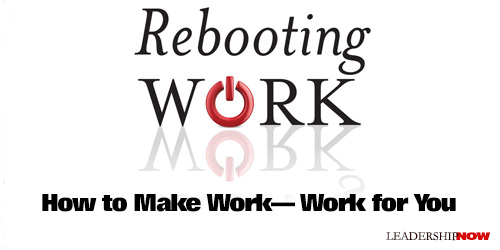
Rebooting Work by Silicon Valley legend Maynard Webb and Carlye Adler is a sensible look at the changing nature of the workplace and how you can use emerging technologies to take charge of your career. To become a CEO of your own destiny. Less than half of Americans (47 percent) are satisfied with their work. Companies are changing too. They can no longer provide the safety nets that were expected in the last century. Employees must become more self-reliant. That of course means a workplace that rewards people for their performance rather than their time in. An organization that supports entitlement over results, writes Webb, “can limit growth and opportunity.” Giving someone a leg-up is one thing, entitlement has a permanence to it that both hinders employees and harms companies and neither performs up to their maximum potential. Webb believes that technology presents us with an opportunity. It has the power to enable people to do something about their dissatisfaction with work and move on to careers that can provide both fulfillment and financial security. “Understanding and embracing today’s technological trends is the fastest way to travel to the career of your dreams.” 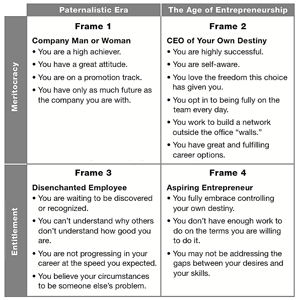 Webb presents us with four ways of looking at work. We may move from frame to frame but we tend to operate in one. They are Company Man or Woman, CEO of Your Own Destiny, Disenchanted Employee, and Aspiring Entrepreneur. Where we should all be headed, states Webb, is to the mindset of the CEO of Your Own Destiny. We are living in the age of the entrepreneur. Webb presents us with four ways of looking at work. We may move from frame to frame but we tend to operate in one. They are Company Man or Woman, CEO of Your Own Destiny, Disenchanted Employee, and Aspiring Entrepreneur. Where we should all be headed, states Webb, is to the mindset of the CEO of Your Own Destiny. We are living in the age of the entrepreneur.
Prior to the Civil War, most Americans worked in agriculture or as small merchants or tradesmen. Success was the result of self-direction, self-motivation, and self determination. In a way, everyone was self-made.Today personal and professional development is on the employee. It “requires you to be relevant every day and to be voted on to the team you want to play with.” But with this freedom come accountability. In an entrepreneurial age it is more important than ever that you think like a leader—no matter where or at what level you work. As research indicates, many people find themselves in the Disenchanted Employee frame: you are waiting to be discovered or recognized, you don’t understand why others don’t see how good you really are, your career isn’t going as expected, and you believe your circumstances are someone else’s fault. This kind of thinking is not just unproductive, it feeds on itself and keeps you just where you don’t want to be. One of the most important things you can do is to get a mentor; someone to help you see the reality of your situation and offer constructive advice to get you moving again. Webb also offers these ideas:
Of Related Interest: 
Posted by Michael McKinney at 01:55 PM
01.08.13

Antifragile or How We Become Fragile
IN Antifragile, Nassim Nicholas Taleb reports on things that are fragile and things that are antifragile and how they became that way. Taleb says antifragile isn’t resilience given his narrow definition of it. It’s more. Resilience survives. Things that are antifragile don’t just survive, they get better with random event and shocks. The opposite is fragile. Though often unintentionally, we tend to make things fragile. We have been fragilizing the economy, our health, political life, education, almost everything … by suppressing randomness and volatility. … Complex systems are weakened, even killed, when deprived of stressors. Much of our modern, structured, world has been harming us with top-down policies and contraptions which do precisely this: an insult to the anitifragility of systems. By trying to make things simple and linear we run the risk of underestimating randomness and its role in everything. And more importantly, we fail then to benefit from them. Thus while we may be resilient or robust, we are not antifragile. “You only get a measure of order and control when you embrace randomness,” says Taleb. Our character should be antifragile. Random events should serve to make you better than before. Rules are fragile. Principles are resilient. Virtue is antifragile. Classroom learning is fragile. Real-life and experiential knowledge are resilient. Real-life and a library are antifragile. Success actually makes us fragile. We need to be antifragile to survive it. “When you are fragile, you depend on things following the exact planned course, with as little deviation as possible—for deviations are more harmful than helpful.” Mistakes and successes—especially those of others—give us a lot of information. If we can learn from them, they can make us antifragile. Taleb writes: My characterization of a loser is someone who, after making a mistake, doesn’t introspect, doesn’t exploit it, feels embarrassed and defensive rather than enriched with a new piece of information, and tries to explain why he made the mistake rather than moving on. These types often consider themselves the “victims” of some large plot, a bad boss, or bad weather. Randomness is not a bad thing. We make our organizations fragile when we are overprotective; when we try to iron out all of the variations and wrinkles that are a part of life. The longer we go without randomness, without variations, without setbacks, the worse the consequences when the unpredictable occurs. “Preventing noise makes the problem worse in the long run.” Yet we still think we benefit from protecting people and organizations from volatility—from life. It’s a practice with unintended yet harmful side effects. A fact of life: “no stability without volatility.” A little confusion can lead to teachable moments, growth and stability. Antifragile is an interesting and at times entertaining read. Taleb borrows from all disciplines to explain “how to live in a world we don’t understand or, rather, how not to be afraid to work with things we patently don’t understand, and, more principally, in what manner we should work with these.” 
Posted by Michael McKinney at 10:00 PM
12.07.12

Do Leaders Really Matter?Are individual leaders truly responsible for the end result, or do they just happen to be there—for better or worse? asks Gautam Mukunda in Indispensible. To be sure, Lincoln and Churchill have mattered, but does every leader matter?Of course, every leader matters to someone. But here Mukunda is talking about leaders who matter on a larger scale—those that matter to all of us. What would have happened if someone else had filled the same role. “Leader impact can best be thought of as the marginal difference between what actually happened and what would have happened if the most likely alternative leader had come to power….Will he or she make significantly different choices than the other plausible candidates.” It gets down to how we choose our leaders and how we advance people through an organization. This process, Mukunda calls the Leader Filtration Process (LFP). A given LFP will filter candidates through a process designed to find those who conform to a specific value system—a Modal or standard leader. Occasionally an Extreme candidate will slip through. Many organizations weed out potential Extremes. The military’s promotion system is an example of a tight filtration process. At the other extreme, entrepreneurship is a very loose process—you become an entrepreneur just by deciding to do it. EXTREME LEADERS A leader that has bypassed an LFP is likely to be an Extreme. Charisma helps leaders bypass filtration. “Family connections, personal wealth, and celebrity, for example, all smooth the path to power without subjecting candidates to the risk of being Filtered out by the LFP.” Modal leaders can be highly successful under normal conditions. They are good at maintaining the status quo. I would associate management with Modal leaders. Extremes, on the other hand, are all about innovation. “Extreme leaders will be much more likely to change the goals their organization or state is pursuing and to adopt means to achieve those goals that other leaders would not—that’s why they have such marked impact compared with other Modals.” If you are stuck, an Extreme leader may be just what you need. But while Extremes deviate—and that may be a good thing—they are “far more likely than Modals to have dramatic successes and failures.” “Filtration is supposed to prevent leaders with undesirable characteristics from gaining power.” This is quite understandable. However, “many of those undesirable traits aren’t purely negative—in the right situation, they can be a huge asset.” What helps make an Extreme great is when they couple their decisions with humility. “The Extreme leader does what others would not do, even when others advise him or her against it. To make this sort of choice when the stakes are high takes enormous confidence. Sometimes, however, the Extreme’s advisers will be right. When that is true, the great Extreme leader will have the humility to defer to their judgment. It is this almost paradoxical combination of self-confidence and humility that marks the transcendentaly great leader.” Mukunda’s Leader Filtration Theory has implications as to how and when we choose certain types of leaders to lead us. He recommends that if you are a Filtered leader that you bring a few Extremes into your inner circle. 
Posted by Michael McKinney at 05:11 PM
11.05.12

Next Time You’re in a Slump, Try Stillpower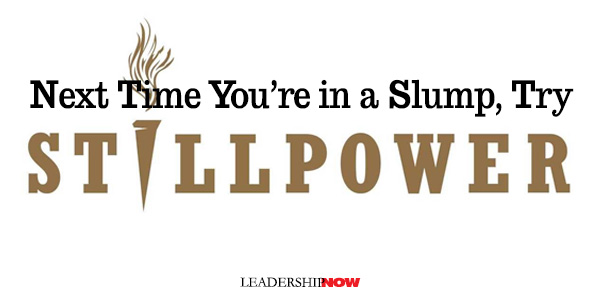 WHEN our performance is in a slump or we get stuck, we tend to become anxious and reach for any quick fix or technique that promises to get us out of it. We apply more effort, focus, and willpower. And when all of that doesn’t work, we get even more anxious and our performance heads even further south.
WHEN our performance is in a slump or we get stuck, we tend to become anxious and reach for any quick fix or technique that promises to get us out of it. We apply more effort, focus, and willpower. And when all of that doesn’t work, we get even more anxious and our performance heads even further south.
Instead, when we get stuck we need to rely on Stillpower, not willpower says Garret Kramer. Stillpower is the ability to return to a clear mindset after we get into a muddled mental state—a low state of mind. It’s knowing that “all sentiments are temporary since they originate from your own thoughts and moods. Stillpower comes from knowing that self-worth has nothing to do with winning, losing, parental approval, money, fame, or anything external to you.” When we get into a low state of mind we need to do nothing. It’s when we operate from a low state of mind that we usually make mistakes, poor judgments, miss opportunities and dig ourselves deeper into whatever hole we are digging. “Once you understand,” says Kramer, “that as human beings we form our perceptions from the inside out, that the quality of our thinking and level of awareness move up and down independent of our circumstances, you will see that it makes little sense to work yourself through a temporarily low state of mind.” But that’s often exactly what we do. When we run into trouble that’s a sign to step back—not a call to action. Negativity is a sign to slow down. We can't perform at an elevated level when we are in a low state of mind. A seemingly unresolved issue of today has nothing to do with erroneous thinking of today. And until an individual comes to this realization, he or she will always fall prey to the conditions of life itself. Awareness is key. When you are aware of your thoughts and feelings in the moment and when necessary, allow your thinking to clear, then you will have the clarity to act; “insights will flow and answers will become obvious.” He adds, “Insight is infinitely more powerful than willpower. Actually, insight, or having a new idea and/or a change of heart, erases the need for strength or force of will of any kind.” COACHING Kramer notes that when you are coaching or counseling, you need to be operating from a higher level of thinking than the person you are talking to. “What comes out of your mouth is much less significant than the level of mental functioning from which the words are spoken.” We need to interact with people from a state of mind “brimming with love, compassion, and selflessness….External how-to resources are not all that necessary; love will provide all the direction you seek.” Leadership is an all-in proposition. Done right, it’s a lot of hard work. To cut ourselves some slack, we too often rely on external gimmicks and techniques rather than the messy work of a real relationship. IDEAS TO CONSIDER • “We perform better when we get caught up in the experience, rather than when we make the experience about us….When we focus on a personal prize, our options narrow; when we relish the process, our options expand.” • “When we act from clarity, it is impossible to get weighed down by judgmental outcomes.” • “When we succumb to our errant thoughts or closed-off moods, judge another person, and then act from this egotistical perspective of insecurity, it is practically impossible to find long-term success.” • “Every failure, every mistake, every loss—occurs to clarify our path, not to obscure it.” • “You will never wrestle with a choice when your level of consciousness is high.” Leaders will find a lot to consider here. Stillpower is one of those books that makes you reconsider your approach on many things. While Kramer might seem to be throwing the baby out with the bathwater at times, he doesn’t overturn conventional wisdom as much as he calls us on it when we misapply it. It is the perfect prescription for those that have a need to control their world and the people around them. It is important to note too, that looking within for answers is fine if you have consciously put something there to draw-on in the first place. Good flashes of insight are only produced when there is something good to draw upon. Choose your sources wisely. 
Posted by Michael McKinney at 03:57 PM
10.19.12

Leading Apple With Steve Jobs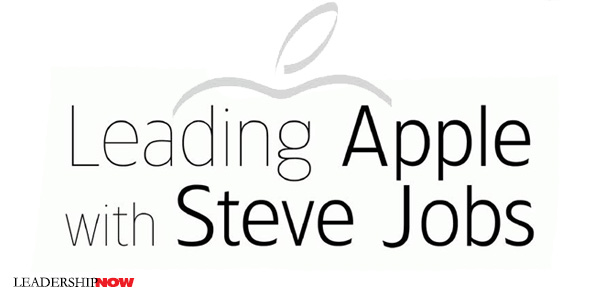
JAY ELLIOT, former Senior Vice President of Apple, has spent a lot of time with Steve Jobs. In Leading Apple with Steve Jobs, he writes that “Isaacson’s Steve is not the Steve I knew.” He believes that there has been too much focus on the negative aspects of how Jobs dealt with people and not enough on the positive. “I think,” he writes, “most people who worked for him, including me, would say they did the best work of their lives for him and don’t regret the experience a bit.” While his stories regarding his time with Jobs don’t do much to polish his image, he does bring out aspects of his thinking that undoubtedly have given people the opportunity to feel that in spite of the negative aspects of Jobs' behavior, Apple is where they wanted to be. When analyzing anything, it always a challenge to pull out the important lesson and learn how to integrate the good without the bad. We are all a complex mix of motivations and behaviors and everything we do seems like an indispensable part of achieving our success (or not). But we can always improve—diminish the negative and emphasize the positive. It is not unusual for any of us to find ourselves in a position where our intention is admirable but we lack the skill to implement it in the most beneficial way. Frequently, we can find ourselves stuck without alternatives to our own patterns of behavior. As leaders, we have to constantly be learning—by reflection and reading about the lives of others—to discover where we could expand our thinking and therefore our options. Not only does Elliot help us understand why Jobs was the way he was, he does a good job of explaining the development of and reasoning behind much of the Apple mystic that is worth implementing. Jobs said that “It’s not my job to pull things together from different parts of the company and clear the ways to get resources for the key projects. It’s my job to push the team and make them even better, coming up with more aggressive visions of how it could be.” Jobs believed that accountability, attention to detail, perfectionism, simplicity, and secrecy, would sustain innovative leadership at Apple. Getting the right people was as important to Jobs as creating a new product. “When you’re in a startup, the first ten people will determine whether the company succeeds or not.” Elliot says that he learned from Jobs the value of “knowing your own values so well that you can instinctively recognize someone who shares those values.” It would be good to reflect on our own values from this standpoint. Another way of thinking about this would be to consider: if you don’t know why you do what you do, why would anyone want to follow you? The right people make the difference. “A leader in the Steve Jobs model needs to have a set of lieutenants who can translate his goals and vision into detailed action plans. The success of Apple through the years has largely been due to Steve’s talent for surrounding himself with people who could bear the heat when he wasn’t satisfied, were strong enough to stand up to him when he was wrong, and were able to relay not just his instructions but his commitment, drive, and vision to the crew.” 
Posted by Michael McKinney at 02:54 PM
09.10.12

Help Them Grow or Watch Them Go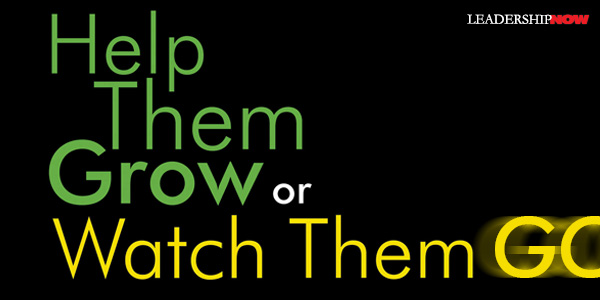
FINDING good employees is not enough. Organizations must have a plan in place to keep the employees they have. A priority for many employees today is career development opportunities. The problem is very few managers and leaders feel they have the time to work on career development. Yet career development, say Beverly Kaye and Julie Winkle Giulioni in Help Them Grow or Watch Them Go, is nothing more than helping people grow. And that’s job one for leaders. Kaye and Giulioni contend that it is not as hard as we usually make it out to be. “Quality career development boils down to quality conversations”—frequent, short conversations that occur within the natural flow of work. They suggest that we “reframe career development in such a way that responsibility rests squarely with the employee and that our role is more about prompting, guiding, reflecting, exploring ideas, activating enthusiasm, and driving action.” Their framework for career development is organized around three types of conversations: Hindsight conversations. These conversations are meant to help develop self-awareness—where they have been and what they are good at. This is even more apparent with by good feedback. “Helping people look back and inward also provides a reservoir of information that allows employees to move forward and toward their career goals in intentional ways that will produce satisfying results.” Foresight conversations. What an employee learns about themselves in hindsight needs to be applied in the context of what is going on around them. “When you help your employees develop the ability to scan the environment, anticipate trends, and spot opportunities, you provide a constructive context for career development.” Insight conversations. These conversations leverage what your employee learns from the convergence of the insight and foresight conversations. Here you guide them into practical steps they can take to be where they want to be. “Onward and upward has been replaced by forward and toward.” Today, it’s not about moving up the ladder but moving to the place you want to be. Kaye and Giulioni suggest that we learn to help them grow in place. This requires a shift in thinking. “The challenge of growing in place involves stripping titles from our thinking and instead focusing on what the employee needs to experience, know, learn, and be able to do.” Too frequently, we limit the scope of career conversations, thinking they’re only about jobs, promotions, or stretch assignments—the actions employees can take to move forward. Important? Yes. But that’s just a drop in the bucket of conversations you can have with employees. We have conversations about the work anyway, so why not make it a teachable moment? “A few minutes of conversation can help others slow down enough to reflect, bring deep insights to the surface, verbalize important messages, and consider how to leverage their expanding skills and knowledge base.” If you don’t think you have the time to incorporate this vital task in what you do, this book is for you. Kaye and Giulioni offer templates, guidelines, and sample conversations and questions that you can adapt to your own situation. With their approach, career development stays fresh because each employee’s career plan is unique and done in real-time.

Posted by Michael McKinney at 10:31 PM
08.14.12

Triple Crown Leadership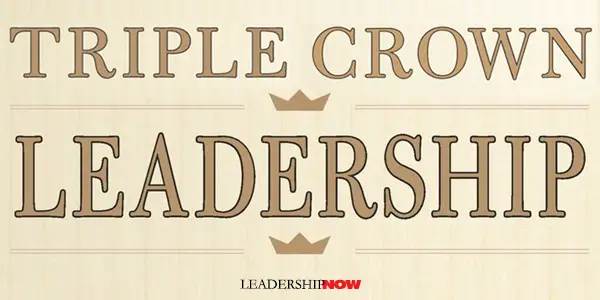
WITH far too much failed leadership on display, leaders should commit to building a different brand of leadership—Triple Crown Leadership, say authors Bob and Gregg Vanourek. Triple Crown leaders have the goal of building and sustaining organizations that are excellent (high performance), ethical (do the right thing), and enduring (stand the test of time). As with the Triple Crown in thoroughbred horseracing, it is an epic quest that is audacious but not impossible. Triple Crown leaders integrate five practices that build excellent, ethical, and enduring organizations: Seek “head and heart.” The first step is putting together a triple crown team. Typically we look for people with the right “head” skills (experience, education, expertise), but they must have the intangible “heart” qualities (character, integrity, courage). Post “colors.” An organization’s “colors” are its purpose, values, and vision. Leaders must engage all in developing the colors through a collaborative process, thereby increasing ownership and buy-in. People are free to act as long as they do so in accordance with the colors. Flex between “steel and velvet.” Triple Crown leaders cannot remain stuck in their normal style of leadership. They lead by flexing between the hard and soft edges of leadership, sometimes in command, other times willingly soliciting and following the leadership of others. If your actions are consistent with the colors—purpose, values, and vision—you will not appear inconsistent in your approach. Unleash “stewards.” Stewardship is everyone’s responsibility. It’s not empowerment handed down from the top but a culture where the freedom to act is expected as long as they act in accordance with the shared values and vision of the organization. It’s automatic. “Triple Crown leadership ebbs and flows dynamically from person to person—up, down, and around—depending on the person’s knowledge, skills, passion, and the nature and urgency of the challenge at hand.” (Look on pages 114 to 123 for lists of specific ideas on how boards, CEOs, managers, and people without authority can become Triple Crown stewards.) “Align.” Alignment builds trust. Alignment speeds up the process. Alignment should be collaborative, start where you are and cascade, and be flexible. It requires some finesse to get people on the same page while protecting the innovative mavericks and creating the conditions for operating in a state of flow. There is a big difference between completing an alignment exercise at a one-shot retreat and actually creating an aligned organization, between having a purpose statement and being purpose-driven, between having values and upholding them when the pressure is on, between saying you are vying for the triple crown and actually aligning the enterprise to achieve it. The five triple crown leadership practices are related and mutually reinforcing. Building excellent, ethical, and enduring organizations requires a commitment from many people over many years, and the view that leaders exist at all levels. 
Posted by Michael McKinney at 10:31 PM
07.27.12

The Titleless LeaderLeading without a title is about taking personal responsibility. We—the world—is in desperate need of people who will choose to lead whenever and wherever they can. In The Titleless Leader, Nan Russell describes where we are:Everything isn’t alright in our workplaces. People are frustrated, angry, disillusioned, tired, and afraid. Not to mention skeptical, cynical, and distrustful. And those plaques touting people as the most important asset should be taken down. They’re a hypocritical reminder of last century’s failed promise. Not everywhere, of course, but in far too many organizations.But we have a choice. We can continue the de-motivating spiral of self-indulgent, unaligned leaders, or we can decide to create tomorrow’s workplaces through a new kind of leadership. It’s the kind that doesn’t come with a title. It’s not determined by rank, responsibilities, or position. No one needs to appoint you, promote you, or nominate you. You decide.What Russell is talking about here is a different kind of leadership that starts with what all good leadership begins with: self-discipline. It is taking responsibility for the outcomes in your area. It’s setting an example of behaviors that are aligned with values. For Russell, titleless leadership is based on four cornerstones: Self-Alignment: Behavioral integrity. People remember what you are. Possibility Seeds: Encourages and nurtures others. Titleless leaders plant possibility seeds “not because there’s a mentoring- or succession-planning program, but because they’re operating with a better together approach.” Soul Courage: Step-up and offer your best self. Push outside your comfort zone to do the right thing. and Winning Philosophies: It’s only when we’re all winning that we truly all win. Focus on group wins and not the politics of individual wins. The Titleless Leader is a handbook of behaviors and thinking to help you lead from where you are. Certainly, they’re not easy and require some change in perspective, but they will create more meaning and value in your workplace and more importantly, in your life. 
Posted by Michael McKinney at 06:58 PM
07.25.12

If It's Important, Be There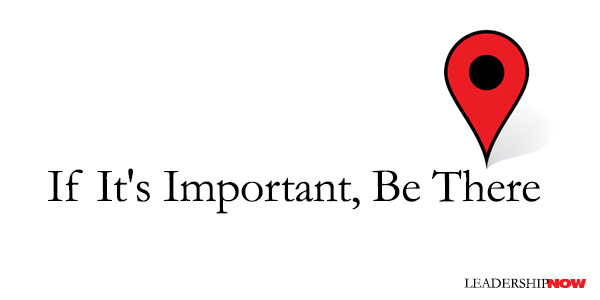
IN Contented Cows Still Give Better Milk, authors Bill Catlette and Richard Hadden make the point that organizations with contented employees understand that one of the most fundamental precepts in the whole workplace arena is that “the person who started for them this morning is as close to a ‘model employee’ as they’re ever going to get.” So the best companies do something about it. They are fanatical about training people not only with skills they need, but they also carefully train them in the organization’s traditions, values, and philosophies. But this is the part (too) many leaders just don’t get: “People want to know that the training course they’re taking the time to sit through is as important to senior management as it is supposed to be to them.” How do you communicate that? “This often requires senior management to ride along with them—not in their own condensed mini-versions, but alongside everyone else.” Catlette and Hadden go on to say, “There should be no executive parking spaces when it comes to training. Managers must participate enthusiastically and, more important, be able to demonstrate the skills they expect everyone else to learn.” The message is clear. If it’s important to you, it will be important to them. It’s quite common to hear, “If this is so important, where are they?” Without the visible support of the leadership, commitment to the training is compromised. Leaders need to visibly communicate: “This is important—so important that I went through it before you did. I’m using it, and now I want and expect you to do the same. That’s why I’m here." 
Posted by Michael McKinney at 11:49 PM
07.18.12

How to Turn Your Team Around in Six Stages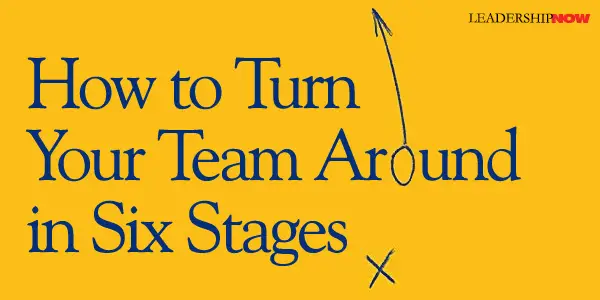
HOW DO YOU transform a losing climate into one that fosters collaboration, innovation, and productivity? Losing is not necessary or permanent, but to turn it around you need a leader who can see the truth, identify where things that have gone wrong, and broadcast the reality of possible in spite of what’s actually happening. A turnaround is really a change in culture—changing the culture of the team or organization.In Team Turnarounds, authors Joe Frontiera and Daniel Leidl present a six-stage Team Turnaround Process. While many of the examples are from sport franchises—Colts, Eagles, Steelers—and the people they interviewed there, they also include turnaround stories of Domino’s pizza, Spider-Man: Turn off the Dark Broadway show, and the state of Michigan. Each stage contains specific developmental milestones—principles that leaders and their teams typically master before proceeding to the next stage: Stage I: Leading Past Losing
The funny thing about truth is that people often want to embrace it. They may not want to hear it, but once it’s spoken, everyone’s shoulders drop in relief. Finally, someone has noticed that the organization has been skating by. Finally, someone is willing to confront the ugly reality. Finally, someone is putting the success of the group above everything else. What most often holds us back are the excuses we hold on to. Stage II: Committing to Growth
Stage III: Changing Behaviors
Stage IV: Embracing Adversity
Challenges are moments of growth—times for you to refine yourself, make yourself better, and believe with even more confidence that you’re on the right path. The resilience and the willingness to take on adversity that come with stage IV will prepare your team for the even larger challenges presented in stage V. Stage V: Achieving Success
We think of life, our efforts, our aspirations, as something like a movie, as if we work toward the one big goal, give everything we have to a single crowning achievement, and when it’s complete, the credits roll. We become so fixated on the effort to achieve that we sometimes lose sight of what we’re doing and how it relates to the bigger picture. We sometimes forget that there aren’t any credits, and that there’s no stop to the action after we hold up the trophy. Life keeps rolling even after our big wins. Stage VI: Nurturing a Culture of Excellence
When teams win, they can become complacent. Success feels good and builds confidence, but it can also breed sloppy habits, overconfidence, and eventual performance decline. The book concludes with the Team Turnaround Workbook. The exercises for each stage will help you and your team work through the Team Turnaround Process.

Posted by Michael McKinney at 11:10 PM
06.25.12

Leadocracy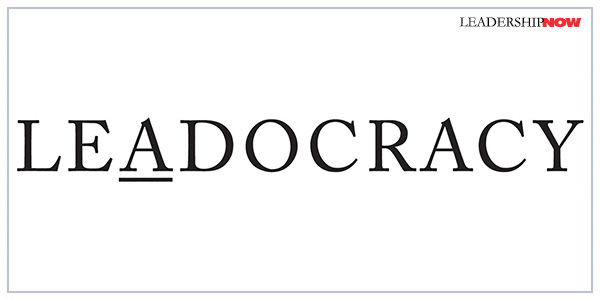
RECENT POLLS reveal that most of us – 88% – think that government is broken. We lack confidence in the people who run for or serve in office. Geoff Smart says we have a who problem. In Leadocracy he writes that the only way to fix the what problems—the deficit, unemployment, and insufficient social services to name a few—is to get the right who into government. Smart finds that there is a huge untapped source of potential leaders in the private sector—if they would just step up. But they don’t—in droves—because of fear. Fear of not being able to make a difference, fear of the financial and psychological costs, and fear of public scrutiny. But they should for three reasons, says Smart. First, a leadership role in government is a new challenge and an opportunity to grow your leadership skills. Second, because you can make a difference, that is enormously satisfying. And third, in government, you interact with an amazing range of people—you build relationships, help them in ways only you can, and become part of a broader community that is making people’s lives better. Smart founded The Leaders Initiative with the goal of having 1500 private sector leaders complete a two-year stint in government (local, state, or federal) by 2030. The hope is that it will have a positive multiplier effect on encouraging more private sector leaders to consider “government leadership” in their career plan. Smart states, “Democracy works best when voters choose great candidates.” It seems like a simple statement, but it explains a lot. He says we are not very good at it. He does offer some tools and tips for determining how qualified a candidate is for the task at hand, and ensuring you are “hiring” the best leader for the job. He hopes we can reverse our tendency to: • place too much emphasis on likeability
I would agree with Smart. However, I would add that government isn’t broken because, in most cases, its leaders lack ideas, are bad people, bad leaders, stupid, incompetent, or just a bunch of amateurs. It’s broken because they are in a system that rewards them for pandering to their constituents. It’s how many of them keep their jobs. It would be a mistake to think that somehow government got all of the bad leaders and the private sector is hoarding them—and if we could flip-flop the situation, the problem would be solved. It’s a systemic problem. We see leaders in government that should know better, giving people what they want not because it is the best option for their constituents but because they want the votes to keep them in office. They effectively stop leading. We do have a who problem. But realistically it is not just a matter of getting the “good people” in. It will take a tremendous amount of fortitude for anyone wishing to serve in government to take the time to educate instead of pander, to do the hard things rather than the expedient, to lead rather than follow, to stand on character instead of popularity. But then, we would probably vote them out. So the issue is something we have to remedy within ourselves too. It’s also an issue the Founding Fathers didn’t think we should take lightly. 
Posted by Michael McKinney at 12:11 AM
05.23.12

InsideOut Enneagram
THE Enneagram is a method for identifying your personality type and is a valuable system for learning about yourself and others. The Enneagram system defines nine basic personality types of human nature and their complex interrelationships. Wendy Appel has tackled the Enneagram’s subtleties and complexities in InsideOut Enneagram. Her book makes practical the Enneagram system by use of clear explanations of each Type, case studies, and a structured journaling process. There is a section on Type and team interactions that examines predictable points of tension, reactive patterns, and synergies between all of the possible Enneagram Type pairs. Her goal is to help you to see and think differently about your strengths, your weaknesses, and mostly the subterranean habits of mind and motivations that drive you and others. It’s a journey of self-mastery. Appel observes that “most of us focus our attention outward and neglect our inner life. We think that change is out there. Instead of tuning in to the language of our head, heart, and gut, we are busy looking outside, ahead, and down.” Understanding who we are, uncovering our blind spots, and creating a game plan to master our thinking and behavior, is vital to developing our leadership potential and to better understand those we lead. The subconscious mind, where our habits, patterns, and beliefs reside, directs the course of our lives, and most of us are unaware that this is happening. To transform as leaders and to transform our organizations require that we examine our core beliefs—both individual and collective. If not, we simply make iterative changes, and that won’t be enough to succeed in today’s globalized economy. Appel says she often gets asked “about the difference between the MBTI and the Enneagram, or whether MBTI Type preferences neatly fit into the Enneagram Types. The most simplistic way to understand how the systems complement each other is that the MBTI describes preferences for how we do things (get our energy, make decisions, gather information, and so on); the Enneagram describes why and how we behave as we do (beliefs, fears, desires, focus of attention), and how we go about getting our perceived needs met.” InsideOut Enneagram is an opportunity to discover what is working for you, what is not working for you, why, and what you can do about it. You will find descriptions of each type on her website. 
Posted by Michael McKinney at 07:08 PM
04.25.12

When Good Employees Do Bad: Six Surprising Behaviors that May Precede a Scandal Good intentions can lead to bad outcomes in business. This is especially true in organizations that have toxic cultures in which leaders tout worthy values—and then put up roadblocks that prevent employees from living those values. For example, if a company claims it welcomes innovation and risk taking, but then only rewards employees who toe the company line and reinforce the status quo, sooner or later people will simply stop asking questions, innovating, and stretching themselves. Instead, they will conform in order to please their bosses. While the company's competitive edge plummets, leaders may be left wondering: What happened to our core value of innovation and risk taking? When we look at companies that have faced scandals such as recalls, ethical violations, or crimes, the problem often comes down to employees whose surprisingly positive behavior was distorted by a toxic culture and clueless leaders. Here are six seemingly benign behaviors that may come back to bite a company if they become exaggerated and throw the organization out of alignment: Commitment to meeting deadlines. One would think that a company where employees are encouraged to meet deadlines and rewarded for doing so consistently would lead to super-productivity and efficiency. In fact, it can lead to disaster. At Johnson & Johnson, the understood directive to get product to market on tough deadlines created a culture of "Don't ask too many questions" and resulted in a series of dangerous drug recalls that badly sullied the company's reputation. Excessive optimism. When a person is sick, optimism can buoy his spirits and help healing. When a company is unhealthy, "Everything is going to be okay" is not what you need to hear from those in authority positions. Take David Myers, former controller of WorldCom. By his own account, he saw the problems of the now-defunct company through rose-colored glasses. He simply kept believing--and telling his frightened staff--that the problems would resolve themselves eventually. By the time he came to his senses, he was under arrest for accounting fraud. Staying focused on a goal. Telling employees to keep their eye on the prize is not intrinsically a bad thing. But when the goal becomes more important to management than the underlying values of the organization, it can lead to a dysfunctional culture. For example, in the 1990s, Sears gave its auto repair mechanics a mandatory sales goal of $147 per hour. It wasn't long before customers began to be overcharged or sold unnecessary repairs. Having a competitive mindset. Boeing is known for its highly competitive employees and work culture. That's a good thing, right? Not so in 1996, when the company lost billions in government contracts for ethics violations after an employee stole 25,000 pages of proprietary documents from Lockheed. Flash forward to 2005, when employees were still so competitive that their own work teams were known to keep useful information secret from other teams in the company to make sure they stayed on top. Too much competition can erode cultural values, leading to disaster. Sticking to a budget. Most managers would be thrilled if their employees were doggedly determined to stay on budget and not cost the company any unnecessary money. But a good intention can go bad when financial performance becomes the only metric that matters. That was the case, many believe, behind the fatal mistake made on the BP oil platform in the Gulf. Before the explosion in April 2012 caused by a safety shortcut, BP's Macondo project was more than $40 million over budget. You know the rest. Wanting to please higher-ups. What's more attractive than a hardworking employee who wants his bosses to approve of him, based on high performance and outstanding results? A lot, in the case of French trader Jérôme Kerviel at the Société Générale banking group. His need to be liked led to $4.9 billion in massive financial fraud by means of elaborate computer manipulations. Kerviel is thought not to have profited personally from his crimes. He said he was just working to increase the bank's profits and make his bosses happy. David Gebler is a sought-after speaker and panelist, and author of The 3 Power Values: How Commitment, Integrity, and Transparency Clear the Roadblocks to Performance (Jossey-Bass, 2012). He is founder and president of the Skout Group, which helps companies determine whether and how their organization's culture is costing them money, and what they can do to reduce risk and increase performance.
Posted by Michael McKinney at 02:57 PM
04.20.12

Restoring Your Ability to Choose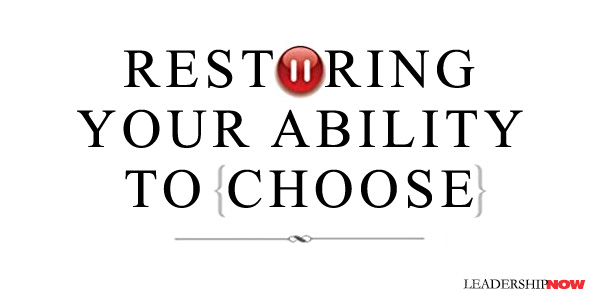
WE all like to think we are in charge of our choices. But the fact is that most of the time we are reacting, not choosing. Most of what we label choice is habit. We’re really on automatic. It can even lead us to think that we have no choice. Only when we pause—slow-down to think and reflect—are we exercising our ability to choose. Nance Guilmartin writes in The Power of Pause that a pause is “any space between an action and your reaction.” And it’s vitally important:Today you need the ability to discern what lies beneath people’s words, their reactions, or their silence. If you don’t build the neuropathways in your brain to pause, to momentarily disengage your automatic reactions, you can trigger a chain reaction that derails your best intentions and strategies. Guilmartin lists seven cues that a pause is in your best interest. It’s time to pause if you are thinking, feeling, or saying:
The Power of Pause Method is based on a three-step Effectiveness Equation and twelve Power of Pause practices. The equation: Professional Effectiveness and Personal Fulfillment Not surprisingly, the equation references an all-important addend, humility. Humility should fuel your curiosity and drive the need to pause. Guilmartin explains that “in situations where you think you know enough, pausing to wonder what you don’t know is a vital, even game-changing leadership skill.” The twelve practices are:

Posted by Michael McKinney at 04:36 PM
04.09.12

All In: It’s Culture that Drives Results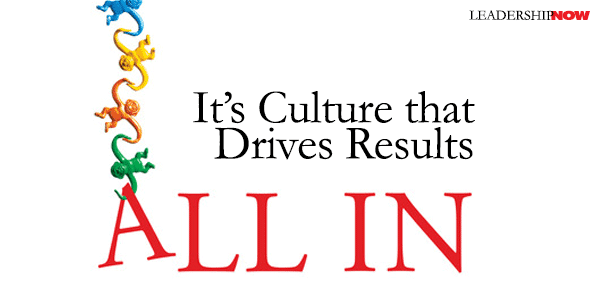
IN THE New York Times, Stephen I. Sadove, chairman and chief executive of Saks Inc., explains that it is culture that drives results: It starts with leadership at the top, which drives a culture. Culture drives innovation and whatever else you’re trying to drive within a company — innovation, execution, whatever it’s going to be. And that then drives results. While we know that our most important resource is our people, it’s not so easy to get people “all in”—convincing people to “truly buy into their ideas and the strategy they’ve put forward, to give that extra push that leads to outstanding results.” All In by Adrian Gostick and Chester Elton explains why some managers are able to get their employees to commit wholeheartedly to their culture and give that extra push that leads to outstanding results and how managers at any level, can build and sustain a profitable, vibrant work-group culture of their own. All In takes the principles found in their previous books—The Orange Revolution and The Carrot Principle—and expands on them and places them in a wider context.They begin by explaining that it all rests on the “belief factor.” People want to believe, but given the fact that “failure could cost them their future security why shouldn’t they be at least a little dubious about your initiatives?” But belief is key. “As leaders we must first allow people on our teams to feel like valuable individuals, respecting their views and opening up to their ideas and inputs, even while sharing a better way forward. It’s a balancing act that requires some wisdom.” To have a culture of belief employees must feel not only engaged, but enabled and energized. What’s more, “each element of E+E+E can be held hostage by an imbalance in the other two.” The authors have created a 7 step guide to develop a culture where people buy-in: Define your burning platform. “Your ability to identify and define the key “burning” issue you face and separate it from the routine challenges of the day is the first step in galvanizing your employees to believe in you and in your vision and strategy.” Create a customer focus. “Your organization must evolve into one that not only rewards employees who spot customer trends or problems, but one that finds such challenges invigorating, one that empowers people at all levels to respond with alacrity and creativity.” Develop agility. “Employees are more insistent than ever that their managers see into the future and do a decent job of addressing the coming challenges and capitalizing on new opportunities.” Share everything. “When we aren’t sure what’s happening around us, we become distrustful….In a dark work environment, where information is withheld or not communicated properly, employees tend to suspect the worst and rumors take the place of facts. It is openness that drives out the gray and helps employees regain trust in culture.” Partner with your talent. “Your people have more energy and creativity to give. There are employees now in your organization walking around with brilliant ideas in their pocket. Some will never share them because they don’t have the platform to launch those ideas on their own. Most, however, will never reveal them because they don’t feel like a partner in the organization.” Root for each other. “Our research shows incontrovertible evidence that employees respond best when they are recognized for things they are good at and for those actions where they had to stretch. It is this reinforcement that makes people want to grow to their full shape and stature.” Establish clear accountability. “To grow a great culture, you need to cultivate a place where people have to do more than show up and fog a mirror; they have to fulfill promises—not only collectively but individually.” And this has to be a positive idea. Gostick and Elton explain that the “modern leader provides the why, keeps an ear close to those they serve, is agile and open, treats their people with deference, and creates a place where every step forward is noted and applauded.” The authors skillfully examine high-performing cultures and present the elements that produce them. A leader at any level can implement these ideas to drive results. A great learning tool.

Posted by Michael McKinney at 11:46 PM
03.30.12

The Power of Habit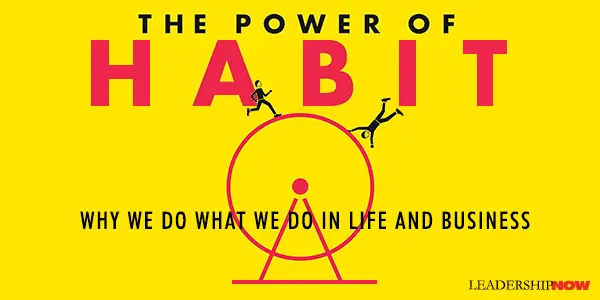
HABITS will always be with us. Some good. Some bad. But how do you replace bad habits with good habits? More importantly, how often do we ask ourselves if what we are doing is really just a habit? We are less intentional than we think we are. Charles Duhigg has written a book for all of us: The Power of Habit. After reading it you will understand how habits are formed and what you can do about it. You will also look at habits in a new way. Habits infiltrate our organizations and become invisible forces to contend with that we never realized were there. Learning to spot them is key to our success. Consider the following story:As a newspaper reporter in Baghdad, Duhigg heard about an officer conducting an impromptu habit modification program in Kufa, a small city ninety miles south of the capital. He was an army major who had analyzed videotapes of recent riots and had identified a pattern: Violence was usually preceded by a crowd of Iraqis gathering in a plaza or other open space and, over the course of several hours, growing in size. Food vendors would show up, as well as spectators. Then, someone would throw a rock or bottle, and all hell would break loose. In a sense, a community—your organization—is a giant collection of habits. Later, when Duhigg talked to the major, he said, “Understanding habits is the most important thing I’ve learned in the army.” “Once you see everything as a bunch of habits,” says Duhigg, “it’s like someone gave you a flashlight and a crowbar and you can get to work.”
The key to remember here, says Duhigg, is that “When a habit emerges, the brain stops fully participating in decision making. It stops working so hard or diverts focus to other tasks. So unless you deliberately fight a habit—unless you find new routines—the pattern will unfold automatically.” Breaking habits down in this way makes them easier to deal with. If we can learn to identify the cues and rewards, we can change the routines. We can live life a bit more intentionally. Duhigg shows how habits played a part in the success of Olympic swimmer Michael Phelps, Starbucks CEO Howard Schultz, and civil-rights hero Martin Luther King, Jr. He goes behind the scenes at Procter & Gamble, Target superstores, Rick Warren’s Saddleback Church, and NFL locker rooms. He explains how improving a single habit rippled out to improve an entire organization—Alcoa. Fascinating material to think about on many levels. How much of what you do is on autopilot? How much of what your organization does is on autopilot? 
Posted by Michael McKinney at 07:08 PM
03.09.12

Hiring for Attitude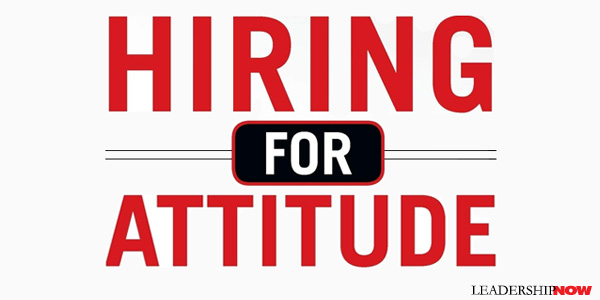
“Most new hires do not fail on the job due to lack of skill,” says Mark Murphy. Attitude is a bigger issue than skill. Consequently, most of our approaches to selecting the right people for the job are dead wrong. In Hiring for Attitude, Murphy lists the top five reasons why new hires failed:
What attitudes work in one culture may not work in another. Attitudes are culture specific. So you first need to discover your organization’s unique attitudes. Think about the “attitudes that separate your high performers from your middle performers and your low performers from everybody else. You’re not trying to create a laundry list of attitudes but just the—three to seven—“important critical predictors of employee success or failure for your organization.” Murphy talks about the kinds of common questions you should never ask—the “tell me about yourself” questions, the behavioral “tell me about a time when” questions, the hypothetical “what would you do if” questions, and the oddball “if you could be any superhero” questions—and how to create the questions and evaluate the answers that differentiate people by the attitudes that are the most important to success in your organization. A benefit of determining the attitudes that work best in your organization is that you can begin to clearly communicate those attitudes to your current employees and develop high performers throughout the whole organization.   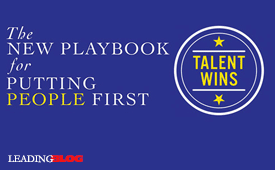
Posted by Michael McKinney at 04:42 PM
02.10.12

Grow: Taking Your Purpose to the Next Level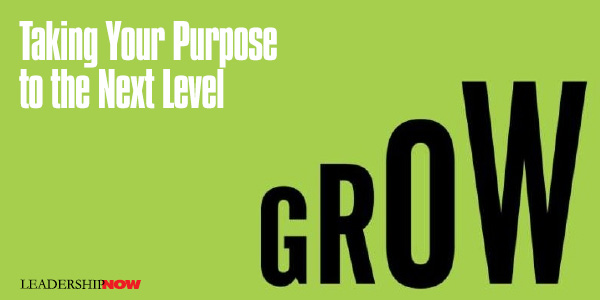
Jim Stengel, former global marketing officer for Procter & Gamble, believes that businesses must rethink their purpose to achieve far better results. But not just the most apparent purpose, but a higher-order ideal or purpose. For example, Johnnie Walker exists to make great whiskey, but its higher-order ideal is to celebrate journeys of progress and success. Starbucks must make great coffee, but it must do more if it is to attract people and innovate in ways that make life better for the people they serve both inside and outside the organization. “It’s necessary,” writes Stengel in Grow, “to want to be the best-performing enterprise around, with the highest standards, the best people, and the most satisfied customers. However, this simply doesn’t aim high enough and look far enough ahead. To hit higher targets and stay out in front of the competition requires an ideal.”To that end, Starbucks also exists to create connections for self-discovery and inspiration. It’s what fuels passion and creates meaningful work. “A brand ideal of improving people’s lives is the only sustainable way to recruit, unite, and inspire all the people a business touches, from employees to customers.” Stengel believes that a higher-order brand ideal must improve people’s lives in one of five fields of fundamental human values: Eliciting Joy: Activating experiences of happiness, wonder, and limitless possibility; create moments of happiness that engage our thoughts and emotions as well as our physical senses. (Coca-Cola, Zappos, Lindt) Enabling Connection: Enhancing the ability of people to connect with one another and the world in meaningful ways. Key concepts in this field are: connect, listen, reach, and community. (Airtel, Fed Ex, Blackberry, Natura) Inspiring Exploration: Helping people explore new horizons and new experiences. Helps customers learn, gives them powerful tools, and invites them to reinvent themselves and their world. (Apple, Discovery Communications, Pampers, Red Bull) Evoking Pride: Giving people increased confidence, strength, security, and vitality; supporting self-expression and inspiring passion. (Calvin Klein, Heineken, L’Occitane) Impacting Society: Affecting society broadly, including by challenging the status quo and redefining categories. (Accenture, IBM, Method, Seventh Generation) Stengel’s bases his conclusions on a ten-year growth study involving 50,000 brands. The study tracked the connection between financial performance and customer engagement, loyalty, and advocacy. The result was “The Stengel 50.” In the 2000s, an investment in these companies would have been 400 percent more profitable than an investment in the S&P 500. “If you’re willing to embrace the same concept and align your business with a fundamental human ideal, you can achieve extraordinary growth in your own business and your own career. My research shows that your growth rate can triple.” As a side note, whether or not the study suffers from the Halo Effect is beside the point. Stengel’s point is good psychology. Success is more complex than any one factor. More good decisions than bad (intelligent people make dumb mistakes too), timing, and luck all play a part too. And then great companies get off track, not because they were doing the wrong thing, but because they stop doing them or failed to adapt appropriately. The ideas presented in Grow are what worked for Stengel for the time he was at Procter & Gamble and properly applied may work for you too. Generally, if it is based on sound principles, it’s always worth consideration. And Sengel’s ideas are. One implication of the study is interesting. Stengel reports that the “study challenged P&G’s paradigm of moving people around frequently. The companies that were growing the fastest had a different paradigm. In recruiting and hiring they looked for people whose values fit with their brands and tended to keep people working in the same areas for much longer.” He categorizes the people that run The Stengel 50 as business artists. “The fastest-growing businesses in the world have a leader whose relationship to the business is not primarily that of an operator, no matter how savvy, but an artist whose primary medium is an ideal.” The business case for ideals is about playing a role in the lives of both customers and employees at a much more important level than the competition does. It’s about connecting with people holistically: rationally and emotionally, left brain and right brain. Stengel recommends that you continually ask four questions: How well do we understand the people who are most important to our future? What do we and our brand stand for? What do we want to stand for? How are we bringing the answers to these questions to life? The power is in the answers and executing against them. What is your primary purpose? What do the people you serve care about beyond what they buy from you? Could you benefit from discovering your higher ideal? Of Related Interest:

Posted by Michael McKinney at 05:00 PM
01.27.12

Managing With a ConscienceWe handicap our potential when we think we have to exploit others to get ahead. Succeeding is not a zero-sum game. We don’t look better when everyone else looks worse.Frank Sonnenberg makes the case in Managing with a Conscience, that the only sustainable way to succeed is the right way—not cutting corners—emphasizing the intangibles like trust, creativity, focus, speed, flexibility, relationships, loyalty, and employee commitment. While not readily measureable, they can make or break leaders and organizations. Sonnenberg believes that leaders who have a jaded view of intangible assets will never make the commitment required to reap their full potential. Sonnenberg discusses at length, nine critical success factors that need to be built into the organization:
Employees have the right to approach management. Management should announce an open-door policy. But announcing is not enough. Employees should feel comfortable approaching management. Ask yourself if you’re in your office long enough to be approached. Are you available at convenient times or only at 7:00 a.m.? Has your administrative assistant done everything to screen you from “outsiders” except put barbed wire outside your office? When a concern was brought to your attention, in confidence, did you divulge any part of the information? Do you just go through the motions of listening? It is up to you to take the initiative and get out of your office to meet with employees. Been seen on a regular basis so people don’t think you’re avoiding them.Sonnenberg writes, “If your organization isn’t focused, someone is probably undoing something you just completed.” How true. As he notes, when people don’t know or understand the organizational purpose, they end up going in different directions, often competing with each other. And this is true in the social media environment, too. It is not unusual to see social media participants undoing an organization’s values and beliefs because they simply don’t understand them or can’t live them. They create conflicting messages that undermine the purpose of the organization. “The costs to society,” writes Sonnenberg, “of everyone acting like random molecules bouncing off one another is just too great. We have no time to think about what is important. We judge someone’s worth by what we see on the outside rather than their inner worth. We envy someone who has achieved success without thinking about what they did to earn it.” We can change that, if we begin with our own example first.

Posted by Michael McKinney at 04:34 PM
12.21.11

Doing More With Less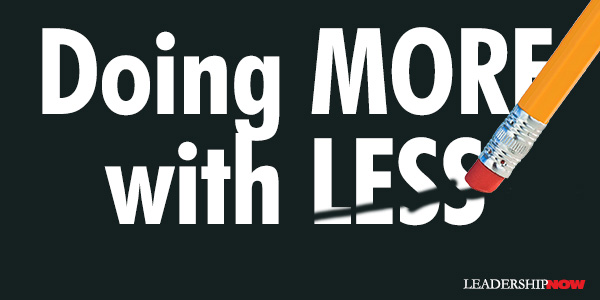 MOST companies are asking employees to do more with less. These demands may produce positive results in the short term, but they are not sustainable in the long term. “Organizations can do more with less simply by not leaving so much untapped performance on the table.” The frustration people often face in these conditions is not an engagement problem; it is more often an enablement problem.
MOST companies are asking employees to do more with less. These demands may produce positive results in the short term, but they are not sustainable in the long term. “Organizations can do more with less simply by not leaving so much untapped performance on the table.” The frustration people often face in these conditions is not an engagement problem; it is more often an enablement problem.
Mark Royal and Tom Agnew of the Hay Group, explain that The Enemy of Engagement is frustration caused by a highly engaged employee’s inability to succeed in a role due to organizational barriers or the inability to bring the bulk of his or her talents, skills, and abilities to the job. Ironically, the more engaged they are, the more frustrated they get because they care more. Doing more with less doesn’t mean conjuring higher levels of motivation out of thin air, but rather allowing motivated employees to perform at their best. It’s about harnessing and unleashing the full potential of frustrated employees—those who want to give their best but can’t due to organizational barriers and constraints. Typically we associate better engagement with leadership, but what drives it is better management. Fixing engagement means dealing with the frustration of thwarted employees. Specific management practices detailed by the authors include:
One of the most actionable things to do is to simply ask: “How can we change things around here to help you be more effective?” By doing so “a manager creates an opportunity for an employee to speak honestly and openly about enablement issues.”

Posted by Michael McKinney at 04:34 PM
12.20.11

5 Leadership Lessons: What if You Could Take Control of Your Life with One Decision?
 Many people are like garbage trucks. They run around full of garbage, full of frustration, full of anger, and full of disappointment. As their garbage piles up, they look for a place to dump it. And if you let them, they’ll dump it on you. So when someone wants to dump on you, don’t take it personally. Just smile, wave, wish them well, and move on. Believe me, you’ll be happier. Here are five lessons from David Pollay, to help us to focus on what really matters personally and professionally:

Posted by Michael McKinney at 10:43 PM
12.07.11

True North Groups
YOU can’t do it alone. We often try to, imagining that we can see and know the things we need to know without the discerning eye of an outside point of view. Bill George and Doug Baker remind us in True North Groups that, “We need people around us to whom we can look for support and advice, who can help us develop as human beings. We need them to help us become better leaders in our work, our communities, and our families.” It’s easy to get off track. “Most of us know what our True North is, but we are constantly pressured from external sources to deviate from it. Or we are seduced by extrinsic rewards like money, power, and recognition that cause us to detour from our True North.” A True North Group is comprised of six to eight trusted peers who meet on a regular basis to discuss the important questions of their lives and to support each other during difficult times. At various times, each person in the group will serve as a mentor or coach to others. True North Groups are not just about having a place to go to help you with your challenges. Done well, a group will encourage you to make the necessary course corrections that will help you to avoid the avoidable problems we all can get ourselves into. Save us from ourselves so to speak. It’s also a place to share successes.At stake is our own vulnerability. Even if we are afraid of the idea, it’s not difficult to see the value in it. George and Baker have been doing this for decades and share the nuts and bolts of creating your own group. It begins with picking the right people and that may not include your close friends. It’s based on trust and a commitment to personal growth. The authors list the following characteristics of ideal group members:
Next steps include, Norming (establishing how the group functions), Storming (behaviors that may impede your group), Performing (maintaining and renewing your group) and Reforming (the need to restructure and start again). The appendix provides topics for discussion to get your group going and thinking in the right direction. You’ll also find Member Contracts, Ground Rules and other valuable resources for your own True North Group.>/p>

Posted by Michael McKinney at 02:27 PM
11.14.11

Do You Have Moral Overconfidence?In a recent Bloomberg Businessweek article, Harvard Business School Dean, Nitin Nohria stated that because we all suffer from “moral overconfidence,” the most important thing business schools could be teaching is humility. He writes:Many people view “character” as an immutable trait formed during childhood and adolescence. I believe character development is similar to the development of knowledge or wisdom—it’s a lifelong process. The world isn’t neatly divided into good people and bad people. Most will behave well or poorly, depending on the context….Business leaders need to remember that most of us have too much confidence in our strength of character.Nohria is exactly correct. Good leadership is humble leadership. Humility is living in truth. The truth about our limitations and an understanding of our proper relationship with others. And do we share with each other a moral overconfidence—a certain naiveté about ourselves that carries with it the seeds of our own destruction. Humility gives us a better understanding of how we are to treat each other. Without it we operate from only one perspective—our own. This kills influence. As leaders, we are to work with people, not over them. It is far too tempting to think hierarchically and not relationally. In Leading Without Power, Max De Pree says that “Leaders belong to their followers.” Too many leaders try to create a buffer between themselves and their followers, when instead, they need to be leading from among their followers. A humble leader will close the gap between themselves and others. Humility manifests itself in understanding the need to learn. Authority disciplined by humility is teachable. It is arrogant to think that once we have the position or a title, we’ve arrived. We never arrive. It is merely an opportunity to learn from another perspective. If you stop learning, you stop leading. It’s something we need to stay on top of because if we don’t, life has a way of bringing us up short in an effort to get us to wake-up and start learning. Leadership has a way of revealing our weaknesses.
Posted by Michael McKinney at 04:07 PM
11.07.11

3 Self-Limiting Mindsets that Will Hold You Back at Work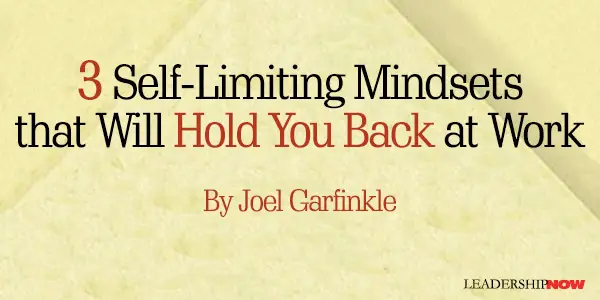
THE workplace has enough challenges and obstacles without us getting in our own way. But too often, we sabotage ourselves. Whether it’s internal forces that cause us to sell ourselves short or it’s a matter of having been conditioned not to “toot our own horn,” people have a marked tendency to avoid the limelight when in truth, they belong in it. What’s more, if you’ve always been the ‘unsung hero,’ management wants to know who you are. In my executive coaching business, I’ve worked with scores of clients over the years to help them overcome self-limiting mindsets that were holding them back in the workplace. Here are some of the most common issues:
Remember, if you don’t take credit for your own success, someone else will. That doesn’t serve your own interests. And if you think about it, it doesn’t serve the long-term interests of the company. You have a professional duty to yourself as well as your company to make sure your accomplishments are recognized and credited to you.  
Posted by Michael McKinney at 10:11 AM
10.26.11

It’s Not About You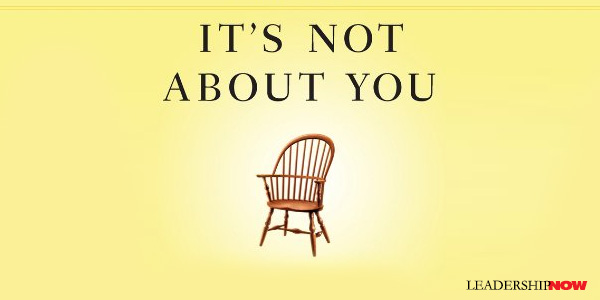 It’s Not About You (Reissued as The Go-Giver Leader) by Bob Burg and John David Mann, is the story of a leader’s journey. A journey any good leader has to take.
It’s Not About You (Reissued as The Go-Giver Leader) by Bob Burg and John David Mann, is the story of a leader’s journey. A journey any good leader has to take.
Ben begins with an agenda. His job is to convince or if necessary, to steamroll a manufacturer of high-quality chairs to accepting a merger. Ben’s company believes it to be a good thing, but the target company is not so sure. Ben’s mindset as he starts out is: “how do I get them to do what I want them to do.” Somewhere between getting people to understand him and slowing-down long enough to understand them, he found his answer. Through a series of encounters with a mentor—Aunt Elle—and a lot of reflection Ben comes to understand that it is not about him. His journey causes him to reflect on five lessons: Lesson #1: Hold the Vision. The hard part isn’t coming up with the vision, it’s holding on to the vision. “As a leader, your job is to hold fast to the big picture, to keep seeing it in your mind’s eye, with crystal clarity, where it is you are going—that place that right at this moment exists only in your mind's eye. And to keep seeing that, even when nobody else does.” Lesson #2: Build Your People. “People have all sorts of amazing qualities and natural abilities trapped inside them. With the wood, it’s knowing how to apply the heat. With people, it’s applying your belief.” If you give people something great to live up to, they usually will. “How influential you are, comes down to your intention. What are you focused on? Your benefit, or theirs?” The more you yield, the more power you have. Lesson #3: Do the Work. Be humble and stay grounded. Aunt Elle said, “People who achieve great things that the world will never forget, start out by accomplishing small things the world will never see.” Lesson #4: Stand for Something. Lead from who you are. People will figure it out anyway. People need to trust your competence, but they need to trust your character more. “Competence is simply the baseline, the thing that puts you in the game. It matters, but honestly, it’s a dime a dozen.” The authors remind us that you can only lead as far as you grow. Aunt Elle says, “What you have to give, you offer least of all through what you say; in greater part through what you do; but in greatest part through who you are.” Lesson #5: Share the Mantle. It’s not about you. “You are not their dreams, you are only the steward of those dreams. And leaders often get it backwards and start thinking they not only hold the best of others but they are the best….The moment you start thinking it’s all about you, that you’re the deal, is the moment you begin losing your capacity to positively influence others’ lives.” Whatever great parenting looks like, it is not about the parent. The Go-Giver Leader is a great presentation of solid life lessons. A book to be read and passed around. Unfortunately, “it’s not about you,” is not the kind of lesson that once learned, is always remembered. If it was, fewer great leaders would finish poorly after so many years of outstanding service. This is an issue that we face over and over again, but hopefully in ever diminishing frequency and intensity as our leadership matures. This book is a great reminder of the power of the right kind of leadership; leadership that comes from an inner strength of understanding, service and outgoing concern for others.

Posted by Michael McKinney at 09:29 PM
10.14.11

5 Leadership Lessons: EntreLeadership Dave Ramsey defines EntreLeadership as “the process of leading to cause a venture to grow and prosper.” Entreleaders know how to blend their entrepreneurial passion with servant-like leadership that motivates employees through persuasion instead of intimidation. EntreLeadership is a book about how business works from a practitioner. His advice, on nearly every facet of running a business, is based on solid principles. Here are just a few of his thoughts on leadership: 
Posted by Michael McKinney at 05:25 PM
10.07.11

Work-Life Balance?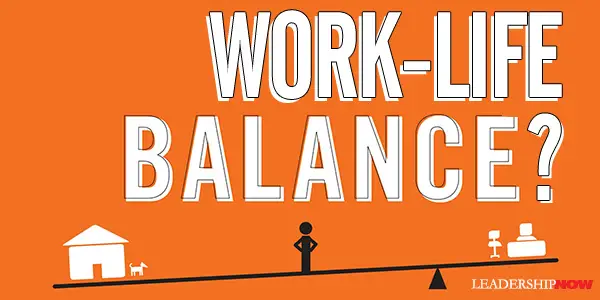
THE TERM work-life balance is fatally flawed says Matthew Kelly in Off Balance. Meant to deal with the pressures surrounding both personal and professional life, the term has unwittingly created a false dichotomy. You can’t separate the two. In fact, says Kelly, “the term itself diminishes our ability to make the case that work can be a richly rewarding part of a person’s life and should in many ways be personal.” What people really want (and need) is not work-life balance, but to “live deeply satisfying lives both personally and professionally.” The trick is to get in touch with your dissatisfaction and then strategically create the life you want. But it will take some work. It’s not going to happen accidentally. Kelly writes, “The life you desire is there for the taking, but it comes at a cost. Life, like business, hinges on the successful allocation of scarce resources.”
We seem more interested in how we want to live than we are in discovering the best way to live. Likewise, we are much more interested in developing self-expression than we are in developing selves that are worth expressing. Personal preference has triumphed over the pursuit of excellence. We want what we want, and we feel entitled to get what we want. So we need to begin with self-knowledge. “Satisfaction does not arise from simply having experiences and things, but rather from having the experiences and things that you deem important.” Kelly has developed a system to increase the level of personal and professional satisfaction in your life that involves five steps, beginning of course with assessment: Assessment. What brings you satisfaction? (There is an Off-Balance Assessment in the book and online at FloydConsulting.com) This process says Kelly, allows us to pinpoint an element of our dissatisfaction and create a prescription to overcome it. Priorities. What matters most to you? While these may change over time, it is essential that we clearly define them or we become victims of the tyranny of the urgent. Core Habits. What are the daily habits that keep you healthy, focused, and energized? For example, workout, meditation, proper diet, maintaining relationships. “What one thing, if done every day, would change your life markedly?” Weekly Strategy Session. What is the key project that should have your attention and be your starting point for each day of the week? Our lives are destined for underachievement and dissatisfaction if we don’t learn to plan and strategize personally. Quarterly Review. Every three months review what is working well in your life, review what you said you would do in the last ninety days; outline the key objectives in your life at this time; share your plan to accomplish these objectives. Kelly says that knowing how to balance various activities in our life to produce the maximum flow of energy is perhaps the most important skill any of us can learn and develop. “Each day has a focus, and holding to this focus plays a significant role in creating and sustaining high levels of satisfaction.” He concludes, “To lay your head on your pillow at night, knowing that who you are and what you do makes sense … now, that is satisfaction.”

Posted by Michael McKinney at 03:00 PM
09.13.11

Ownership Thinking
Ownership Thinking is about developing leaders at all levels. “Fundamentally,” writes author Brad Hams, “Ownership Thinking is about moving employees away from the ‘me’ way of thinking and towards concerns of the business and its financial performance.” This is leadership thinking in a business setting. When people understand the business, their role in it, and are informed of what is going on and take responsibility for the outcomes, then they become better stewards of the company’s resources and help to create wealth. Hams has found that the vast majority of people “want to engage and contribute, and feel much better about themselves when they have the opportunity to do so … and they have the capacity to do so.” We often frustrate that effort and create cultures of entitlement because, in the words of Judith Bardwick author of Danger in the Comfort Zone, “managers are unwilling to do the work of requiring work.” Hams says his mission in life is to eradicate habits of entitlement in organizations. People who actually produce things do so primarily for two reasons: (1) They have a strong work ethic. In other words, they have to believe that rewards come only with hard work, and (2) They enjoy producing. It is exciting for them, and the reward for producing is not only the things they are able to afford as a result of it, but the personal growth and sense of worth that come from producing: that is, true self-esteem. A workforce that is helping to create wealth should be able to participate in the wealth they are creating. However, incentive plans should be self-funding, and “it is the obligation of ownership and leadership to teach them how to do that and to provide them with the tools and training necessary to accomplish the task.” Simply put, your employees need to know what’s going on. In a chapter entitled, Your Employees Think You Make Wheelbarrows of Money, Hams relates that when he asks the question: “Your company had 12 million in sales last year, what do you think the profit was?” it is not uncommon to hear 50% from employees of companies where financial information is not shared or business acumen taught. “In the absence of information, people make stuff up.” Generally speaking, the people with the greatest understanding and expertise in any given area are the people who are actually doing the work, and these people are not necessarily management. For an organization to achieve excellence, it must engage all of its organization members. Ownership Thinking is a how-to book. Hams explains how to create incentive plans that work (plans that clearly align employees’ behavior to the organization’s business and financial objectives), how to teach financial skills (how the company makes money and how they add - or take away – value), creating the right performance indicators, rapid improvement plans and how to implement Ownership Thinking for the long-term. “Practicing Ownership Thinking will allow you, as an owner or leader, to rest easier knowing that your employees are making decisions and taking actions that are aligned with what you would do yourself.” 
Posted by Michael McKinney at 10:40 AM
09.09.11

Managing the UnmanageableIf we truly want to deal with a difficult or unmanageable person, we have to get at the thinking behind the behavior. Why do they do that? Why are they that way?Instead of going deeper, it’s easier to just label them and avoid the issue. He’s rude. She’s unreliable. He’s an egomaniac. She’s self-absorbed. Anne Loehr and Jezra Kaye, authors of Managing the Unmanageable, say that these “unmanageable” people are costing companies a fortune. Loehr estimates that her clients lose, on average, 30% of their productivity because of issues related to unmanageable employees. The fact is, “there’s a world of difference between someone who’s acting unmanageable, and someone who can’t [won’t] act any other way. There’s a world of difference between someone who’s become unmanageable in response to a particular set of circumstances (that can, at least theoretically, be changed) and someone who’s just like that.” Perceiving the difference is the task of leaders, managers, and coaches. Most of the time we deal with people at the symptom level. Managing the Unmanageable is written to help you do just that. They begin with an appropriate caution: If you find yourself being convinced that someone could never have the slightest redeeming good quality, find a way to deal with your own feelings before you try to manage theirs. Good advice. There are some early warning signs that it is time to look deeper than the behaviors you see: Diminished Motivation: “Frustration with a job can grow out of unmet or unrealistic expectations, company-wide uncertainty or relationship problems on a team or with a manager.” You’ll hear comments like: “I’m just not into it anymore.”Unclear Expectations: Misunderstandings are common. We don’t always communicate as clearly as we think. Too much often goes unsaid. Sadly, too, “managers and executives sometimes purposely lead employees astray, confuse them, or keep them in the dark to avoid unpleasant issues or consolidate power in their own hands.” It sounds like this: “I have no idea what she wants.”Lack of Confidence or Self-Esteem: “It’s natural to wonder if you have what it takes when the stakes go up or your job becomes more complex. But if that lack of self-confidence persists, an employee can become resistant, defensive, and ultimately unmanageable. They will say things such as: “I don’t know why they thought I could do this.”Personal Issues: “When your employee is distracted, self-absorbed, or unable to focus, her problem may stem from conditions outside of work. It might be expressed as: “I haven’t slept through the night in weeks.”“A radical shift in behavior,” say Loehr and Kaye, “may be your first indication that a good employee is morphing into an unmanageable employee.” In short, other people have many of the same problems we have, it’s just that they haven’t learned how to deal with it or are not in a position to do anything about it in the same way that we would as leaders. The book specifically deals with the excuse-maker, the grumbler, the egomaniac, the loose cannon, the joker, the do-gooder, the wallflower, the gossip, the slacker, the rude-nik, and the AWOL. Each “salvage” operation follows the 5-C Model: Commit or Quit, Communicate, Clarify Goals and Roles, Coach, and Create Accountability. The focus of each chapter is to get behind the behavior of each type and understand it. You will find helpful composite cases, practical tips and dialogues for dealing with each type.
Posted by Michael McKinney at 08:41 AM
08.26.11

Credibility: How Leaders Gain it and Lose It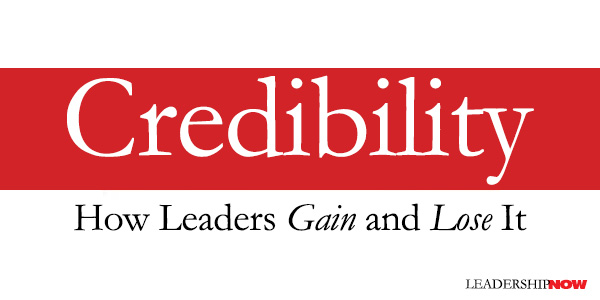
CREDIBILITY is the foundation of leadership. Unfortunately, many people today do not trust their leaders. “Many wonder if there are any leaders left who have the strength of character to sustain their trust,” write Jim Kouzes and Barry Posner in Credibility: How Leaders Gain it and Lose It – Why People Demand It. While there is no single reason for it, “there is the gnawing sense in many corridors that leaders are not competent to handle the tough challenges; that they are not telling the truth; and that they are motivated more by greed and self-interest than concerns for the customer, the employees, or the country.” The time is ripe to revisit this topic. Credibility is a wake-up call to get back to the fundamentals; to remember that leadership is about relationships. “The secret to closing the credibility gap lies in a collective willingness to get closer, to become known, and to get to know others—as human beings, not as demographic categories, psychographic profiles, voting statistics, or employee numbers.”The process of building and sustaining credibility requires six disciplines: discover your self, appreciate constituents, affirm shared values, develop capacity, serve a purpose, and sustain hope. The authors devote a chapter to each of these issues. Personal responsibility is key to building and restoring credibility. Personal responsibility means understanding not only your actions, but the likely consequences and attending to them. Kouzes and Posner suggest following the “Six A’s of Leadership Accountability”: accept, admit, apologize, act, amend, attend. Leadership isn’t easy and in a constantly changing world, things like credibility and competency can seem elusive. But if we act on a daily basis, “in ways that increase people’s belief that we are honest, competent, inspiring, and forward-looking, people will be much more likely to want to follow your direction.” When leaders walk the talk, others are more likely to follow. Some leaders think that credibility once demonstrated and earned, is complete. But it must be renewed daily in everything we do. Unfair or not, it is the life that a good leader has chosen and demonstrates the understanding that the function of leaders is to serve, not be served. Credibility is an important book to help you sustain your influence. They conclude: Renewing credibility is a continuous human struggle and the ultimate leadership struggle. Strenuous effort is required to build and strengthen the foundations of working relationships. Constituents do not owe leaders allegiance. Leaders earn it. The gift of another’s trust and confidence is well worth the struggle and essential to meeting the challenges of leading people to places they have never been before. 
Posted by Michael McKinney at 04:46 PM
08.22.11

Relationship Trouble? Try Another PerspectivePeriods of crisis and testing are helpful for what they bring to our attention. When things are going well it is all too easy to ignore the hard issues we would be better served by addressing. Times of testing show who we really are.Diana Smith identifies one such issue in The Elephant in the Room: relationships. “No longer,” Smith writes, “can we count on slow markets or sloppy competition to make up for the inefficiencies poor relationships create. We face a crisis not only of leadership but of relationship.” When faced with a relationship problem, there are two ways we can look at it: Individual Perspective: Based on the assumptions that there is one right answer, people either get it or they don’t get it, and when they don’t, their dispositions are largely to blame. Relational Perspective: Based on the assumptions that different people will see different things, that solid common ground can only be found after exploring basic differences, and that the strength of a relationship will determine how well and how quickly people can put their differences to work. “The assumption that ‘you alone are responsible’ and ‘you are either mad or bad’ lead people to locate the cause of problems in individuals and outside their own influence.” The relational perspective actually puts you in the frame of mind to take responsibility for any part you may have in the difficulty. Reflecting on the relationship between Churchill and Roosevelt she observes that “they looked to the other’s circumstances, not his character, to find out why” they did what they did. Karl Popper wrote in Conjectures and Refutations, “While differing widely in the various little bits we know, in our infinite ignorance we are all equal.” Smith says that understanding this “leads people to assume that we all see things others miss, that disagreements are inevitable and valuable, that those disagreements will at times cause frustration, and that people will be better off if they help each other build relationships that can handle those differences well, especially under pressure. While it makes sense to take the relational perspective, it can be hard to do especially when we are in the heat of the moment. One reason for this is that it is hard to step out of the moment and reflect on and reframe the situation in a productive way. And when we do reflect it’s easy to get sucked into what Smith calls “armchair reflection.” This is reflection that is really nothing more than gossip, blaming, imputing motives and conclusions like, “He just doesn’t get it.” It doesn’t lead to understanding and a forum for the other person to fill in what is missing from the picture. Not all relationships are created equal and Smith offers techniques to sort those out too. But when we want to improve a relationship, if we are waiting for the other person to change, she says we’re in for a long wait. “To improve a relationship, you need to focus on changing the relationship, not just yourself or the other person.” Smith offers tools and practices to do this. Before you even begin to work on a relationship, there is an interesting paradox to think about: “They know each other so well, they no longer know each other at all. All they see are the caricatures in their heads—he’s so sensitive, she’s so competitive.” Smith adds that despite the “very efficiency these caricatures give, they also take away because they make a person’s underlying complexity—sure to emerge under stress—harder to handle or to understand. That’s why, early on, the single most important thing people can do is slow down and take a closer look at each other and how their relationship works. Your effectiveness as a leader depends on your relationships. The Elephant in the Room highlights a better perspective to take than the standard individual perspective we usually employ in dealing with our relationships. A relationship is a system of behaviors that can be analyzed and understood. Smith’s insights will help you to productively influence them.
Posted by Michael McKinney at 03:50 PM
08.19.11

What to Ask the Person in the Mirror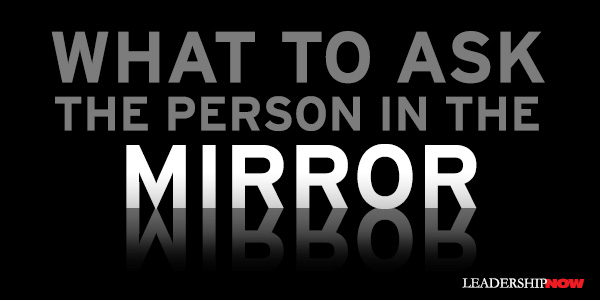
WHILE we might like to think otherwise, here is a fact about successful leaders: Successful leaders go through significant periods of time in which they feel confused, discouraged, and unsure of themselves and their decisions. They feel as if they should be somewhere else, doing something else. And unsuccessful leaders go through the same thing. The difference, says Harvard professor Robert Kaplan, is “how they deal with these periods of confusion and uncertainty. The trick lies not in avoiding these difficult periods; it lies in knowing how to step back, diagnose, regroup, and move forward.” This means not having all the right answers, but learning to ask the right questions. The challenge will be asking the right questions and making to the time to reflect on them. Reflecting is the key ingredient here and what many of us are short on. In his timeless book, What to Ask the Person in the Mirror, Kaplan offers seven basic types of inquiry or areas of focus—actually a system of inquiry that ties the leadership function together—that you should be looking at on a regular basis:Vision and Priorities. In this foundational area we need to be very clear and communicate it in a way that helps others to be able to determine where to focus their own efforts. Have you developed a clear vision and have you identified three to five clear priorities to achieve that vision? Managing Your Time. Your vision and priorities are reflected in the way you use your time. Track your time for two weeks. How does this compare to your key priorities? Giving and Getting Feedback. Most leaders do not effectively coach their subordinates, and also fail to get the critical coaching that they themselves need in order to excel. Do you cultivate advisors who are able to confront you with criticisms that you may not want to hear? Succession Planning and Delegation. When leaders fail to actively plan for succession, they do not delegate sufficiently and may become decision-making bottlenecks. Have you identified potential successors for your job? Why not? Evaluation and Alignment. It is often extremely difficult as an insider to see where you and the organization have drifted out of alignment. If you had to start again, how would you do it? Would you be doing the same things? Does the design of your organization, your incentive systems, your culture, and even your approach to leading still fit the needs of the organization? The Leader as Role Model. Many leaders fail to appreciate that their actions speak louder than their words. Self-awareness is critically important. Write down two or three key messages you believe you send with your behavior. Seek advice from key subordinates and advisors who directly observe your behavior, in order to answer this question: is there a “disconnect” between the messages you wish to send and those you are in fact sending? Reaching Your Potential. Know and learn to manage your strengths, weaknesses, and passions, not only to bring out your best, but also to create this same environment and aspiration among your staff. It’s not uncommon to find leaders that just stick to what they know best and not address those areas where they feel uncomfortable or insecure. All of these areas need to be reflected on as they each have an impact on the other. Taking the time to reflect is not easy and “doesn’t sound like fun, and may not sound as important as the fifty other things you have to fit into your day—but it works.” And be sure to take the time to reflect on these issues with your team as well. With many down-to-earth examples, Kaplan will expand the range of questions you should be asking yourself. What to Ask the Person in the Mirror will help you to rethink unsustainable behaviors that are damaging to both you and your organization and help you to mature and grow in your leadership role. 
Posted by Michael McKinney at 03:57 PM
08.08.11

Common Purpose Leadership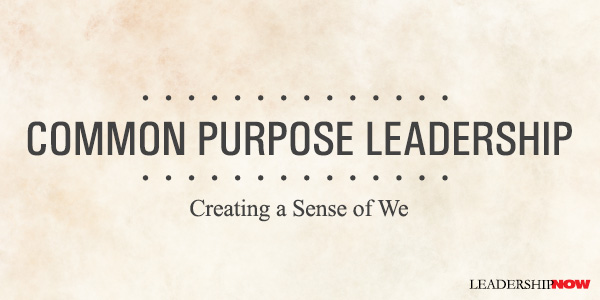
IN Common Purpose, consultant Joel Kurtzman makes the case that excellent leaders build a sense of inclusiveness—a sense of we—within the organization by creating a common purpose. A place where people know what to do and why and understand what the organization stands for. Based on interviews and first-hand experience, Common Purpose lays out how to achieve and then sustain a culture based on a common purpose. For example:
The easiest way to create a sense of we, says Kurtzman, is unfortunately to create the specter of them. Because it is easy, it is probably the reason you see this dynamic played out in so many organizations of all kinds. While it is a shortcut to common purpose, “it can also be a stepping stone to chaos, doom, and organized opposition.” I would add that within the organization or group, it also leads to arrogance, stagnation and closed minds. In most cases, it leads to decline. Organizations are created to achieve goals that “are beyond the capability of an individual to accomplish alone.” They are a method of “aligning groups of people so they achieve common goals.” This is best accomplished when you encourage people to be leaders at any level within the organization. Simon Cooper, president and CEO of Ritz-Carlton, says the best reason to rid an organization of mindless hierarchy is to provide scriptless service: employees deciding on their own how to make guests happy. “They make decisions on their own, on the spot, using their own judgment, and with the sense of confidence that comes from owning their jobs. That’s real leadership.” Taking risks on behalf of the organization. This requires trust at all levels and a different view of real leadership, says Kurtzman. It is difficult to overstress how important it is for teams of people working together to meet informally from time to time…The point is that you cannot lead a team if you do not know the people you are leading, and the best way to do that is informally. “The leader is not separate from the group he or she leads. Rather, the leader is the organization’s glue—the force that binds it together, sets its direction, and makes certain that the group functions as one.” Kurtzman notes, “Leadership is not coaching. Coaching focuses on helping people arrive at their own goals. Whereas leadership, especially common purpose leadership, is about helping people arrive at a collective set of goals. It is about coordinating people’s efforts, aims, ambitions, and capabilities.” Leaders can’t think of themselves as better than their workers or more favored because they have a higher rank. Becoming CEO is not a coronation; it’s a promotion. And CEOs can’t do everything. The purpose of an organization is to combine the efforts of many people to produce results no one on his or her own could achieve alone. Leaders must understand that. They must live the goals they espouse. They must understand that everyone inside the organization is looking at them — scrutinizing them, really — and also that every action of theirs is being watched and talked about. At FM Global, Shivan Subramaniam, the chairman and CEO, decided against buying a corporate jet despite the prodding of his board. Instead, he decided to abide by the same corporate travel rules that every other executive in the company abides by. He even flies on the redeye if he must. By doing this, he sends a powerful signal throughout the company that while he may be the CEO, he’s also an employee, just like everyone else. People value that. People will do almost anything for a leader like that. Of course, one size does not fit all. “People are individuals, and those who thrive in one firm might not thrive in another. Chemistry, fit, values, and many other qualities are in the eye of the beholder.” Kurtzman believes that “organizations will come to resemble constellations of capabilities linked together technologically from centers located around the world….Big companies will comprise smaller pieces, each with unique characteristics, ownership structures, and relationships. Each of these elements, when combined, will create enormous value?” The question is what will keep it all together. Incentives alone won’t do it. “The power of a common purpose will become the factor that differentiates winning organizations from those left behind.” This means that leaders will have to be “kinder, more caring, and more empathic than leaders of the past.” We have seen this increased focus on respect as many of you write, talk, and practice this on a daily basis. Common purpose leadership, at its most basic level, is about recognizing people as individuals. Common purpose leadership begins with respect for individuals and their differences, and goes on to celebrate their strengths. 
Posted by Michael McKinney at 10:59 AM
08.03.11

7 Ways to Increase Trust by Creating Stability Uncertain times always invite a little more drama, particularly in the workplace. One reason is because the brain craves certainty. When you feel uncertain, the amygdala, an almond shaped structure in the brain shoots out chemicals through your blood stream that make you experience feelings of fear, doubt and anxiety. Fortunately leaders can use this information to create a sense of stability in an unstable world, which increases and eliminates much of the unnecessary drama plaguing so many workplaces today. Here are seven ways leaders can increase trust and reduce workplace drama by creating a stable environment and seven questions to help you get to the root of the problem. Be clear Just because you are unclear does not mean you have drama, but I can guarantee where ever there is drama there is a lack of clarity in some area. The lack of clarity could be in your policies, mission statement, job descriptions or even the methods of communication. When there seems to be negativity or any other form of drama, ask the question, “Where might there be a lack of clarity?” Be Consistent Often a leader can add to the confusion unintentionally because of personality and wiring. In my book, Stop Workplace Drama I talk about the creative genius boss and the idealist, two traits often found in high driving entrepreneurial types. The creative genius drives employees crazy with “flavor of the month” ideas and emergency deadlines only to change course at a whim. The idealist contributes to lack of consistency by starting out strong then losing momentum when the new wears off, or when realism sets in and resources are scarce. When you see the morale dipping or you sense a lack of engagement, ask the question, “How might my behaviors be perceived as inconsistent?” Shorten the Gap Most of us know from experience that plans that look good on paper don’t always work in the real world. One way to keep clarity and consistency is to shorten the gap. In other words, chunk down the goals into very small measurable parts. The idea here is to give the vision and the overview, but explain that plans may change as new information emerges. Then at the designated stopping places, celebrate the successes and then explain the next few projects and pieces and how the changes will contribute to the stated goals. When you get ready to make a change, always provide a pilot period for the change rather than announce the change is here to stay. When you see negativity, frustration or overwhelm, ask the question, “Where do I need to shorten the gap so it seems easy?” Keep your Word When you are in the midst of change, regular communication, scheduled communication and documented promises are a must. Even a simple, “I’ll get back with you” can create a sense of uncertainty and inconsistency if you don’t do what you say you are going to do. When you say, “I will let you know” or “I’ll get back to you on that,” schedule a time in your blackberry or calendar and make sure you follow through. Make your word golden and you will build loyalty and trust in your organization. When you stop getting ideas, curiosity and questions, ask yourself the question, “Where do I need to follow up or tie up loose ends?” Listen Every time I have interviewed employees on what makes a good boss, listening is always the first response, and respect is the second. Rather than always being the one with the answers, learn how to ask a good question. When you really listen, you increase engagement, which is always a sign of trust. The good thing about listening is remembering that you don’t have to have all the answers. When you start to feel overwhelmed, stuck or confused, ask yourself, “What could I learn from my employees if I was willing to listen?” Respect Before I became a professional speaker and trainer I had some bad habits unbeknownst to me. I would either roll my eyes, or use sarcasm as a way to keep people at a distance when I did not agree or when I felt misunderstood. I was not aware of these habits until someone pointed it out to me. Eye-rolling, interrupting, or using innuendo and sarcasm may keep people in their place, but these habits will also build a barrier instead of a bridge. In addition, you will be viewed as a persecutor instead of as a leader. If you perceive distance from your peers or your employees, ask yourself, “What habits do I have that could communicate disrespect?” Master Your Self William Penn said, “No man is fit to command another who cannot command himself.” As a leader, the worst thing you can do is to let your emotions rule you. No matter what the reason, flying off the handle, cursing, yelling or throwing fits does not benefit your corporate goals or inspire your team. No one wants to work for a bully or a hot head. Excuses such as “that’s just the way I am,” or “You would feel the same way” indicates a lack of discipline and emotional maturity. If you feel the pressures piling up and you have difficulty mastering yourself, ask yourself these questions: “Is my behavior and thoughts adding value,” and “How can I get my needs met so I can represent myself appropriately?” Tumultuous times offer great opportunities to increase your leadership skills. Rather than focusing on the outside circumstances, now is the time to become a creator and lead from within by creating stability even in difficult times. Marlene Chism is a professional speaker, trainer and the author of Stop Workplace Drama. For more information visit www.marlenechism.com or at www.stopworkplacedrama.com
Posted by Michael McKinney at 10:40 PM
07.26.11

Have a Nice Conflict!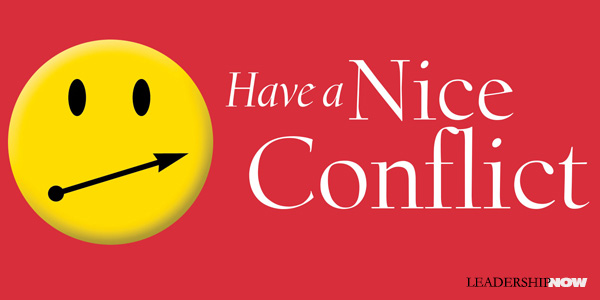
READING Have a Nice Conflict was like listening to my Dad again. He first met “Doc” Porter in the early seventies and they clicked almost immediately. Elias Porter’s Relationship Awareness Theory, on which the book is based, resonated with my Dad. Behaviors are the tools we choose and use to support our self-worth.Have a Nice Conflict is the story of sales manager John Doyle who has been passed over for what he believes is a well-deserved promotion. He has lost some of his top performers because he rubbed them the wrong way. When he turns up at an old friend and client’s office to explain yet another change in sales reps, he puts him on to Dr. Mac to help him improve his people skills at both work and home. Dr. Mac explains to John that there are many ways of interacting with others. We have default ways of behaving and when in conflict we often shift into other behaviors to maintain our self-worth. While we are trying to do the “right thing” to maintain our self-worth, conflict can happen when our “right thing” appears to be the “wrong thing” to another person. Conflict can be prevented by seeing contentious behavior as merely a different style instead of a direct challenge or threat aimed at annoying you or derailing you. He introduces him to the Strengths Deployment Inventory (SDI) which is a tool to help you understand the motivations behind your own behaviors and to better discern the motivations of others. By giving you a framework it helps you to understand what you and others are feeling and then helps you be better able to respond. Having a nice conflict is about taking personal responsibility for the interaction. To create movement toward resolution, we need to show the other person the path back to self-worth—where they feel good about themselves. That path may be different than yours. The concept should be taught in schools, however, the thought process is essential for leaders. The book alone offers valuable insights into the process and methodology, but coupled with the SDI you’ll have greater success. The authors offer a discount on the SDI to readers of the book. 
Posted by Michael McKinney at 05:08 PM
07.20.11

Information Overload and What You Can Do About ItKnowledge workers think for a living to varying extents, depending on the job and situation, but there is little time for thought and reflection in the course of a typical day. Instead, information—often in the form of e-mail messages, reports, news, Web sites, RSS feeds, blogs, wikis, instant messages, text messages, Twitter, and video conferencing walls—bombards and dulls our senses.Consider this: A 30-second interruption can result in as much as 5 minutes of recovery time. In total, interruptions plus recovery time consume as much as 28% of the knowledge worker’s day. The volume of information we have today “throttles productivity, reduces our capability to absorb and learn, puts our physical and mental health at risk, and interferes with personal and business relationships.” Jonathan Spira, CEO of Basex, a research firm focusing on issues companies face in the knowledge economy, explains in Overload! why we are in the state we are in and what steps we can begin to take to better manage it. Even as dry as information tends to be, this is an absorbing book. Spira claims that the changes in how we use and view information that will happen over the next 50 years will not only reshape the globe but turn it inside out. Today, information overload costs the U.S. economy a minimum of $900 billion per year in lowered employee productivity and reduced innovation. To manage successfully in the knowledge economy, we must recognize key differences in how knowledge workers work. Their tasks can be categorized into six overarching tasks: searching, creating content (sometimes re-creating), thought and reflection, sharing knowledge, and networking. Interestingly, a 2010 Basex study found that of these tasks, knowledge workers only spend only 5% of the day engaged in thought and reflection. The one task that is essential for all the rest we spend so little time performing. We must allow [require] workers more time for thought and reflection if they are to be more productive, efficient, and effective. Too much information without reflection can stall our productivity. It affects our ability to manage thoughts and ideas, contemplate and even to reason and think. We develop a state of what has been termed, continuous partial attention; to give only partial attention continuously. Science writer Steven Johnson described it this way: It usually involves skimming the surface of the incoming data, picking out the relevant details, and moving on to the next stream. You’re paying attention, but only partially. That lets you cast a wider net, but it also runs the risk of keeping you from really studying the fish.Researcher Linda Stone adds this: It is motivated by a desire to be a LIVE node on the network. Another way of saying this is that we want to connect and be connected. We want to effectively scan for opportunity and optimize for the best opportunities, activities, and contacts, in any given moment….It is an always on, anywhere, anytime, any place behavior that involves an artificial sense of constant crisis. We are always on high alert when we pay continuous partial attention. Although there are tens of thousands of things we could do says Spiria, he offers ten tips that, when observed, will help lower information overload for everyone:
Posted by Michael McKinney at 08:56 AM
07.13.11

Who’s the Real Leader in Your Office? How often have you wondered who the real leader is in your office? Maybe you need to delegate a critical project, and you can’t afford to put your faith in someone who is not up to the job. Or maybe you work under several managers, and you want to make sure that you are building rapport with the one who counts. Or maybe you’d like to do some self-inventory in order to gauge how far you might rise after four or five additional years. All of these are good reasons for wondering how to accurately assess leadership potential. Unfortunately, most people have been taught to think about this issue in all the wrong ways. As a society, we rely on some rather misguided ideas about leadership success. As a result, when it comes to leadership selection decisions, we commit some pretty big errors. The first mistake stems from not knowing what qualities to seek in potential leaders. For decades we have been told that a charismatic personality, or Ivy-League training, or certain style, make all the difference. They don’t. None of these factors is a reliable predictor of leadership effectiveness. Other times we focus on qualities that do matter, but we don’t go far enough to seek a healthy balance. For example, we gravitate toward individuals who possess enormous passion and vision, but who lack solid character. Or we promote people with impressive courage, but who lack enough empathy to handle sticky social situations. The second big mistake we make when trying to judge leadership potential is the use of insufficient assessment techniques. In other words, even when we know what to look for, we don’t know how to look. We rely on backward looking interview questions, or inappropriate personality tests, or letters of reference from those who simply cannot predict how a person will perform in a fundamentally new position. Even the perennial favorite among promotion criteria – prior performance – is not a good indicator of future leadership success. At best, it tells only half the story. A solid manager with ten years of experience in sales, for example, might be poorly suited for a generalist role that will require her to lead an entire division. In our book Why Are We Bad at Picking Good Leaders? the two of us answer these crucial “what” and “how” questions. Based on more than fifteen years of experience working with premiere executive education programs and some of the best organizations in the world, we explain how to identify the very best leaders. Here are some highlights that will help you make your own determination: • Focus on the Qualities that Count. There are seven essential attributes of leadership success—integrity, empathy, emotional intelligence, vision, judgment, courage and passion. Take away just one, and a person who is called upon to lead will eventually fail. For example, former BP CEO Tony Hayward successfully climbed the corporate ladder for more than 25 years. But when the Deepwater Horizon exploded in 2010, his leadership faced a stiff challenge. In particular, he needed a strong sense of empathy to deal with an outraged public and a diverse set of competing constituents. Unfortunately, he was not up to the task. During an early interview, he claimed that the oil spill was “relatively tiny” compared with the “very big ocean,” and he consistently underestimated the extent of the leak. Obviously the spill wasn’t tiny from the vantage point of the Gulf Coast fishermen who lived nearby. Worse was the comment Hayward posted on Facebook to the effect that more than anyone else, he wanted the crisis to be over because, he said, “I want my life back.” This quip was widely seen as insensitive to the men whose lives had been lost in the explosion. President Obama responded, “He wouldn’t be working for me after any of those statements,” and although his days were probably already numbered, that was the last straw. Hayward lacked the kind of empathy that leaders need to survive. • Use the Right Assessment Techniques. Not too long ago, we met with a Fortune 500 president who was reeling from a poor hiring decision. Just six months after filling a key position, the company had to terminate its new hire and start a search all over again. When we asked the president how he and his team chose the person who was originally selected, he said: “He [the candidate who was hired] had great experience in the industry, a track record of turning around underperforming business, and already had relationships with several of our largest customers.” In addition, the company hired a search firm that conducted extensive background referencing, and all signs were positive. The candidate was results-oriented, friendly, well liked, and driven. While these findings sounded good, further investigation on our part revealed that the president fell into some classic assessment traps. The most serious mistake he made was relying on an evaluation process that was essentially backward looking. The president spent large amounts of time going over the candidate’s résumé and credentials: he asked about prior successes and failures, he asked others how the candidate performed, and so on. But this backward-looking investigation has limited predictive value when trying to determine a candidate’s likely success in a fundamentally new position. In our assessment practice, we overcome this obstacle by using a variety of different techniques, including simulations and case studies, direct observation in group settings, and specially created hypothetical scenarios that test a candidate’s leadership potential. This last technique is critical because it is forward looking. Unlike a typical interview question that asks candidates to discuss what happened in the past, these hypothetical situations present candidates with unfamiliar and challenging leadership situations. No amount of preparation or interview savvy will enable a candidate to fudge her answer or game the interview process. For more information on how the best companies in the world find first-rate leaders, including how to order Why Are We Bad at Picking Good Leaders? visit PickingBetterLeaders.com or email the authors directly at jcohn@liag-advisors.com and jmoran@liag-advisors.com.
Posted by Michael McKinney at 05:48 PM
06.29.11

Leading Views: Four Ways to Change We know what to do to make people happy at work says Brian Tracy. The problem is that we either forget to do those things that make people happy, neglect to do them because we are distracted by other things, refuse to do them because we don’t understand their importance, or, worst of all, do things that actually make people unhappy and then justify our behavior with self-righteous excuses and rationalizations. We know what to do to make people happy at work says Brian Tracy. The problem is that we either forget to do those things that make people happy, neglect to do them because we are distracted by other things, refuse to do them because we don’t understand their importance, or, worst of all, do things that actually make people unhappy and then justify our behavior with self-righteous excuses and rationalizations.
To make people feel really happy about themselves, you don’t have to change your entire personality or become a completely different person, you simply have to treat them exactly the way you would like to be treated, over and over again, until it becomes a series of automatic and easy behaviors for you. There are only four ways that you can change anything about yourself, your life, your work, or your relationships with others:
• What would you like me to do more of in the days and weeks ahead? • What would you like me to do less of? • What would you like me to start doing that I am not doing today? • What would you like me to stop doing altogether? Adapted from Full Engagement! Inspire, Motivate, and Bring Out the Best in Your People by Brian Tracy
Posted by Michael McKinney at 05:33 PM
06.17.11

42 Rules for Your New Leadership RoleWhether you have just been given a new leadership role, are currently in a leadership role, or have consciously decided to begin to lead from where you are, Pam Fox Rollin has created a concise guide for doing it successfully. 42 Rules for Your New Leadership Role gives you a starting point to work from to help prevent costly errors from occurring and will also aid in improving one's overall leadership experience.In all the busyness that surrounds a new role, it’s easy to forget the essential little things that make all the difference. We easily get caught up in the activity and don’t slow down enough to think about what it is we really need to be doing. New roles bring with it new expectations and that means doing things differently than we have done them before. 42 Rules will help you to gather your thoughts and lead thoughtfully. A quick daily review will help to keep you focused on the agenda that really matters. The book is divided into seven sections: Set Yourself up for Success: Take charge of your start. New roles require new starts. “When brains are overloaded, people tend to rely on what they’ve done before, even when that didn’t work very well or is out of place in the new context. Ironically, this tunnel vision and rigidity is especially true of leaders who have experienced success.” Map the Terrain: Investigate what matters. “If you’re going to deliver for someone, make it your priority to deliver up. That gives you breathing room to deliver for everyone else.” Common mistakes: Seeing smoke and running off to chase fires; Adopting other people’s agendas with insufficient data and thought; Becoming buried under the pent-up piles of tasks. Show up Wisely: Know yourself. Use your strengths, but avoid diagnosing problems to suit your strengths—dragging the problem into your comfort zone. “If you're good at running numbers, be aware that you may frame problems quantitatively, when lack of strategic insight is at the root of the problem. Seeing problems as they really are—rather than as you are—is especially essential in your first months on the job.” Start your Wins: You will feel the pressure to start with something dramatic. Pick smart quick wins. “The quick wins you choose will signal to others what matters to you….Bold moves in the second and third quarters of your tenure tend to accelerate your career.” Create your Management System: Define your own processes. At the same time, “lighten up on talking about ‘your leadership style’ and think more about what you could do that would be truly useful for your team members and colleagues.” Spotlight your team and grow more leaders. Stay Smart: Keep learning. “If you neglect to stay smart, seek feedback, and build your network, no one is likely to mention the gap. You’ll just become less valuable.” Set You and Your Team to Thrive: “Many people can drive themselves and their teams to exceed expectations for a quarter or two. The real challenge is to build a team—and a life—that sustains high performance.” “Extend a hand to the next round of leaders by sharing what you’ve learned.” What rules have helped you in your leadership role? 
Posted by Michael McKinney at 06:36 PM
06.16.11

To Focus on the Work, You Must Focus on People Doing the Work
Many managers think they manage the work. They don’t. They’re responsible for the work, but they get work done by influencing the people who do the work. What makes this complicated is what Peter Drucker pointed out: when you hire a hand, it comes with a head and heart attached. So you must pay attention, lots of attention, to the whole person—head and heart—because you need more than your people’s time and attention. Most work now requires knowledge, judgment, thinking, and decision making, and so it matters if people care about what they do. You cannot simply give them orders and criticism. That rarely produces the kind of engagement you need. Other, less direct but more effective forms of influence—such as support, development, and encouragement—are needed that engage the whole person. Do you tend to focus on the work or on the people doing the work? In other words, do you tend to confront and criticize, or do you support people and give them what they need to do good work? Adapted from Being the Boss: The 3 Imperatives for Becoming a Great Leader by Linda A. Hill and Kent L. Lineback. 
Posted by Michael McKinney at 05:45 PM
06.13.11

7 Guiding Principles for Developing Leadership TalentPeople deliver numbers. If you want the numbers, you need the people. As a leader you need to know how to judge raw human talent. In The Talent Masters, Bill Conaty and Ram Charan explain how to do it.To develop talent, you need to become intimate with your people; to know the essence of each individual. Talent masters can identify a person’s talent more precisely than most people simply because they excel at observing and listening. And they institutionalize this skill to create their own supply of good judges. It simply must become part of the culture. Talent development is not an event. It is a process. To make it sustainable it must become part of the culture. And no one needs to understand that more than the CEO. When you have an organization devoted to a person, you have a cult. When you have an organization devoted to a set of principles and values, you have a culture. Developing people simply must be a priority from the top down. That leads us to Conaty and Charan’s first principle of the talent masters:

Posted by Michael McKinney at 10:10 PM
06.07.11

Transforming an Ordinary Moment into a TouchPoint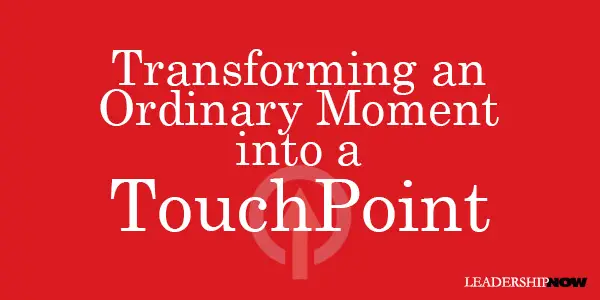
WE ALL have those moments when we are too busy for the people around us. But those moments are the work of leaders. Those are the moments when we can help to move things from what they are to what they could be. Campbell CEO Doug Conant said, “To me, they’re not interruptions. They’re opportunities to touch someone and improve the situation.” TouchPoints, by Doug Conant and Mette Norgaard, describes a new way of thinking about the work of leadership. TouchPoints are those moments in the day when you have the opportunity to touch the lives of other people. Each has the potential to become a high point or a low point in someone’s day. “Each is an opportunity to establish high performance expectations, to infuse the agenda with greater clarity and more energy, and to influence the course of events.”Every TouchPoint is spring-loaded with possibilities. Each one can build—or break—a relationship. Even a brief interaction can change the way people think about themselves, their leaders, and their future. TouchPoints exposes the extreme responsibility that leadership is. A responsibility that in our overloaded age, we often overlook. To make the most of your TouchPoints, they have created the TouchPoint Triad: listen, frame, advance. In any moment you begin by asking, “How can I help?” Then you listen intently. This prepares you and helps you find out what is really going on. Be curious and keep listening for the real issue. Next, you frame the issue to be sure that everyone in the TouchPoint is on the same page. Third, you advance the agenda. People come to you because they want results. Once you know what is needed, do what you can in that moment to advance the agenda; decide on what the next step is, and who is responsible to do it. After the TouchPoint is over, make a point to check-in and see how well the action plan is going by asking something like, “How did it go?” or “Is there anything else you need from me?” It’s a reminder that you care and lets you know if you were genuinely helpful.
A TouchPoint is about really connecting with others and improving results. It’s about engaging in a way that is alert, abundant, authentic, and adaptable: You need to be alert to the real issues. “When you are fully present, you can see the gaps in someone’s line of logic and pick up bits of information that provide clues to what is going on.” You need to be abundant in your thinking; rejecting the either/or scarcity mindset. To be authentic is to embrace the work of the leader and “live by a very clear code that provides an underlying clarity and consistency in every TouchPoint.” “The secret to being adaptable is to develop a broad range of skills, so that you can adjust and adapt in the moment.” Throughout TouchPoints, you will find many nuggets of relationship wisdom to help you, as they put it, “work with, not against, the nature of things.” The authors insist that you clarify your own leadership model so that you can apply it consistently. To that end, they suggest that you answer two vital questions: What makes people give the very best of themselves? What makes for ever-stronger performance in an ever-changing world? Your answers will help you to define how you see yourself, other people, and the world around you. 
Posted by Michael McKinney at 11:06 PM
05.24.11

Got Drama?
YOU can’t stop The Drama. There will always be drama. But that’s not the problem says Marlene Chism, author of Stop Workplace Drama. “The amount of time you stay in the drama—and the effort you put toward it—is the problem. Complaints, excuses, and regrets only serve to keep the drama alive.” Your drama—what you add to The Drama—is the problem.Chism defines drama as “any obstacle to your peace and prosperity.” Drama is the result of not recognizing or taking care of the little signs of bigger problems when they first presented themselves. At the core of drama, you will find one of three common elements (if not all three): a lack of clarity, a relationship issue, and/or resistance. So, says Chism, when you experience drama you need to ask yourself three questions: 1. Where am I unclear?
Chism presents eight principles for dealing with drama, but “lack of clarity” struck me as the most common and excuse-laden trap there is. Too often this is where we get stuck.
“Any type of discord, abuse, confusion, or game-playing always boils down to a lack of clarity.” A loss of focus. Sometimes we create drama because we want something on our terms. We imagine that we can’t do something because we can’t do it the way we think it should be done—our way. Chism relates a clarifying example of this with the recently divorced Joe who is having visitation issues with his ex-wife Patty. She’s not letting him do what he wants in the way that he wants. Many people get stuck in the drama of what should or shouldn’t be. Yes, you can fight that battle, if winning a battle is what you want. But again, in order to clear the fog and help Joe get clarity, I asked, “If there are two islands you can go to, and one means winning a battle with your wife and the other island is getting to see your kids and be a father to them—then which island would you choose?” This kind of dynamic plays out every day in our business and personal lives. When we are not clear about what we want, what our values are, what we are committed to, it is easy to lose our focus, to drift off course Solution: Clear the fog. Chism has written a good-natured and practical book that will change your thinking and in the process help you to control the drama in both your personal and professional life. As leaders, we have the responsibility to be very clear with ourselves and our team so that we don’t get pulled into negativity, gossip, power plays, resistance and … drama. Chism suggests asking the following questions: What are my top 10 principle-based values?

Posted by Michael McKinney at 10:00 PM
05.19.11

Landing in the Executive ChairSuccess in any organization requires good decision-making, results orientation, leadership talent and people skills says, Linda Henman in Landing in the Executive Chair. But as you climb the hierarchy in an organization, “the manifestation of those traits and behaviors becomes more complicated.”No matter where you are in the organization, it’s about people. People will make you successful. However, you will find that as you go up the ladder, the need for understanding yourself and others becomes more acute and more difficult. Primarily this is because your relationship with those around you changes—both in your mind and theirs. It’s not surprising that Henman writes, “I have found direct ties between self-awareness, self-regulation, motivation, empathy, social skill—and business results.” As Bill George says, “It's EQ, not IQ, that matters most for leaders.” As a result, Henman has developed a model she calls F² Leadership: Fair but Firm. F² Leaders have a “balanced concern for task accomplishment and people issues.” It’s about balancing dominance (results) and responsiveness (relationships). F² Leaders should keep in mind:
Fairness is in the eye of the beholder, but “you can take steps to stack the deck in your favor.” Henman describes behaviors that indicate that you are firm but fair, and trustworthy. She covers such areas as decision-making and problem-solving, attracting top talent, strategy, execution, leadership development, and building a culture of change. These are valuable insights for both new leaders and experienced leaders alike. 
Posted by Michael McKinney at 09:56 AM
05.09.11

5 Mistakes People Make When Reading Your Body LanguageWhen we communicate there are two conversations going on. Verbal and nonverbal.Our brains are hardwired to respond to nonverbal signals. Unfortunately we often don’t even know how we are reacting to them or how others are reacting to us and therefore are unable to use them to our advantage. This becomes very apparent when we are reacting to nonverbal communication from people from different cultures. Thus what might seem right in one culture may be ineffective or offensive in another. Communications expert Carol Kinsey Goman wrote The Silent Language of Leaders to help us become more aware of the messages we are sending and to better read the signals of others. When there is a disconnect between your verbal and your nonverbal communication, you don’t make sense. People will tend to disregard what you say and focus on what you don’t say. My mother always told me, “It doesn’t matter if what you say is right, if your tone is wrong, then it’s wrong.” Goman would add: “How can sometimes be more revealing of your true meaning than the what contained in the words. Leaders must therefore keep in mind that when they speak, their listeners won’t only be evaluating their words; they will also be automatically ‘reading’ their voices for clues to possible hidden agendas, concealed meanings, disguised emotions, unexpected surprises—anything, in short, that will help determine whether or not they can rely on what they're being told.” Goman defines our nonverbal communication—body language—as the management of time, space, appearance, posture, gesture, vocal prosody, touch, smell, facial expression, and eye contact. Goman says that people look for leaders to project two sets of nonverbal signals—power and authority and warmth and empathy—and it’s important to employ the right signals at the right time. Which means that the body language signals that work so well when announcing a new business strategy are not helpful (and in fact may sabotage your efforts) when building collaborative teams. Successful leaders don’t memorize “the right” physical gestures and facial expressions to display at appropriate times as though they were some kind of preprogrammed robot. But they are aware that their body language dramatically impacts colleagues, clients and staff. They understand that for a variety of reasons, even the most well-meaning behaviors will sometimes be misinterpreted, and they are ever alert to finding authentic ways to align their nonverbal communication with the messages they want to deliver.Reading nonverbal communication can be tricky for a number of reasons. Here are five mistakes people make when reading body language:
When it comes to building collaboration, even the seating arrangement in your office makes a difference. “Seating people directly across from your desk places them in an adversarial position. Instead, place the visitor’s chair at the side of your desk, or create a conversation area (chairs of equal size set around a small table—or at right angles to each other) and send signals of informality, equality, and partnership.” Gorman has made available on her web site, videos and articles to reinforce the material presented in her book. Interestingly, Goman predicts that because of new visual technologies, body language skills will become even more crucial than they are today. Video communication exposes a leader’s body language to evaluation to a greater degree. She also predicts that with the emphasis now on more collaborative structures, a leader’s body language will have to project trust, inclusion and rapport. Look for more Body Language Notes on the LeadershipNow Facebook page. 
Posted by Michael McKinney at 10:04 PM
04.20.11

Be a Coach, Not a CriticUnless they can highlight a problem, many book reviewers don’t feel like they have done their job. They operate under the assumption that being a critic means being critical. Many bosses operate the same way. They feel feedback is good only if it is critical or negative.Adam Bryant suggests in The Corner Office, that we be a coach, not a critic. He writes, “Employees know if their boss is rooting for them to succeed, and they’re much more open to feedback if they sense the manager’s goal is to make them better. If you assume that most people want to get better, they want feedback and advice, that they want somebody to care about their future, then giving feedback becomes much easier.” Unfortunately, most bosses have not established that fact with those they “serve.” They don’t deliver positive feedback on an ongoing basis and only take the time to say anything when they have some critical points to deliver. Feedback should not be thought of as an event. It should be ongoing and in real-time. Sure that’s more difficult and time-consuming, but it is what you signed up for. Bryant shares what Tachi Yamada of the Bill and Melinda Gates Foundation’s Global Health Program had to say about feedback: “One of the things I’ve learned is that it doesn’t matter how many good things you say, the one bad thing is what sticks….Everybody has their good points. Everybody has their bad points. If you can bring out the best in everybody, then you can have a great organization. If you bring out the worst in everybody, you’re going to have a bad organization.” What are you bringing out? David Novak of Yum Brands adds, “When you start out by talking to people about what they’re doing well, that makes them very receptive for feedback because at least you’re giving them credit for what they’ve done. Then I say, ‘And you can be even more effective if you do this.’ I think that really works.” When it comes to feedback, packaging is everything. 
Posted by Michael McKinney at 07:00 PM
04.12.11

From Values to Action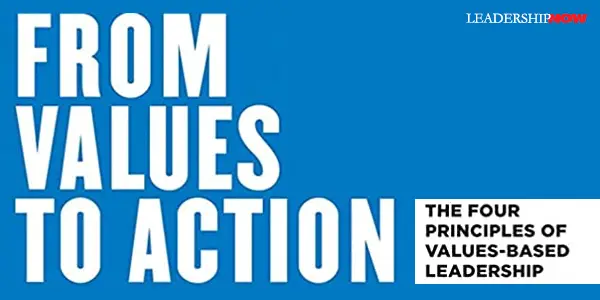
FORMER chairman and chief executive officer of Baxter International, Harry Kraemer, has written a genuine, back-to-basics book on value-based leadership: From Values to Action. He presents four interconnected principles that build on and contribute to each other: Self-Reflection is the most important and is central to your leadership. “If you are not self-reflective, how can you truly know yourself?” writes Kraemer. “If you do not know yourself, how can you lead yourself? If you cannot lead yourself, how can you possibly lead others?” Self-reflection allows you to transform activity into productivity for all the right reasons. It means “you are surprised less frequently.” It is essential in setting priorities. You can’t do everything. So reflection makes it possible to answer key questions like What is most important? and What should we be doing? in a way that is in line with your strengths and values and organizational goals. Engaging in self-reflection on a regular, ongoing basis (preferably daily) keeps you from becoming so caught up in the momentum of the situation that you get carried away and consider actions and decisions that are not aligned with who you are and what you want to do with your life. Balance and Perspective is the ability to understand all sides of an issue. Pursuing balance means you will have to grasp the fact that leaders don’t have all the answers. Kraemer says, “My task was to recognize when a particular perspective offered by one of my team members was the best answer….Leadership is not a democracy. My job as the leader is to seek input, not consensus.” Because he believes we are more effective if we balance all areas of our life, he prefers the term “life balance” over “work-life balance.” It’s not an either-or proposition. “When you identify too closely with your work, you can easily lose perspective and become unable to look at all angles in a situation.” He recommends implementing a “life-grid” to keep track of where you are spending your time and to hold yourself accountable. True Self-Confidence is know what you know and you don’t know; to be comfortable with who you are while acknowledging that you still need to develop in certain areas. (Comfortable not complacent.) Why TRUE self-confidence? There are people who adopt a persona that might make others think that they have self-confidence, but they are not the real deal. Instead, they possess false self-confidence, which is really just an act without any substance. These individuals are full of bravado and are dominating. They believe they have all the answers and are quick to cut off any discussion that veers in a direction that runs contrary to their opinions. They dismiss debate as being a complete waste of time. They always need to be right—which means proving everyone else wrong. Genuine Humility is born of self-knowledge. Never forget where you started. “Genuine humility helps you recognize that you are neither better nor worse than anyone else, that you ought to respect everyone equally and not treat anyone differently just because of a job title.”
Kraemer describes a values-based leader well: “Self-reflection increases his self-awareness. Balance encourages him to seek out different perspectives from all team members and to change his mind when appropriate in order to make the best possible decisions. With true self-confidence, he does not have to be right, and he easily shares credit with his team. Genuine humility allows him to connect with everyone because no one is more important than anyone else.” From Values to Action is an outstanding book and filled with important concepts that any would-be leader would benefit from. 
Posted by Michael McKinney at 04:13 PM
03.18.11

5 Leadership Lessons: The Velocity Manifesto In today’s high-velocity environment, Scott Klososky believes you need to understand how to guide your organization in the implementation and usage of technology—in short, how your organization “does” technology. [As a leader], you—not the IT department, nor the VP of IT, nor the chief information officer (CIO)—must understand, drive and be accountable for how technology is structured in order to reach the strategic goals of the operation….Technology enables velocity—the speed of getting products to market, the speed of delivery, the speed of analytics, and the list goes on. Speed is our friend in almost every case. An organization’s digital plumbing is what facilitates this speed, and it has become the single most important variable for success in many organizations.The Velocity Manifesto 
Posted by Michael McKinney at 04:54 PM
03.10.11

A Case for Reconsidering the Way We’ve Always Done It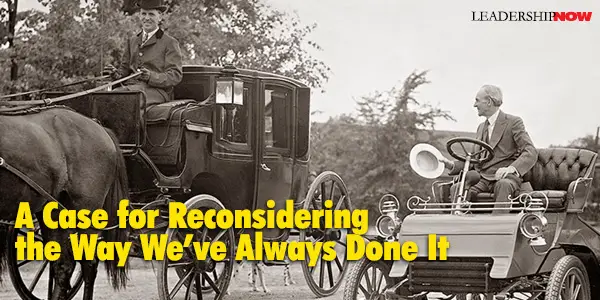
S SOCIETY that doesn’t train their children to think critically, to be aware of those around them, and to serve, must create more rules and regulations than can be accounted for. There will never be enough rules—there are too many variables—especially when people begin to direct their creativity in dysfunctional ways. The challenge is to develop sound minds. As Kant determined, a person with a sound mind is one that can think for oneself, is able to place oneself in the place and viewpoint of others, and can think consistently and coherently. But it‘s easier, in the short term, to create rules. And we pay a price. To be sure, I am not advocating anarchy—we absolutely must have rules—and some rules unquestionably make possible the learning process, but when the rules we have in place reflect our lack of engagement, they become disrespectful and de-motivating. It’s easier to lay down the law or set up a checklist than it is to explain the why; to communicate where we’re headed with this idea. From time to time, it is good to think about the rules we have created (or have had handed down to us), that are impeding progress, relevance, imagination, and growth both for ourselves and others. Here are a few thoughts to guide that process: I am a big advocate of tradition, but when “that’s the way we’ve always done it” or “that’s how I learned to do it” gets in the way of relevance or growth, we need to take a step back and reconsider our stand. What we have done may have served us well in a particular place and time, but may only be an irritation here and now. Rules can reveal a lack of trust. “I don’t trust you to be as smart—considerate or creative—as I am.” And they never will be if not given the chance. As leaders, we need to be aware of where we are blanketing people with rules and procedures that do nothing more than to serve us and not the people it is our intention to serve. We need to consider that perhaps we have implemented rules to create a comfort zone for ourselves. A world where people act and think like we do. A world of clones. A world on autopilot that requires less of us. Often our need for rules and procedures is just masking our fear of the unknown. Our attempt to manage a world that is changing faster than we are learning. No leader can do it on their own and rules are no substitute for not trusting, growing and building relationships with people. Where are we hiding behind rules? Rules, for the most part, do not leverage other people’s strengths and thinking, they mostly mirror our own. Given the chance, people will surprise us with new, different, and better ways to push our agenda forward.
Posted by Michael McKinney at 11:43 AM
02.22.11

Leading As One: Generating Collective BehaviorTo be successful in the world we’re entering, we will need a new set of mental models. While these new models should not exclude the possibility of commanding and controlling, they need to encompass a much wider range of possibilities.The challenge facing any leader is turning individual action into collective power. In short, getting people to act as one. As One by Mehrdad Baghai and James Quigley, is the result of a two year research project conducted by Deloitte Touche Tohmatsu Limited, to understand this common leadership challenge and to answer the question, “What leads to effective collaborations in a wide range of fields?” Not just working together, but working as one. As we talk about leadership it is easy to confuse ends and means and seek collaboration for collaborations sake. The authors note that collaboration "is a means to an end, not an end in itself, and that because the purposes might be different you might need different styles" of collaboration for different situations. Thus we find successful leadership comes in many different shapes and sizes. They believe real leadership is about productivity, people and purpose—or As One Leadership—“leadership that results in a cohesive group of people working together effectively toward a common goal or purpose.” Initially the task is identifying which people need to be involved (the Who) and what purpose they need to satisfy (the What) and then How do we need to collaborate to get the results we seek. 
What emerged from the As One Flagship Project was the identification of eight models or archetypes of As One behavior. Arranged around two axes: a vertical axis that describes how power is exercised in an organization from emergent to directive and a horizontal axis that conveys the nature of individual’s tasks and outlines how work is organized from highly scripted and uniform to highly creative. 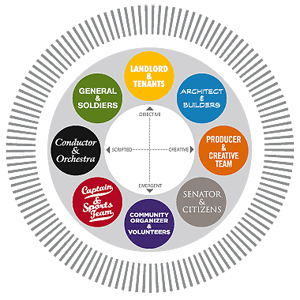 Not surprisingly, these archetypes reflect both top-down and bottom-up styles. The analysis is very balanced. In the descriptions that follow, you can see that different kinds of organizations or situations with different kinds of objectives call for different kinds of leadership. It is enlightening to identify your type of organization and the related leadership approach. The book presents case studies of each type, an explanation of the key characteristics, and a discussion of what you can do to be better at that type. Not surprisingly, these archetypes reflect both top-down and bottom-up styles. The analysis is very balanced. In the descriptions that follow, you can see that different kinds of organizations or situations with different kinds of objectives call for different kinds of leadership. It is enlightening to identify your type of organization and the related leadership approach. The book presents case studies of each type, an explanation of the key characteristics, and a discussion of what you can do to be better at that type.
The Deloitte Center for Collective Leadership was launched in January to advance the study of the As One Collective Leadership discipline and As One behavior. Through research, data collection, and analysis, this center will help define and increase knowledge in the exciting and dynamic field of collective leadership. If you are wondering what your model is, they have created an online As One Classifier tool to figure out which archetype is closest to your current situation. THE EIGHT ARCHETYPES The four main archetypes are: Landlord & Tenants: The Landlord & Tenants pairing is based on landlords’ top-down driven strategy and power: they control access to highly valuable or scarce resources. Landlords decide how to generate the most value for themselves and dictate the terms of participation for the tenants. Tenants voluntarily decide to join landlords, and it’s usually in their best interests to do so. However, once they do, landlords define the rules of participation. Landlords maintain their power by ensuring the best tenants are rewarded, so that, over time, as the number of tenants grows, the landlords’ power increases. Community Organizer & Volunteers: The Community Organizer & Volunteers pairing is based on volunteers’ bottom-up, autonomous, independent, decision-making ability and their desire to voice their opinions. Community Organizers ignite volunteers’ interest through compelling storytelling and opportunities for volunteers to join in. They may have little direct power over the volunteers, but they can tap into volunteers’ interests by gaining their trust, promoting a strong brand, and understanding their motivations. Volunteers themselves are drawn together by a rallying cry, or out of a sense of enlightened self-interest; they gain their power through a strength-in-numbers approach. Conductor & Orchestra: The Conductor & Orchestra pairing is based on highly scripted and clearly defined roles that focus on precision and efficiency in execution as defined by the conductor. The orchestra members, who have similar backgrounds, need to be fully trained to comply with the requirements of the job, and, therefore, must be carefully selected to ensure they fit the strict culture and scripted tasks. Belonging to the orchestra provides members with the best way to make a living while focusing on tasks at which they excel. Producer & Creative Team: The Producer & Creative Team pairing is typically about producers providing their creative team with the freedom to do their best work and reach their natural potential. This pairing is led by legendary, charismatic producers who bring together a team of highly inventive and skilled independent individuals to achieve the producers’ objective. Producers guide the vision and overall progress, while the creative team develops ideas through frequent meetings and interactions using an open culture of collaboration. Dissent is used to push creative boundaries. To maintain longevity in their industry, producers and creative teams need to continuously produce new and innovative ideas. The four hybrid archetypes combine the characteristics of the adjacent pairings and occupy the spaces between the axes. General & Soldiers: The General & Soldiers pairing has a command-and-control-type culture combined with a multi-level hierarchy organized around the general’s clear and compelling mission. Soldiers’ activities focus on clearly defined and scripted tasks. They are motivated by advancing up the hierarchy through well-defined roles at all levels. Soldiers undergo extensive training to understand the army and its culture, and to learn specific skills. They are committed to the mission, the overall institution, and each other, while the general provides strong top-down authoritarian direction to motivate and direct them. Architect & Builders: The Architect & Builders pairing focuses on the creative collaboration between groups of diverse builders that have been recruited by visionary architects to bring a seemingly impossible dream to life. Their visions are so innovative and ambitious that they can’t be achieved simply by using conventional means, so builders often need to reinvent and rethink ways to achieve them. Builders strive to meet ambitious deadlines and milestones mapped to deliberate workcycles. As each milestone is completed, the builders become one step closer to bringing the architect’s dream to reality. The Architect & Builders hero story is based on the development of the world’s cheapest car, the Tata Nano. Captain & Sports Team: The Captain & Sports Team pairing operates with minimal hierarchy and acts like a single cohesive and dynamic organism, adapting to new strategies and challenges with great agility as they appear. Members of the sports team have a strong shared identity. They have extensive and networked communication channels, and carry out the same highly scripted, repeatable tasks. There is strong camaraderie and trust among the sports team – the collective good outweighs the needs of the individual – while captains are there, on the field as part of the team, to motivate and encourage. Senator & Citizens: The Senator & Citizens pairing is based on a strong sense of responsibility to abide by the values or constitution of the community, which have been outlined by the senators. Sovereignty is held by both senators and citizens, and the citizens thrive on the values of democracy, freedom of expression, and autonomy. Since citizens are autonomous, the community structure is flexible. There is no set framework or direction organizing the citizens. Instead, much of their direction is emergent as they gather ideas and collaborate with other citizens. Senators are the guiding intelligence for the citizens and oversee decision making for the community. There is no one size fits all archetype and each archetype is more nuanced than described. Putting As One into practice consists of three steps: First, a diagnostic to assess the who and to do what and then determine the how or what archetype is being used. Second, determine the type of intervention to strengthen the archetype being used or to create a new approach and third to adopt the approach across the organization and applying different archetypes in different situations even in the same organization. It is an interesting study that begins to create a broader understanding of what it takes to lead at all levels as opposed to the common polarizing either/or discussions of command and control versus collaborative leadership. It also helps to dispel the myth that top-down leadership is synonymous with command and control. 
Posted by Michael McKinney at 12:11 AM
02.18.11

Making the Transition From Bud to Boss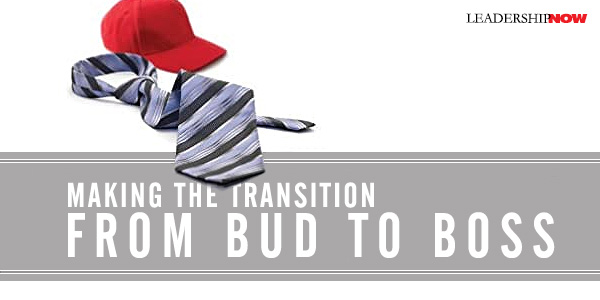
OFTEN, when we are given a formal leadership role a couple of questions come to mind: Will they take me seriously? and How can I develop the influence I need to do this job? A promotion changes the scope of the kinds of things we have to think about. It changes the degree to which we have to regulate our behaviors, conversation and opinions. In short, it changes our relationship with everyone around us. How will we handle it? What about old friendships? They’re all watching us. It can make us feel a little anxious and insecure. From Bud to Boss is written for that moment. It is designed to get you pointed in the right direction and engaging in productive behaviors and thinking. Authors Kevin Eikenberry and Guy Harris have organized this book around six key areas of concern:
What they offer isn’t counterintuitive, they’re just things that we forget to do or find difficult to do and so we don’t. But ignoring them affects our ability to lead. This is an action-oriented book and is extensively supported by the Bud to Boss community on the Internet. To help you get your foundation for leadership in balance, Eikenberry and Harris discuss the impact of your leadership style: In your leadership style, you probably have a natural “lean” that is a little more toward getting things done or toward people and relationships. One major key to leadership success lies in learning to compensate for the way you learn so that you stay balanced between getting things done and building relationships. This is a key point. You need to become more self-aware. You will be judged for results, but if you try to get those results without maintaining the respect of those around you, you will ultimately fail as a leader. So often when we get into a position of authority we begin to think, “How can I get these people to do what I want?” The question seems innocuous enough, but the danger is that it can lead us to focus on controlling others and forget that the task of leadership is to influence others. The authors suggest turning the focus of the question around: “How do I change my words and behaviors so that I communicate with my team more effectively?” or This kind of thinking places responsibility where it should rightfully be. You. They write, “Control what you can. Influence who you can.” From Bud to Boss provides direction and tools that will allow you to take the right action and build confidence—the essential forward momentum you need to be successful. It should go without saying, but it is said, so I’ll mention it. No book, speech, or coach will ever be able to cover everything you could need to know. Because the players are all different, it isn’t possible to address everything specifically. So the trick for us is to get the general principles down and learn to apply them. That’s really what good books, speakers, and coaches try to do; give you principles and tools that you can learn to apply properly in the situations you face as they come up. That’s what From Bud to Boss does well. The rest is up to you. 
Posted by Michael McKinney at 08:35 AM
02.11.11

Taking Another Look: Leading Minds on Reflection Part 4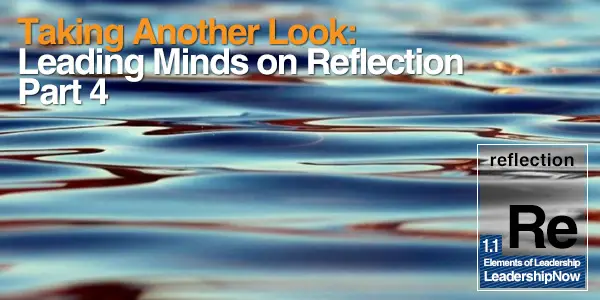
In the final part of this series, Marshall Goldsmith explains the relevancy of reflection in today’s world. It has always been a vital ingredient to success, but it becomes critical in the age of the knowledge worker. Jeremy Hunter teaches courses on The Practice of Self-Management at The Peter F. Drucker and Masatoshi Ito Graduate School of Management. He emphasizes a focus on reflecting in real-time—in the present—in order to align both our intentions and behaviors so that we might bring about the results we seek.
I believe that the process of reflection is more important today than ever before. I also believe that it is more challenging. We live in the age of the knowledge worker. Peter Drucker defined knowledge workers as 'people who know more about what they are doing than their boss'. Knowledge workers need to think and reflect. They have to listen and learn. They cannot just 'do what they are told', since their managers know less than they do about what they are doing. On the other hand, we live in a world of constant stimulus. Our minds are barraged by media of all forms. Cell phones, emails, text messages, and personal computers have reduced our already-limited attention spans. One of the great challenges for the knowledge worker of the future is finding the time to think - in a world that is screaming at you to act.
When we think of “reflection” it tends to be retrospective. Where I think my work is a bit different is that I focus on what a leader is doing right now as it is happening––reflection and awareness in the moment. Most people's immediate action will very likely be an automatic non-conscious process that they're not aware of. Throw in a little stress and emotional reactivity and people find themselves doing and saying things that are destructive to themselves, others, and their goals without understanding why nor knowing what to do about it. The big issue is that the retrospective analysis alone can’t necessarily change a person's immediate habits. Science tells us that 90% or more of the brain’s activity is automatic and non-conscious. However, we have a worldview that focuses largely on conscious processing, we think that having the answer makes change automatically happen. A friend might say, “You know, Ruth, when you’re confronted with a challenge from a superior, you react too strongly.” OK, now Ruth knows that. We assume that just because Ruth knows what she does, she will change it. But there’s a whole other process that has to happen to change the wired-in, non-conscious, automatic pattern. Ruth may be 100% aware of what she does but then the trigger happens and it plays out in the same way. And then it’s, “Oh no, I did it again.” Change happens in the choices we make right now. So my interest is in, how you actually retrain the brain by interrupting that automatic habit and doing something differently. You may have to do it over and over again but at some point, the rewiring function will happen. And that’s a function of interrupting that immediate non-conscious habit and doing something different. I give people a model of this process from the triggering moment of contact to the final result. All along there are intervention points. Of course, the earlier you can intervene, the better. Not everyone can interrupt the process early on, but what I emphasize is that you just need to interrupt it somewhere. And the more practiced one gets at it, the earlier you can see what is happening. It’s really about becoming more conscious about what you are doing, why you are doing it, what result do you want and do these behaviors get you there, and if they don’t, what do you need to be doing instead? You always start with the repeated unwanted result. What’s the thing that keeps happening that you don’t want? For example, Ruth might say, “I notice that whenever I’m confronted, I fight back too aggressively or I get too hostile.” So now she knows that about herself and that’s the reflective piece. Now, let’s tie that reflection to action. The next step is to build awareness of when and how that habit plays out. For example, “I have this meeting with my boss and I know he’s upset about something. What is it I do that might push back too hard, that gets me in trouble?" And so in that moment, she's bringing attention to all the things that happen automatically--what is she doing? What is she feeling in the body? Tension? Pressure? What emotions are arising? What are the stories in her head? Directing her attention to her internal experience creates the awareness of the non-conscious habit. She now has the opportunity to step outside all those automatic reactions and make a different, more conscious choice. We’re tying the process of reflection to immediate behavior. Again, change happens in the choices we make right now. As people are increasingly “burned out” from the stress and uncertainty of the economic reset, it’s too simplistic to just return to basic vacation policies, doing little to introduce meaningful distinctions between home and work. When the workday rarely ends, given technology’s ability to engage employees any time and anywhere, sabbaticals offer a refreshing moment to simply pause. Sabbaticals lead to people stepping back to see their work and creativity through a different lens. —Daniel Patrick Forrester, Consider
More in this Series:
Posted by Michael McKinney at 11:14 AM
02.10.11

Taking Another Look: Leading Minds on Reflection Part 3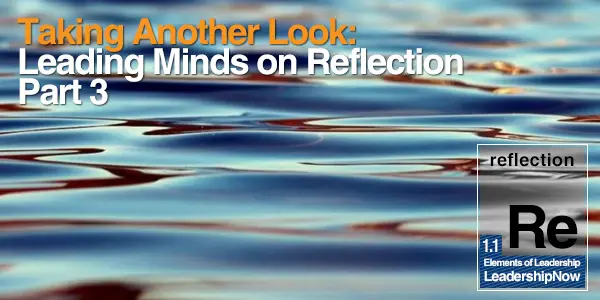
In part three of this series, James Strock talks about the importance of taking time “off” from one’s customary activities. He also gives insight into gaining perspective through reflection. Mark Sanborn talks about the essential nature of making time to think so that we might learn and gain insight from our experiences. He lists some areas we should be thinking about so that we might get the most out of our time reflecting.
There is nothing more important—or more easily overlooked—than making time for disciplined reflection. Indeed, it should be scheduled—and protected and enforced—with the utmost seriousness. Religious traditions include notions of a Sabbath, a day of rest and reflection. It’s a recognition that taking time “off” from one’s customary activities is necessary to fulfill one’s obligations, to perform effectively over time. It’s also an act of humility, pulling people away from a prideful presumption of the significance of their personal contribution and control when it tends toward isolating, habitual overwork. It’s surely not a coincidence that so many of the greatest leaders have been noted for multiple interests. Winston Churchill was active as a painter, speaker, historian, and commentator on current events. Theodore Roosevelt was, in the memorable description of Brander Matthews, “polygonal.” George Washington and Abraham Lincoln maintained perspective through theatre. Though it would be an error to say that effective leaders have “balanced” lives at any given moment, they tend to bring a number of interests to bear—thereby increasing their capacity to see things from various perspectives and to discern and appreciate the contributions of others. In business, one thinks of Bill Gates’ semi-annual, week-long sabbaticals for study and reflection. Many enterprises—from Google and GE to sports teams—encourage regular meditation or related mental exercises. To the extent each day can be seen as a sort of lifetime in itself, meditation or prayer can also be viewed as a sabbatical of sorts. In my personal experience, travel can be invaluable. Simply being pulled out of one’s daily routines and habits, and being inspired by new surroundings, can be mentally and spiritually invigorating. You may see familiar notions with new eyes. Though disciplined reflection has always been important for leadership, it’s arguably more important now than ever before. In the 21st century, information and data are often ubiquitous. The value added by leaders—either in high positions or not—increasingly arises from those invaluable intangibles: judgment and insight. Both of those are more likely to be found with disciplined reflection. And there’s no better place to start than from history and the observations and experiences of others, such as is offered so notably by LeadershipNow.
Someone once said if we don't slow down occasionally nothing good can ever catch us. I think that sentiment applies to the good that can come out of reflection. One of the reasons we don't learn—truly internalize lessons—and keep making similar mistakes is that we don't pause long enough to gain any insights. Most of the busy and successful professionals I work with—and myself included—can go for long periods of time without actively thinking. We reactively think—response to questions, problems, opportunities, etc.—but don't make time to proactively think. I frequently say that nobody has time for anything; we make time for what is important. So often we live life by default and let circumstance and the demands of others determine how we spend our time. I believe we need to make time for reflection. We make time when we priorities, eliminate and adjust our schedules. Specifically, I think leaders should reflect on:
Reflection usually requires "getting away" whether that requires a physical relocation to a peaceful thinking spot or simply blocking time to avoid interruptions.
There is a hierarchy of communication we all practice, in which electronic and immediate data responses reign far above in-person and more time-intensive, dialogue-driven interaction. The trade-off is easy to make: we gain speed, immediate connection, and reactions while giving up richer contexts that emerge only when we take time to think. There are times when the arrival of each new electronic message or data-driven distraction has become a digital proxy for the sound of a bell once used by a doctor named Pavlov. —Daniel Patrick Forrester, Consider
More in this Series:
Posted by Michael McKinney at 10:58 AM
02.09.11

Taking Another Look: Leading Minds on Reflection Part 2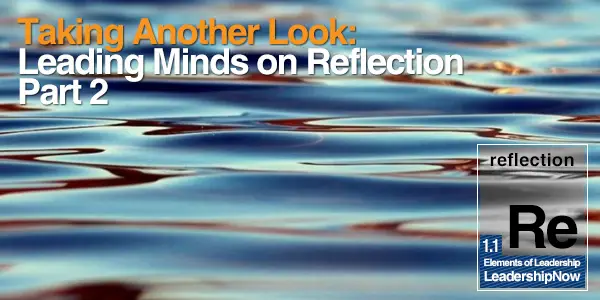
In part two of this series, Tom Asacker philosophizes about the nature of reflection. His insights help us to understand that until we start to see our connection to reality, core changes rarely happen. Have we given the proper consideration to the impact of what we do? Then, Brian Orchard emphasizes the need to slow down enough to absorb what we are experiencing. He talks about the need to take a second look to gain understanding and the importance of getting counsel in decision making.
I’ve noticed something interesting of late. I’ve been spending more time reflecting on my work than passionately involved in the doing of it. To an outsider, it may look like idleness. In fact, history informs me that it’s a necessary prelude to meaningful change, to boldness and growth. Our work should be designed to move us forward, toward a worthy ideal, meaning, and a better life. But in order to get there, we must occasionally pause from its narcotic effect and critically evaluate its impact on our happiness and well-being, and its resulting influence on our community and environment. We must sit quietly and reflect. Reflection is not daydreaming. Reflection is imaginative inquiry; it’s an internal dialogue that asks, Am I making a difference? Is this the best that I can do? Will people be advanced by my efforts? Will my children be proud of my actions? Yes, there is boldness in action. But we must follow action with quiet reflection for that boldness to remain relevant and vibrant. Elbert Hubbard wrote, “The reason men oppose progress is not that they hate progress, but that they love inertia.” Reflection is the path to progress. Imaginative reflection breaks the powerful grasp of inertia—the desire to stay the course regardless of the impact on our lives—and moves us courageously towards our higher potential.
This quote from the Guardian summarizes for me, where we are at: “Although, because of the Internet, we have become very good at collecting a wide range of factual tidbits, we are also gradually forgetting how to sit back, contemplate, and relate all these facts to each other.” And so, as Carr writes, "we're losing our ability to strike a balance between those two very different states of mind. Mentally, we're in perpetual locomotion." From my experience as a minister, I have found that an issue is rarely understood well by the first exposure to it. Our first response is usually weighted by whoever presented the issue. It takes time and thought to slowly come to a more complete understanding. The value of reflection in this case allows for a deeper understanding to be obtained by thinking about the issue and allowing it to be seen from a number of angles. There are two biblical principles that to me, support reflection. First, Proverbs 18:17 states, “The one who states his case first seems right, until the other comes and examines him.” We all have the tendency to accept the first version of what we hear, but the concept of “searching” carries the idea of talking and asking questions, but also thinking about the situation and the reconsidering of fundamental assumptions. The second is simply the whole idea of seeking counsel. This must mean a certain amount of reflection and counsel has a strong bearing on decision making. Devaluing reflection while expecting constant growth and innovation is nonsensical. It’s only when we step away from the onslaught of the day that a new direction arises (good or bad). By never stepping away and, instead, insisting on constant connectivity, you can’t be sure if what you are working on will prove you to be relevant in the future. —Daniel Patrick Forrester, Consider
More in this Series:
Posted by Michael McKinney at 10:43 AM
02.08.11

Taking Another Look: Leading Minds on Reflection Part 1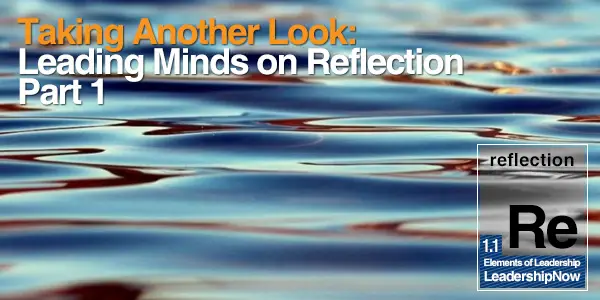
John Kotter begins this series on reflection by talking about the need to develop a reflective habit and why we don’t. Are we spending our time on the right issues? Are we delegating issues we should not be working on that could be better dealt with more locally in the organization? Kotter also stresses its importance as a continual learning tool. John Baldoni urges us to make the time to reflect to gain perspective. He reframes reflection as an action step, not a passive process.
In a world that is moving faster and faster, and changing more and in larger leaps, learning becomes a gigantic issue. Doing what you know is not enough. And learning cannot come in a classroom once every 2 years. That’s too little too late. Learning has to be an ongoing process, literally all the time. People learn in many ways. Reading really good books can help. Talking to really good people can help. Nothing wrong with going to a Harvard executive education program, but there is no better teacher than reflection on the world, and especially one’s own actions. I did X. It produced Z. But is Z what we really need? And why did X create Z? And what were the other alternatives? And can I find others (in books, discussions, HBS) that tried those other alternatives? Obviously, self awareness makes this easier. If I pay no attention to what I am really doing, what it is really producing, it’s hard to reflect on that. One can be both action oriented and reflective. Action oriented means when you know what to do and you do it. Now. Not next quarter. Let’s go. Reflection means using the time on airplanes, when you’re not on the slopes or with family at the ski lodge, Zenning-out on the beach—whatever—to think. People don’t reflect because they have no time, but usually because they don’t delegate enough, let others delegate up to them, or don’t have the staff they can delegate to—all correctable problems. People don’t reflect because they haven’t—so they have no reflective habit, so to speak. Correctable too. Since the end game is life, not one’s job, all this is not only applicable to life in general but is arguably more important for life in general. And since leaders have the capacity to help or hurt us all a great deal, everything I have said here is very important in their case.
Reflection is a powerful tool for leaders, and one that is much underused. The chief reason is perceived lack of time. I remember asking the late Skip LeFauvre, the man who ran Saturn, how he found time for it. He said, "Put it on your schedule." Reflection is a means of gaining perspective. It challenges you to think where you are now and where you might want to go. How to get there is a good thing to consider during reflection.
Constant change doesn’t lend itself to instantaneous insights through simple phrases like “too big to fail,” and “liquidity crisis.” The question we must ask ourselves is this: In the midst of dramatic and extreme change, has decision making devolved into merely informed chaos, or can we imbed reflection and think time into our habits and routines to arrive at better outcomes and understanding? —Daniel Patrick Forrester, Consider
More in this Series:
Posted by Michael McKinney at 01:47 PM
02.07.11

Consider: Harnessing the Power of Reflective Thinking in Your Organization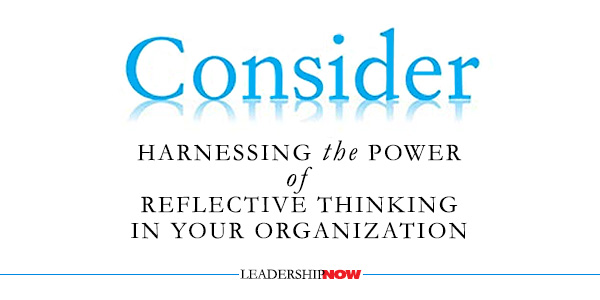
PETER SENGE, founder of the Society of Organizational Learning and senior lecturer at the MIT Sloan School of Management, once observed, “Most managers do not reflect carefully on their actions.” Most managers are too busy “running” to reflect. While reflection seems to have no place in a competitive business environment, it is where meaning is created, behaviors are regulated, values are refined, assumptions are challenged, intuition is accessed, and where we learn about who we are. Some of the greatest barriers to getting the results we want lie within us. Growth happens when we stop repeating our habitual patterns and behaviors and begin to see things in a new way and in the process, discover the power to create the results we want. That makes Consider: Harnessing the Power of Reflective Thinking in Your Organization, one of the most important books you’ll read this year. Author Daniel Patrick Forrester states, “Stepping away from the problem—and structuring time to think and reflect—just may prove the most powerful differentiator that allows your organization to remain relevant and survive…. The best decisions, insights, ideas, and outcomes result when we take sufficient time to think and reflect….Only by carving out think time and reflection can we actually understand, in an entirely different context, the actions we take.”He defines think time as “the purposeful elevation of chunks of our work time, forged within densely packed schedules. It forces the consideration of core significant and pending decisions, outside of cursory overviews and immediate response…. Reflection is the deliberate act of stepping back from daily habits and routines (without looming and immediate deadline pressures), either alone or within small and sequestered groups. It’s where meaning is derived through reconsideration of fundamental assumptions, the efficacy of past decisions and the consequences including the downside of future actions. It’s where space is given for the ‘totally unexpected’ to emerge.” Even if we can agree on the value of think time, we still regard it as a luxury. There’s just no time. But what emerges from Forrester’s research is the fact that we can’t afford not to. It is at the core of what allows a business to thrive. It’s what we don’t know that has a disproportionate impact on us personally and organizationally. We don’t really see the reality we face. Reflection in effect expands our perspectives and thus reveals to us more options and that gets to the heart of what leadership is all about. The point is to make the unseen seen so we can act on it. Forrester interviewed Sarah Sewall who worked with General Petraeus and others to rewrite the military’s counterinsurgency doctrine. Sewall noted, “We are now in a world of increasing specialization, where people get narrower and narrower in their viewpoints in order to become more expert and ‘useful.’ My view is that people become more myopic in how they can think about problems and solutions. We wind up shuttered in our ability to think about possibilities.” This tendency is best counteracted by think time and reflection; being able to back away and incorporate more and varied thinking. Forrester asks, “What is the last document or strategy you can point to as a ‘product of reflection’ built with all parts of the organization and senior-level involvement? If you can’t cite one, it may indicate a culture that values immediacy and the short term over reflection and scalable problem-solving.” Recognizing the need for reflection and actually doing it are two different things. Reflection is a discipline. General Petraeus told Forrester that “he forces bursts of reflection into his day, where he pauses to read, think, and then moves to the next iteration—recognizing that thoughtful insights are not born through real-time analysis.” Forrester suggests that we set time aside for a meeting with oneself. “It isn’t hard to book a meeting with yourself, when you are off-limits to everything but your thoughts.” He notes too, “The power of reflection lies not in how much time we allocate to it. The power of reflection lies in how we choose to use that time and what structure we bring to the fleeting disjointed moments we are afforded.” While some situations required his immediate action, Forrester describes how Lincoln “developed ways to force time to think (if even only for a few minutes) before acting. Even Lincoln had to resist the “instantaneous nature of the telegraph.” Some organizations he has studied have adopted a no internal e-mail Friday policy and other ways to temporarily disconnect from technology. Although these ideas may not work for you, the point is made so that you might consider the impact these technologies are having on the productivity and well-being of your staff. There is always one more e-mail and it will control you if you let it. “When overworked people declare that they ‘just don’t have time to think,’ leaders have a choice: They settle for the status quo and declare that it’s the best way the world works today, or they can insist that reflection is a strategic business enabler,” says Forrester. As an organization, you can either educate for it, make it an expectation—a cultural norm—or treat it as a “do it on your own time” activity and pay the price. Leaders need to understand and demonstrate by example that reflection—taking time to consider—is not wasted time. Reflection is the first step in coming to understand how we are connected to our outcomes. Until we see the relationship between the two, we cannot make deep, lasting change and bring thoughtful behaviors to bear on the situations we find ourselves in. Our thinking creates our reality. If we do not reflect on our thinking we stand to miss our connection to the whole. Consider offers a way to break the pattern of continuous partial attention that seems to be our default position in this technological age. It helps to disrupt the habitual thinking that drowns out the reflective, critical thinking we need to become fully present and effective. Consider isn’t a fad. It is the bedrock of successful leadership and living. Upcoming: I asked some leading minds about the discipline of reflection. So, for the rest of the week, I’ll share their thoughts on this important topic. Look for valuable insights from John Kotter, Mark Sanborn, Brian Orchard, Marshall Goldsmith, John Baldoni, Tom Asacker, James Strock, and Jeremy Hunter.  More in this Series:
Posted by Michael McKinney at 01:57 PM
02.04.11

The Power of Meeting People Where They Are
IN Split-Second Persuasion, Cambridge psychologist Kevin Dutton asks why some of us are better at the art of persuasion than others. He recounts a story about Winston Churchill’s encounter with war hero James Allen Ward that illustrates the power of meeting people where they are:

Posted by Michael McKinney at 10:12 AM
01.28.11

10 Ways to Make Others Shine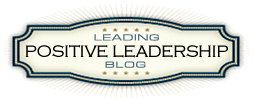 Earl Miller, a neuroscientist at MIT says, “Success has a much greater influence on the brain than failure.” Ned Hallowell comments in Shine: While of course mistakes need to be acknowledged and, one hopes, learned from, it may be more likely, from a purely neurological point of view, that a person will learn more from a success than a failure.” Earl Miller, a neuroscientist at MIT says, “Success has a much greater influence on the brain than failure.” Ned Hallowell comments in Shine: While of course mistakes need to be acknowledged and, one hopes, learned from, it may be more likely, from a purely neurological point of view, that a person will learn more from a success than a failure.”
Hallowell points out that acknowledgment or recognition serves two important functions. Of course there is the familiar purpose of giving the recipient encouragement, motivation and greater confidence, but recognition also promotes moral behavior through connection. Hallowell explains: “When a person feels recognized and connected to the larger group, she knows viscerally, not just intellectually, that she has made a contribution others value. Not only does this motivate her to do more and try harder, but it instills a desire to look out for the larger group…. It leads a person to do the right thing even when no one is looking.” Showing appreciation and giving recognition is part of the Cycle of Excellence process he calls shine. In our busy culture it is easy to overlook opportunities to acknowledge others. Noticing the positive is a daily challenge. In Shine, Hallowell offers these ten tips for promoting shine with the people you influence:
How do you make others feel valued? Related Interest:
Posted by Michael McKinney at 12:06 PM
01.27.11

The Cycle of Excellence: 5 Steps to Peak PerformancePsychiatrist Edward Hallowell says that to bring out the best in people you have to focus on the interaction between what is within a person and what lies outside. Properly aligned, you can achieve peak performance. By peak performance he means “consistent excellence with improvement over time at a specific task or set of tasks.” “While no one has ever achieved the goal of ‘being all they can be,’” he says “everyone has it in them to deliver peak performance defined in that way.”In Shine: Using Brain Science to Get the Best from Your People, Hallowell, combines brain science and performance research to help you get the most out of people’s brains (including your own). To ignite peak performance, he has created a process called the Cycle of Excellence. It is a five step process, that when followed completely, leads to excellence. The steps are:
Unfortunately the modern world works against us. Hallowell has identified two paradoxes of modern life. First, “While we have grown electronically superconnected, we have simultaneously grown emotionally disconnected from each other.” Disconnection short-circuits the Cycle of Excellence more quickly than anything else. “Disconnection is one of the chief causes of substandard work in the modern workplace. But it is one of the most easily corrected.” The second paradox is that “people’s best efforts often fail not because they aren’t working hard enough, but because they are working too hard.” Overwhelmed with data, we try to compensate by working harder trying to process more data. What we should be doing is erecting boundaries to regulate what we allow in. Leaders need to be helping people to regulate their lives and manage technology rather than pushing them to do more. Greater connection and engagement will result. 
Posted by Michael McKinney at 11:50 PM
01.19.11

The Secret of the Great Workplace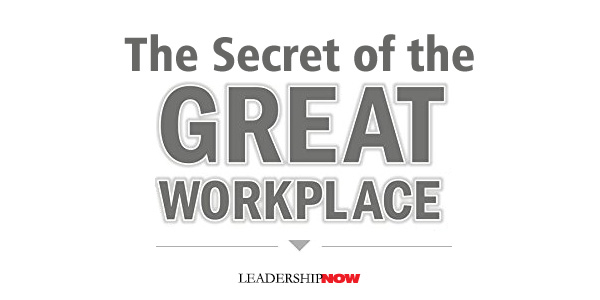
WHAT LEADER wouldn’t want to lead a “great workplace?” I’ve never run across anyone that wouldn’t. So why aren’t we able to point to more of them? I suspect that, in the main, it’s because many of those leaders that don’t lead great workplaces, don’t know they aren’t. They have never taken the time to ask. From their point of view it’s hard to imagine what they could be doing differently. But, it is those you lead that determine whether or not working with you constitutes a great workplace. Even if you are not the CEO, you can create a great workplace around you. To begin, you need to ask, “What is it like being lead by me?” You make the difference. In The Great Workplace, authors Michael Burchell and Jennifer Robin write, “you need to do your job realizing that how you do what you do makes a world of difference to employees.” The secret of great workplaces is relationships. Relationships between employees and their leaders, between employees and their jobs, and between employees and each other are the three indicators of a great place to work. “If leaders implemented practices and created programs and policies that contributed to these three relationships, employees had a great workplace experience.” The important part is that whatever they did, it had to be done in a way that strengthened relationships.When the authors asked, “Why is your organization a great place to work?” a consistent model emerged. (See below.) The employees said “they believe their leaders to be credible, respectful, and fair—they trust them. They also take pride in what they do, and they share a sense of camaraderie with their coworkers.” Because the relationships you create matter, you're the critical difference between a very good company and a very great company. In the best companies, leaders at all levels have a strong commitment to creating strong ties between the employee and the organization. Indeed, enhancing trust, pride, and camaraderie in the workplace is the central task of effective leadership in today’s organizations. They suggest that what holds leaders back from doing something about this is not having the faith that there are bottom-line results from doing the right thing. Another excuse is no time. Lack of situational awareness and the belief that they should just be focusing on the business also keep leaders from focusing on the relationships that really underlie everything they do.
After building a rational business case for the need to create great workplaces, the authors get into detailing each aspect of the model. It is thorough enough to give you a clear way forward in creating a great workplace in your own situation. With anecdotes, best practices, and quotes from employees working at the best workplaces in the U.S., they give the great workplace a tangible shape. At Analytical Graphics, the president compiles a weekly log of individual, team, and organizational accomplishments he hears about, witnesses, or comes across during the week, and he shares those every Friday at the weekly company lunch (yes, all 275+ employees come together for lunch and a short meeting). Whether it is an item he pulled from the local newspaper about an employee’s efforts in the community, or a milestone that a team passed in developing a product, or how teammates pulled together to help one another out on a particular issue, he makes this a consistent practice. And employees feed off this energy. “Friday afternoon,” one employee commented to us, “is always a high. What a great way to start the weekend, and make me excited to come back on Monday morning.” Does your feedback make your people want to come back and do it again? Do you even give timely feedback? >They encourage leaders not to create something completely new and different, but instead to improve upon what you are already doing. Best practices referred to in the book serve to illustrate ways trust, pride and camaraderie might be built in your own situation, but they are culture-specific. Things get in the way of letting people be human. Particularly quarterly reports and business schools. I think what we try to do is make it very clear that what’s important is doing the right thing. And if we do the right thing, all the other things take care of themselves.” The Great Place to Work Institute has found that great workplaces exist regardless of size, industry, or location because the Model is based on universal “needs and values—trust of the people you work for, pride in what you do, and enjoyment of the people you work with.” The Great Workplace Institute is worth a visit for additional resources and information. 
Posted by Michael McKinney at 08:27 AM
12.13.10

Bury My Heart at Conference Room BIn Bury My Heart at Conference Room B, Stan Slap cuts through a lot of the dancing around that occurs in many leadership discussions.It should go without saying that emotional commitment improves organizational performance. If in doubt, Slap spells it out in the first third of the book. The way to get that emotional commitment, says Slap, is for you to live your own deepest values in your work environment. While any organization should encourage this, most often they don’t. “What companies want most from their managers is what they most stop their managers from giving. What managers want most from their jobs is what they most stop themselves from doing.” So, it’s up to you. The process of managing this tension what Bury My Heart is all about. The underlying problem is this: Companies can’t get emotional commitment from their managers because the company believes it needs to be the dominant organism in the relationship, which causes managers to have to repress their own values—and so causes them to detach emotionally from their jobs.Fear drives this tension: Are we going to survive as an organization if we are not in control? Slap says the only sustainable solution is leadership. “Leaders are people who live their deepest personal values without compromise” and because they do, “they’re essentially self-medicated—the pressure’s off the company to provide the deepest motivational fulfillment.” Slap insists that this isn’t licensing chaos but insuring control. Paradoxically, “there is no more reliable way for the company to become the cause than by not always insisting on being the cause.” Allow people to live their values at work. This isn’t a self-indulgent free-for-all. “Freedom to pursue your values come with responsibility to protect the company’s values.” It becomes an issue of trust between the organization and the individual. “Your job as a manager requires achieving results through others. Leadership is the single best method to do that. As long as your vision doesn’t violate the basic objectives and principles of your organization, those results will be hard for anyone to argue with.” Your leadership begins by understanding your own values—what is important to you—so you can sell those values to others. Beyond envisioning a “Better Place” of your creation, the people you lead have to see it too. What does life look like for them in this Better Place? Help them to get what they want as they head toward the Better Place. Slap writes: = Live better. If they believe it, they’ll do it. Of course, not everyone you lead will have the same values as you, but if you have communicated them well, “they’ll support yours if yours have positive impact for them.” Leadership happens to you as soon as you understand your own values and understand how to enroll others in supporting them. Instead of waiting for a leader you can believe in, try this: Become a leader you can believe in.
Posted by Michael McKinney at 11:47 PM
11.08.10

Congratulations, You’ve Reached the Next LevelYou’ve moved up to the next level. You’ve been promoted to the executive ranks. “You should be uncomfortable,” says Scott Eblin in The Next Level. “If you’re not, you are probably underestimating what’s ahead of you.” Statistically, many do. As high as 40% of new executives fail within the first eighteen months of being named to their positions.New positions carry with them greater expectations even if those expectations are not clearly stated. You are left to navigate uncharted territory. The single most important thing to remember is that what got you there may not serve you well in your new position. Going to the next level says Eblin, is “about developing consciousness around what is and isn’t serving you as you take those steps. It’s about retaining what is working, staying open to picking up new skills and mind-sets, and having the courage to let go of the behaviors and beliefs that brought you this far when they no longer serve you on your journey.” Eblin has developed an Executive Presence model that focuses on nine behaviors in three areas that a successful executive should develop on the one hand and drop on the other:
Eblin covers each of these behaviors in detail with insights, interviews, coaching tips and research. But in an important foundational chapter, he talks about grounded confidence. That is, add value but know what you are talking about. “It is critical for your success that you not dwell on thoughts and self-assessments that cause you to doubt your capacity to contribute. There is a certain amount of insecurity that comes with any new position, but “insecure people make lousy leaders.” Insecurity causes us to behave in a lot of counterproductive ways: indecisiveness, micromanaging and control, taking undeserved credit and passing blame, lack of teachability. Eblin says that developing strong relationships with your peers is essential to your success. “Your success in managing relationships will stem from the confidence you have in yourself and your ability to work well with others to make things happen.” This is an area where you need to move quickly. Your new role brings with it an expectation of your involvement in a wider range of issues. This means projecting confidence in your judgment that “extends beyond functional or technical knowledge.” This means also, more listening and less talking. Being teachable. Getting feedback. Of course, there is a lot of confidence to be gained by being prepared—being intentional. Eblin’s approach is to begin with the end in mind. You need to consistently ask yourself two questions: “What do I want to accomplish?” “How do I need to show up to accomplish that?” Practicing new and unfamiliar behaviors can be uncomfortable and seem artificial, but executed repeatedly these behaviors will become ingrained into your character and make them your own. As Aristotle said, “We are what we repeatedly do. Excellence, then, is not an act but a habit.” Feedback Tip: Ask your colleagues this question—What’s your best advice for anyone who is working on team reliance versus self-reliance (or whatever your working on)? Experience shows that it’s useful to ask the question in this format instead of asking, for example—What should I do to be better at team reliance? Asking the question in a less personal way makes it easier for your colleagues to be candid in their feedback. The Next Level is an excellent coaching reference book that makes it an indispensable companion guide to any change in responsibility. Keep it handy and bookmark the Situations Solutions Guide that contains practical solutions to scores of situations that predictably occur in most executive careers.
Posted by Michael McKinney at 07:40 AM
10.15.10

You Already Know How to Be Great
ONE OF the hardest things we will attempt to do is to act on what we already know to do. It’s that difficulty that lies behind much of our search for the next big thing; some way to get around or make easier that which we know we should be doing. It is never easy, but by applying some new thinking, we can get out of our own way. Alan Fine states in You Already Know How to Be Great, that performance improvement is most often an issue of reducing the interference that’s getting in the way of using the knowledge we already have. Fine says that we have to get right the three elements that facilitate the use of the knowledge we already have. They are: Faith: Our beliefs about ourselves and our beliefs about others. High performance is more likely when we believe that we can learn and do better. The absence of Faith could be described as insecurity. Fire: Our energy, passion, motivation, and commitment. High performance is more likely when we are excited about learning and doing. The absence of Fire could be described as indifference. Focus: What we pay attention to and how we pay attention to it. High performance is more likely when we pay attention in a way that will quiet our minds. The absence of Focus could be described as inconsistency. High performance happens when we “get rid of the interference that blocks these natural, inherent human gifts.” Focus is the most powerful tool for removing distractions and, thus, the “most effective way to release Faith and Fire.” If we “create a singular focus on one or more critical variables of the task, we’re far more likely to create the flow state that creates high performance.” More than instructing, Fine believes we would be better off looking to what is blocking Faith, Fire, and Focus in our organizations, performers, families, and teams. Unleashing these qualities facilitates the use of knowledge. As managers, leaders, coaches, or parents, we’re incredulous to think (or more likely, it never even occurs to us to think) that without our excessive instructing, regulating, controlling, directing, and intervening, people might actually be able to perform with greater confidence, more enthusiasm, and more effective focus. Fine introduces the GROW process as a way of creating focus. The process asks: “What is my Goal? What’s the Reality? What are my Options? What’s the best Way Forward? GROW increases Decision Velocity [the speed and accuracy with which we make decisions]. It helps reduce interference, clarify thinking, identify options, and chunk down the challenge into doable tasks. It unblocks Faith, Fire, and Focus and frees people to use the Knowledge they already have. As leaders, we tend to approach most situations by providing more information. We actually nourish the expectation that we are to be telling people what to do when we really need to be working to help them get what’s inside of them out. Fine calls this inside-out coaching. It’s less about providing more Knowledge and more about releasing the Faith, Fire, and Focus that's already there in the performer. It’s more Focus coaching than it is Knowledge coaching. “It’s easy for coaches to get blindsided by what they think people have to pay attention to—to get so focused on the task that they miss the window through which a person can actually pay attention.” “When leaders simply tell people what to do (which is often the case), the result is often a lack of engagement and accountability on the part of the employee and little or no performance improvement. One of the primary observable signs of an outside-in approach is people constantly asking managers, leaders, teachers, or parents what to do.” As a coach, the biggest challenge isn’t the performer; it’s your own interference. You Already Know How to Be Great is about coaching ourselves and others to remove the interference that is blocking performance. It is full of applications of inside-out coaching and the GROW process he advocates. As such, it is an indispensable book for coaches or leaders of all types.

Posted by Michael McKinney at 06:57 PM
09.20.10

Do You Argue With Reality?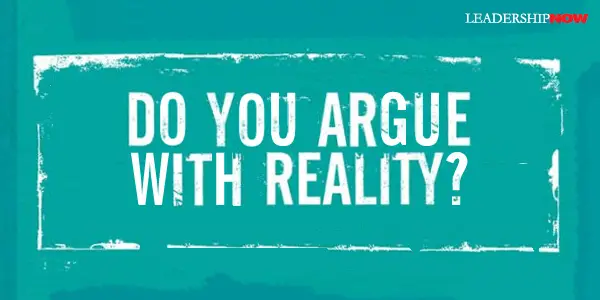
CHRIS THURMAN wrote in The Lies We Believe, “The number one cause of our unhappiness are the lies we believe in life.” Too often, we operate apart from reality. Given a choice between reality and our version of it, we are inclined to choose the latter. It is a central tendency of human beings. The result is drama, not peace. “Instead of getting the results we want,” says Cy Wakeman, “we end up with reasons, stories, and excuses for why things didn’t work out—leading to more drama, disengagement, judgment, and ineffective leadership.” In Reality-Based Leadership, Wakeman presents a much-needed wake-up call. We can ditch the drama by getting in touch with what is. Quit making up stories. Quit arguing with reality. Ditching the stories that are causing us stress. “We all tell ourselves stories and live with the resulting drama.” It sounds like:“I shouldn’t have to do this—it’s not part of my job description.
“You are arguing with reality whenever you judge your situation in terms of right and wrong instead of fearlessly confronting what is.” You need to respond to the facts, not the story you create about the facts. This is easier said than done. Interwoven in our stories are our egos, insecurities, and identities. (At one point Wakeman suggests we ask, “Who am I as a manager or as an employee when I believe this story?”) We like our stories. They make us look better. They place the blame somewhere south of us. If other people are always coming up short in our stories, then it’s all about us. But letting go of our stories is not always easy as we have a lot invested in them. Too often our criticism is about setting us apart from others and not about helping them. It says a lot more about us than it does those it is directed towards. Wakeman says, “When you are judging you are not leading.” In her analysis of the case study about Steve and a team he dreaded working with, she concludes, “his biggest obstacle is his belief that they are a negative group. What if he just dropped that whole story and simply responded to reality directly? The phone rings? Answer it. The team ask a question? Answer it, or teach them where to find the answer. The team share what worked in the past? Listen and lead them into the future. The team requests some time with the leader? Engage with them—lead! When Steve began to lead the team rather than judge and criticize, the team began to change for the better.” She adds, “When you focus your energy on what you are able to give And create rather than what you receive, you are truly serving.” Do you see any applications in what you and involved in? Wakeman insightfully writes: “What is missing from a situation is that which you are not giving.” Operating out of a judging mindset of “I know” or “I am right” effectively shuts down the potential to learn or accomplish anything. Moving on based in reality requires setting the story aside and asking, “If I set the story aside, what would I do to help?” The minute you start judging is the very minute you quit leading, serving and adding value. When you’re in judgment, you are dealing with your story—not with reality. Wakeman suggests that when you get off-track:
What stories are you telling yourself that cause you to operate in your own world? While it may be cognitively economical, it is costing you far more in every other area. 
Posted by Michael McKinney at 03:54 PM
09.15.10

Timeless Advice from a Father to a Daughter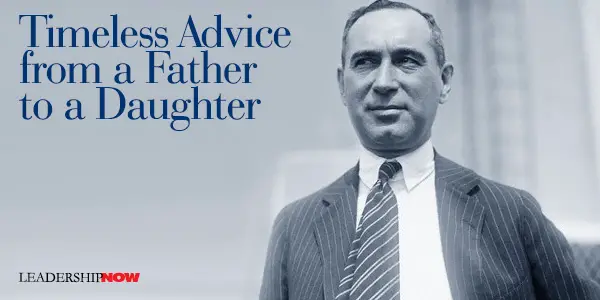
The Man Who Sold America by Jeffrey Cruikshank and Arthur Schiltz was for me, hard to put down. It is the retelling of the inspiring and remarkable life of Albert Lasker (1880-1952). Lasker has been called the “father of modern advertising.” He had an eye for talent and worked with them to transform the advertising agency from mere brokers to a creative force to build businesses. He developed “reason why” advertising—salesmanship in print. He made Palmolive and Pepsodent household names and invented the "Sun-Maid" and "Sunkist" brands. He made millions for Quaker Oats, Goodyear, Frigidaire, Lucky Strike and Kimberly-Clark and in the process made millions for himself. He advanced millions to friends during the Depression (most of the loans were never repaid) and when prudent, loaned money to clients to finance their advertising campaigns. Lasker was a major investor in the Chicago Cubs. He persuaded William Wrigley to join him in investing in the team. To help the chewing-gum magnate sell more product he pushed to change the name of Cubs Park to Wrigley Field. 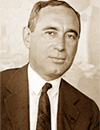 Aided by his personal relationship with many leading businesspeople he “applied the insights he gained in one context to give advice in others.” The legendary David Sarnoff of RCA said of him, “Give him an equal knowledge of the facts and I’d rather have his judgment than anybody else I know.” On October 29, 1935, his daughter Mary came to work for him at Lord & Thomas. He left a note on her desk on her first day of work: My darling Mary,Just One More: In 1938, Lord & Thomas hired the obscure comedian Bob Hope to pitch Pepsodent on the radio. Although Lasker enjoyed making and consorting with the stars—and in one case, marrying them—he remained largely unimpressed with them. One day, the head of Lord & Thomas’ broadcast department reported to Lasker that Hope was grumbling about his contract with the agency. “Mr. Lasker,” the subordinate said, “Bob is very unhappy. He says he just can’t put the show together for $4000 a week. He must have $6,000.” “Just between us,” Lasker replied dryly, “I’d rather have Mr. Hope unhappy at $4000 than unhappy at $6,000.”   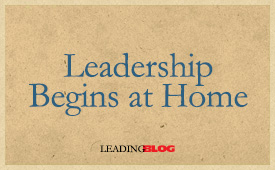
Posted by Michael McKinney at 09:16 AM
09.13.10

It’s Not Just Who You Know—It’s Who You Are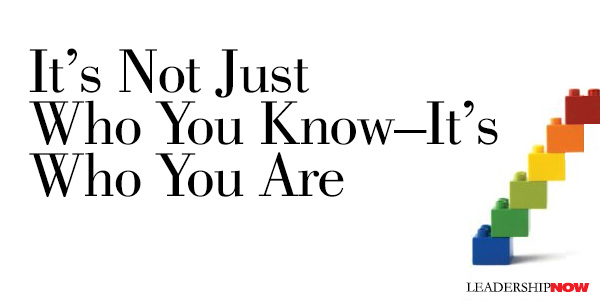
BUILDING relationships is about others. It’s more than networking says Tommy Spaulding. “When a heart centered on others drives your actions, networking is replaced by something far, far more powerful—Netgiving. Networking is all about you. Netgiving is all about others.” It's from this sound perspective that Tommy Spaulding writes It’s Not Just Who You Know. It’s Not Just Who You Know is both an inspiring biography and a lesson in initiative and building genuine relationships. Quite often we meet people and build relationships by chance; Spaulding doesn’t believe we should leave them to chance. He has seen over and over again that “an investment in a short-lived and seemingly random encounter can produce unforeseeable yet significant benefits.” So we need to “develop an attitude of openness” and approach “every person we encounter with an awareness of the hidden potential to develop a relationship.”Spaulding thinks of relationships in terms of a five story building. Level 1 is purely transactional—meet and greet. Level 2 you share basic personal information. Level 3 relationships, while superficial, relationships have developed an emotional comfort level that goes beyond sharing facts, news weather and sports and involves sharing opinions and feelings with others. Level 4 relationships are marked openness and candidness. We respond in ways that show that we value the relationship for its own sake. The relationship reflects an ability to work through and a willingness to at times, put others interests above your own. Level 5 relationships are our closest and most intimate relationships. They are based more on giving than on getting. “They are relationships based on a shared empathy—an intuitive understanding of each other's needs, even those that aren't necessarily expressed…. In Fifth Floor relationships, we become confidants, advisers, and partners in helping the other person achieve their greatest potential.” Spaulding says the goal is to be able to develop the ability to build relationships at all five levels and he offers practical advice for expanding our relationships. It’s not done though through manipulation. Motives matter. Relationships built on getting what you can from others have no lasting value and will more than likely collapse when you need them the most. You can judge your motives by filtering them through the following traits: authenticity, humility, empathy, confidentiality, vulnerability, generosity, humor and gratitude. In building genuine relationships, says Spaulding, who you are is far more important than what you do. Some of his advice:
As important, Spaulding offers five relationship warnings such as choose wisely and the relationship cancer you must avoid at all costs. He says that Dale Carnegie’s How to Win Friends and Influence People taught him how to get people to fall in love with him. But there is more. We can fall in love with others if we remember it’s not about us. It’s not just who you know—it’s who you are. 
Posted by Michael McKinney at 01:08 AM
08.04.10

Are You a Hundred Percent Leader?Research done by Leadership IQ indicates that 77% of leaders believe their employees are not giving 100%. Employees don’t seem to argue the point. 72% of employees admit that they in fact aren’t giving 100%.If you want your employees to give 100%, you need to be the kind of leader that creates Hundred Percenters—a 100% Leader. In Hundred Percenters, Mark Murphy, CEO of Leadership IQ, says that the “two most important differentiating factors in separating exceptional from average leaders are Challenge and Connection.” Challenge is the extent to which a leader pushes his or her people. Connection is the strength of the emotional connection they build with their people. You need to decide how much you want to challenge your people and how tight an emotional bond you want to build with them. The age-old question plaguing leaders is whether it’s better to be loved or feared. What our research seems to suggest is that while fear doesn’t lead to superior results, it’s also true that if being loved means you don’t push people, that’s not so great either. The balance seems to be that leaders should be loved, but they should be loved for pushing people to give 100%, not for coddling or appeasing them.The degree to which you challenge and connect with your people will determine the results you get. Based on their research, Murphy has divided leaders into four basic types: Appeaser, Avoider, Intimidator and 100% Leader. With the challenges leaders face, appeasing, avoiding or intimidating can seem like necessary approaches; the path of least resistance. But they don’t produce fully engaged and accountable people. In practice, the four types are described this way: 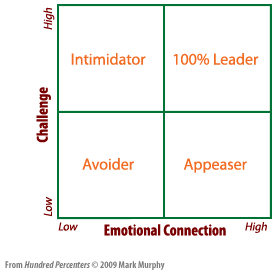 Working for the Appeaser. You’re given enjoyable assignments, you’re allowed to spend most of your time on work that plays to your strengths, your boss gives you lots of positive feedback, and your boss seems to care most about making sure you’re really happy. Working for the Intimidator. You’re given seemingly impossible assignments; you don’t feel like you’ve got all the skills you need to complete those assignments; when your boss gives you feedback, it’s usually pretty harsh and critical; and your boss seems to care most about achieving his goals no matter who’s with him at the end. Working for the Avoider. Your boss doesn’t really force too many assignments on you, you’re not really required to learn new skills, your boss lets you figure out for yourself how you’re doing, and your boss seems to care most about not getting in your way. Working for the 100% Leader. You’re given really challenging assignments, you’re required to learn new skills even in areas you might not consider to be your natural strengths, your boss gives you lots of constructive and positive feedback, and your boss seems to care most about pushing you to maximize every ounce of your potential. What kind of leader are you?
Posted by Michael McKinney at 11:34 PM
06.29.10

Multipliers: How the Best Leaders Make Everyone Smarter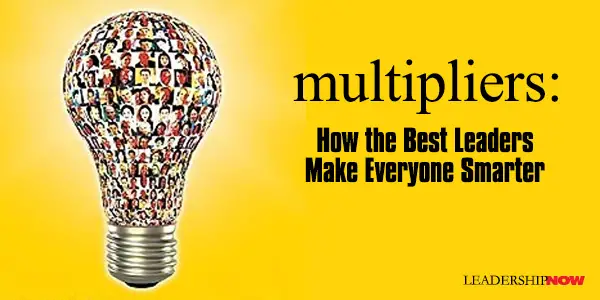
MUCH OF WHAT constitutes good leadership can be summarized in two words: respect and selflessness. How we relate to those two words will determine how we lead. Consider two assumptions that lie at the opposite ends of the spectrum: • Really intelligent people are a rare breed and I am one of the few really smart people. People will never be able to figure things out without me. I need to have all the answers. • Smart people are everywhere and will figure things out and get even smarter in the process. My job is to ask the right questions. What you believe has a big impact on the performance, engagement, loyalty and the transparency you find with those you lead and interact with. In Multipliers: How the Best Leaders Make Everyone Smarter, authors Liz Wiseman and Greg McKeown refer to those with the mindset represented by the first assumption as Diminshers and those with the mindset represented by the second assumption as Multipliers. It explains why some leaders create intelligence around them, while others diminish it. The value of Multipliers is that is shows what these assumptions about people look like in practice and how they are reflected in your behavior. How would you approach your job differently if you believed that people are smart and can figure it out? With a Multiplier mindset, people will surprise you. They will give more. You will learn more. What kind of solutions could we generate if you could access the underutilized brainpower in the world? How much more could you accomplish? It’s not that Diminishers don’t get things done. They do. It’s just that the people around them feel drained, overworked and underutilized. Some leaders seem to drain the “intelligence and capability out of the people around them. Their focus on their own intelligence and their resolve to be the smartest person in the room [has] a diminishing effect on everyone else. For them to look smart, other people had to end up looking dumb.” In short, Diminishers are absorbed in their own intelligence, stifle others, and deplete the organization of crucial intelligence and capability. Multipliers get more done by leveraging (using more) of the intelligence and capabilities of the people around them. They respect others. “Multipliers are leaders who look beyond their own genius and focus their energy on extracting and extending the genius of others.” These are not “feel good” leaders. “They are tough and exacting managers who see a lot of capacity in others and want to utilize that potential to the fullest.” The authors have identified five key behaviors or disciplines that distinguish Multipliers from Diminishers. You are not either/or but are somewhere along a continuum. These are all learned behaviors and have everything to do with how you view people. We don’t have to be great in all disciplines to be a Multiplier, but we have to be at least neutral in those disciplines we struggle with.
They have developed an assessment tool you can use to see where you are. Importantly, the first place to begin is with your assumptions about people. If you don’t have that straight the rest is just manipulation. As with most behaviors, we do them because we feel we have to. They are self-perpetuating. We jump in where we shouldn’t and come to the rescue. Under our “help” (domination) people hold back thereby reaffirming our belief that they just couldn’t do it without us. And they can’t or rather won’t. Instead they quit while still working for us or move on. We see this in ourselves, in others and in organizations of all types. Leaders are especially prone to run over people, because after all, they have the vision, the know-how and the desire to get it done. We have to slow down and remember that we are not there just to get the job done, but to develop others to get the job done. They can (and need to be able to) do it without us. It’s our job to show them how. In many ways, as leaders, we can become accidental Diminishers. The skills that got us into a position of leadership, are not the same skills we need to lead. Leadership requires a shift in our thinking. Wiseman and McKeown write, “Most of the Diminishers had grown up praised for their personal intelligence and had moved up the management ranks on account of personal—and often intellectual—merit. When they become ‘the boss,’ they assumed it was their job to be the smartest and to manage a set of ‘subordinates.’" Here are some thoughts—out of context—from the book that will get you thinking: “Marguerite is so capable she could do virtually any aspect of girl’s camp herself.” But what is interesting about Marguerite isn’t that she could—it is that she doesn’t. Instead, she leads like a Multiplier, invoking brilliance and dedication in the other fifty-nine leaders who make this camp a reality. One leader had a sign on her door: “Ignore me as needed to get your job done.” She told new staff members, “Yes, there will be a few times when I get agitated because I would have done it differently, but I’ll get over it. I’d rather you trust your judgment, keep moving, and get the job done.” The path of least resistance for most smart, driven leaders is to become a Tyrant. Even Michael said, “it’s not like it isn’t tempting to be tyrannical when you can.” Policies—established to create order—often unintentionally keep people from thinking. At best, these policies limit intellectual range of motion as they straitjacket the thinking of the followers. At worst these systems shut down thinking entirely. “It is just easier to hold back and let Kate do the thinking.” [They resign: “Whatever!”] It is a small victory to create space for others to contribute. But it is a huge victory to maintain that space and resist the temptation to jump back in and consume it yourself. An unsafe environment yields only the safest ideas. [Multipliers] ask questions so immense that people can’t answer them based on their current knowledge or where they currently stand. To answer these questions, the organization must learn. His greatest value was not his intelligence, but how he invested his intelligence in others. 
Posted by Michael McKinney at 04:28 PM
06.25.10

Finding the Why of WorkAs most of us spend more time at work than we do anywhere else, work is a universal setting in which we can find meaning in our life. Meaning is the why that motivates, inspires and defines us. The Why of Work by Dave and Wendy Ulrich is a timely and important book. It is about our search for meaning and how “leaders facilitate that search personally and among their employees.”Importantly, they begin with a discussion of the seemingly inevitable issue of deficit thinking. “When employees lose what they have come to count on and expect—be it a person, an income, a position, or less concrete notions like security, identity, or direction—they are inclined to deficit thinking.” “Deficit thinking,” they write, “can lock us into a prison of our own making, a prison dominated by fear, isolation, disorientation, and competition for scarce resources.” We can’t eliminate the hardships, uncertainties and disruptions we sometimes face, but we can change our perspective—find a different meaning. That is where leaders come in. If we focus attention on what we stand to gain from our crisis, not just what we stand to lose, abundance thinking can replace deficit thinking even when deficits are the rule of the day. Abundance looks to future opportunity more than past disappointments, promotes hope over despair, suggests change for the future rather than languishing in the past, and fosters the creation of new meaning where old meanings have broken down. Abundance does not imply that things come easily or quickly but that we can make meaning even in the midst of challenges we face.Leaders need to promote this meaning–making; create repositories of abundance where employees can “gain antidotes to some of the malaise, isolation and crises of meaning” they face. Meaning is not found in events but in the way we interpret those events. This means we are not (or should not) be controlled by what is happening around us, but that we have to consciously work to determine what it means. Dave and Wendy Ulrich have proposed seven questions—and devoted a chapter to each—to help leaders drive the abundance agenda—questions that help leaders make meaning, add value, create emotional energy, and foster hope while at work. 1. What Am I Known For? (Identity) A sense of identity is fostered by a clear sense of who we are, what we believe in, and what we are good at. Our identity is grounded in how we instinctively use our skills in the service of our deepest values. 2. Where Am I Going? (Purpose and Motivation) Abundance emerges from a clear sense of what we are trying to accomplish and why. Employees who can meet their personal goals at work remain motivated and engaged; those who can’t, go in a different direction, physically or emotionally. 3. Whom Do I Travel With? (Relationships and Teamwork) Our sense of abundance is enhanced by meaningful relationships. High-performing teams come from high-relating people. When leaders help their organization “families” move beyond superficialities of getting along to struggle through conflict so that they can understand one another’s strengths and weakness, they can approach the kind of synergy that occurs in the best of human relationships. This means that leaders need to learn and model the skills of building good relationships at work. 4. How Do I Build a Positive Work Environment? (Effective Work Culture or Setting) Abundance thrives on positive routines that help ground us in what matters most. Instead of building routines and patterns that encourage self-reflection, honest sharing, and the kind of consistency that brings people together, many of us build habits, addictions, and compulsive patterns that serve primarily to block out other people. Or, we build few routines at all, leaving us untethered in time and space and making us unpredictable to those who want to connect. Routines and patterns driven by our deepest values help us stay grounded in what matters most and available to those who matter most. 5. What Challenges Interest Me? (Personalizing and Contributing Work) It’s hard to imagine abundance in the absence of challenge. Employees who are competent but not committed will not perform to their full potential. Commitment comes from building an employee value proposition that engages employees to use their discretionary energy to pursue organization goals. Commitment or engagement grows when we work in a company with a vision, have opportunities to learn and grow, do work that has an impact, receive fair pay for work done, work with people we like working with, and are offered flexibility about terms and conditions of work. 6. How Do I Respond to Disposability and Change? (Growth, Learning, and Resilience) Abundance is less about getting things right and more about moving in the right direction. Unlike the assumption of disposability that governs so much of modern society, resilience and learning principles challenge us to “repair, reuse, and recycle” people, products, and programs rather than tossing them. 7. What Delights Me? (Civility and Happiness) Abundance thrives on simple pleasures. The cry for tolerance demands that we outgrow our racial, religious, political, ethnic, and gender stereotypes. The cry for civility also calls upon us to outgrow our we-they, win-lose, right-wrong, blame-and-shame mentality. As we move away from hostility and blame toward problem-solving, listening, curiosity, and compassion, simple civility greases the skids. Delight often comes in small packages, and when money is tight it helps to know that small and simple pleasures spread over time have more impact on our sense of well-being than grand one-time gestures. “Meaning does not ensure ease; it offers hope,” they write. “Abundance emerges from the growing conviction that what we are about ‘makes sense’—that it contributes to something larger than ourselves and that it is grounded in our deepest values. Such conviction does not forestall all problems, but it helps us confront problems with courage and integrity.” Leaders at all levels can help (and have a responsibility to) make meaning happen.
Posted by Michael McKinney at 12:00 AM
05.26.10

The Face Game at ZapposTony Hsieh, CEO of Zappos, has made the company culture the number one priority at Zappos. For them, building community is what it is all about. It has become part of their brand. As he writes in Building Happiness, that while some of the things they do have grown organically, there are a few things that have been more purposeful and planned. One way to help build community is an internal game they call, The Face Game. He writes:In most companies, logging in to the computer systems requires a login and a password. At Zappos, an additional step is required: a photo of a randomly selected employee is displayed, and the user is given a multiple-choice test to name that employee. Afterward, the profile and bio of that employee are shown, so that everyone can learn more about each other. Although there is no penalty for giving the wrong answer, we do keep a record of everyone’s score. We’re always on the lookout for ways to improve our company culture, no matter how unconventional or counterintuitive the approach may be.
Posted by Michael McKinney at 02:53 PM
04.28.10

We Have Met the Aliens and They Are Us
WE live in a time—aided by advances in science and communication—that is obsessed with quantifying, labeling and optimizing. Generational studies are no different. While identifying and labeling the generations is valuable for understanding and discussion, if we are not careful we can lose some connection to their humanity—their sameness. While generational studies can help us to understand where people are at, if want to engage them, we would do well to remember what they are. A generation comes and a generation goes. Each carries with them their own reaction to the former generation that raised them and their own disbelief of the reactions of the next generation to their own. Yet, each generation is not a new subset of humans; a curious new life form that needs to be studied and obsessed over. They are human. They are like us. "That which seems the height of absurdity in one generation often becomes the height of wisdom in another." We do a disservice to any generation when we coddle them and commoditize them. What generation doesn’t want everything just right? But life doesn’t work like that. Our ideals keep us pushing on, exploring, reflecting, and innovating, but our disappointments and the imperfections we uncover, help us to learn compassion and build character. Every generation has difficulties to overcome and excesses to curb. Every generation is faced with the prospect of growing up. And each generation does it from a different perspective. A perspective that they gained from their observation of those that came before them. And they will hand a different perspective, a different emphasis, over to those that come after them. "Parents often talk about the younger generation as if they didn't have anything to do with it." Like us, they are reacting to their upbringing and the world it created and bringing with them an attempt to find some greater idealism. Similarly, they need to learn balance, curb excesses, and rediscover forgotten behaviors and values. They need to learn compassion, the freedom that comes from admitting that you don’t know it all, and the value in what has come before them. No one generation excels completely in all things. All have different pieces of the life puzzle. All begin by placing a different weight on what is important and need to work to find the balance that makes their life more complete. We all share a humanity that spans generations. Human nature doesn’t change. Not everything the previous generation did was bad. Often it was good and necessary, but was executed poorly. We can be thankful that while previous generations were concerned with “work-life balance,” they decided they had better keep their focus on the tiller so that we would have the opportunity to run on the deck, criticize their methods, and endlessly debate whether or not the figurehead represents us well. "When I was a boy of fourteen, my father was so ignorant I could hardly stand to have the old man around. But when I got to be twenty-one, I was astonished at how much he had learned in seven years." A study of generational differences, more than anything, helps us to understand the consequences of our behaviors. What has worked and what hasn’t. Why an over-emphasis on this causes a problem there. If we can learn from it, we profit. However, our natural reactivity causes us to not learn as we should or build on the lessons of those that came before us. Human beings are not hard-wired with the lessons learned from the previous generation. So we all start at the beginning—learning and relearning—in the context of the world we find ourselves in. Each generation must come to the same place at the end of their lives as the one before it. All need to grow up. We need to become practiced at learning from each other; valuing each generation for where they have been, what they are learning, and the perspective they bring. In a more connected world, the consequences of our behavior are greater. We have more reach. What we do affects more people and for longer periods of time. This creates a critical need for wise leadership. Each generation will rewrite their world. Their thoughts and ideals aren’t new. Their emphasis is. “Treat Millennials with respect and dignity. Don’t over-manage them. Make them feel included.” Really? This isn’t generation-specific. We all desire those things. Generational analysis also reminds us that not everyone sees things the way we do. “By understanding other generations’ perspectives,” writes Tamara Erickson in What’s next, Gen X?, “we are better able to position our ideas and requests in ways that are likely to have positive results and avoid at least some of the frustrations of today’s workplace.” There are many good books in print that help to highlight the challenges that current generations face, their perspectives, and how we might learn from each other, and offer points of connection to help bridge the gaps. Here are several:
All generations face the same human issues but from different perspectives and with different tools. But they all look for connection, meaning, and contribution. They all want to add value and feel the satisfaction of a job well done.
Posted by Michael McKinney at 01:28 PM
04.26.10

Leading Outside the Lines: Mobilizing the Informal OrganizationRight now, the informal elements of your organization are either working for you or against you. Yet for most leaders, say Jon Katzenbach and Zia Khan, authors of Leading Outside the Lines, the informal organization is poorly understood, poorly managed, and often disregarded because it is too hard to think about.The formal organization has its own way of attracting, selecting, developing, and rewarding people—but it rarely has the power to affect promotion or compensation. Therefore, those who rise to influential positions in the hierarchy are more likely to be more comfortable with and skilled at using the formal organization than the informal….Informal leaders rarely have the kind of explicit qualifications that can be easily documented or communicated, much less evaluated.The informal organization lies in the human side of the enterprise and as most things that reside there, it is hard. Unlike the formal side with its top-down, rational approach, the informal is fuzzy, constantly changing and hard to measure. So it is understandable that we would like to somehow ignore it or work around it. But, “if you want your entire organization to improvise frequently and energetically in response to fast-moving change, formal management techniques alone won’t get you there. You need help from the informal side as well. Mobilizing the informal organization helps support formal management mechanisms, increasing their chances of success and deepening their long-lasting impact on the organization.” For leaders, the challenge is to find the balance between the formal and the informal elements of the organization in their particular situation, to achieve concrete, measureable results. When trying to make a change, our default tactic is to explain “in excruciating detail why the new plan is important.” We think if they get the logic of it, they will get behind it. But they often don’t. People need an emotional connection. Simply formalizing a new set of rules, programs, and structures will not pull the company's culture along. “To that end, leaders need to be able to translate vision, targets, and strategies into personal purpose, accomplishments, and choices that each one of their people can understand and feel good about pursuing.” The authors make the distinction that while the formal organization is best when dealing with predictable and repeatable work that needs to be done efficiently and without variance, the informal organization is best suited to unpredictable events—surprises that need to be sensed and solved. They add that in many cases, when activity in the informal organization starts to repeat itself, it “is a signal for broader changes that need to be made to the formal organization.” To move beyond “best practices” and the status quo—to get to “best performance”—a leader needs to learn to mobilize the power and plasticity of the informal. What You Can Do Now
Posted by Michael McKinney at 12:05 PM
12.18.09

We Hire For Difference and Fire Because They Are Not the SameBringing true diversity to the workplace is a lot harder than we thought. It is more than just playing Noah and getting the numbers right—two of every kind. But, too often that’s as far as it goes. What is needed, says Laura Liswood in The Loudest Duck, is “more sophisticated leadership, conscious awareness, thought, behavior, and tools to reap the benefits of what true diversity can provide.”Diversity has to be something deeper. True diversity requires a change in attitude and thinking. It requires a change in the way we think about people that are different—age, gender, race, accent, appearance, background, personality, religion or education—than we are. We all have unconscious reactions to people that are different. Liswood writes, “We are not talking about blatant inequities or discrimination in most of today’s professional world (although this still does occur). We are talking about unconscious belief, preferences, values, thoughts, and actions. These are what erode the promise of diversity.” To achieve true diversity, we need to examine what we believe; beliefs that we begin to develop at a very early age and continue to learn and reinforce throughout our lives. “Getting true value out of diversity is much harder than was initially thought….Managing diversity requires heightened emotional intelligence, awareness, observation, and listening skills.” At the same time, Liswood argues, “employees have to take it upon themselves to get out of their comfort zones and learn to adjust to a company’s style, but not in a manner that merely shows compliance.” In today’s environment, whether the loudest duck gets heard or whether it gets its head chopped off, is not only a management issue, but additionally a large part of the responsibility lies with every individual to develop awareness and an understanding of what works and when in their particular situation. Throughout the book she offers tools and approaches to help you stretch yourself in the workplace. The phrase “We hire for difference and fire because they are not the same,” sums up the dynamic very well. The Loudest Duck provides a framework to begin to do the inner work necessary to bring about true diversity. The thing is, if you are not consciously inclusive of everyone, you will unconsciously narrow the type of players in your organization and never reap the benefits of true diversity. Accepting every kind of person is much harder than it sounds because we judge people differently based on our own internal filtering system that tells us what to value and what to ignore or tolerate. That’s where diversity needs to take hold if it is ever going to take hold in our organizations or in our communities.
Posted by Michael McKinney at 12:31 AM
10.20.09

Don't Bring It To WorkWhen people walk through your door in the morning, they don’t leave their problems behind. And that creates problems at work. Problems at home create, at the very least, distractions in the workplace. Many safety issues have been linked to preoccupied employees. The failure to deal with issues that are brought to work can result in high turnover, poor productivity, low morale and poor communication.What you bring to work is not only your problems but the behavioral patterns that, in many cases, caused them. In Don’t Bring it to Work, Sylvia Lafair says that much of what you bring to work are patterns of behavior that are driven by the roles we learned in our families as children. And when the going gets tough, the tough frequently revert to old family patterns. Lafair describes the 13 most common destructive patterns in the workplace — including the super-achiever, the rebel, the procrastinator, the clown, the persecutor, the victim, the rescuer, the drama queen or king, the martyr, the pleaser, the avoider, the denier, the splitter — and explains how they got that way, and how to tell (a Pattern Aware Quiz is included) if any of this baggage from your own background is weighing down your career. The action step is not to break your patterns but to transform them; to become a “better, more developed, more fulfilled version of the person you already are.” For instance: From Super-Achiever to Creative Collaborator From Rebel to Community Builder From Procrastinator to Realizer From Clown to Humorist From Persecutor to Visionary From Victim to Explorer From Rescuer to Mentor From Drama Queen or King to Storyteller From Martyr to Integrator From Pleaser to Truth Teller From Avoider to Initiator From Denier to Trust Builder From Splitter to Peacemaker So the Rebel might sound like, “Can you believe he was so demeaning to her at the meeting? I’m going to tell her to get back at him by complaining to HR.” But the Community Builder would say, “In my old pattern, I would have loved to stir things up; however, it’s a waste of time, so I’ll talk to him privately about my concerns.” “We like to think we are rational leaders,” writes Lafair. “Yet the fact is that we don’t always tailor our actions to the actual demands of a situation. Instead, we fall back on old ways of responding that are emotionally laden and sometimes horrendously counterproductive.” If you’re looking to deal with your old defensive behavior patterns and capitalize on your inner strengths, Don’t Bring it to Work would be a good place to start. An abbreviated version of the Pattern Aware Quiz can be found online.
Posted by Michael McKinney at 10:09 PM
09.09.09

7 Attributes of Alliance All-StarsSteve Steinhilber says that “if alliances are not viewed as an integral part of your strategy, then you’re working with both hands tied behind your back…. You’ll need to develop alliance all-stars—no other investment is as important. Skimp in this area, and you’ll fall flat on your face.”In Strategic Alliances, Steinhilber describes the life of the alliance leader as one of “limbo, with little official power and ambiguous roles. Their jobs can be lonely outposts in many cases. They must be the internal advocate, external promoter, chief relationship builder, and master of personal influence. Their job is to identify the strategic value proposition between the companies and, at the end of the day, to be able to cultivate sponsors on both sides.” The goal is to create a sense of dynamic tension. This requires a special kind of leader. He has identified seven attributes to look for in alliance all-stars:
Posted by Michael McKinney at 08:45 AM
09.04.09

How to Have More Productive Performance AppraisalsPaul Falcone asks “Does the thought of conducting a performance appraisal for your employees make you cringe?” In Productive Performance Appraisals, Falcone and co-author Randi Sachs set out to make the process more comfortable for all involved. They say that performance appraisals are nothing more than an ongoing feedback system. It also “represents a system of ongoing engagement with your subordinates that creates for them an environment of job satisfaction and motivation” and it will also “help you build a culture that focuses on performance excellence."The most important result is not the rating and encouragement of the employee, but the actual process itself. “By working together to analyze and evaluate the employee’s performance as well as his place within the department and the organization as a whole, and by setting goals for the near- and long-term future, you and your employee can strengthen your relationship and become a team of two adults working toward a common, agreed upon goal.” Here are several tips:
Posted by Michael McKinney at 09:17 AM
08.19.09

Well-Rounded Networks Are Better Than Large Networks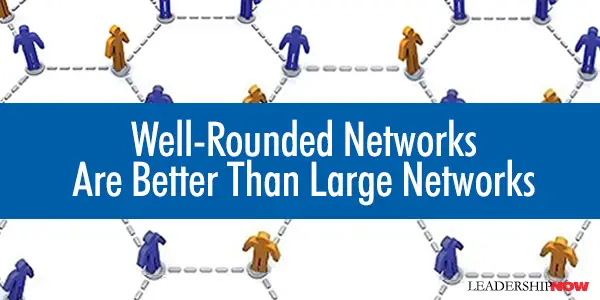 Rob Cross and Bob Thomas argue in Driving Results Through Social Networks that people who make targeted investments in relationships outperform those who simply build ever-larger networks. The former is based on quality the latter is a numbers game.
Rob Cross and Bob Thomas argue in Driving Results Through Social Networks that people who make targeted investments in relationships outperform those who simply build ever-larger networks. The former is based on quality the latter is a numbers game.
Leaders need to develop well-rounded networks. That is, networks that are not dominated by certain kinds of voices; people that are above them and below them, both inside and outside of the organization. The value here is in having the best possible and right kind of information available to you when you need it from people willing to tell you the truth. They have found that high performer's networks share three important dimensions:
They have developed an organizational network analysis to help make known the networks that exist in the informal organization. When trying to implement strategy, this becomes a crucial bit of information. If the informal networks are not aligned to the organizational objectives, the organization underperforms, and resources are not leveraged. A more nuanced view also allows for the creation of high-performing teams that do not naturally arise from the formal organization chart. This network perspective underscores the need for leadership at all levels of an organization: Whereas today we rely on two-dimensional, static, and notoriously outdated organization charts to depict what an organization is or does, soon we will be able to represent companies, even industries, the way they really are: active, in motion, growing, shrinking, flowing in the direction of opportunities, pulsating with life, and inevitably fading out of existence. This has implications for speeding productivity in newcomers: Leaders can capture greater productivity from their new hires by facilitating introductions between the newcomers and key resources as well as by ensuring that new employees quickly build a network of trusted relationships. Instead of asking only What do newcomers need to know? organizations must also ask, Whom do our newcomers need to know? 
Posted by Michael McKinney at 01:16 AM
07.27.09

5 Leadership Lessons: Getting Your Relationships Right Townsend wrote Leadership Beyond Reason to help you understand and utilize the soft skills – that which is beyond reason. He says “you ignore what is beyond reason at your own peril….Leading from your inner world ultimately produces better results in your leadership.” He divides our inner world into five areas: values, thoughts, emotions, relationships and transformation. As leadership is about connecting with those you lead and a primary focus of leadership, let’s pull five lessons from Townsend on relationships: Developing your relational abilities will help you read the landscape. Townsend adds, “The leader who misses relational aspects is surprised when people become distant, resentful, or just leave. The relational leader sees the signs coming a long way away and has time to do something about them.”
Posted by Michael McKinney at 09:51 AM
06.03.09

Whatever Happened to the Rugged Individualist?“Corporate America is in the midst of a crisis” write Jonathan Littman and Marc Hershon in I Hate People! “The spirit of the individual has played a huge part in forging our nation’s history. Yet the scourge of teamwork pap has made solo efforts in companies seem unwanted, crazy, even dangerous.“Instead of thinking of yourself as a staffer in a big company, the manager of a division, or a top executive, you begin to define yourself in concrete individualistic terms. You are a brand unto yourself. Brainstormer extraordinaire. Marketing whiz. Charismatic project leader.” At the same time the soloist is not a loner, a recluse or a maverick. They fit smoothly within a group, playing with it expertly while often leading or accompanying fellow members. I Hate People! Kick Loose from the Overbearing and Underhanded Jerks at Work and Get What You Want Out of Your Job is a guide for navigating through the kinds of people in the workplace that make us all miserable and undermine rugged individualists. How do you know if you're a Soloist, or at least destined to become one? The easiest sniff test is how many times a day you mutter, shout, or even think to yourself, "I hate people!" But not all People Haters are necessarily Soloists. Littman and Hershon have created the Am I a Soloist Quiz to help you determine the depth of your Soloist leanings. The higher your score, the more Soloist blood in your veins. A. The portion of the day I prefer working by myself is . . .
Posted by Michael McKinney at 04:55 PM
05.27.09

Creating a Sustainable Business Environment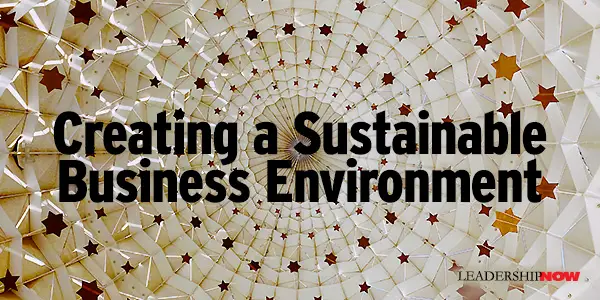
CHARLES HANDY writes that to repair the damage to the image of business, leaders of those businesses should bind themselves to a form of the Hippocratic Oath, “Above all, do no harm.” It means doing more than being legal. It means being ethical. It means taking the lead in creating sustainable environments for both individuals and the world they live in. Lee Cockerell, former executive vice president of operations for Walt Disney World Resort, says that “the organization of the future will pay as much attention to people and leadership strategies as it does to products and services.” He adds that “good leaders are environmentalists: their responsibility is to create a sustainable business environment—that is, one that is calm, clear, crisp, and clean, with no pollution, no toxins, and no waste—in which everyone flourishes.” To that end, leaders must create an inclusive workplace where every employee can contribute to the best of their ability. In The Organization of the Future 2, he suggests ten goals you can set for yourself where you can impact your organization’s culture:
Posted by Michael McKinney at 12:30 AM
04.24.09

What Games Do You Play?We all play games. We play them for the promise of reward they hold. They function as a coping mechanism to help us to navigate uncertain and challenging settings. But they are self-serving and drain people of energy and commitment. “They lock people into routines and rituals that hamper flexibility and thwart change efforts.” They will never go away, but we can minimize both the frequency and their effect.“A lack of knowledge about games allows them to thrive” say Mauricio Goldstein and Phillip Read in their book, Games At Work: How to Recognize and Reduce Office Politics. “The more you know the better able you’ll be to limit their damage and turn the energy of your people in more productive directions.” You might have played or been involved in some of these common games they mention:
The authors give managers the tools to “diagnose” the games that people play in their company. Using a three step process entitled AIM—Awareness, Identification, Mitigation—with specific examples from global companies that illustrate both the games and their solutions, Goldstein and Read provide a clear outline for managers to address and end the games people play in organizations. They also present five principles to keep in mind: To game is human. Your goal is to have fewer and less. Games flourish during times of high anxiety. Companies need anxiety to fuel performance, however this anxiety and stress needs to be channeled into productive rather than manipulative behaviors. Your company’s games are not comparable to another company’s games. Different organizations have different game ecologies. Minimizing game playing starts at home. As soon as you deny that you play or facilitate games, you’ve limited your options for dealing with them. Recognizing this tendency in yourself helps you deal with these issues at a personal level. Dialogue is a natural antidote to games. Don’t embark on a course of “gamocide” – that is. Don’t create programs and policies to punish game playing. This will serve only to create more games. Speaking openly and honestly discourages game playing.
Posted by Michael McKinney at 04:23 PM
03.04.09

Take the Greater Than Yourself ChallengeYou’ve heard “invest yourself in others” and “pay it forward.” Steve Farber has his own unique twist on these ideas and he calls it Greater Than Yourself.The Greater Than Yourself (GTY) concept is based on the premise that great leaders become great because they cause others to be greater than they are. GTY is a one-on-one development process where you choose to help someone become more capable, competent, and accomplished than you are. It has three parts to it: Expand Yourself, Give Yourself and Replicate Yourself. The life-long process begins with you. “You have to expand yourself before you can help make others greater.” That means that you have to make sure that everything that is you is constantly expanding. No matter how much you think you know or are, “you can always learn more, you can always experience more, you can always connect more and love more.” The point of which is to give it all away. Giving it all away always brings out the cynics. But Farber deals with that too. Giving it all away seems to imply subtraction – like a zero-sum-game – to many people. But it’s not. Giving it all away really adds to who you are. Parents get it, but when we get outside that relationship, an improper self-interest kicks in and we miss the bigger picture. In this business fable set along the California coast, Faber skillfully explains the true nature of giving it all away to become a creator of masters. GTY has life-changing possibilities if you commit to it. Expanding yourself “is a practice that should become part of your life. Integrate it into your thought process and into the way you make decisions. Will X add to your inventory? Will it expand an item that is already there? If so, do it; if not, don’t.” When you think of giving of yourself, money may not be part of it. You have other resources like “your talent, your knowledge, your connections, your confidence, your trust” and last but not least, “your time.” In the end, you want to replicate yourself. That is, you want to make sure that the people you elevate are doing the same for others. In an organizational context, it might look like this: “Everyone on my team and in our company should become significantly greater as a result of working with one another.” But, “I’m not trying to hire people who are more talented than me, I’m trying to hire people with heart, desire, drive, and mad potential, and then encourage all of them to bring out the best in one another by giving fully to one another. See the difference?” Farber admits that this isn’t easy to do initially. In response, he challenges us to pick just one person to make a GTY project. “Raise that person; boost him or her above yourself. Start there and see what happens.” He has created a web site with examples and resources to get you going. In particular, there is a four minute video of a GTY project conducted by the Up With People organization, that is a good overview of what this is all about and the impact it can have. The participants in this GTY project don’t rule out that great things can come in small packages. The tendency is to pick someone who is already doing well and then working to make them greater; jump on their bandwagon so to speak. There’s certainly nothing wrong in that, but perhaps the most impact can come from taking someone who really needs a leg up and connecting them to what they need. Take the Greater Than Yourself Challenge. Pick one person and give of yourself to make their life better—than yours!

Posted by Michael McKinney at 04:23 PM
01.26.09

You Can’t Order Change: Making Ethics and Compliance a Clear Competitive Advantage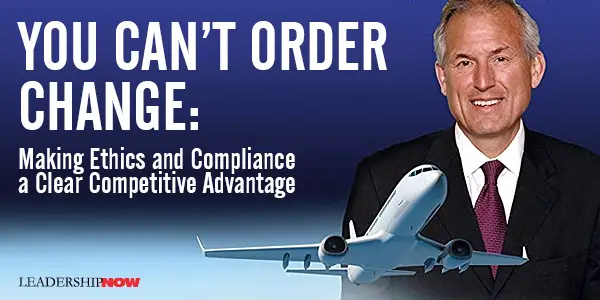
WHEN Jim McNerney became CEO of Boeing in 2005, change wasn’t an option. It was mandated. In 2005 Boeing was facing investigations into illegal business practices, there was the sex scandal, revenue was down, and key people were jumping ship. In short, it wasn’t the place to work. But even when everyone agrees that change is necessary – even vital – it doesn’t come easy. It still has to be approached in a careful and respectful way. You Can’t Order Change, by Peter Cohan, is about how McNerney brought about that change in Boeing. How he cleaned up the mess and changed the culture and revitalized the organization. Probably the biggest task that faced him was the quagmire created by years of costly ethical problems. He had to settle a lawsuit with the government and create a culture of ethics and compliance. This has to be done by example and system changes that encourage ethical behavior and compliance. He said in Boeing Frontiers, “I plan to make leadership development a focus across the company because I believe that as we strengthen our leadership capacities, we can have a positive impact on the company's overall performance. As I've said before, better leaders make better companies. And effective leadership, at all levels of an organization, is based on a foundation of trust, integrity, and escape-free compliance. As we turn up the gain in leadership-development training, we will embed in it an equal emphasis on how leaders can lead with ethics and integrity.” Cohan writes that McNerney made sure that ethics wasn’t a passing fad, but a value that had teeth in it. If the leaders of the organization “have not been behaving in a way that’s consistent with Boeing’s values, he expects them to change their behavior. And if they don’t meet McNerney’s expectations, they lose their leadership roles.” Step one for McNerney, of course, is getting the leaders to act ethically; to set the example. Cohan cites this statement from McNerney: We also realize it all starts with leadership. If an organization’s leaders don’t model, encourage, expect and reward the right behaviors, why should anyone else in that organization exhibit those behaviors? Companies have to take the hugely important step of driving ethics and compliance through their core leadership and Human Resources processes. This must be … and must be seen to be … a central part of the whole system of training and developing leaders and of the whole process of evaluating and promoting people. This is the key.” Critical also to this change is a system that supports and rewards people for getting results ethically and gets rid of people who don’t. Cohan writes, “McNerney let people know that he wanted them to discuss problems and not bury them.” If people didn’t talk about ethics and compliance, he would bring it up. “Ultimately, McNerney wants to avoid surprises about ethical problems that originate at lower levels. I know and you know … that one of the absolute perquisites for success in ethics and compliance is the belief that it is OK for people to question what happens around them.” McNerney’s methods and approach to change have gotten him dramatic results and they are worth studying. 
Posted by Michael McKinney at 01:35 PM
11.26.08

I Hired Your Resume. But Unfortunately What I Got Was You!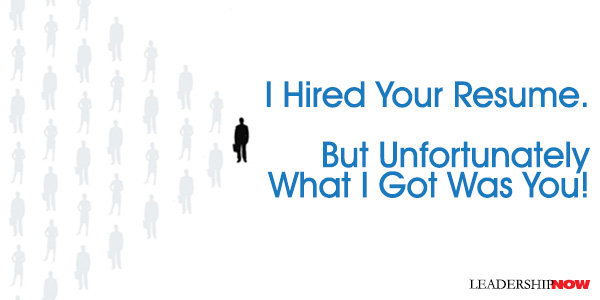
THE Wall Street Journal recently asked 100 CEOs of large companies what their top priorities were. After the obvious financial issues, the perennial concern over finding the right people to do what needs to get done was the issue of the day. This speaks to a larger problem of education, but makes all the more important the solutions presented in Who: The A Method for Hiring by Geoff Smart and Randy Street. Smart and Street have set out to help you make better who decisions. Often the problem is getting past the resume and really getting to know the person you are considering. Most managers fail at hiring because they do not follow a rigorous hiring process. Who lays out a four step process that, in my experience, may need to be adapted depending on the type of position you are trying to fill. But the principles are valid across the board. If the book does nothing else, it will help you rethink what you are now doing and avoid what they call voodoo hiring practices – playing (mind) games with the candidates, trying to size people up after one conversation, and questions designed to trick or are that are irrelevant. The bottom line is that you can’t “read” people like you think you can. “It’s hard to see people for who they really are.”The four steps they recommend are: Scorecard: The scorecard is a blueprint for the role you have to fill. Most companies would improve their odds if they just got this step right. The last job description you have on file is probably not precise or accurate enough to get you the right person for the job. You have to set clear objectives for your hiring process to know exactly what kind of candidate you need to hire. They say that hiring the “all-around athlete” is not as successful as the specialist – someone hired to a specific role that you need filled. Sourcing: The question they get asked over and over is “Where do you find talented people?” The number one and best source is from your professional and personal networks. But if you wait until you are ready to hire, it’s probably too late. “Successful executives don’t allow recruiting to become a one-time event, or something they have to do every now and then. They are always sourcing, always on the lookout for new talent, always identifying the who before a new hire is really needed.” Select: Smart and Street recommend four distinct types of interviews: the screening interview, the Topgrading Interview, the focused interview, and the reference interview. You’re looking for patterns, “facts and data about somebody’s performance track record that spans decades.” Sell: Once you decide on a candidate you need to get them on board. Be sure to position your company as a place good people want to work. Care about what they care about: how they fit in, their family, freedom, compensation, and fun (the work environment). 
Posted by Michael McKinney at 03:03 PM
11.18.08

The Secrets of the Millennial Generation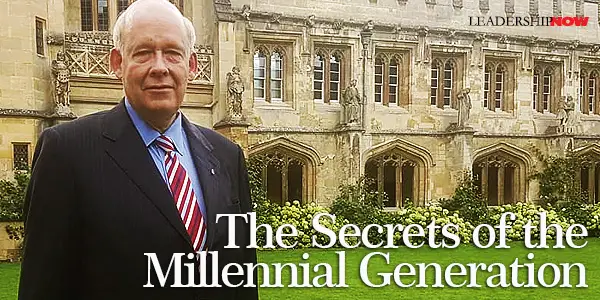
Talking Management is a weekly videocast that McGill University’s Karl Moore hosts for Canada’s Globe and Mail newspaper. Recently he recorded a presentation on how to manage and lead today’s youth. The Business Strategy Review, published by the London Business School, identified Moore among a group of world’s greatest business thinkers. In this 20 minute video, he provides not only some practical ideas but an understanding of the context that produced the Millennial generation. Here are some excerpts: The job of the manager is not to have the ideas but to support them. That is saying that innovation comes from everywhere, not just from the center, not just from the top of the pyramid, not just from the old people, it comes from throughout the organization. This fits with the business need. A manager, a leader must now spend more time listening and looking for others' ideas and empowering them than in merely trying to be the great strategist. We have heard this for a while but I think that it seems more compelling today than in the past. It is just more true. It used to be that global firms would have a head office in a country and that is where ideas would come from but probably the main advantage of being a global multinational organization is that you are getting ideas and innovation from all over the World rather than from one place.You can also read a transcript of the video on the Globe and Mail web site.
Posted by Michael McKinney at 12:32 PM
11.14.08

Hiring the Right Skill Set and Motivating the Millennials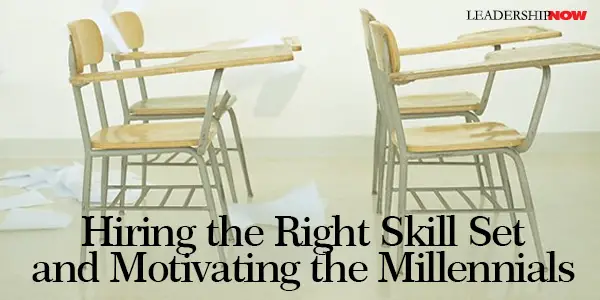
IN RAISING and schooling our children in the U.S., it appears we have dropped our standards. And it shows. Finding the right people is becoming a more and more difficult proposition. (I enjoyed reading about Linda Zdanowicz's search for a dental assistant on her blog.) Tony Wagner, author of the The Global Achievement Gap has written an important book that should not be ignored by business leaders. It sets a meaningful agenda for a good dialogue between educators and business leaders and concerned parents about our educational system. Wagner has written the following for us: In an economic downturn, employers need to be even more careful with their hiring decisions. And recent graduates from some of the best schools may not have the skills that matter most in the new global knowledge economy. In researching my book, The Global Achievement Gap: Why Even Our Best Schools Don’t Teach The New Survival Skills Our Children Need -- and What We Can Do About It, I have come to understand that there are "7 Survival Skills" for the New World of Work, and that employers must look beyond applicants' "pedigrees" to carefully assess whether they have the skills that matter most. New Skills Here are the Seven Survival Skills, as described by some of the people whom I interviewed: • Critical Thinking and Problem Solving "The idea that a company's senior leaders have all the answers and can solve problems by themselves has gone completely by the wayside . . . The person who's close to the work has to have strong analytic skills. You have to be rigorous: test your assumptions, don't take things at face value, don't go in with preconceived ideas that you're trying to prove." —Ellen Kumata, consultant to Fortune 200 companies
• Collaboration Across Networks and Leading by Influence "The biggest problem we have in the company as a whole is finding people capable of exerting leadership across the board . . . Our mantra is that you lead by influence, rather than authority." —Mark Chandler, Senior Vice President and General Counsel at Cisco
• Agility and Adaptability "I've been here four years, and we've done fundamental reorganization every year because of changes in the business . . . I can guarantee the job I hire someone to do will change or may not exist in the future, so this is why adaptability and learning skills are more important than technical skills." —Clay Parker, President of Chemical Management Division of BOC Edwards
• Initiative and Entrepreneurship "For our production and crafts staff, the hourly workers, we need self-directed people . . . who can find creative solutions to some very tough, challenging problems." —Mark Maddox, Human Resources Manager at Unilever Foods North America
• Effective Oral and Written Communication "The biggest skill people are missing is the ability to communicate: both written and oral presentations. It's a huge problem for us." —Annmarie Neal, Vice President for Talent Management at Cisco Systems
• Accessing and Analyzing Information "There is so much information available that it is almost too much, and if people aren't prepared to process the information effectively, it almost freezes them in their steps." —Mike Summers, Vice President for Global Talent Management at Dell
• Curiosity and Imagination "Our old idea is that work is defined by employers and that employees have to do whatever the employer wants . . . but actually, you would like him to come up with an interpretation that you like -- he's adding something personal -- a creative element." —Michael Jung, Senior Consultant at McKinsey and Company
Looking Beyond the Degree The conventional thinking of many who make hiring decisions is that graduates from "name-brand" colleges are likely to be more intelligent and better prepared than students who have gone to second or third tier schools. But, in reality, what the degree may mean is that these students are better at taking tests and figuring out what the professor wants -- skills that won't get them very far in the workplace today. A senior associate from a major consulting firm told me that recent hires from Ivy League business schools were constantly asking what the right answer was -- in order words, how to get an "A" for the job they were doing -- and were not always very adept at asking the right questions, which was the single most important skill senior executives whom I interviewed identified. So what does this mean for the interview process? First, listen carefully for the kinds of questions the applicant asks. Are they probing? Insightful? Do they suggest that the applicant has really prepared for the interview by trying to understand your business? Do you feel as though you or your company are being interviewed? If so, that's a very good sign. How a prospective employee asks these questions matters, as well. Does he or she listen carefully and engage you in discussions? Is the potential new hire both interested and interesting? In addition to the ability to ask good questions, senior execs told me that the ability to "look someone in the eye and engage in a thoughtful discussion" is an essential competency for working with colleagues and understanding customers' needs. Finally, perhaps the most important question you might ask is, "what do you want to learn or how do you want to grow in this job?" This question is essential for two reasons: First, the quality of the answer will tell you how reflective this individual is -- and how intentional he or she may about his or her own development. More than any specific skill, individuals must want to learn, grow, and improve continuously to be successful in today's workplace. Motivating the Millennials The second reason why this question is important goes to the heart of the problem of how to motivate new hires to do their best. In asking the question, "how do you want to grow," you are signaling to a prospective employee that you and your company are committed to developing the talents of your workers. Many employers worry that this generation lacks a work ethic. But in my research, I have discovered that this generation is not unmotivated but rather differently motivated to learn and to work. Above all else, they want opportunities to be challenged and to make a difference. Describing the different work ethic of this generation, Ellen Kumata, who is a managing partner at Cambria Associates and consults to senior executives at Fortune 200 companies, told me, "They don't see coming into a company as being a career experience. They don't want to climb the corporate ladder and make more money and please the boss. And so you can't manage them the same way -- you can't just put them into a cubicle and expect them to perform." Tracy Mitrano, who manages the Office of Information Technologies at Cornell University, agreed: "You have to make the work more interesting and allow them to work in different ways. They are prepared to work just as much and just as hard -- but not at a desk 8 hours a day." Andrew Bruck was finishing a law degree at Stanford when I interviewed him last year. "We want to feel ownership. We have a craving for an opportunity to do something really important," he told me. "People in my generation have been in a constant state of training. Now they're excited to go do something. The more responsibility you give people, the better they produce . . . There are more and more recent law school grads who are willing to take a lower salary in return for an opportunity for more meaningful work." Ben McNeely, a journalist, described to me the difference between his former employer and his current one. "At the paper where I worked previously, the publisher would kill stories if they portrayed an advertiser in a negative light. At the paper where I work now, I have an opportunity to contribute something in a growing community. I was brought in to cover the new bio-tech research campus under construction nearby, where the Canon towel factory used to be, and to cover health care issues, as well. I have support from the editor and publisher who both have strong journalistic ethics. I like it that the editor pushes Windham, who us to dig deeper." Carie Windham, who graduated from college in 2005, told me about the best boss she's ever had. "He asked me where I want to be in 10 years. He talked to me about creating the experience I want to have. He understood I wouldn't be there forever . . . Mentoring is a huge motivational tool, someone showing an interest in you and giving you feedback. We want to feel we have a creative, individual role -- that we're not just working on an assembly line. We want to feel like we have ownership of an idea." Hiring the right talent, then, is only part of the problem employers face today. Equally important is how businesses create challenges and learning opportunities that motivate the Millennials to do their best. Google, which had more than one million applications for 5,000 jobs in 2006, is the number one pick of a place to work for many of the Millennials. Listening to twenty-two-year-old Matt Kulick talk about his work, one begins to understand how profoundly many companies will have to change in order to attract and retain the best talent: "First, they (Google) share ideals that I believe in—open source software. And their products are solving important problems for people—doing good in the world. I believe in what they're doing—these values are very important to me. I wanted to help out, to make a contribution. The second reason I came to Google is because they give me the resources I need to accomplish major things that will really make a difference in the world. The third reason is the responsibility they give you from the day you start. It is a winning combination. It makes me happy to go to work every day."  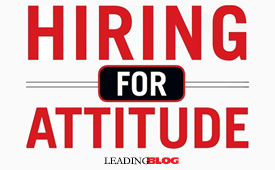 
Posted by Michael McKinney at 06:07 AM
|
BUILD YOUR KNOWLEDGE
 

How to Do Your Start-Up Right STRAIGHT TALK FOR START-UPS 
Grow Your Leadership Skills NEW AND UPCOMING LEADERSHIP BOOKS 
Leadership Minute BITE-SIZE CONCEPTS YOU CAN CHEW ON 
Classic Leadership Books BOOKS TO READ BEFORE YOU LEAD |
| ||||||||||||||||||||||||||||||||||||||||||||||||||||||||||||||||||||||||||||||||||||||||||||||||||||||||||||||||||||||||||||||||||||